Masterpieces from the Pijpenkabinet
Author:
Don Duco
Original Title:
Topstukken uit het Pijpenkabinet
Publication Year:
2010
Publisher:
Pijpenkabinet Foundation
Description:
Web presentation illustrating and discussing fifty masterpieces from the Pijpenkabinet collection in Amsterdam
Preface
With its 27,500 objects, the Pijpenkabinet Foundation manages an extensive collection of smoking equipment and related objects. In this web presentation, a choice of over fifty objects will be highlighted and explained in more detail. The selection is representative of the wide variation within the collection. What binds the objects is that they are masterpieces, but in different respects. Often they are special pieces because of their historical value, sometimes they are visitors favourites, in other cases objects with a remarkable beauty or a bizarre appearance. The story behind the object can also play a role in the choice. All these museum objects form a link in the history of smoking, a worldwide history that has an infinite number of aspects. Scroll down and read more about the unexpected aspects of the global smoking culture.
Those who want to orient themselves on the best pieces from the Pijpenkabinet collection can use the link below to make a wider selection. Then more than five hundred objects emerge that are qualified as the most characteristic by the curator. However, these are not described as the fifty toppers and explained with their own story. They are taken directly from the collection database. Of course, this choice is also subjective. The collection of the Pijpenkabinet contains numerous remarkable objects that would qualify as well for inclusion in that list. In addition, the top five hundred even contains relatively ordinary objects that are of great importance for the history of the pipe, but do not always have a high attraction value.
Prehistoric
Mythological animal
The primal shape of the tobacco pipe does not show the pipe bowl as we know it, with a hollow stem, but has the shape of a tube. This so-called tubular extends from the mouthpiece to the other end in a kind of pipe bowl or furnace. Here the tobacco can be packed. The tubular remains a simple but popular shape for a smoking pipe for centuries.
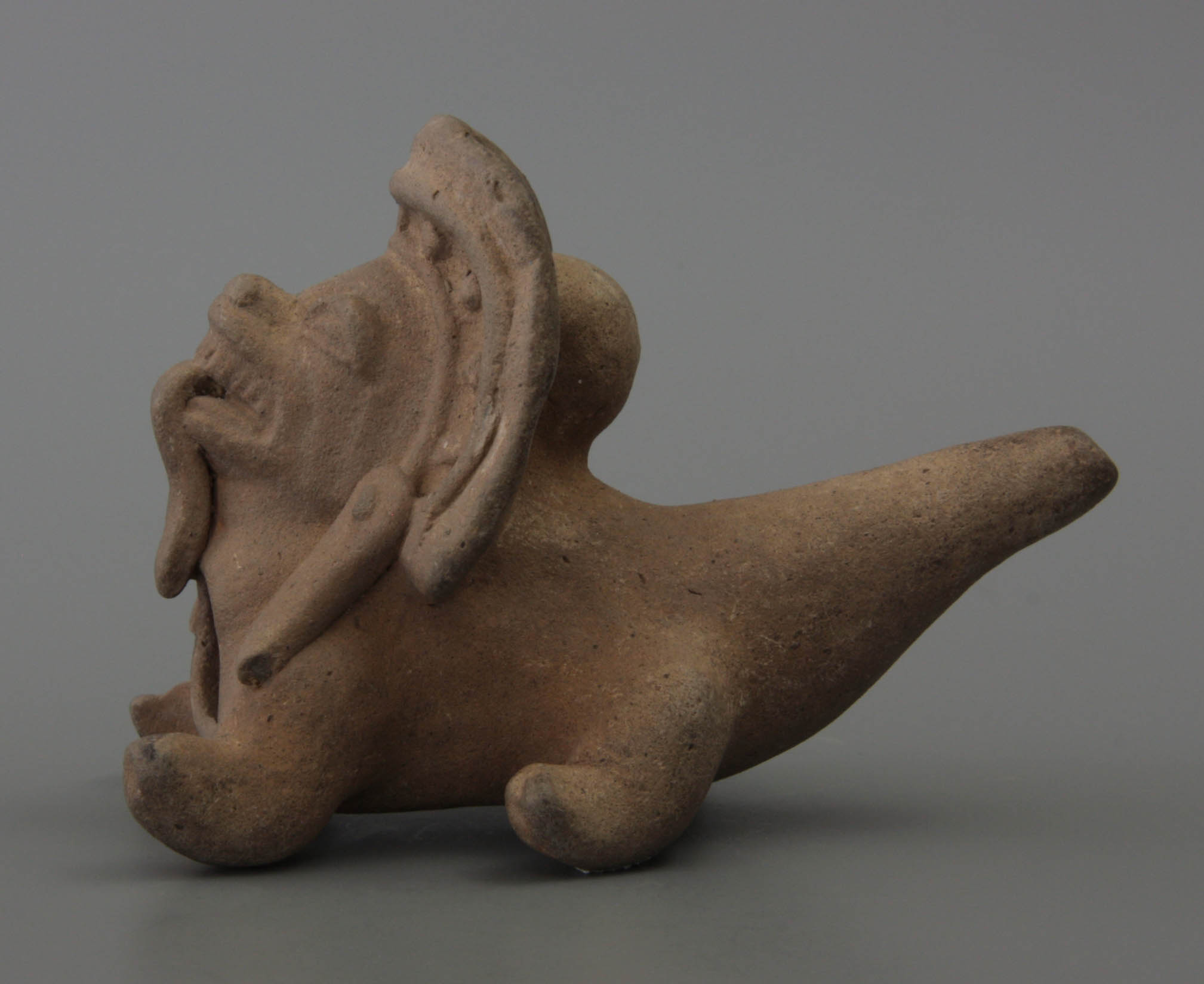
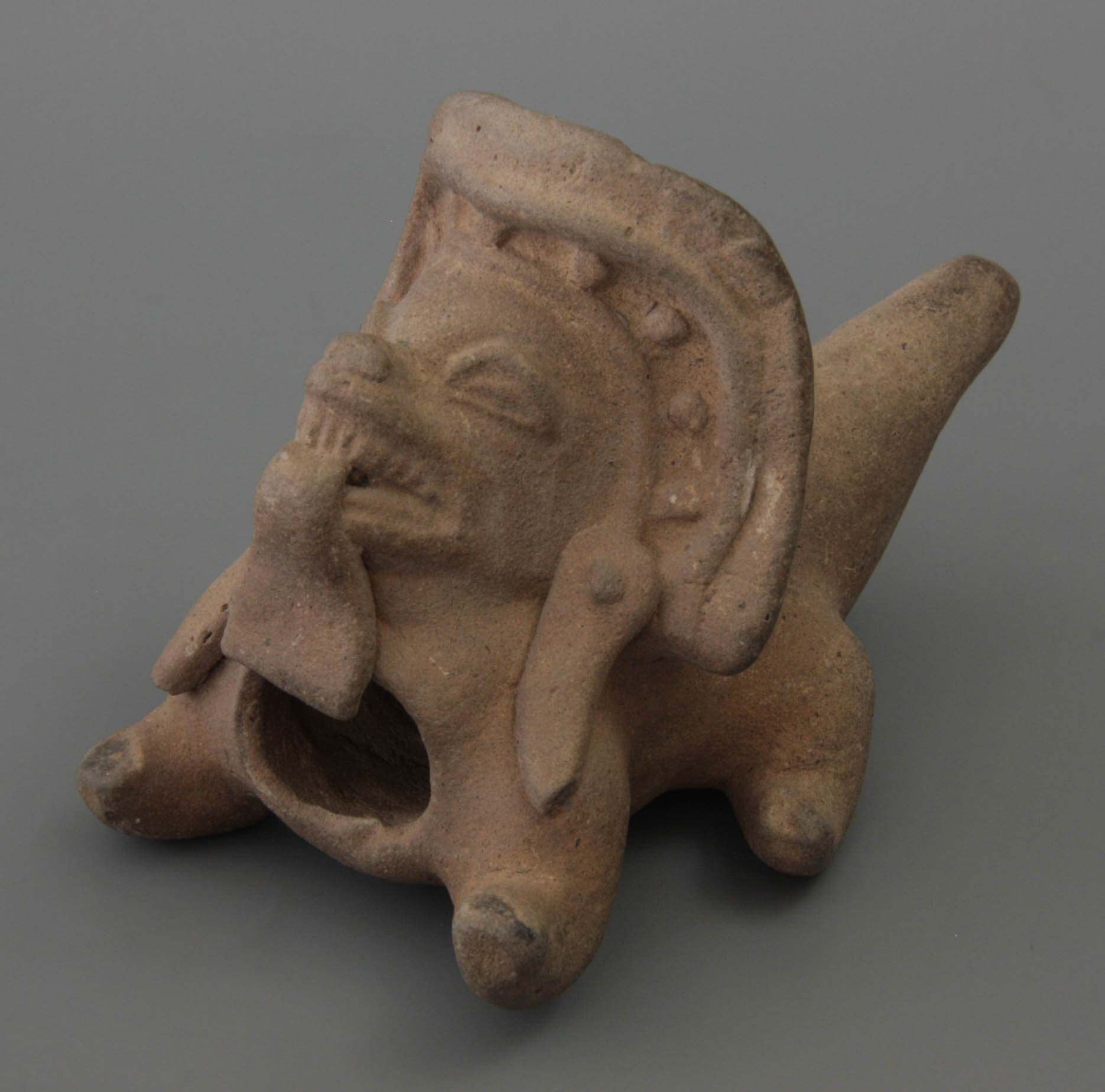
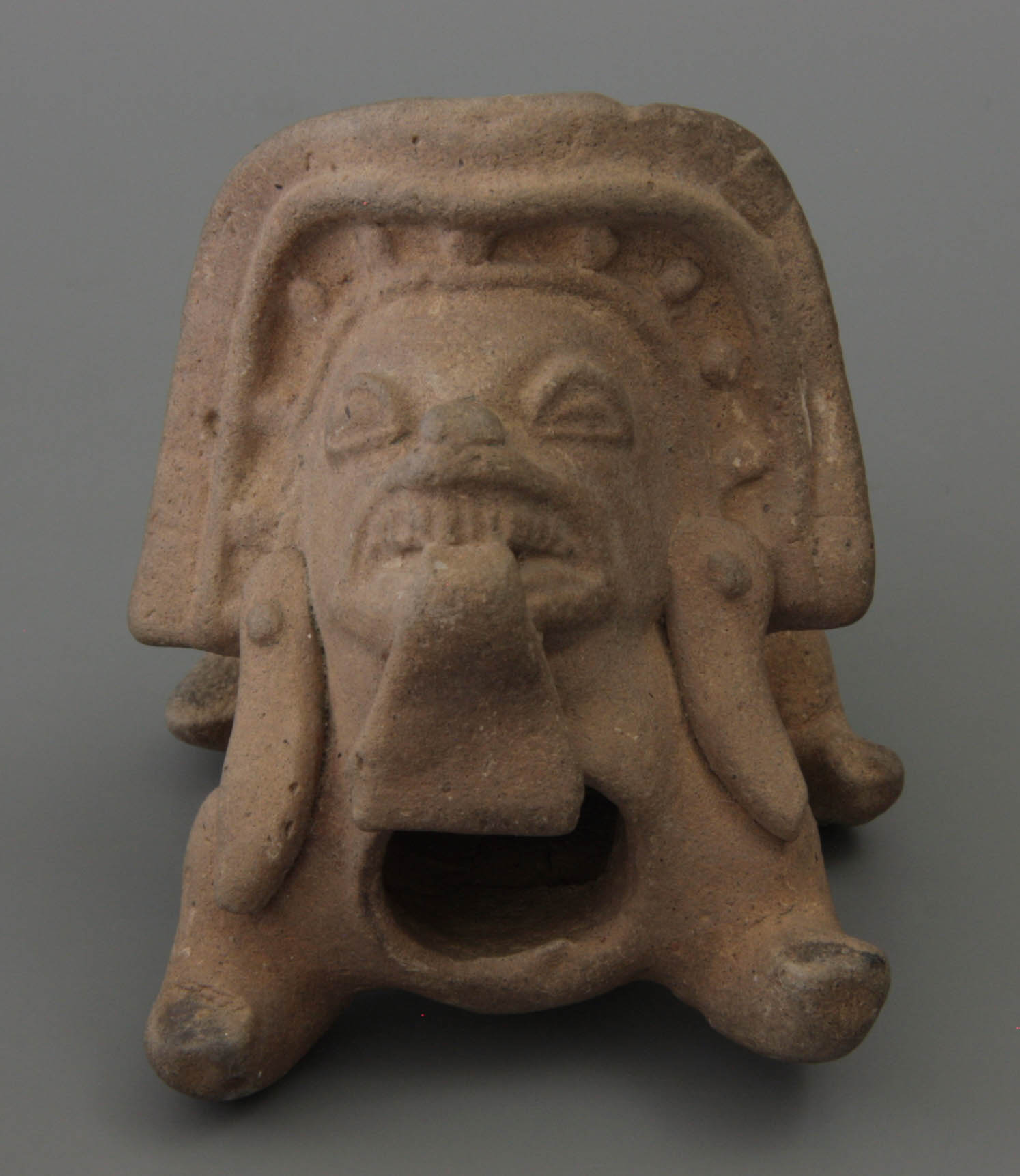
Several such tubular pipes are known from Ecuador, which are occasionally embellished in a beautiful and original way by figuration. This happened mainly at the Jama-Coaque in the Manabi region. This tribe did not have the wish to make a comfortable stemmed pipe with an upright pipe bowl. They were used to the tubular shape, which was in line with the attitude and rite of smoking. However, there was great interest in decorating the tubular pipe by making a figural shape. With a successful product, the artistic decoration completely overshadows the pipe shape.
The illustrated pipe is a fine example. The simple tubular shape is completely hidden in a lying mythological animal, the representation of a wolf or lion. The technique of manufacturing is remarkable. The basic shape of the pipe is made by hand, the tail of the animal being the mouthpiece of the pipe. The legs on both sides of the stem are hand-sculpted. Subsequently, a mask-like head, applied to the upper side, was produced with a simple printing mould. Finally, details such as earrings and a tongue were hand formed and added by hand.
The representation is particularly successful, the animal is in a defensive position and the head is surrounded by a broad geometric headdress. A triangular flared tongue and comma-shaped earrings complete the figure. Characteristic of the tubular pipe is of course the fact that the bowl is located at the front and is not positioned at an angle of ninety degrees to the stem. In the latter case, it would end up behind the head of the animal, as is usual with the standard pipe. After the product was baked, some details were probably polychrome, so that a colourful end result was obtained. These colours has faded in the course of more than two millennia.
Such objects from the Jama-Coaque culture date from 550 BC. This specimen will date from the fifth or fourth century. These are rare archaeological examples from the prehistory of smoking that prove with their artistic element that tobacco use evoked inspiration already in the earliest phase.
Amsterdam, Pijpenkabinet collection Pk 13.513
The mescaline cactus as inspiration
The most characteristic pre-Columbian pipe has a bowl shape that is inspired by nature. For the pipe bowl the mescaline cactus was copied: a spherical cactus with vertical cooling fins. The mescaline cactus is a common plant in those areas, often with an aerial root that is depicted in the pipe stem. When the cactus blooms, one large flower appears in the crown, initially as a cylindrical bud but spreading out to a calyx in full bloom. In smoking pipes according to the example of this cactus, the different stages of flowering are shown, with full bloom being the most common. Rare is the representation of a cactus without a flower. The pipe shown is particularly special because the flower is still shown in the bud, which rises from the cactus like a cylindrical box.
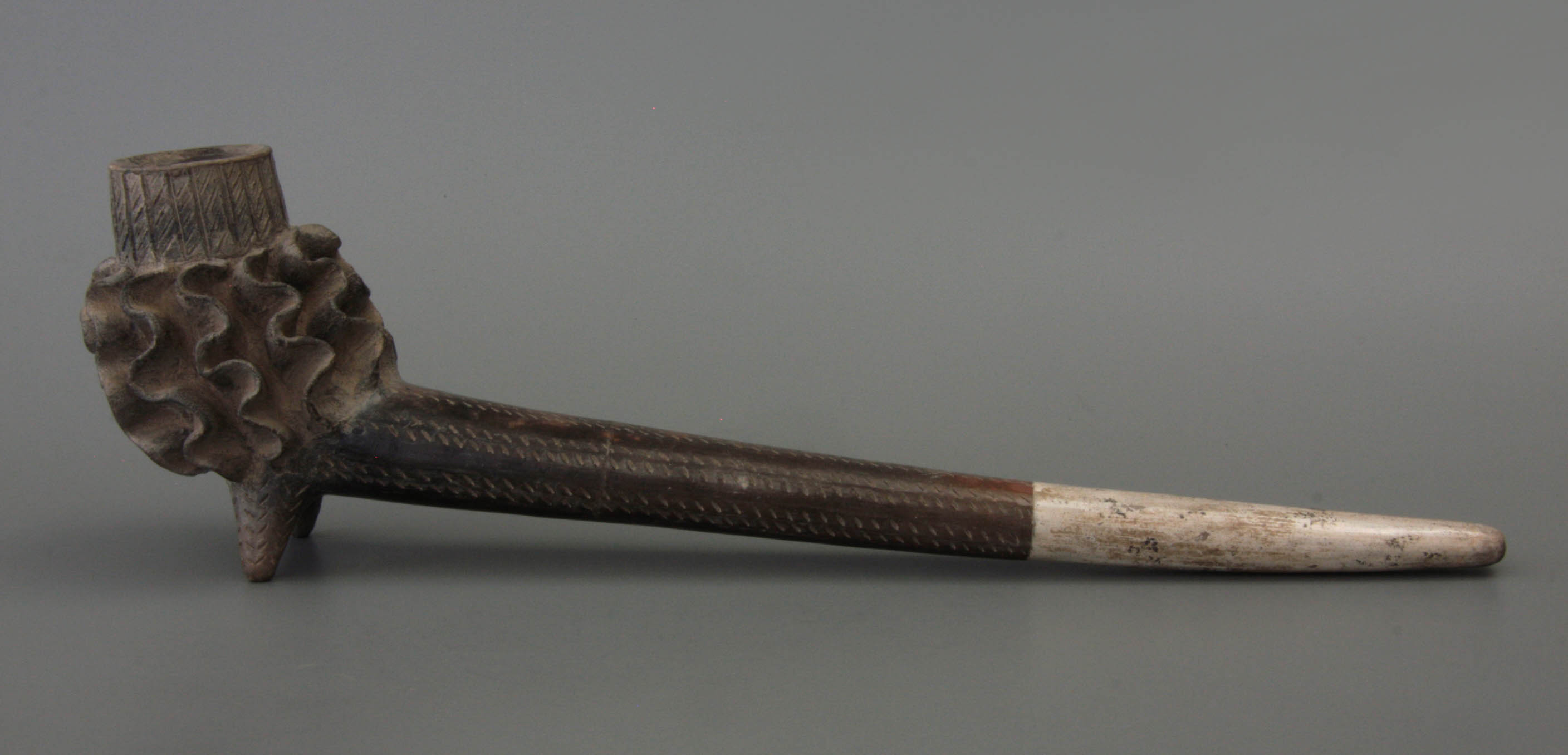
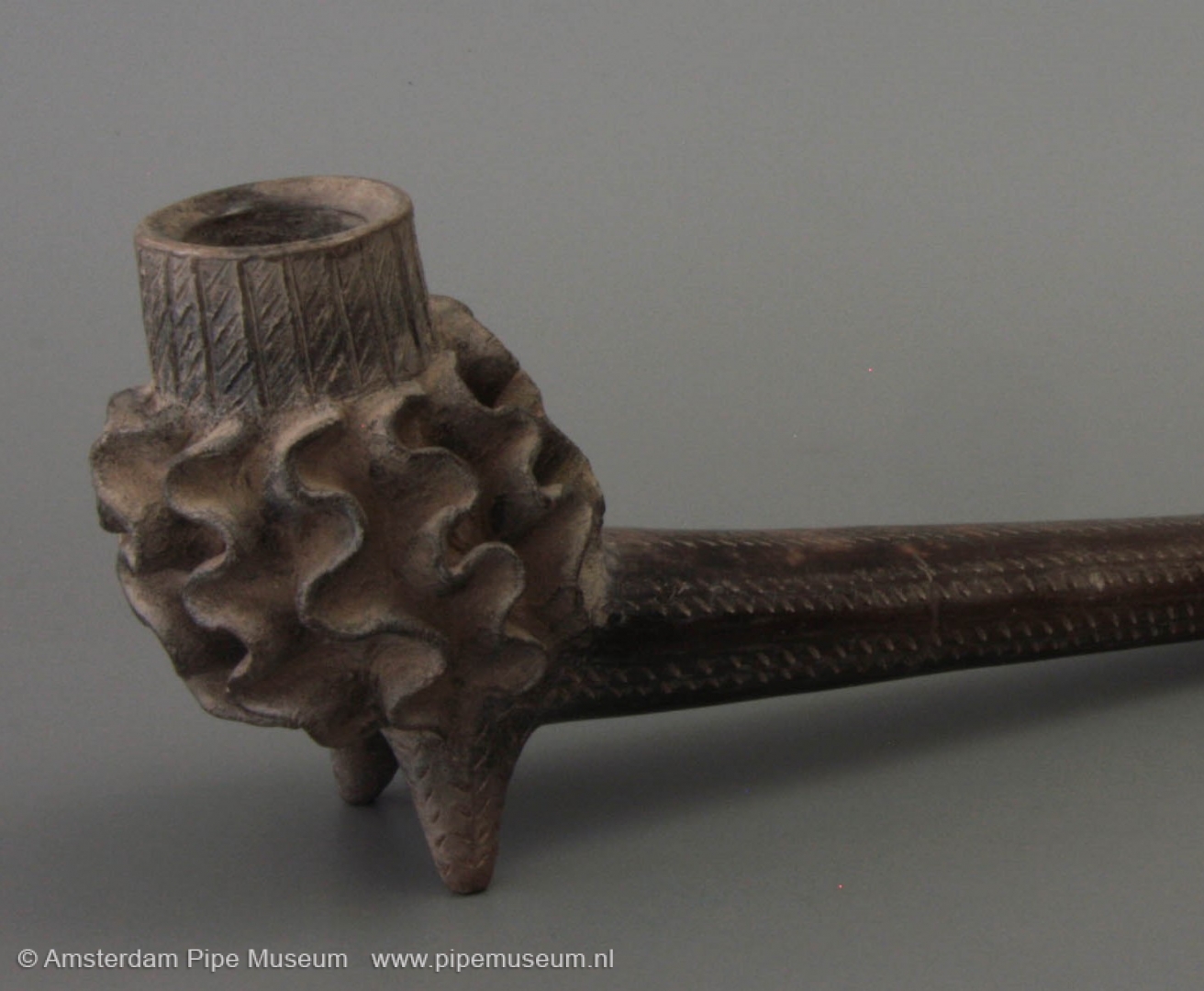
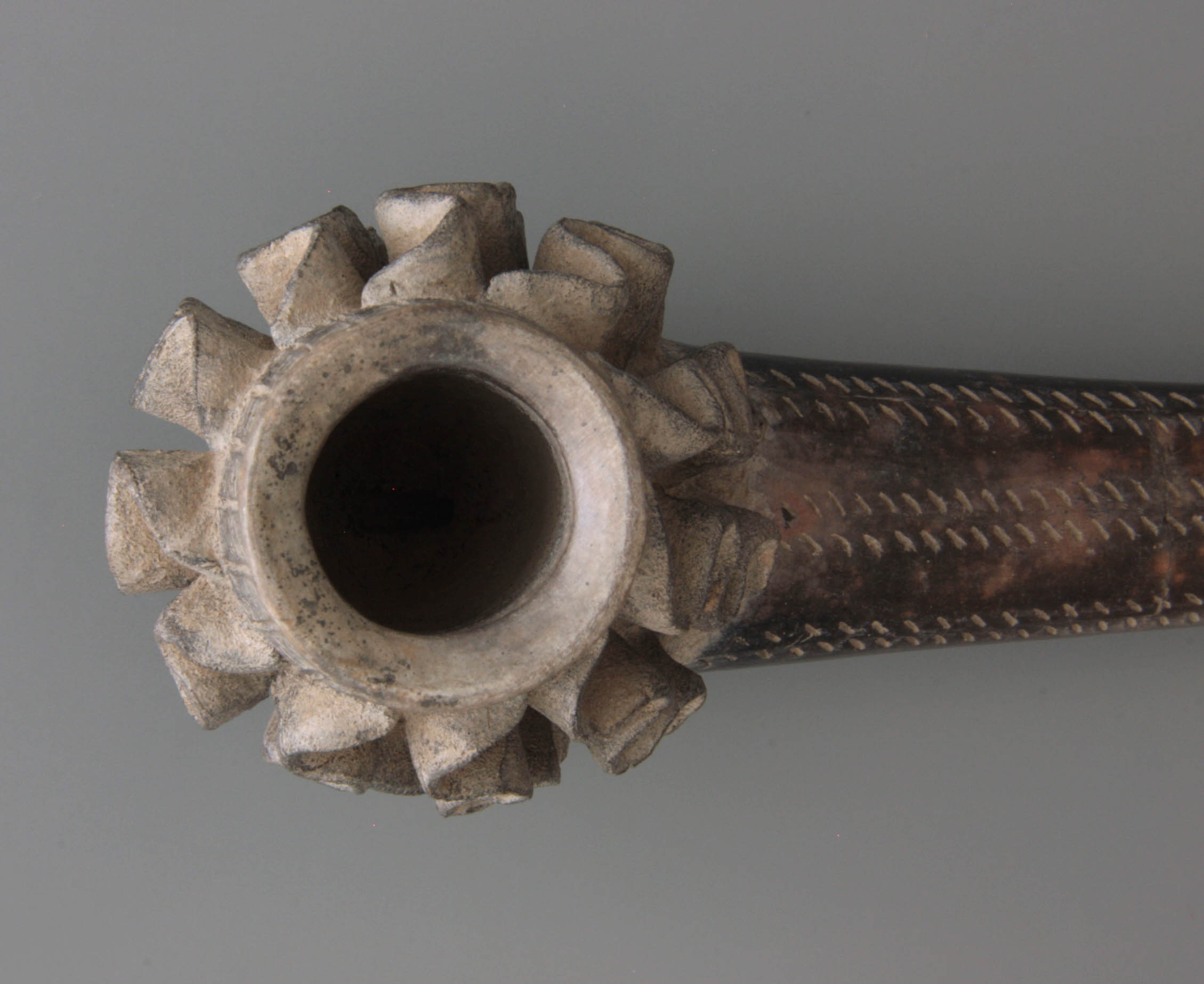
In the stem of the pipe, the maker depicted an aerial root and thus gave an extra realistic dimension to his creation. Referring to the root structure, the stems are often provided with a repetitive pattern of imprinted stripes. The two legs at the bottom of the bowl are for the pipe to be put down, typical for the use in Mexico. Cactus pipes are finished in different ways. Sometimes the pipe has the colour of the baking from greyish to terracotta red but usually with slip colour accents. With this pipe, the greyish colour of the ceramic stands out against the striking effect through partial polishing. The mouthpiece is appropriately accentuated with white engobe, which is also polished.
The mescaline cactus itself was used as a stimulant by the Indian tribes. At religious festivals people ate dried pieces, called peyotl or pellote. They provided hour-long nebulisation and associated colour visions. Reason to portray this cactus in a pipe is certainly not in the need to process nature in utensils, that is not typical of that culture. Rather, a relationship has been established between the hallucinogenic effect of the cactus and the disfunctioning effect of the nicotine in the tobacco. The extent to which the dried pieces of cactus were also smoked is unknown.
It remains an unanswerable question whether the makers of the cactus pipes have known the function of the cooling fins or have merely copied the natural shape of their beloved cactus. In any case, the ribs provide surface enlargement and thus better heat dissipation to the environment. As a result, the temperature of the burning tobacco decreases so that cooler smoke is released that tastes milder. However, the fairly massive design of most cactus pipes negates this cooling effect to a certain extend.
Literature: Don Duco, A pipe to nature, design aspects in pre-Columbian tobacco pipes, Amsterdam, 1995
Amsterdam, Pijpenkabinet collection Pk 9.622
The primeval pipe in full
It is certain that the European clay pipe has been developed from the native American tobacco pipe. Yet the number of striking similarities between pipes from both cultures is not very large. Many pre-Columbian pipes have a free design in addition to a much larger size. The pipes from Central America were in fact formed by hand and could therefore have any desired appearance with a funnel-shaped or rounded bowl, either in a smooth design or with decorations.
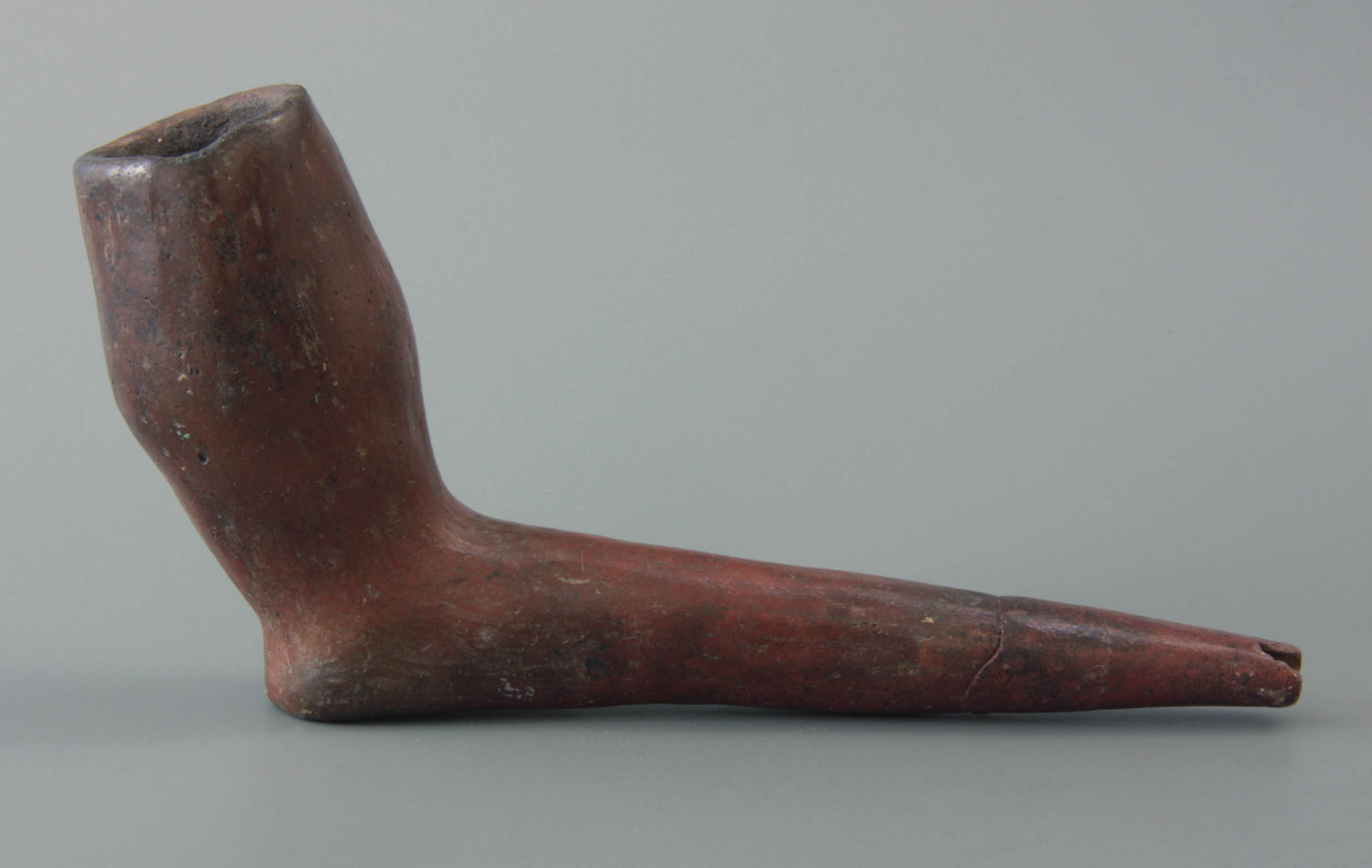
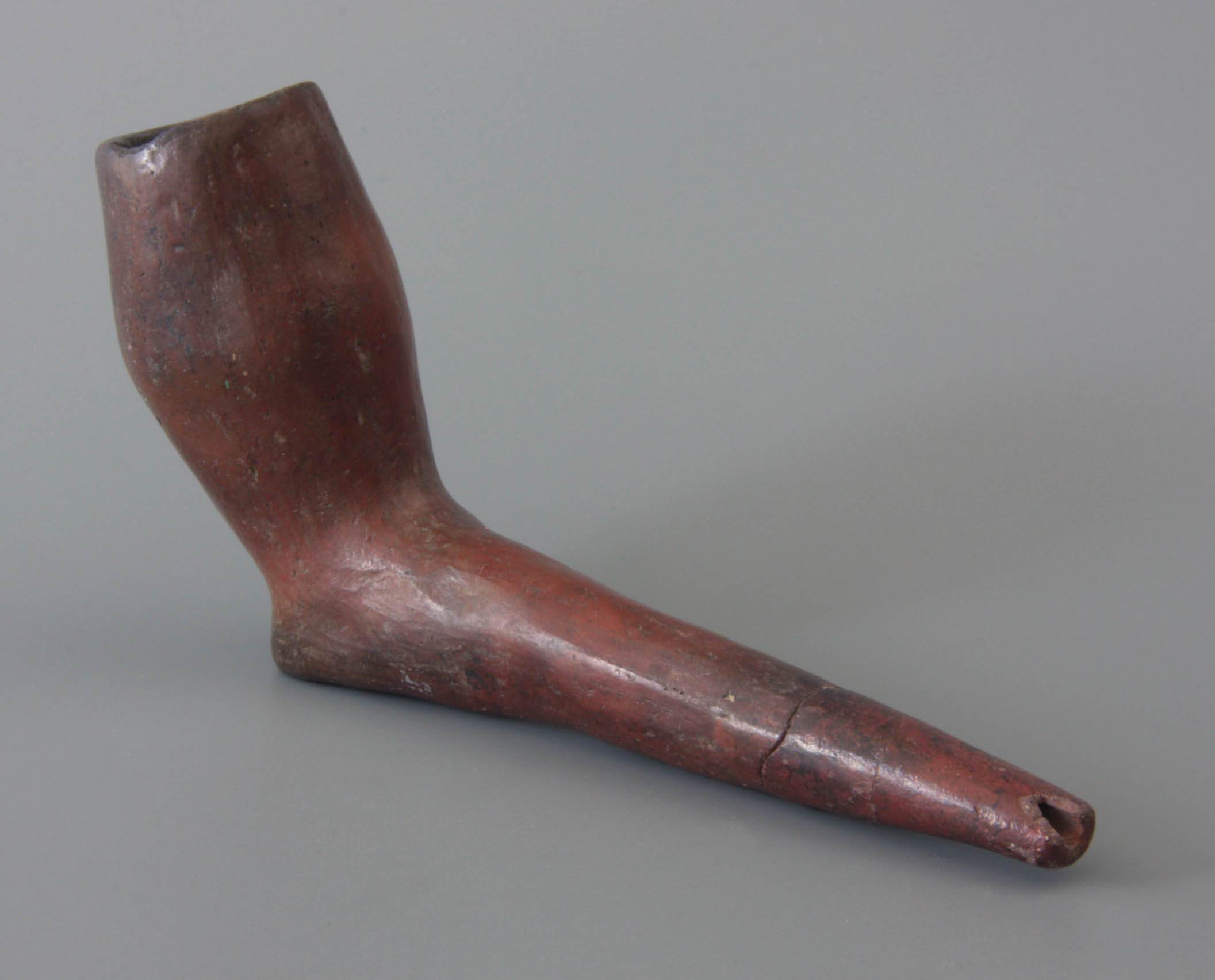
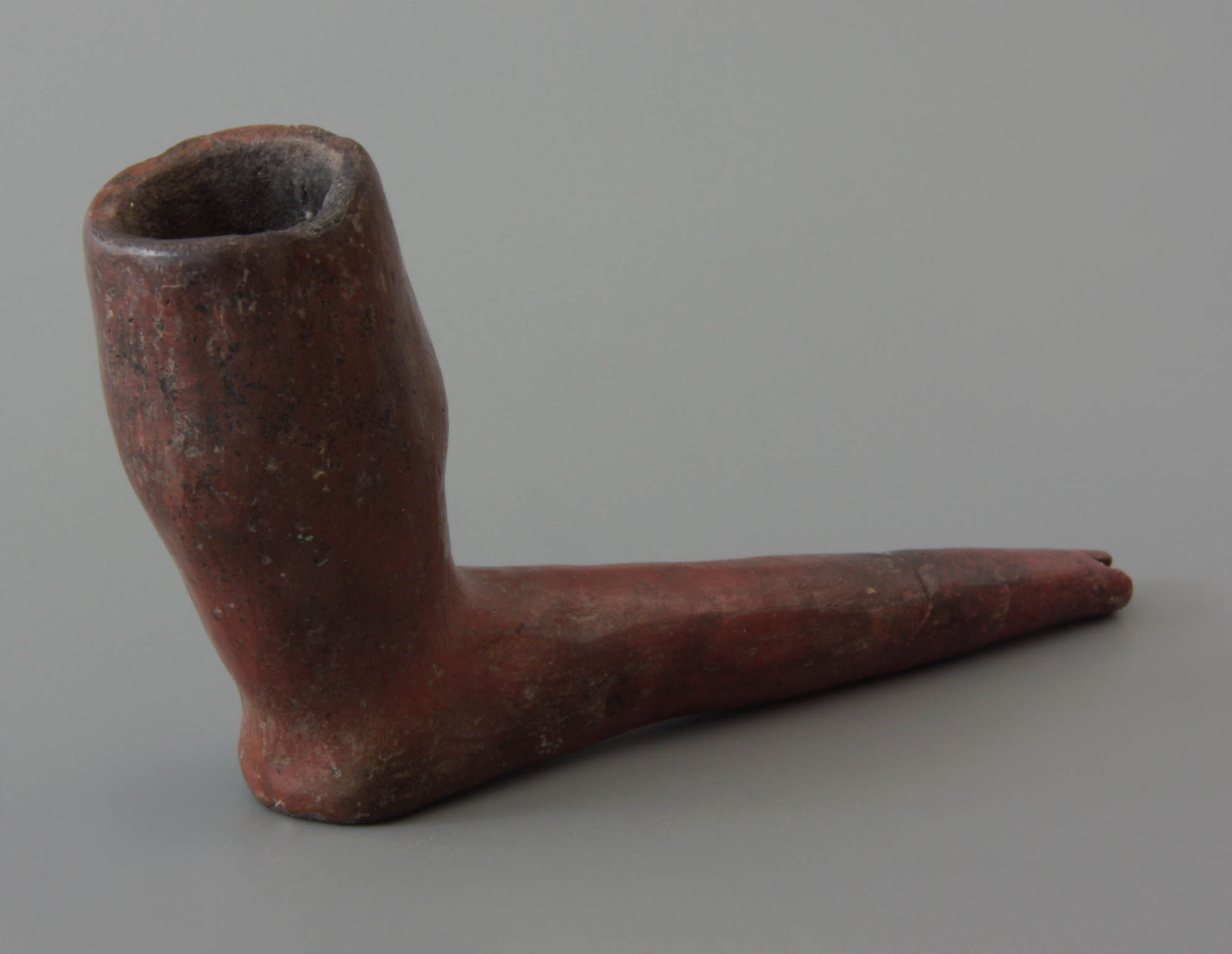
The pre-Columbian pipe depicted here shows the greatest resemblance to the pipe shape that became popular in Europe. It is a simple pipe made of grey ceramic. After modelling the surface is provided with a red slip or engobe which has subsequently been smoothed. A more or less regular pattern of stripes is obtained by brushing along the leather dry clay with a hard polishing tool. After baking this ensured a lasting shine.
As expected, the dimensions of the American pipe are completely different from those of the early European counterparts. For example, the bowl has a height of almost eight centimetres and is therefore more than three times higher than that of the Dutch clay pipes from the first generation. The stem, on the other hand, is not correspondingly longer, it only measures 11.5 centimetres. Because it is thick at the beginning and tapers thinly towards the mouthpiece, the diminishing of the diameter of the stem is much stronger than we see in the Dutch pipes. Despite these differences, the appearance of this American pipe with its double conical bowl, flattened underside and short, straight stem is in line with the original shape of the European tobacco pipe.
We are uncertain about the age of this pipe. It must date between 500 and 1500. For decades this object was part of the well-known SEITA collection, the museum of the French tobacco monopoly. That museum acquired the pipe from Eugène Jance's famous collection. Jance lived in Marseille and collected everything related to tobacco and smoking for decades. Unfortunately, insufficient attention was paid to documenting the material during the transfer of that collection. Eventually, Jance's notes got lost. With it, the object information about the date, location and circumstance of excavating, including the name of the person who found this item, was lost for posterity.
Amsterdam, Pijpenkabinet collection Pk 19.923
Archaeological
A pipe like a horn
The Dutch clay pipe is a typical serial article. It is made in large numbers in a press mould and is therefore uniform in shape. Only during the finishing some additional actions could increase the quality. In rare cases does the pipe maker feels the need to come up with something original and therefor interrupts the serial production. Then he moulds a special object out of a piece of pipe clay, with or without pre-formed parts from a mould. An example of this is the pipe shown here in the form of a bent horn.
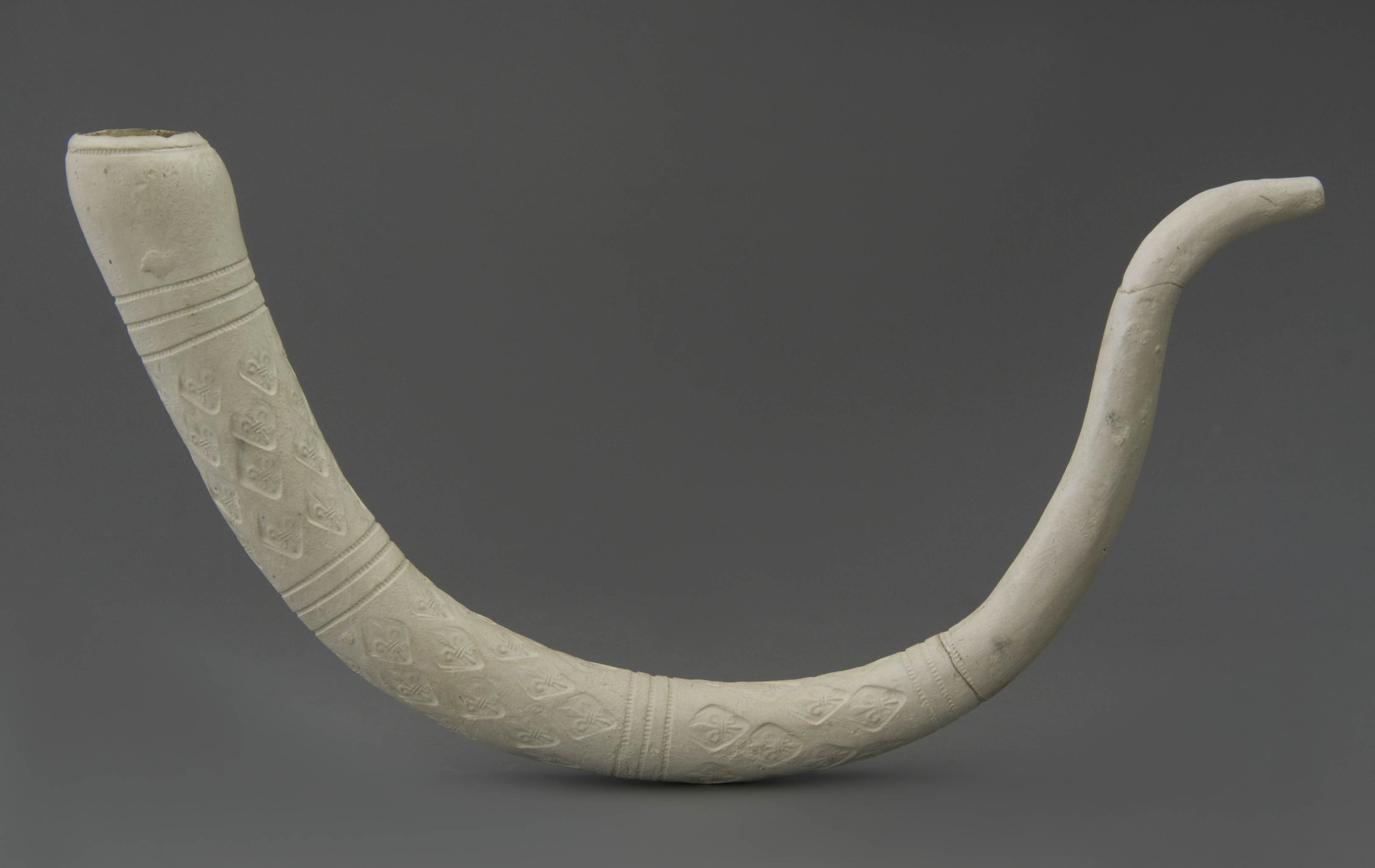
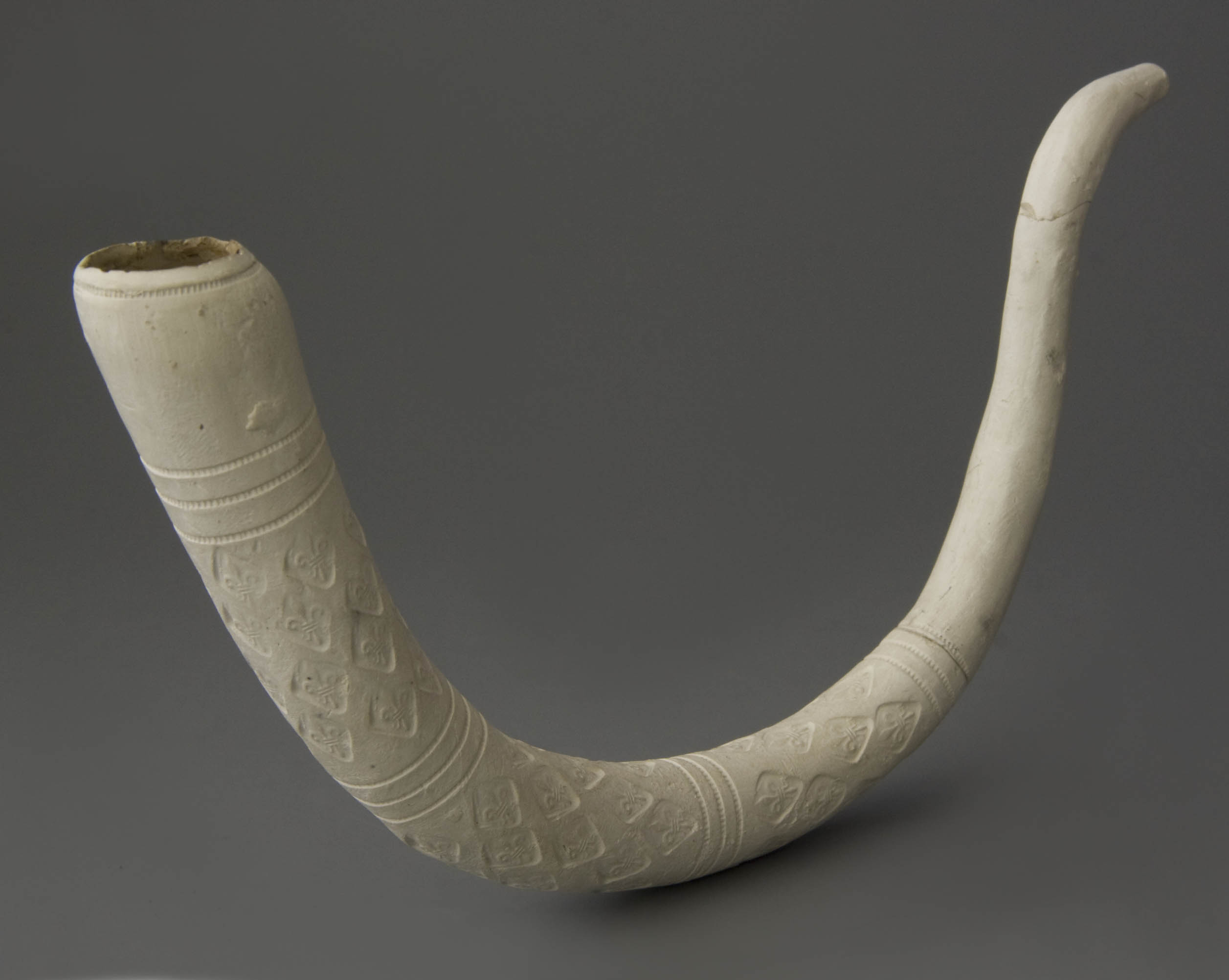
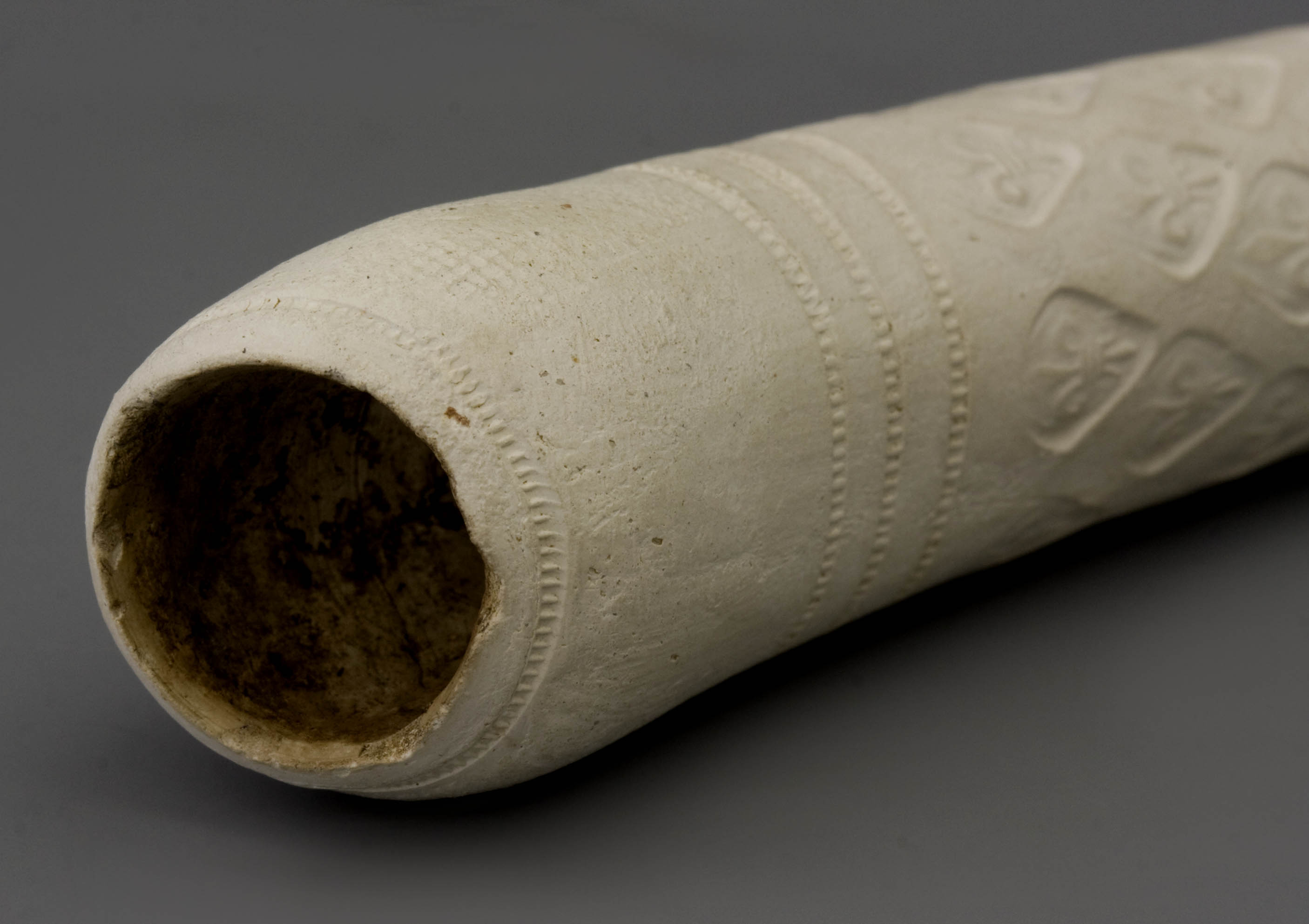
Although this pipe is largely made by hand, it is really a product by a regular pipe maker. The bowl was pressed in a standard two-piece press mould that was only available at the pipe makers’ workshop. Subsequently, a much thicker stem was made on this pipe bowl, which was connected to the largest diameter of the pipe bowl and was strongly tapering towards the end. This probably happened on the wire, the pin that was normally used to make the smoke channel. After the surface was smoothed and the iron wire removed, the clay roll was bent in a large upward bend with an opposite bend at the mouthpiece. A stamped decoration, consisting of three batches of lilies in diamonds, is arranged as a finish, each group separated by three concentric rings of millings.
Such pipes can be made anywhere in the Netherlands, although the tools point to manufacture in the city of Gouda. Firstly, the press mould used has the so-called dikkop size, a pipe shape that was launched in Gouda in the 1640s and has only been popular for a short time. In addition, the use of a specific milling stamp and the stamp to make the diamond shape filled with a lily are characteristic for the city of Gouda pipes. This version of the lily motif is in Gouda in use between 1645 and 1650, after which it changes its size and appearance. The date of the stamp corresponds to the production period of the press mould used.
You would expect that such a hand-modelled pipe is unique, but that does not seem to be the case. More often fragments of such pipes were found, but because they were small pieces, we remained uncertain about the shape of the complete pipe. This discovery from the city centre of Leiden means that we now know what a complete pipe has looked like. The way of making indicates that it cannot be unique, rather a product made in a small series. The method of manufacture is too perfect and above all too sophisticated to be a piece on its own. Although the bent horn as a pipe has been a temporary phenomenon and only became known among a small group of smokers, the spread is still wider than one would expect. Most surprising, however, is that fragments have been excavated in Virginia from a nearly identical curved horn pipe, made locally but unmistakably with an example of such a Gouda specimen.
Literature: Don Duco, Thoughts around a mysterious find complex, 1995.
Amsterdam, Pijpenkabinet collection Pk 9.601
An exotic from the polder
Most of the pipes found in the soil are ordinary pipes in common shape, sold by the thousands, generally smoked and then thrown away. It is only rarely that an alternative smoking instrument is found, coming from a smoker who liked to show off with something special. Such a remarkable discovery was made in 2001 in Schermerhorn near Alkmaar. From an ditch fill a most exotic pipe emerged, which apparently came to the province of North Holland as a souvenir.
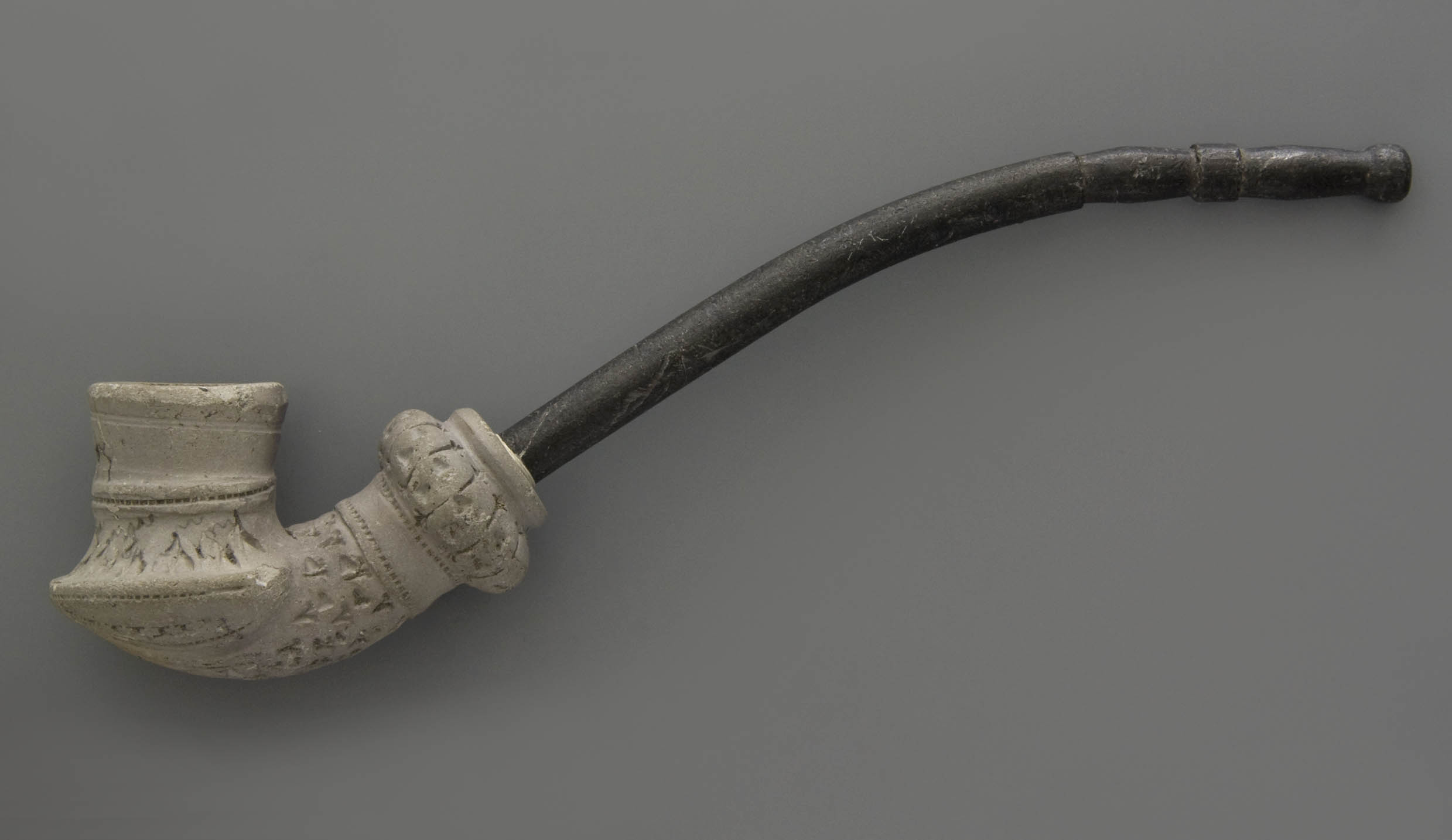
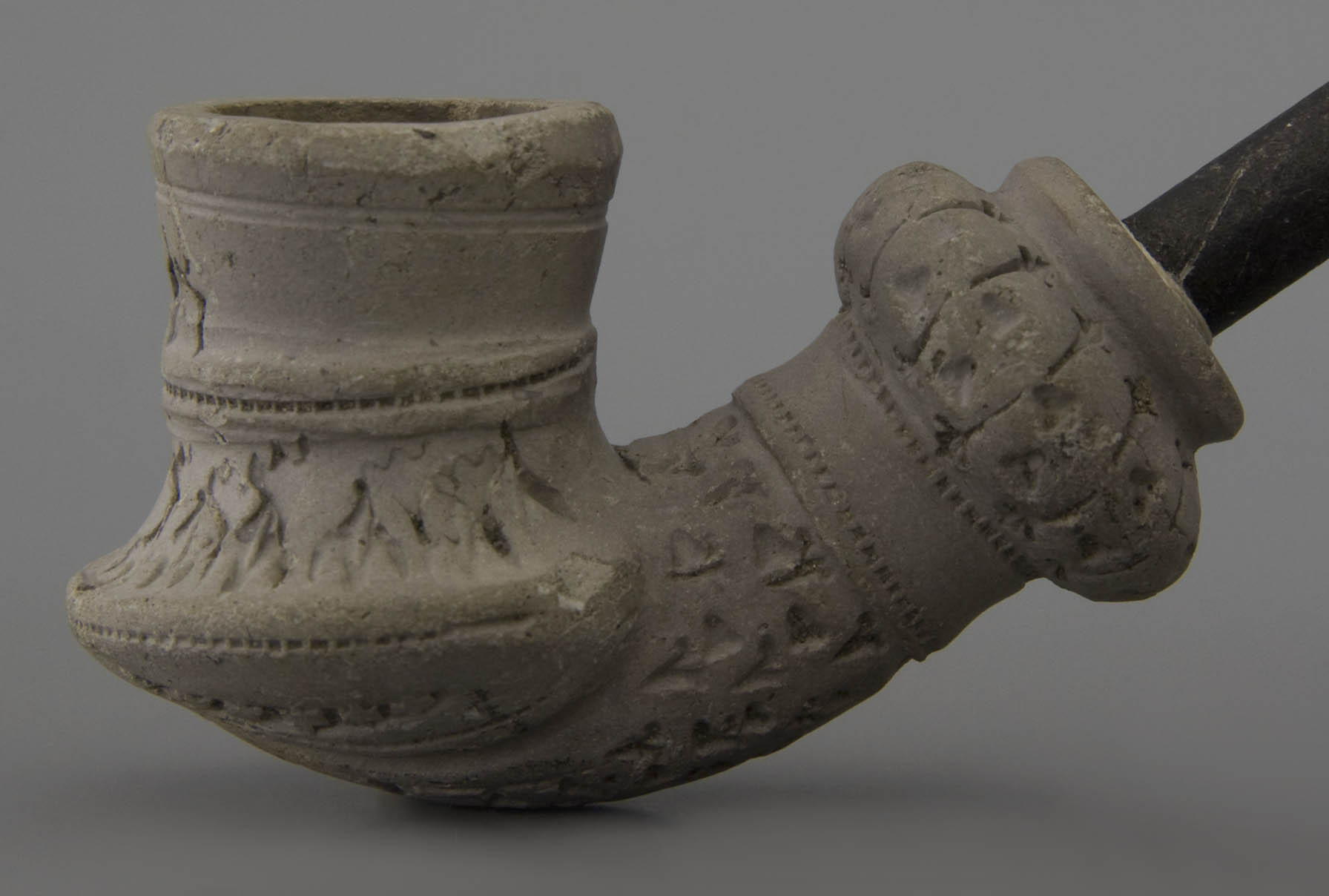
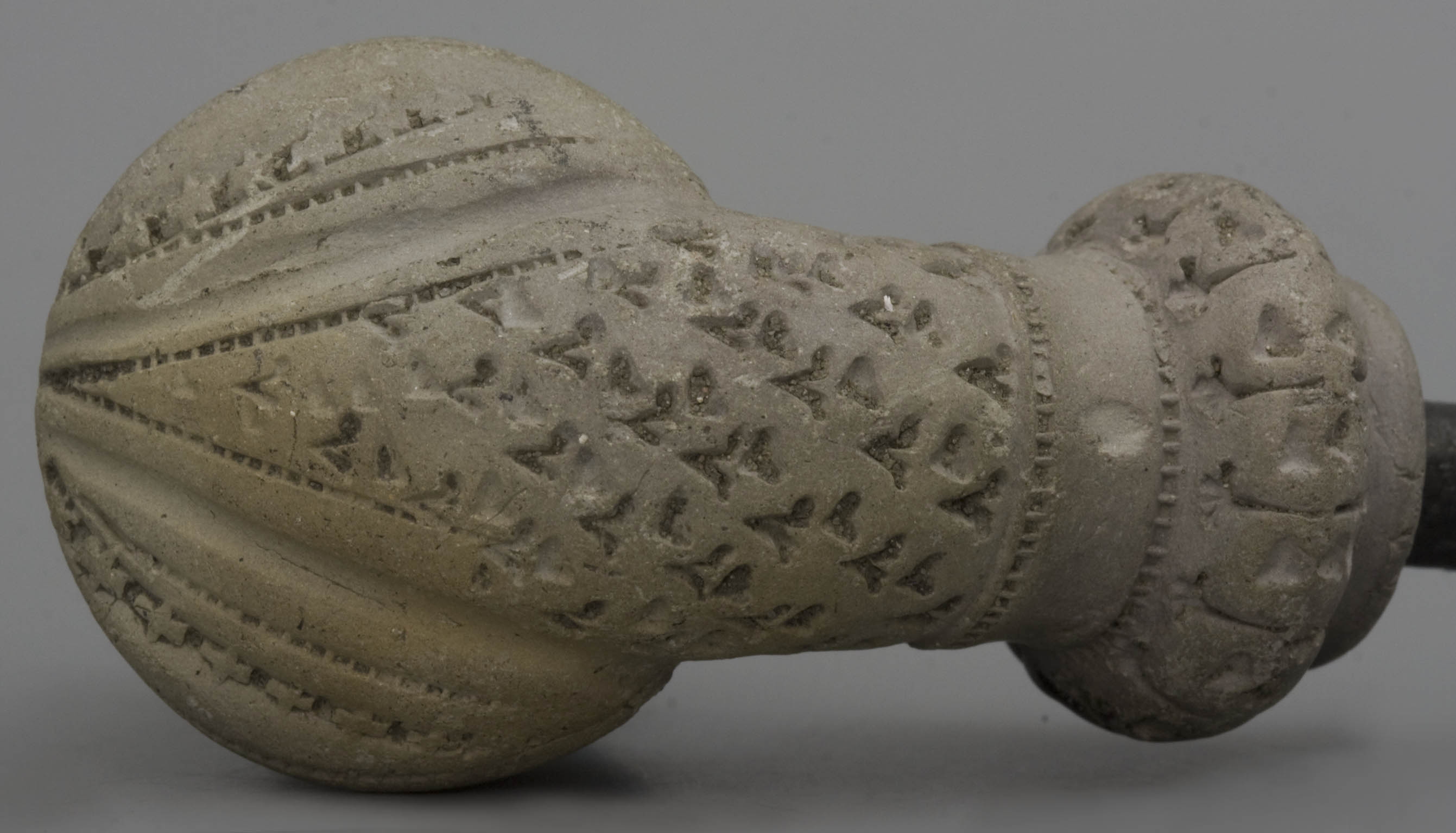
It is a so-called stub stemmed pipe, a pipe with a truncated stem to which a separate stem was attached. The pipe bowl is made of a relatively soft baked light grey clay. As a result, the pipe guarantees an optimal absorption of the tar and nicotine juices released during smoking, resulting in dry and therefore tasteful smoking. For the Dutch smoker the bowl is generous in size, the local pipes were certainly three times smaller. This pipe bowl has a cylindrical shape with a slight reinforcement at the opening. A dish-shaped widening has been applied at the base, which turns into a semi-circular underside. A kind of rat tail is visible as marking of the underside and as a prelude to the stem. The pipe is provided with a rising stem that is reinforced with a cuff band with a semi-circular profile. Although the stem ends with a cuff, it still runs through the same diameter. All these characteristics indicate an origin in the Ottoman Empire.
Completely opposite to the Dutch clay pipe, this product is not printed in a two-part mould but is made on a potter’s wheel. Bowl and stem are turned separately and then glued together with some moist clay, the so-called rat tail functions as reinforcement. Then the seams were carefully smoothed out. Finally, a decoration was stamped that made the last traces of gluing the two parts invisible. During the stamping of the decoration, a repetitive pattern was created, separated by ropes and chain lines. How seriously this decorating was done is proven by the fact that 120 individual imprints have been made. It is striking that the four different stamps that were used alternatively differ so little in detail that the effect with one and the same stamp was hardly any less.
In addition to the fact that the pipe bowl still is in perfect condition, it is unique to this find that the original stem was also found. Against everyone's expectations, it is not a stem made of reed, wood or bone, but in lead. This might be a local replacement for a previous one that was blocked or broken. Especially the stem end is remarkable: this is cut out so that it gives the impression of being copied from the original twisted stem end. By the way, lead is not a suitable material for a pipe stem, it gives off taste and does not absorb moisture. Fortunately, the latter, negative factor is more than compensated by the porous bowl, so that the pipe will still have smoked pleasantly.
The fact that such an exotic pipe was found in the rural Schermerhorn is unexpected but not completely strange. The population lived there from fishing and shipping. It is possible that one of them signed on a ship heading for Gibraltar and ended up in the eastern Mediterranean. For example, this pipe made at a distance of at least two thousand kilometres can end up as a travel souvenir in Schermerhorn. In view of the finding conditions, this must have been between 1665 and 1685. At home, the smoker was in any case assured of all attention for his exotic smoking equipment.
Literature: Don Duco, An exotic pipe from Schermerhorn, Amsterdam, 2003
Amsterdam, Pijpenkabinet collection Pk 16.824
The Stadtholder as party pipe
Over the centuries the House of Orange has always been a source of inspiration for making special pipes. Not surprisingly, the House of Orange was widely supported and a pipe devoted to a happy or memorable event could count on good sale. This topic has already been discussed extensively in the publication De tabakpijp als Oranjepropaganda (The tobacco pipe as propaganda for the House of Orange) and is illustrated with dozens of commemorative pipes. A specimen that does not appear in that book is this special tobacco pipe. When the Orange book came out it was still uncertain who was depicted in the pipe, especially because at that time only fragments were known.
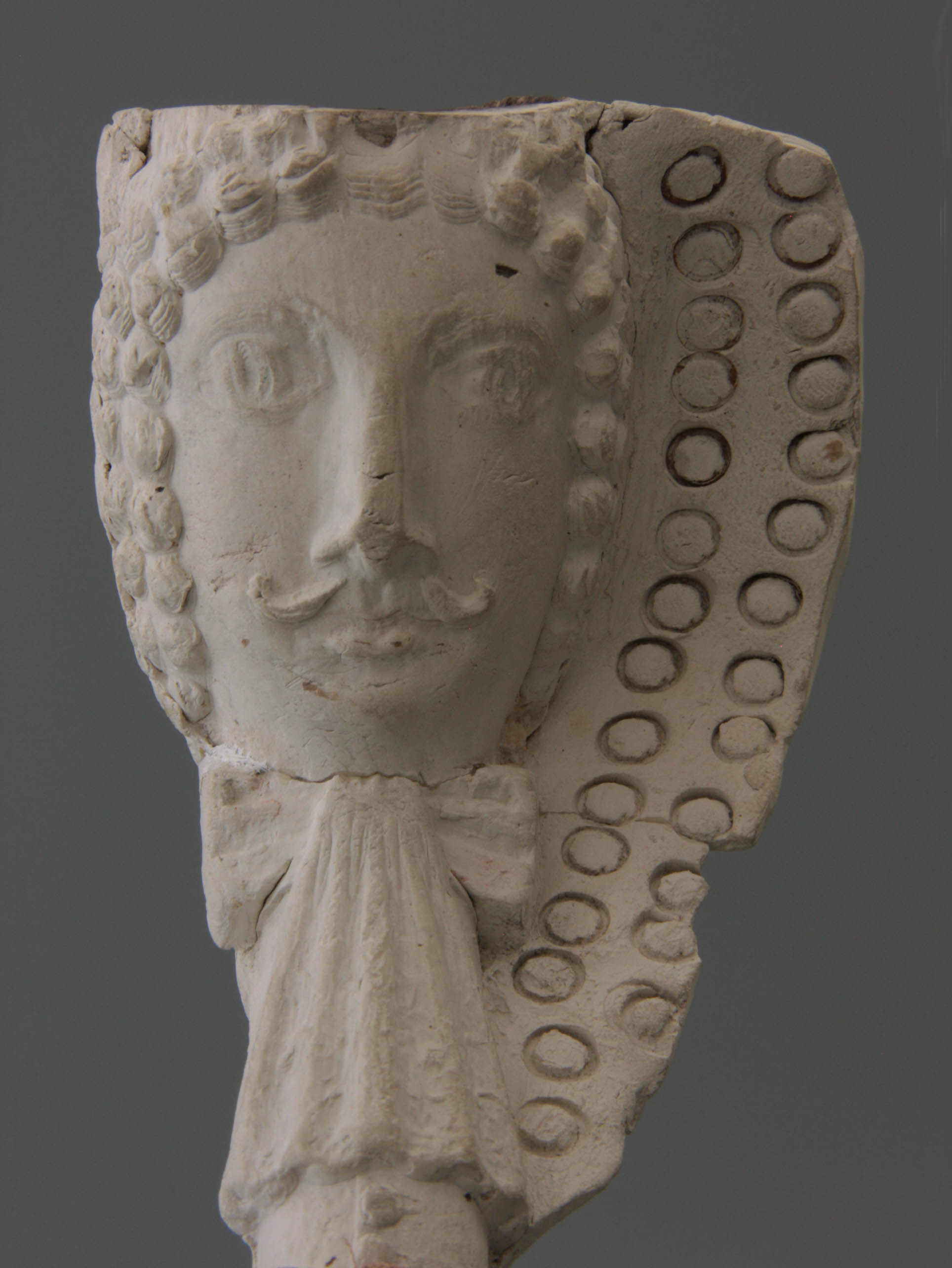
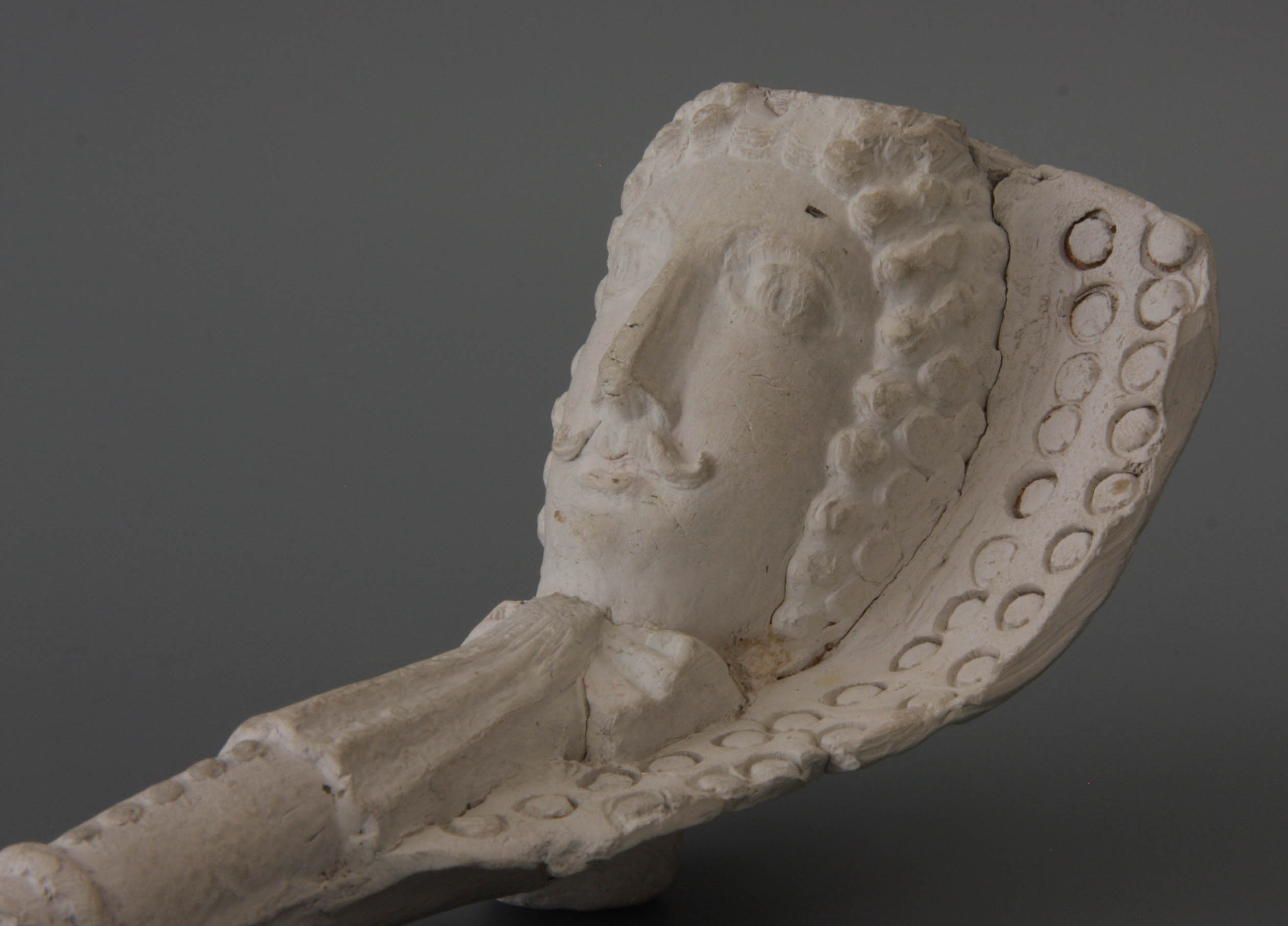
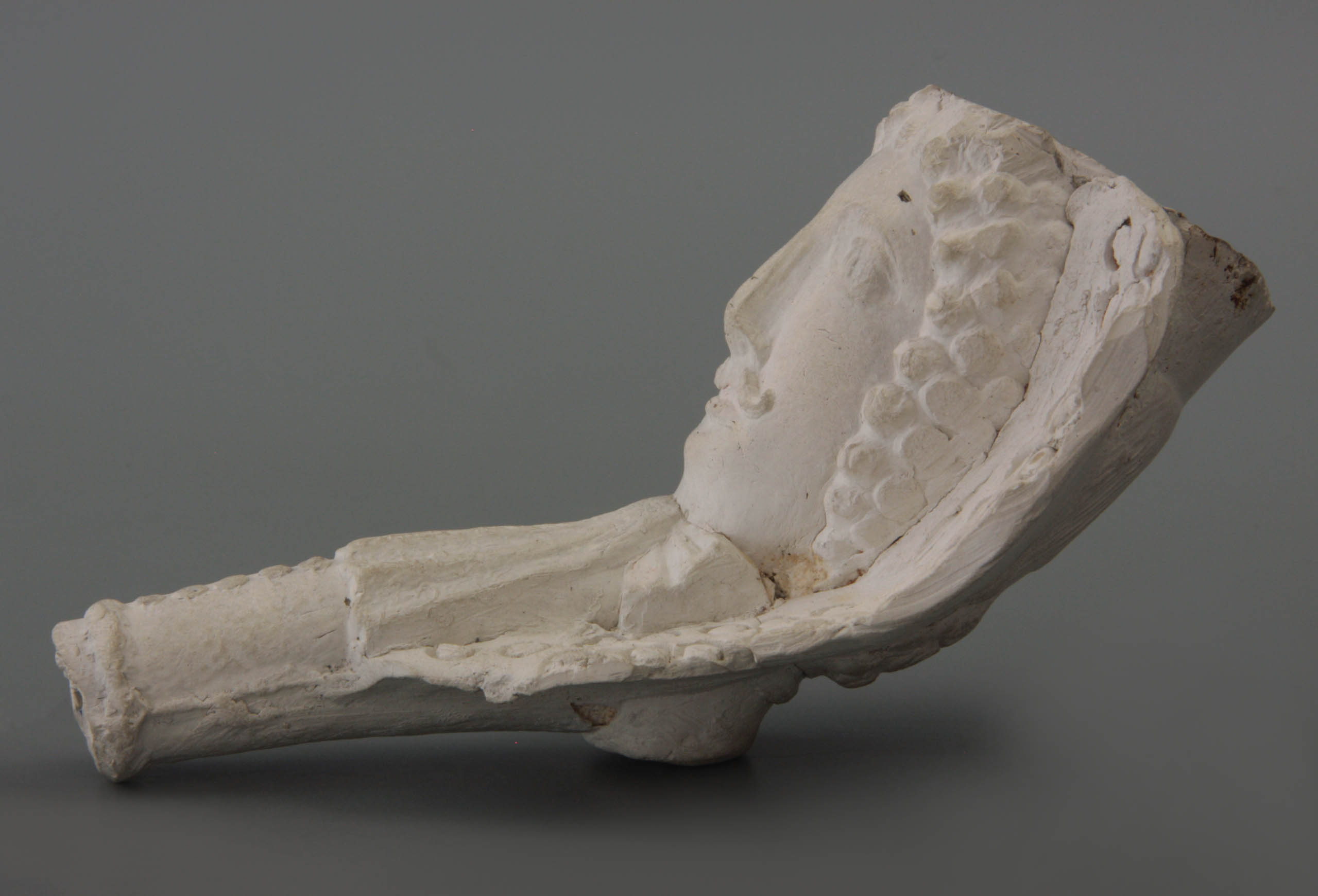
It is a large-sized tobacco pipe that differs in every respect from what was regular in that period, the end of the seventeenth century. With a height of 9.5 centimetres and a diameter of over 5, this pipe is many times larger than the standard bowl size at the time. The standard pipe bowl was at that time about four centimetres high with a diameter of less than two. Figural pipes from that time are also an exception, but in this format it is certainly an exceptional showpiece.
The pipe represents Stadtholder William IIIrd, by his marriage raised to King of England in the year 1689. With his hair and bow he is dressed to the fashion of his time. Although more statesmen, high officers and naval heroes were dressed in this way, this is unmistakably the Stadtholder-King, as he is known from formal portraits and the numerous prints derived from them. The date of this pipe is therefore between 1690 and 1700, possibly several years later.
The prototype for this portrait pipe can be seen as being modelled out of hand and the result is little sculptural. The face is rather flat, the eyes, nose and mouth not very pronounced. The face is surrounded by a wig made up of small semi-spheres and only at the back the hair is shown in straight lines that form an unexpected contrast with the curls. All in all not a very naturalistic representation. At the transition from the bowl to the stem you can see a scarf, the pleated end of which hangs over the stem. A bow to the fashion of the days around 1700. On the stem the image is continued with a few clothing buttons, an little ring round the stem indicates the waist of the sitter. The plan to create a full-plastic, three-dimensional portrait head is only moderately successful.
Special about this pipe is the method of manufacture. Clay pipes are pressed into a two-part metal mould, but certainly no metal is used for this specimen, but rather ceramics, to be concluded by the blurry impression. The giant mould did not close in the usual way with a left and a right half, but the seam runs along both sides of the pipe bowl. The mould box therefore consists of a lower and an upper half, which is ingeniously conceived in itself. Partly because of this, the pipe makers' mark could be applied in the mould and did not have to be printed separately.
How large the circulation of this giant pipe has been can only be guessed. It is certain that it was a serial article that was made in plural. A ceramic mould, however, wears quickly of, so after a few hundred pieces the sharpness has decreased. In the meantime fragments from the same printing mould have been known from various find spots in the Netherlands.
Several specimens of this pipe are provided with a moulded crown, which gives the pipe bowl a height of twelve centimetres. Also with this pipe, the onset of it is still visible, the crown itself is apparently broken off and lost. When the printing mould had lost its sharpness, the pipe maker felt the need to compensate the wear with additional modelling work. The worn form seam was obscured by suggesting a wig here, which was provided with simple circular prints to resemble pipe curls. It is hardly a beautification. The modelling work on the pipe does indicate the atmosphere of production, which was certainly serial, but still remained limited in numbers. We can wonder if the wig was an attempt to depict a portrait of the French king Louis XIV, instead of approaching the Stadtholder. The Sun King had a very similar appearance but a much more impressive wig.
The initials HIS on the heel refer to the maker, a man named Hendrick Jansz. Sprot from Gouda. Because of his second marriage in 1687, Sprot ends up in the pipe industry via his father-in-law. He learns the trade and finishes his master's proof in 1690. Presumably he worked in the company of his father in law. A few years later Hendrick will take over this workshop and his mark the tea pot. His own mark, the initial mark HIS, does appear in the guild administration but is rarely found on pipes. The pipe making workshop of his father-in-law was sufficiently lucrative to provide a good existence. Nevertheless, Sprot has been looking for new sales opportunities.
Inevitably, such a special pipe raises questions. Technically about what the mould looked like. Also how large the production numbers have been and whether this pipe was made incidentally or at the occasion of some special event. In addition, we can speculate about the use. The pipe can be used as a smoking pipe, but can the smoker afford so much tobacco? In view of the smoke traces in our example, this pipe was smoked at least once. Of course, the pipe can also be used as a hang-out sign for a pipe store. Some fragments have been pierced at the heel, so that the pipe could be easily hung. With such a big pipe you make more effective advertising than with a standard product and in addition you confess your sympathy for the House of Orange. In a special case, this object could also have circulated as a drinking utensil in the pub, for example when drinking an orange liquor.
Amsterdam, Pijpenkabinet collection Pk 20,250
Pipes made of clay
A mysterious standard Gouda pipe
From the beginning of the eighteenth century, the name maatpijp, standard pipe is a fixed concept. It is a long clay pipe from Gouda with a straight stem. Initially these pipes were 17 thumb or inches long, then 19 inches to end up at 21 inches or more than fifty centimetres. Pipes with this stem length and a standard oval bowl shape fit into an industry with high product standardization and fierce competition. The maatpijp has been a common article for two centuries. Everyone knew them and wanted to smoke them. The pipe tasted pleasant because of the long stem that cooled the smoke well.
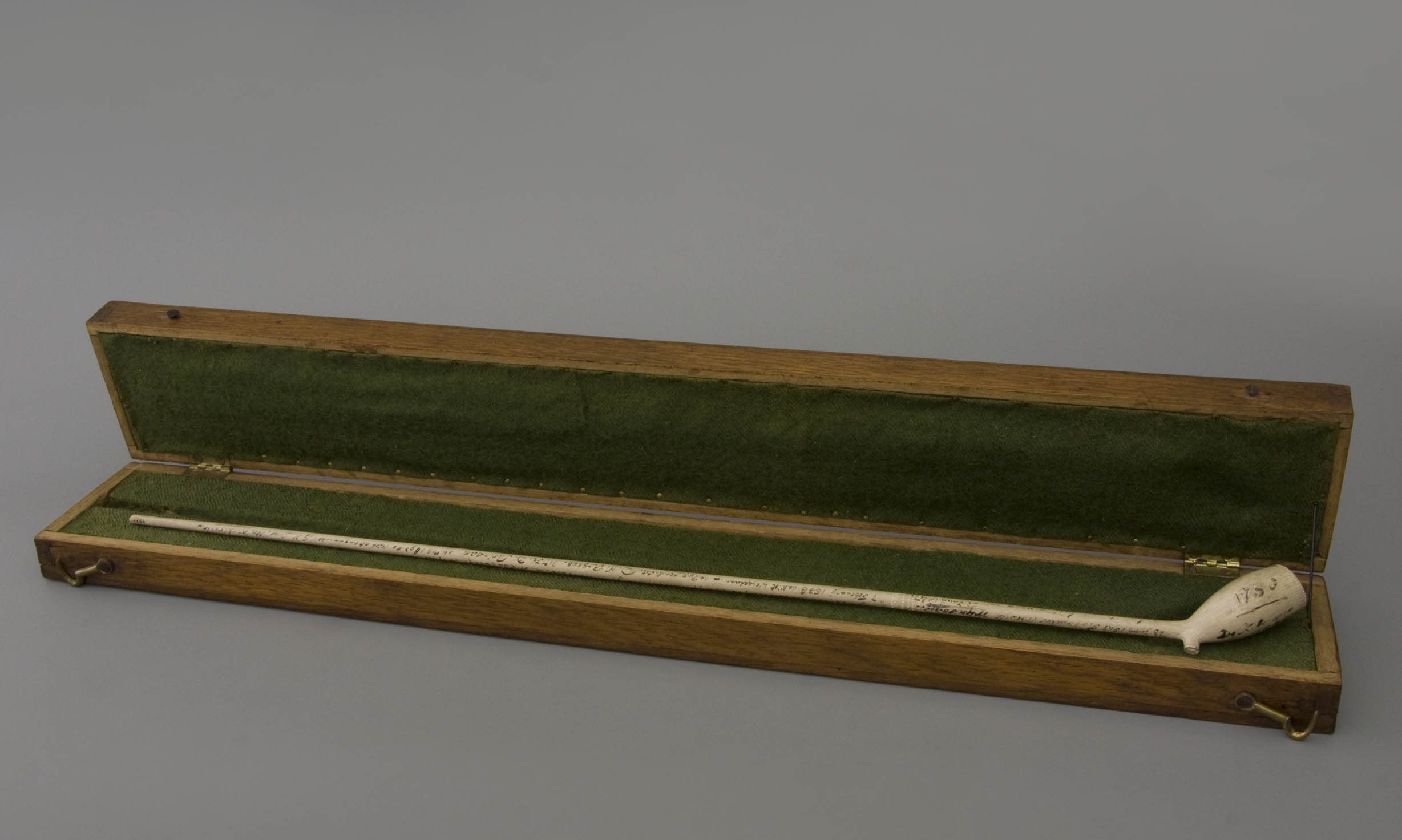
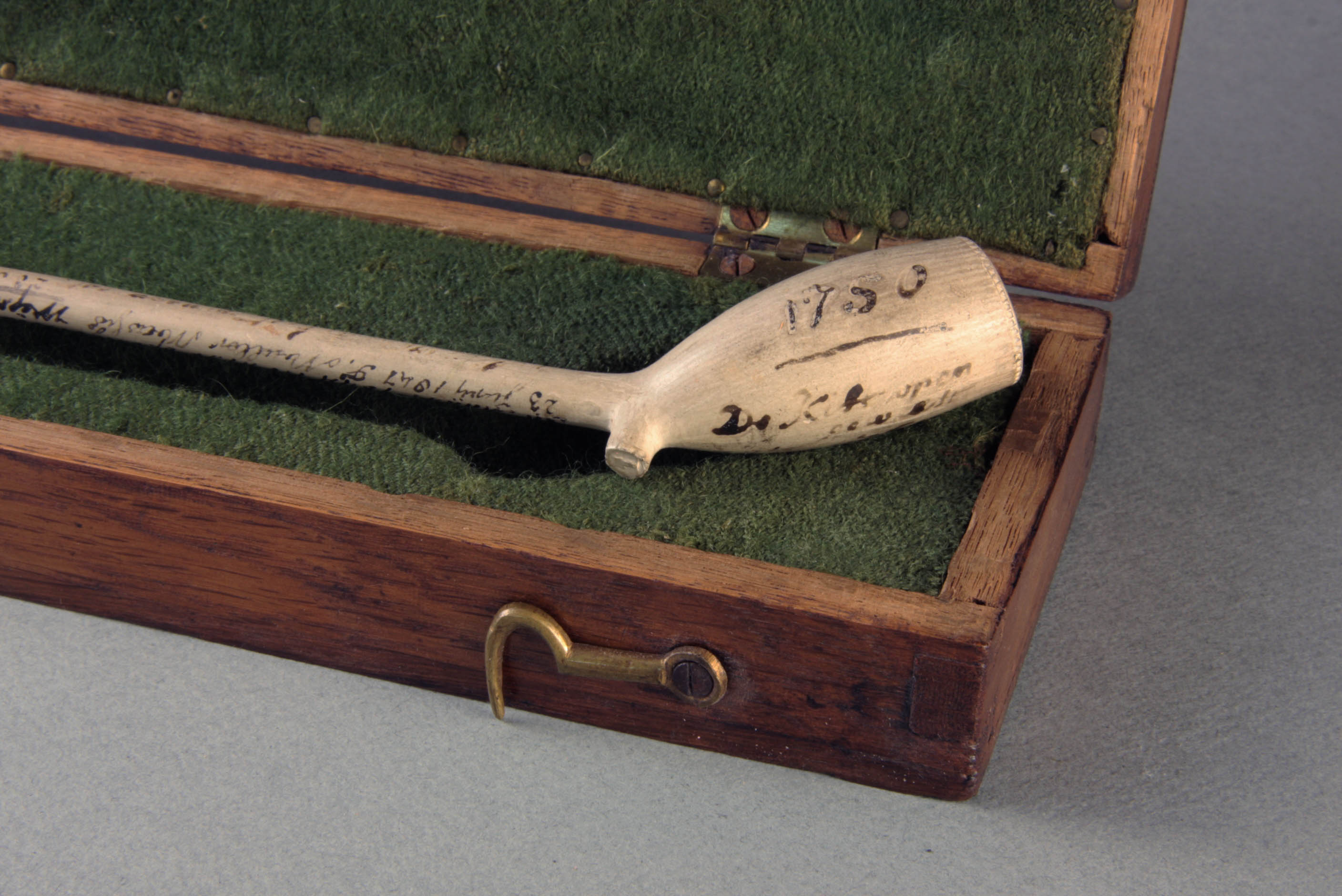
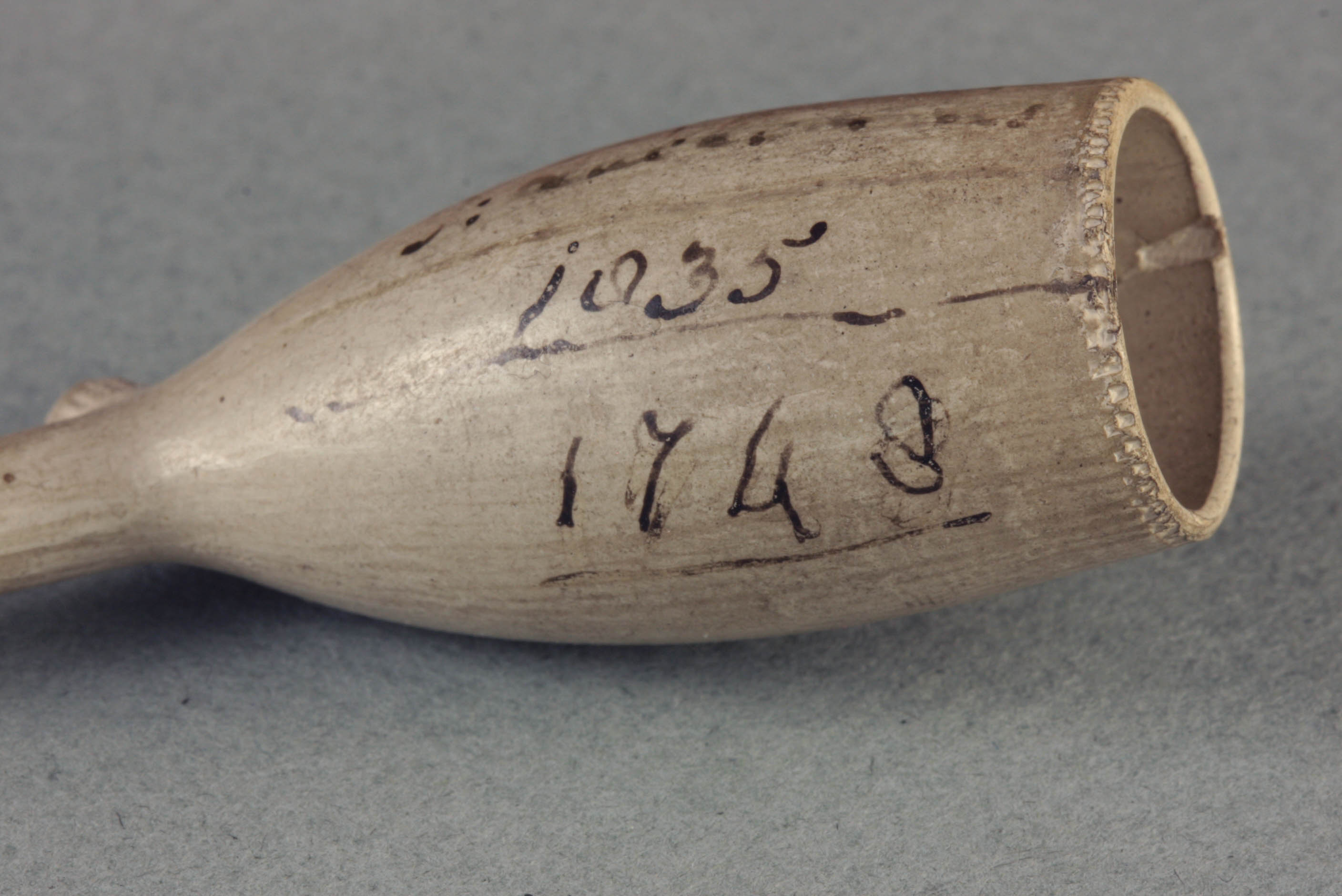
There was always a fresh supply of the maatpijp and apparently nothing changed on the product. Therefore, no-one has ever had a reason to preserve such a pipe as a time-bound object. The article was always repurchased and used copies were smoked without mercy until the end. So, the more rare it is when by chance such an ordinary pipe has been preserved. That is the case with the clay pipe depicted here, which is neatly protected in a box for breakage and thus survived the centuries.
The elongated oak storage box closes with two brass hooks and in the interior is hollowed out in order to provide a safe space for the pipe to comfortably rest on a green cloth. This way the clay pipe remained intact and eventually won the predicate “oldest preserved maatpijp in the world”. Thanks to the marks, we know the origin. On the stem is stamped "I: WOERLE" and "IN GOUDA" which refers to the Gouda pipe maker Jan Woerlee, active from 1736 to 1777.
Special about this pipe is that the bowl and stem show inscriptions. It appears that this pipe was in use by the regents of the poorhouse in Leiden. The series of 23 different names on the stem corresponds with the regents of this alms house in different years. It seems that the pipe has served as a ceremonial object. When the gentlemen regents met, they wrote their names and the year on the bowl or on the stem of the pipe in ink. That use started in 1748 and as continued until the last time in 1893.
Unfortunately, we can only guess at the circumstances of this wondrous use. Especially a few in-betweens give opportunity for further speculation. For example, from the inscription of 7 February 1838: "the box removed, the pipe moved" or that of 30 March 1844 "the box has been opened and the pipe has been moved". A remarkable text is also: "Congratulations to the further readers" even though the word smokers had been better placed for a pipe here.
Mentioning the box does not seem to refer to the wooden box of the pipe itself, but rather to a larger chest in which the pipe with box and all was kept. Did they mean the cash box of the poorhouse in which the assets were kept? Then the names should be that of the treasurers. Strange is that the box was only opened once every few years, sometimes even at great intervals. Should the valuable contents of the chest not be inspected more often? For the time being it seems that this riddle is not solved and that is the intriguing added value of this oldest preserved maatpijp. In any case, one thing is certain: no-one has ever enjoyed the smoking of this pipe, tobacco has never burned in this pipe, so the bowl is still virgin white inside.
Amsterdam, Pijpenkabinet collection Pk 4.970
The cigar holder by Andries Van Houten
In the second half of the eighteenth century smoking cigars became known, initially with thin cigars that were rolled completely by hand. The taste is a new sensation for the smoker. Until now people were used to a combination of American tobacco cut and mixed with local leaves from Gelderland or Alsace, the cigarillo made people get acquainted with a heavier and fuller taste. An important change was also the appearance for the smoker, who became more free, more casual. The cigar could be smoked with more nonchalance while at the same time it stood for greater luxury and a striking way of tobacco consumption.
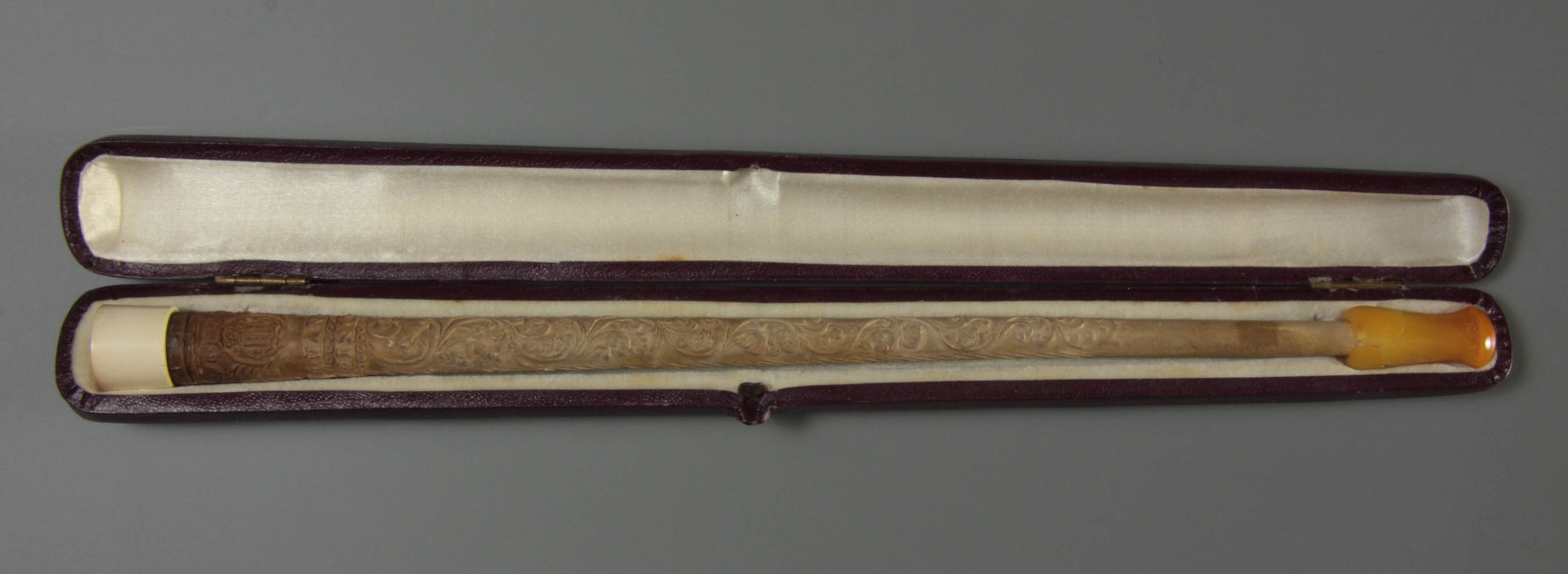
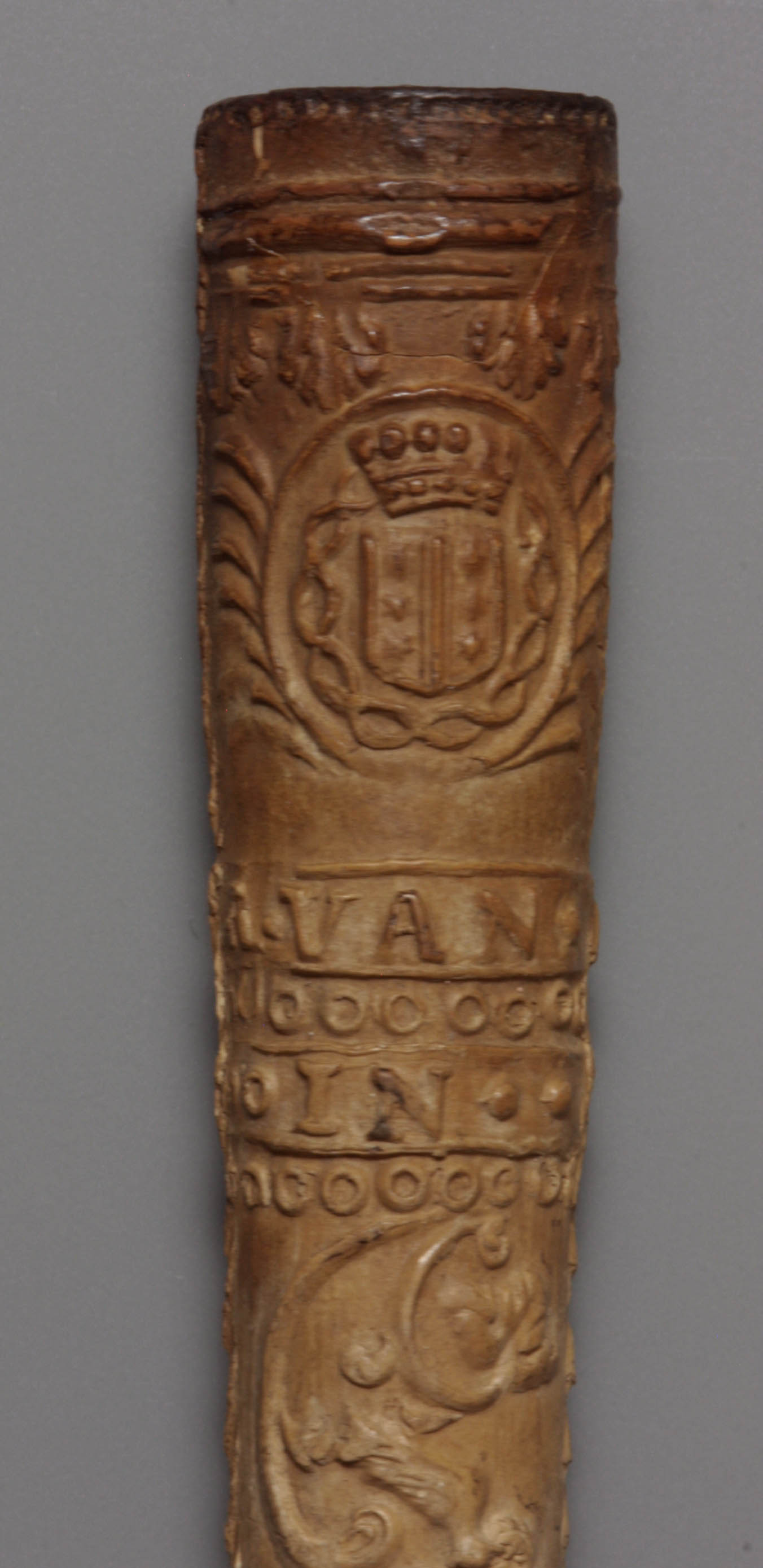
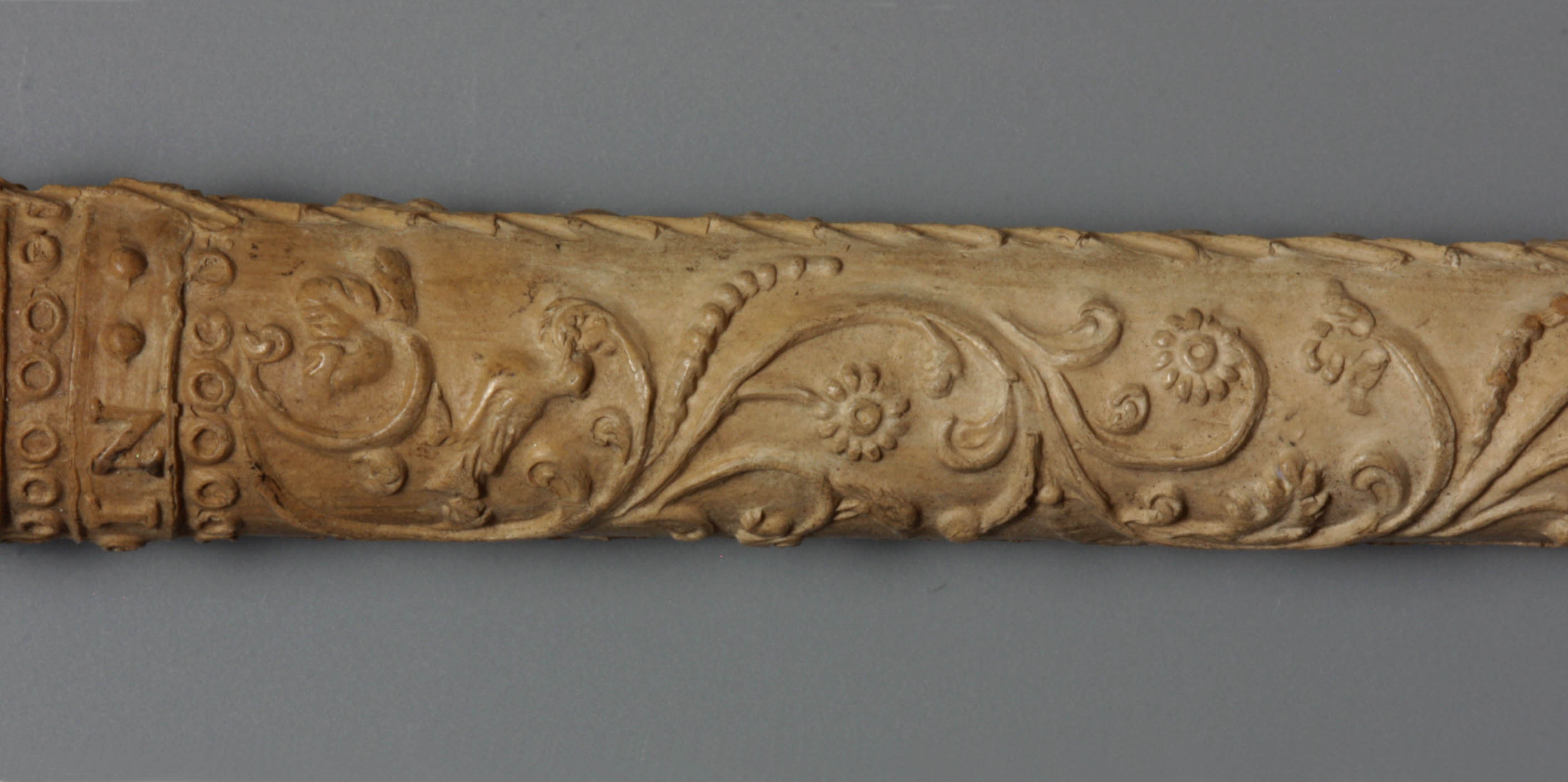
In the Netherlands, cigar makers quickly started a production in imitating the Caribbean cigars. The Dutch thrift led to the admixture of cheaper domestic tobacco with the positive result that the cigar was also affordable for the middle class. In order to emphasize the sophisticated way of smoking, cigar pipes appear soon on the market: simple straight tubular clay pipes in which the cigar is placed. They are called cigar pin.
The pipe makers in Gouda respond to this new smoking habit and make simple cigar holders. In line with the Gouda industry, they are finished just as beautifully as the Gouda tobacco pipe. After pressing in a mould and cleaning the mould seams, the surface is polished with agate to give the pipe a nice shiny appearance. In this way they fit the luxurious cigar with its dark matt appearance that contrasts beautifully with these bright white pipes.
One Gouda pipe manufacturer, however, designs a cigar holder that witnesses to a special luxury and extravagance. This pipe is not short but long and measures 21.5 centimetres. Moreover, this pipe is not smooth polished but decorated over the full length with an embossed decoration applied in the press mould. The pattern of this decoration is based on the usual decoration on the stems of the long Gouda pipes: a swinging tendril with leaves and flowers, interspersed with some animals such as a sitting pigeon on top and between the branches two minute flying birds.
Because an explicit pipe bowl is missing in this long, tubular pipe, the bowl part remains somewhat unobtrusive even if it is marked in the decoration. On the bowl part the manufacturer placed his mark crowned 73 between concentric rings with some foliage. On the reverse he placed the coat of arms of Gouda in a wreath of thorns as a sign for the place of origin. The makers’ pride is shown also in the addition of his name "A.VAN HOUTE" and "IN GOUDA". It is remarkable that this exceptional pipe design is based on the well-known Gouda decoration patterns; apparently, both Van Houten and the mould maker lacked the originality to think of a completely new decoration. Even the manner of finishing testifies to a certain rigidity. For example, a milling around the bowl opening has been made, in this case actually a superfluous luxury.
The Van Houten House was a totally atypical workshop. Where most companies in Gouda focused on the standard goods and mainly specialized in a certain length and quality, Van Houten mainly produced exceptional models. They sold these pipes as an assortment supplement to the standard products Van Houten bought from other workshops. This wonderful cigar pin fits perfectly in Van Houten's varied range.
That this fragile cigar pipe survived time is an absolute miracle. The production date will be between 1760 and 1790. The cigar holder has served as a regular pipe for years, the smoke traces testify to this. After that, the pipe will be stored as a curiosity. Eventually the object landed in Ruhla where it was mounted to German standard with a meerschaum bowl insert and an amber mouthpiece. Thanks to the fact that a protective case was added at the same time, the pipe was further safeguarded against breakage. In this way he could easily survive another century undamaged.
Amsterdam, Pijpenkabinet collection Pk 18.959
A figural pipe with a lid
In the 1830s a new craze developed in the pipe industry. After the fashion of the figural pipe had become a great success and the pipe was the conversation piece for the smoker, a following phenomenon occurred: the lifelike portrait head who could smoke himself! Different manufacturers bring such pipes more or less simultaneously on the market. These are heads with a lid that obscures the annoying circular cut of the bowl opening and makes the pipe into a full sculpture. Gradually that lid was provided with an added joke, which we see in the pipe shown here.
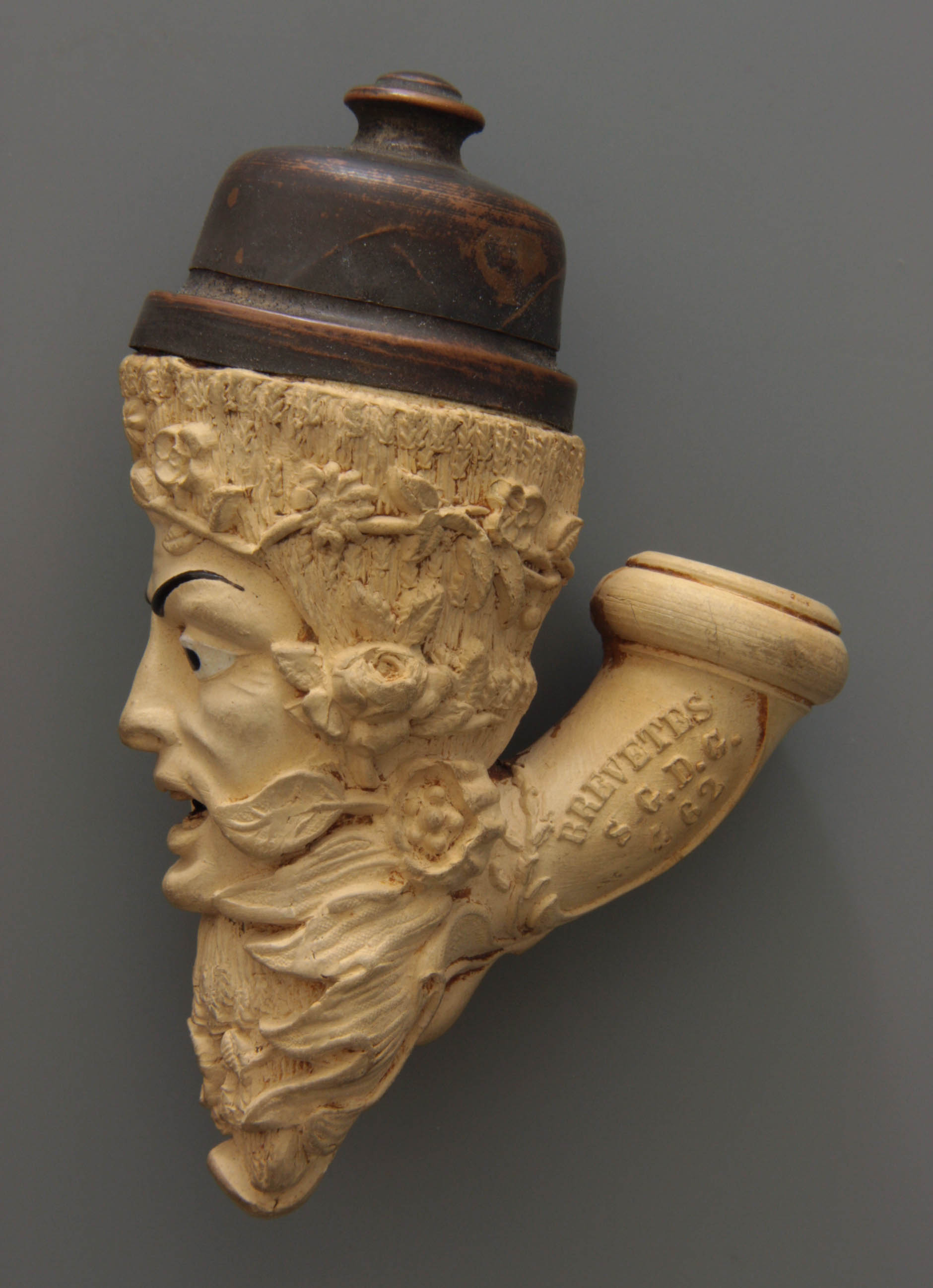
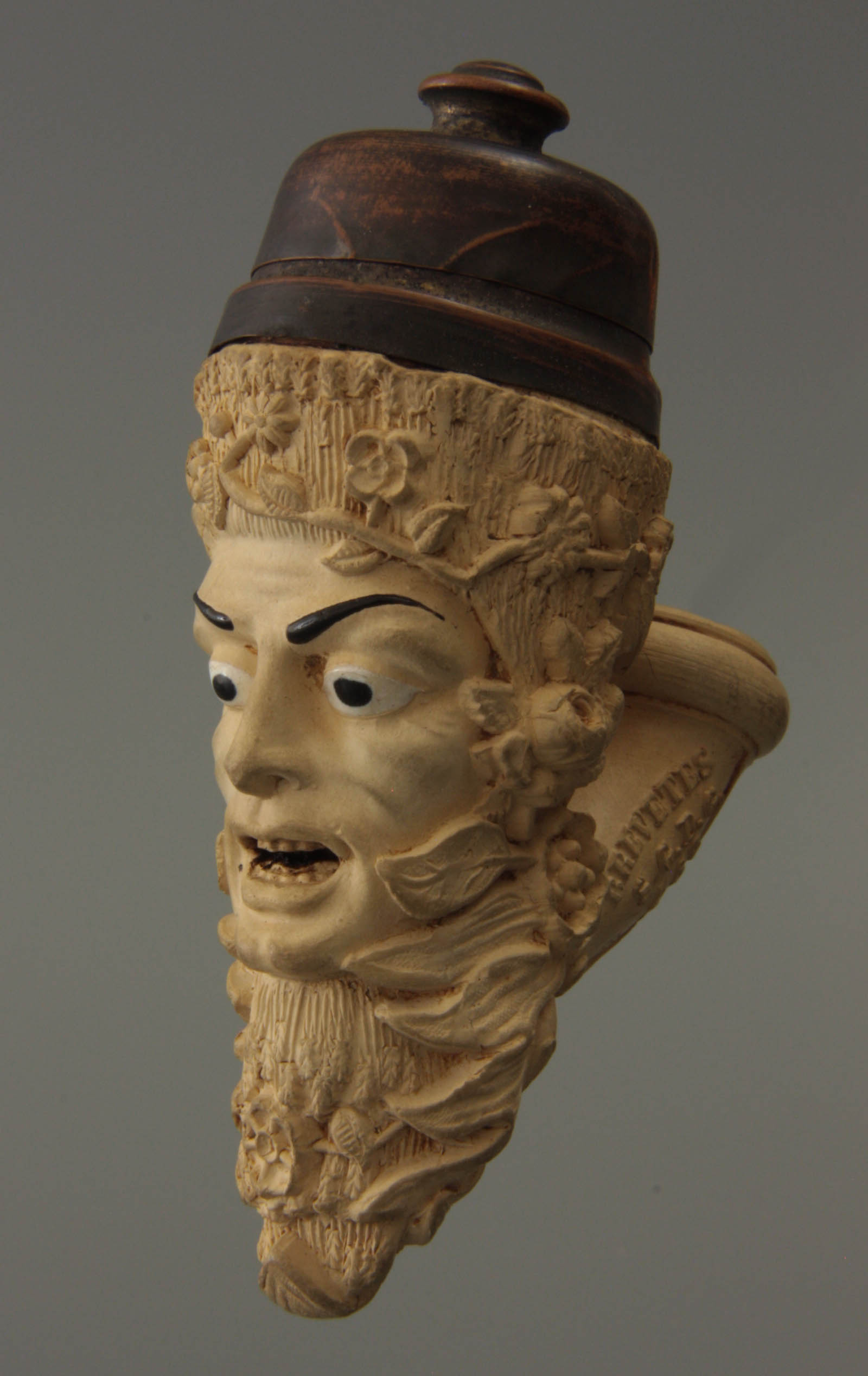
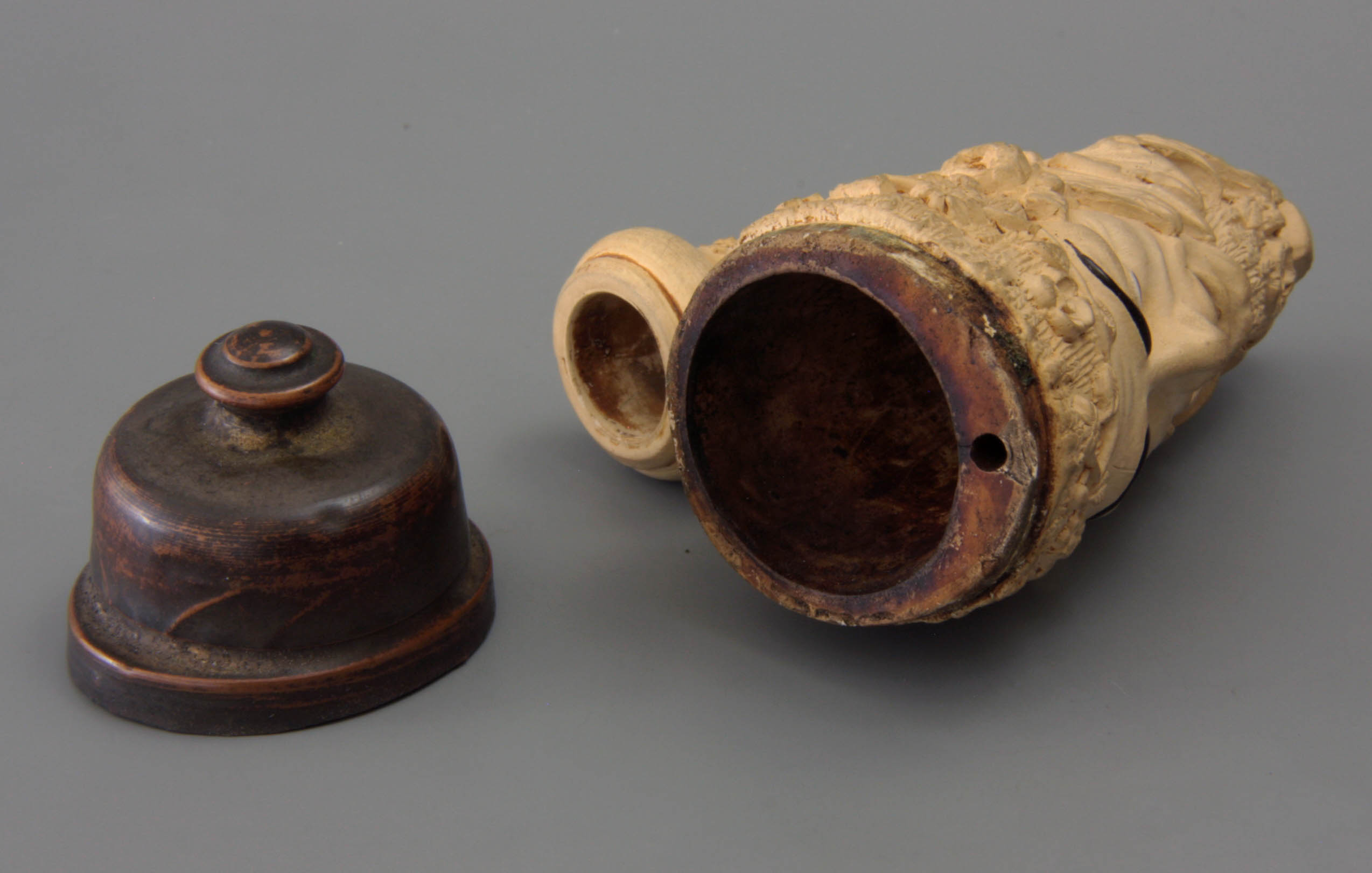
The pipe bowl shows a man's head with open mouth, a face that seems to peek between ears of corn and flowers. Undoubtedly the smoker knew exactly who was being portrayed at the time, but the meaning was lost over time. Incidentally, the face is beautifully modelled and striking is the well-formed opened mouth. With its round facial expression, the face forms a beautiful contrast with the sharp forms of the flora. The lid on the pipe bowl is part of the image: it is the hat of the person, as it were, but there is something unusual about that lid. It is not equipped with air intakes as usual to draw the pipe, but it is completely closed and that is the trick. The manufacturer introduced a smoke tube in the bowl wall from the forehead downwards up to the mouth of the depicted. The mouth therefore acts as an air inlet. This system made it possible that you can simply smoke out of the pipe.
After you filled and lit the pipe, you put the lid back on the pipe bowl. If you do not smoke but blow gently into the pipe stem, the smoke starts to come out of the mouth spontaneously. And what entertainment will that have given!
The maker is Crétal & Gallard from Rennes, an important factory we know little about. Thanks to the signature on the stem of the pipe we can make the attribution. The stem shows the shape number 462 with the addition that the design is patented, although without a government guarantee as the inscription says. The patenting of inventions by factories was common at that time. In February 1856, Crétal & Gallard received a fifteen-year license for "une pipe à trou d'air renversé" as the system described here was explained. Although it seems to be a unique discovery of the Rennes factory, that may not be the case. In 1858 a patent for a similar system for Belgium was obtained by Wingender in Chokier near Liège. It is almost certain that pipes with this system were already being used extensively in France and Germany. In that respect, the patent is not always indicative for the moment of production. The copy shown here must have been made between 1856 and 1860. In later times this model was made without the ingenious system.
Amsterdam, Pijpenkabinet collection Pk 9.372
Braided pipes for the queen
For the residents of Gouda, 24 April 1897 was a special day. On that date, Queen Regent Emma and her daughter Princess Wilhelmina would visit the city of Gouda. The program included a visit to the candle factory and a look at the Saint John Church for the famous stained glass windows, next to a visit to a pipe factory. The honour was given to the firm P. Goedewaagen & Zoon, not surprising because the firm's owner, Pieter Goedewaagen, was member of the municipal board of Gouda.
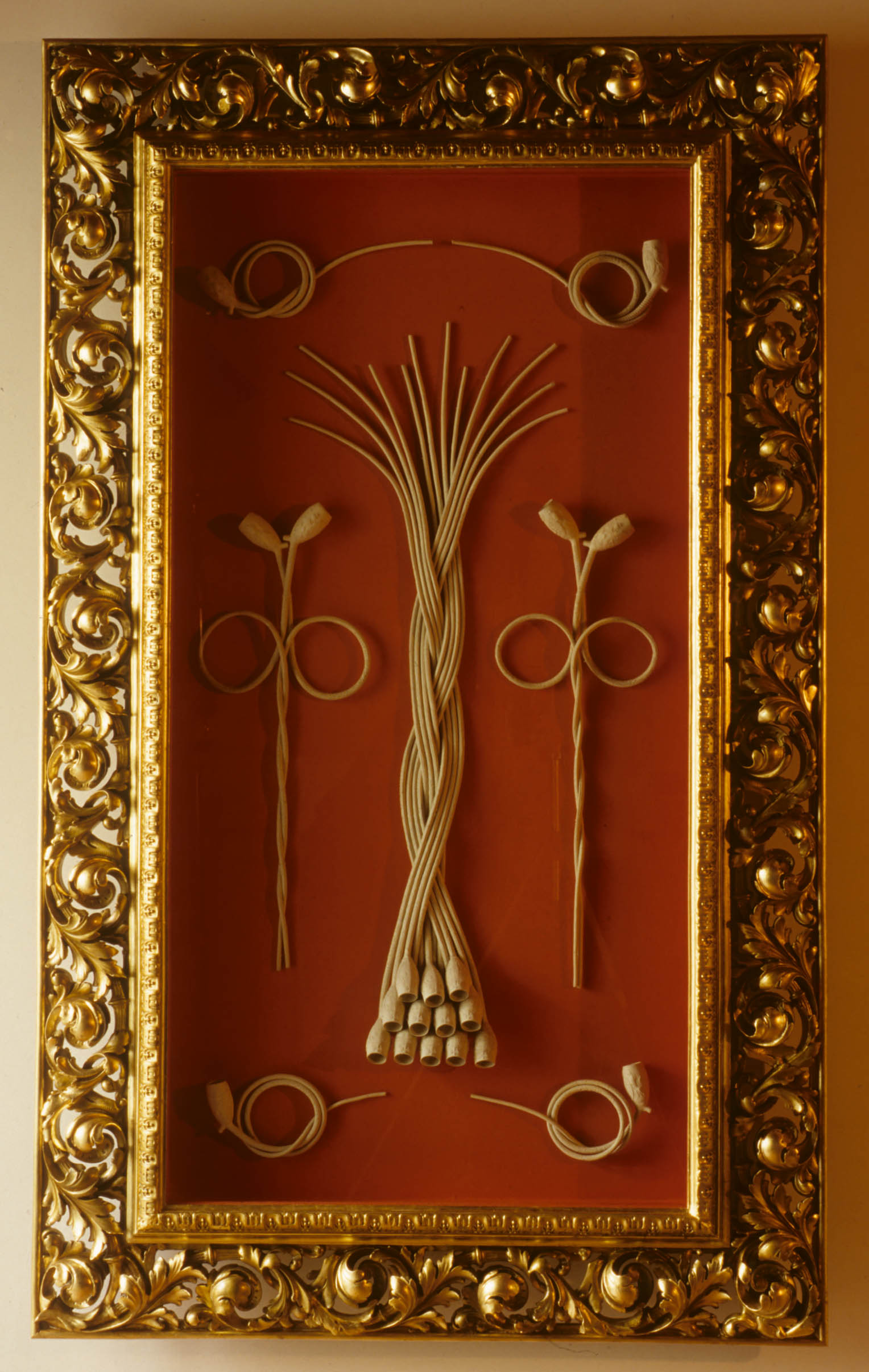
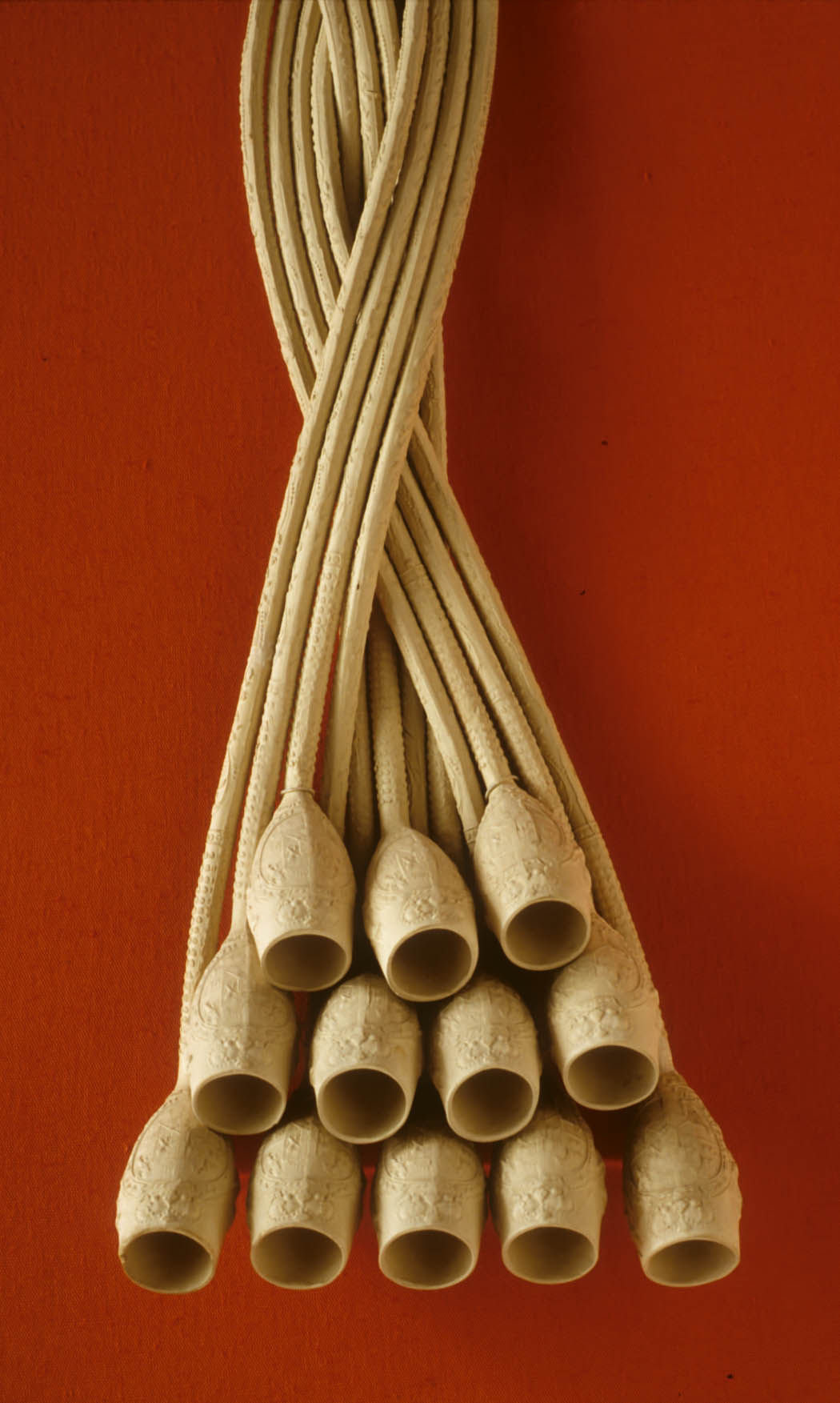
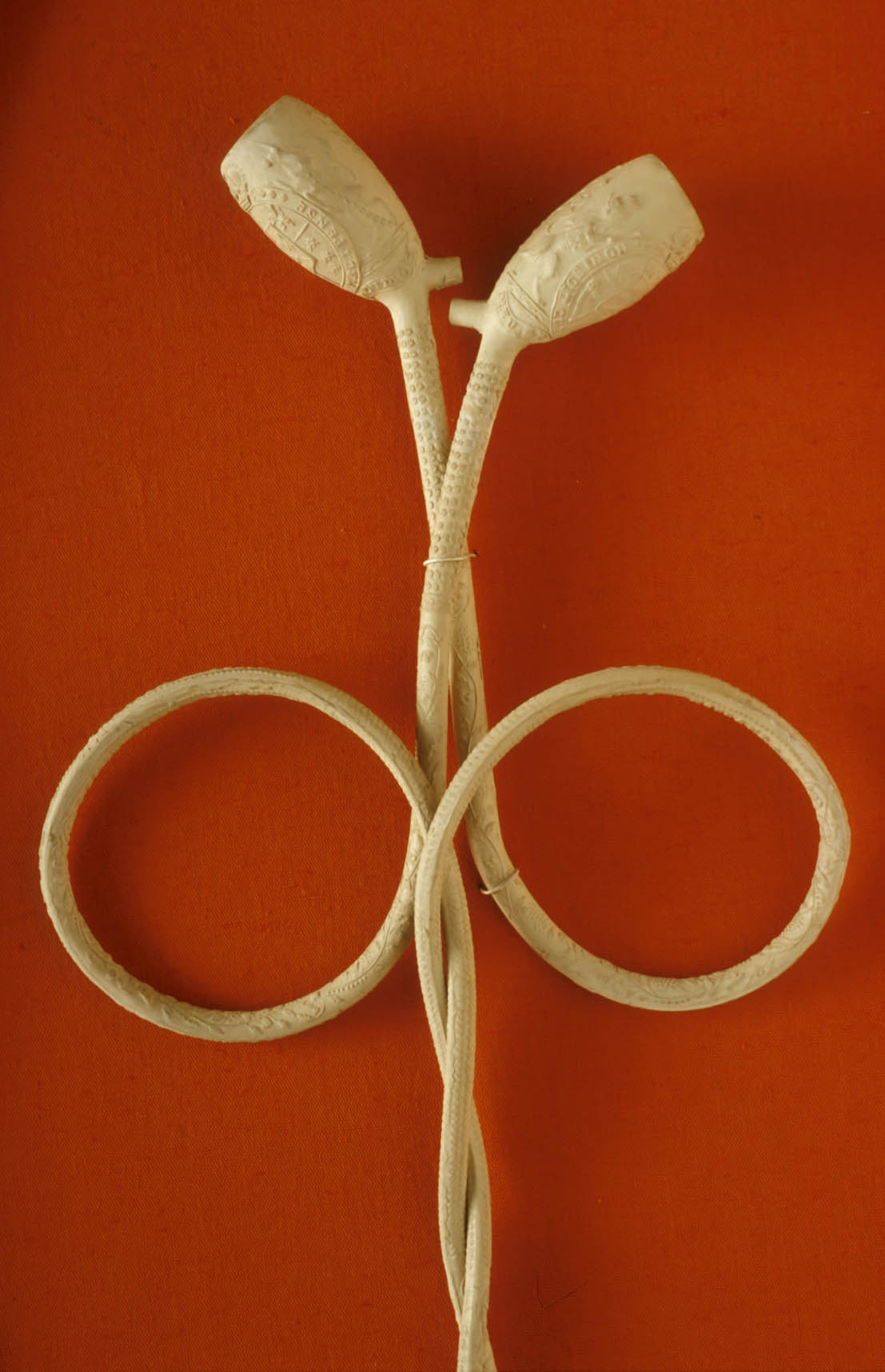
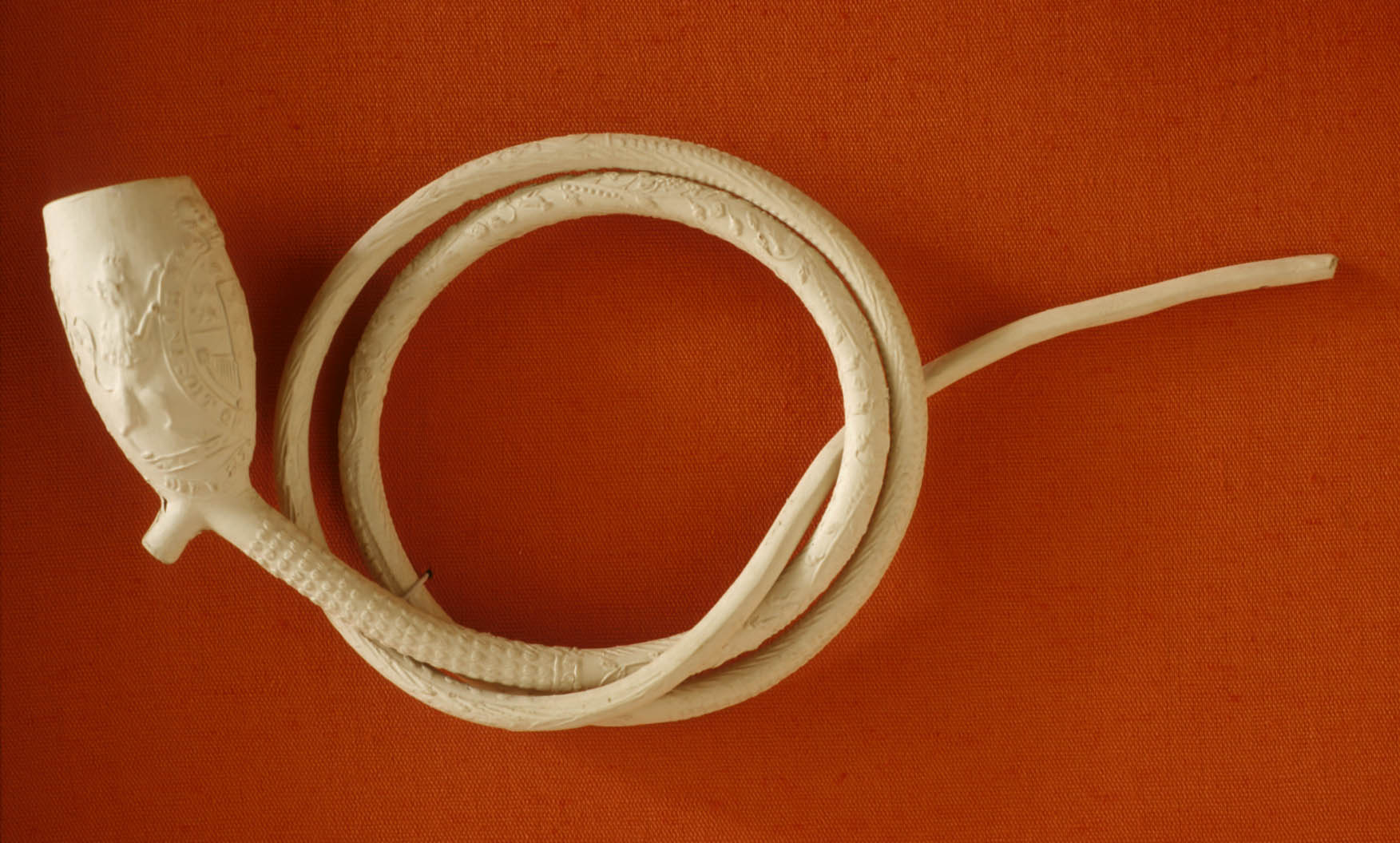
The local newspaper Goudsche Courant gives an impression of the preparations for the Royal visit one day before the event. It turns out that at Goedewaagen the entire factory has been cleaned, an impossible task in a ceramic factory full of clay dust. At the entrance of the factory even a sort of boudoir was arranged to receive the Queen Mother and her daughter in a dignified way. On the way to this reception hall they built a canopy consisting entirely of long stemmed Gouda pipes.
A day later we read an extensive report in the local newspaper. The queens have then seen the longest kind of pipes being made by the most skilled master pipe makers. The other workers were watching along the wall dressed in their Sunday suit. This longest type of pipe is decorated with the coat of arms of the House Hannover, in fact the English royal family, but for the occasion the pipes were renamed pipes with the arms of Stadtholder-King William III. A dozen of the long clay pipes made in presence of the two royals were combined during the visit to an exceptional plait. Around it are some other figures that make the whole into an art work of clay pipes.
After the visit the braided pipes were baked and were given a place in the reception room of the factory as a reminder of the royal visit. The fact that the manufacturer was very honoured is also apparent from a silk-bound guest book, in which the two queens have written their names with the addition of the date of their visit. On the cover of this beautiful cahier, the Dutch coat of arms appears in gold. That book was since then shown at the reception of important relations.
Until the 1970s, the artwork of pipes hung in the Koninklijke Goedewaagen factory. Initially on the Raam, from 1909 on the Nieuwe Vaart in a brand new factory building. In the 1950s the piece moved from the showroom to the boardroom. At that time it was incorporated in a modern wooden panelling. It was not dismantled until 1974 and two years later this special object was transferred to the Pijpenkabinet Foundation. The factory management found a museum destination more appropriate. The original frame has been restored since then and the object could be exhibited in its original way. It is now in full glory as one of the most special clay pipes in the main room of the Pijpenkabinet in Amsterdam.
Amsterdam, Pijpenkabinet collection Pk 10.831
Ceramic smoking pipes
A dedicated Staffordshire pipe
The term Staffordshire pottery is a collective name for ceramics from the English region of Staffordshire. In six places close to each other, of which Hanley and Stoke are the best known, earthenware has been made with a great variety for centuries. In the narrow sense, the term Staffordshire also stands for folk ceramics that are often formed in figures and provided with coloured glaze. The pipe depicted here satisfies all aspects of this definition.
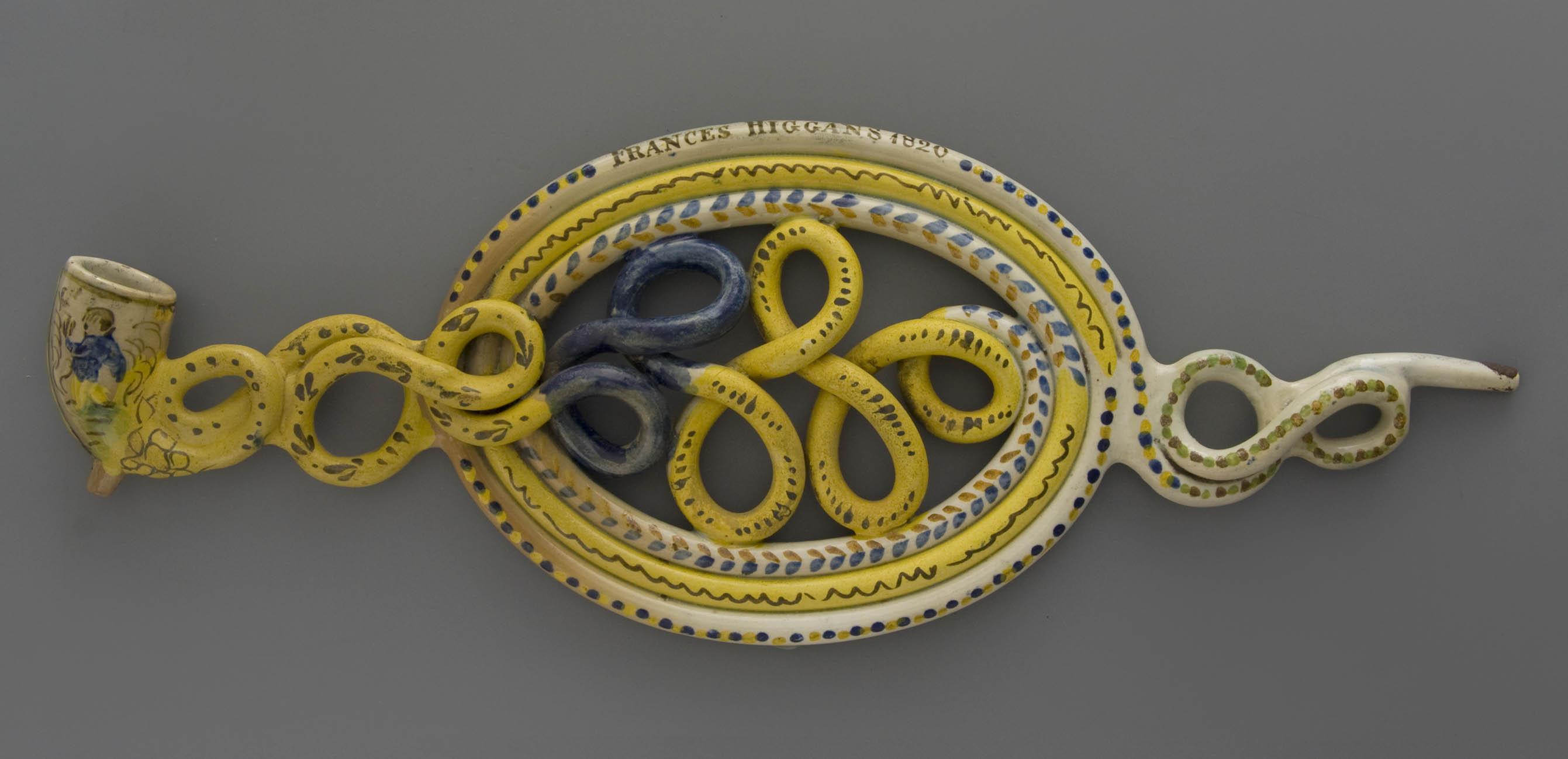
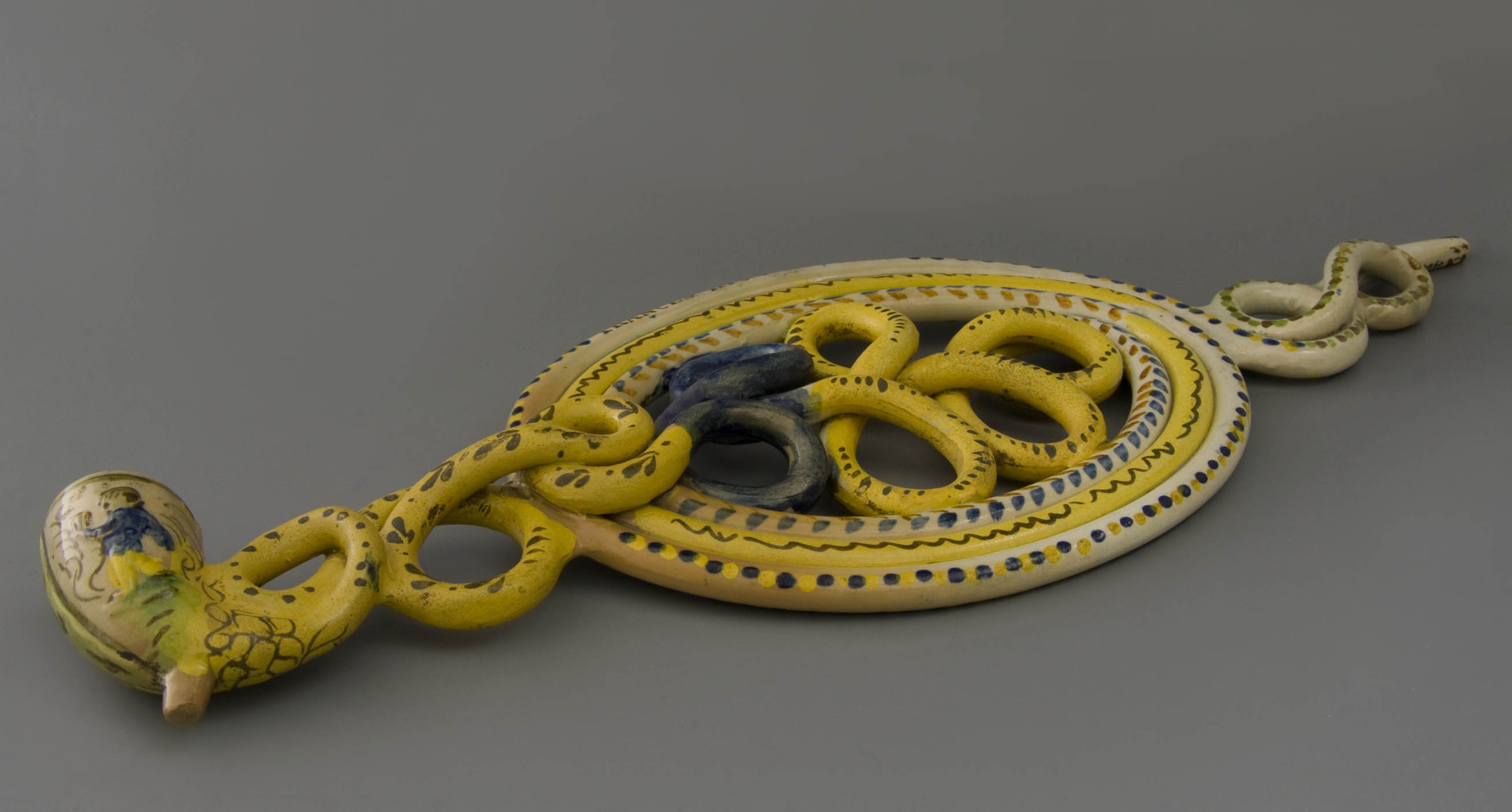
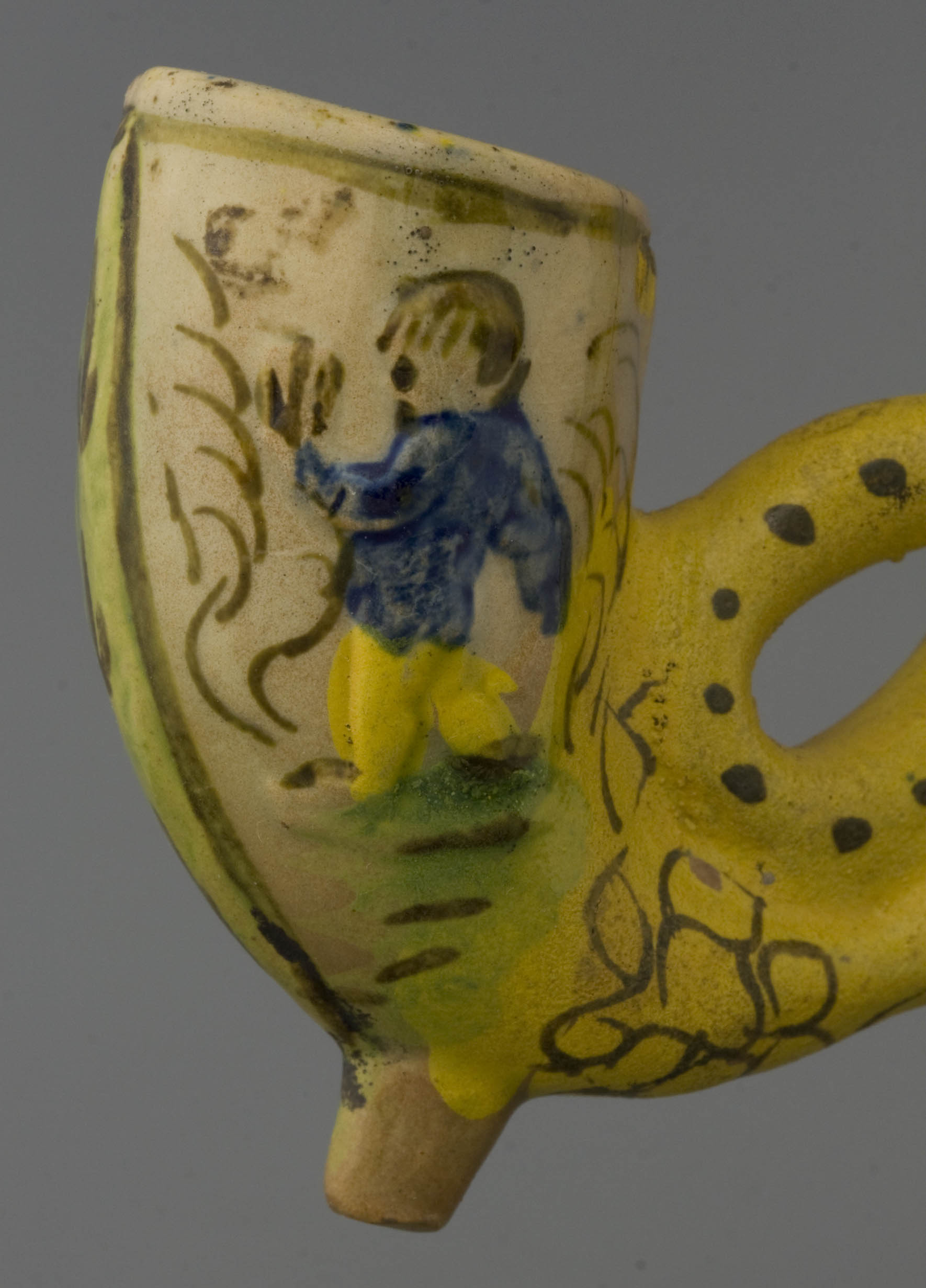
The ceramic tradition in Staffordshire developed so well thanks to the fine plastic clay that was locally extracted and which produced a beautiful white baking product. In the course of time, the potters gained ample experience in working with colourful under glaze. In addition, the figuration of the products became a passion in itself. Tobacco pipes are included in the supply between 1790 and 1840. The most famous family that made this ware was Pratt, which is why the Englishman often speaks of Prattware, although the word Staffordshire remains more accurate.
The best known are the pipes in the shape of a curled snake, the pipe bowl appears from the mouth of the animal, the tail is the mouthpiece. They were dotted in under glaze colours with a preference for ochre and blue, the colours green and brown are less common. Many of these snake pipes were made into two halves in a printing mould and then joined together. They are serial items that were in high demand, especially among the rural people, as an entertaining decorative item.
More surprising are the so-called puzzle pipes, whose stems are curled and woven into imaginative motifs. That puzzle ware is not made by hand as one would expect, but with the aid of an ingenious device with which endlessly long stems can be produced. The art was in coiling in the most intricate forms. Such a coiled pipe is depicted here and when you follow with your eye the path from mouthpiece to the pipe bowl, you automatically become dizzy. Besides numerous ellipses your eyes will make all kinds of hairpin bends and zigzag movements.
The object has a clear view side which emphasize the show function of this pipe. Yet it is a fully functioning tobacco pipe and they were also normally smoked. This specimen clearly shows the deposit of countless times of cautious smoking. The stem end is smoothed for the smoker with some red sealing wax. The pipe bowl itself has a so-called curved shape that is characteristic of the English pipes from the first half of the nineteenth century. On the bowl we see embossed a standing man with three leaves in hand on both sides.
The most remarkable is the stem. The main shape is a lying oval of three turns with pieces turned on both sides, the oval is filled with braid even on the inside. The stem is painted with dots, stripes and zigzag lines. On the upper winding the inscription "FRANCES HIGGANS 1820" is placed on demand. It indicates that this item was commissioned and provided with the name of the donor. It must be a special gift for her father, husband or otherwise for a staff member who received the pipe after years of loyal service. As a showpiece, these kind of pipes often have a long life. They were only smoked on special occasions and were given a safe place behind a glass door of the display case. So they survived over time.
Amsterdam, Pijpenkabinet collection Pk 4.560
High quality from Ruhla
The shape of this tobacco pipe is special and very time-bound. It has a two-sided flattened bowl with a nice oval shape that refers to the Empire period. On both sides an extraordinarily artistic relief has been applied. On the left we see two standing women in pleated dress, the left woman with a cornucopia with fruits, the right holding a bowl with flame. The ground on which they stand shows a tree stump on the left. The right side of the bowl is similarly decorated, again with two standing women, the left with a flower basket, the right one holds three leaves.
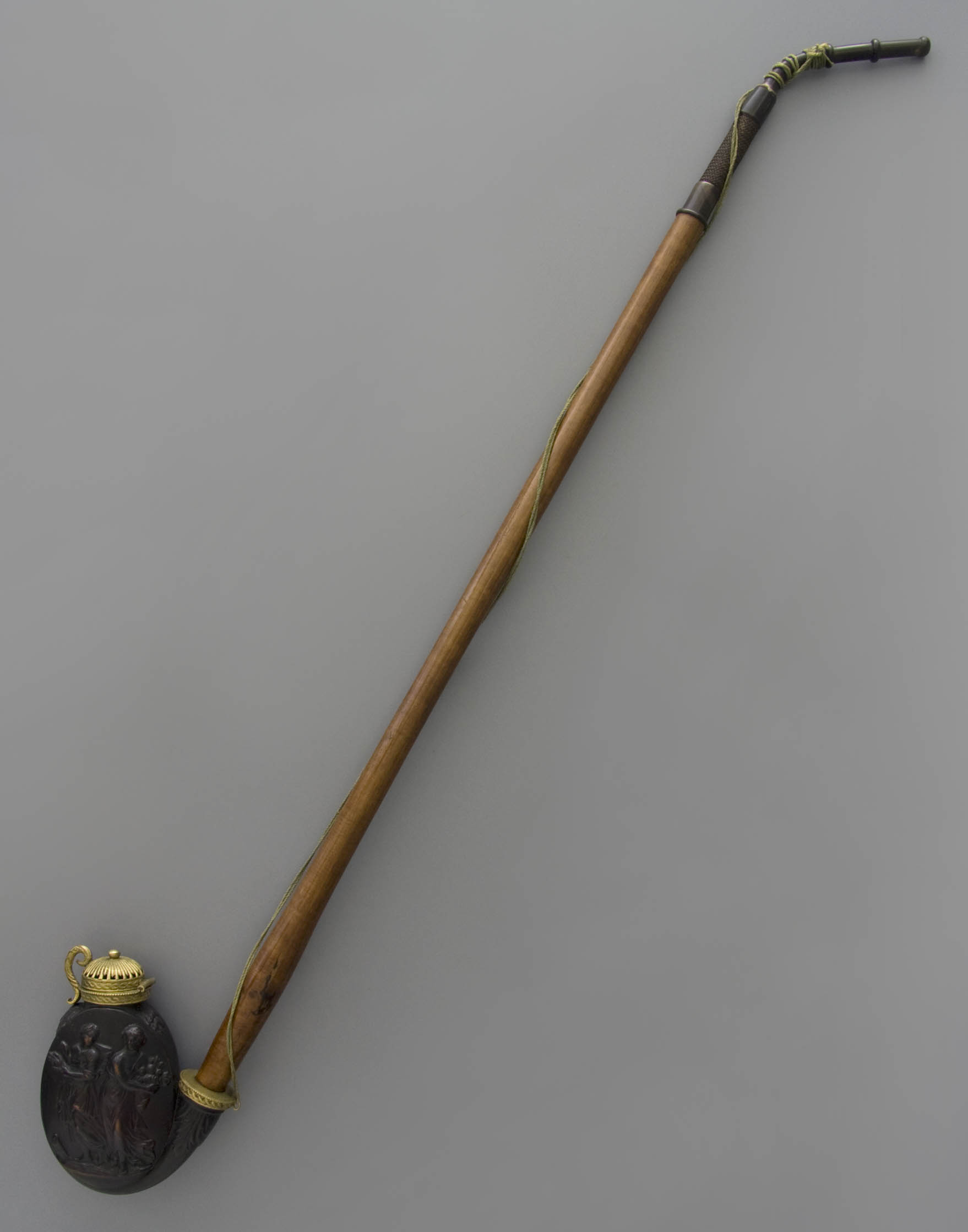
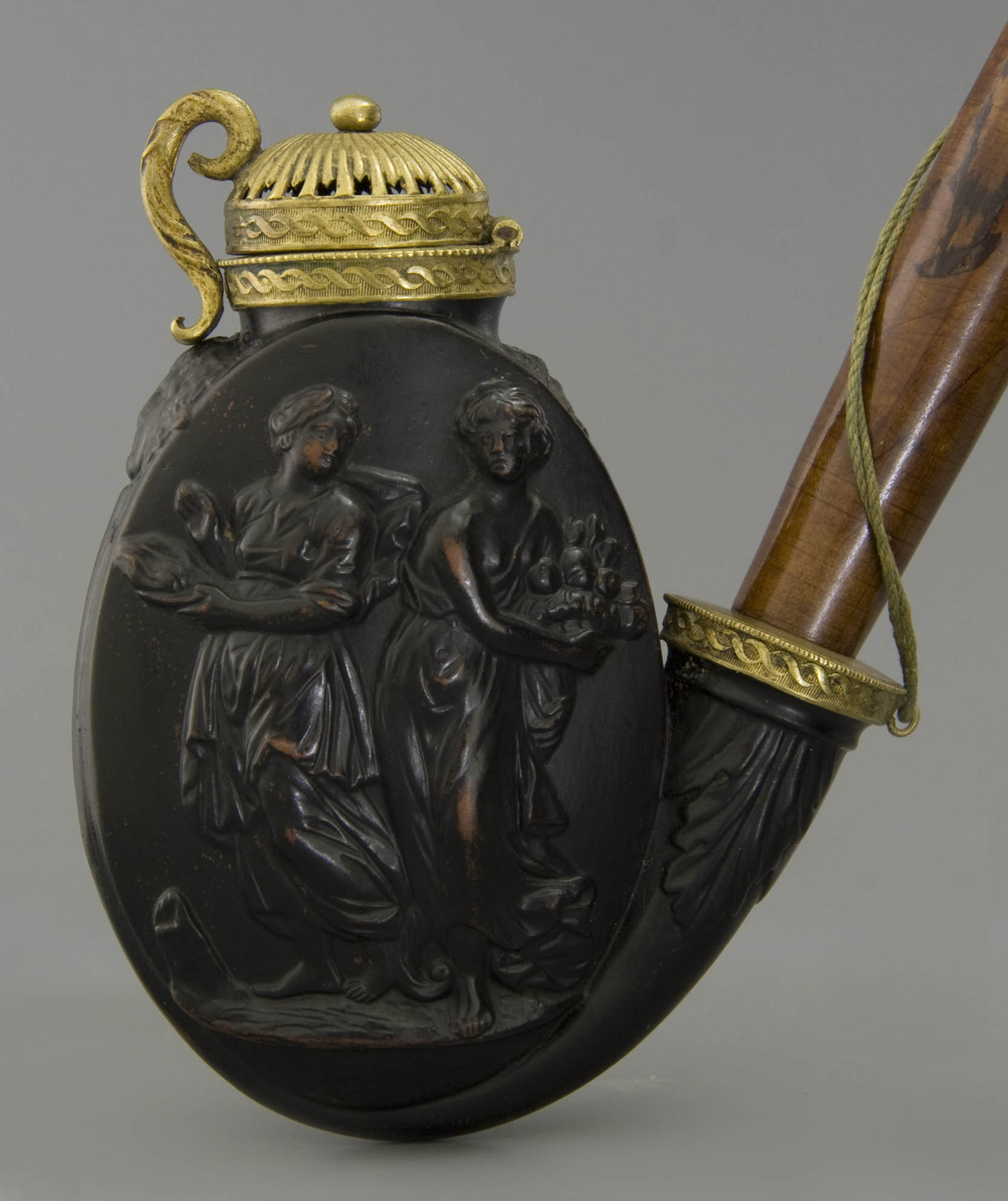
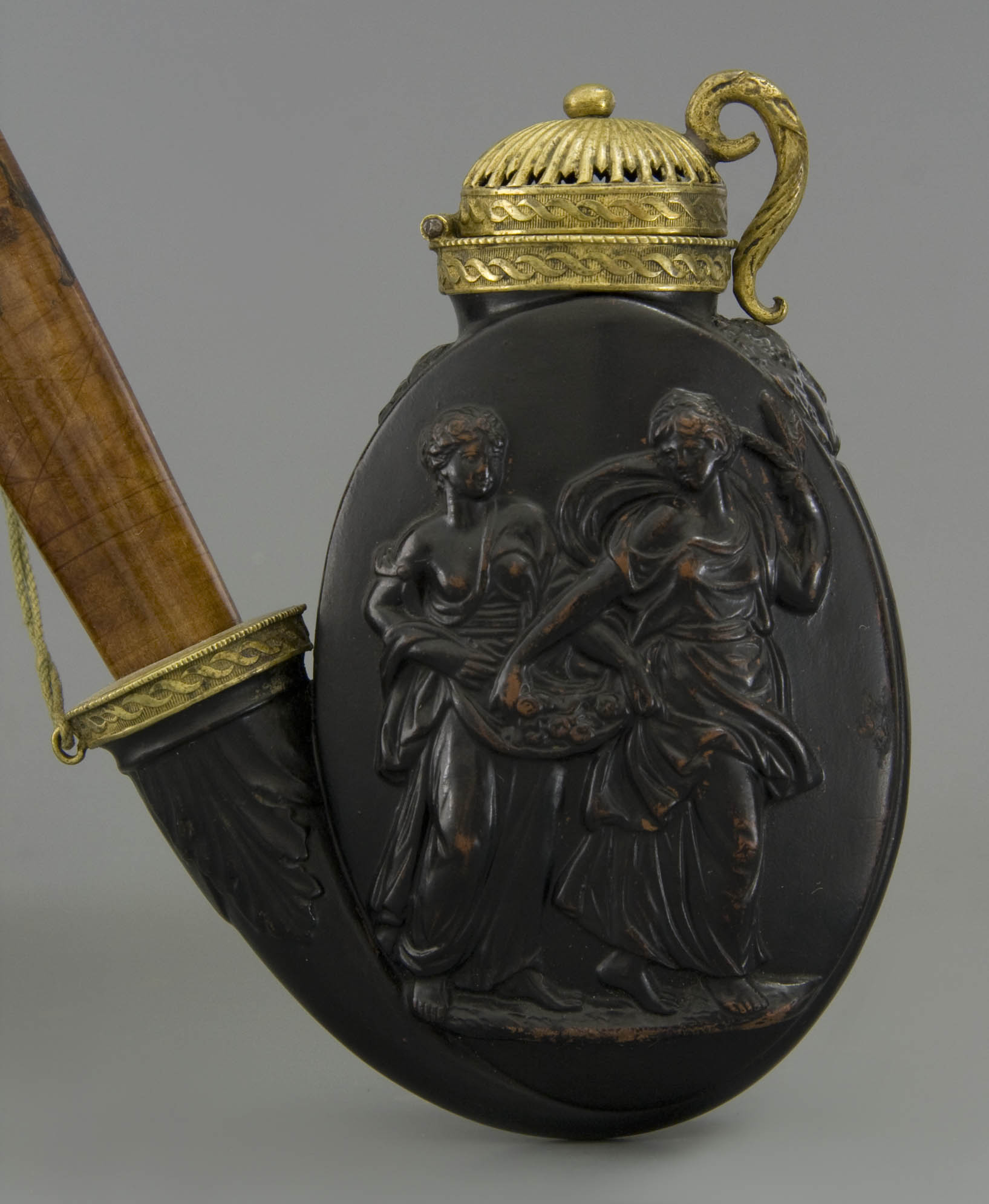
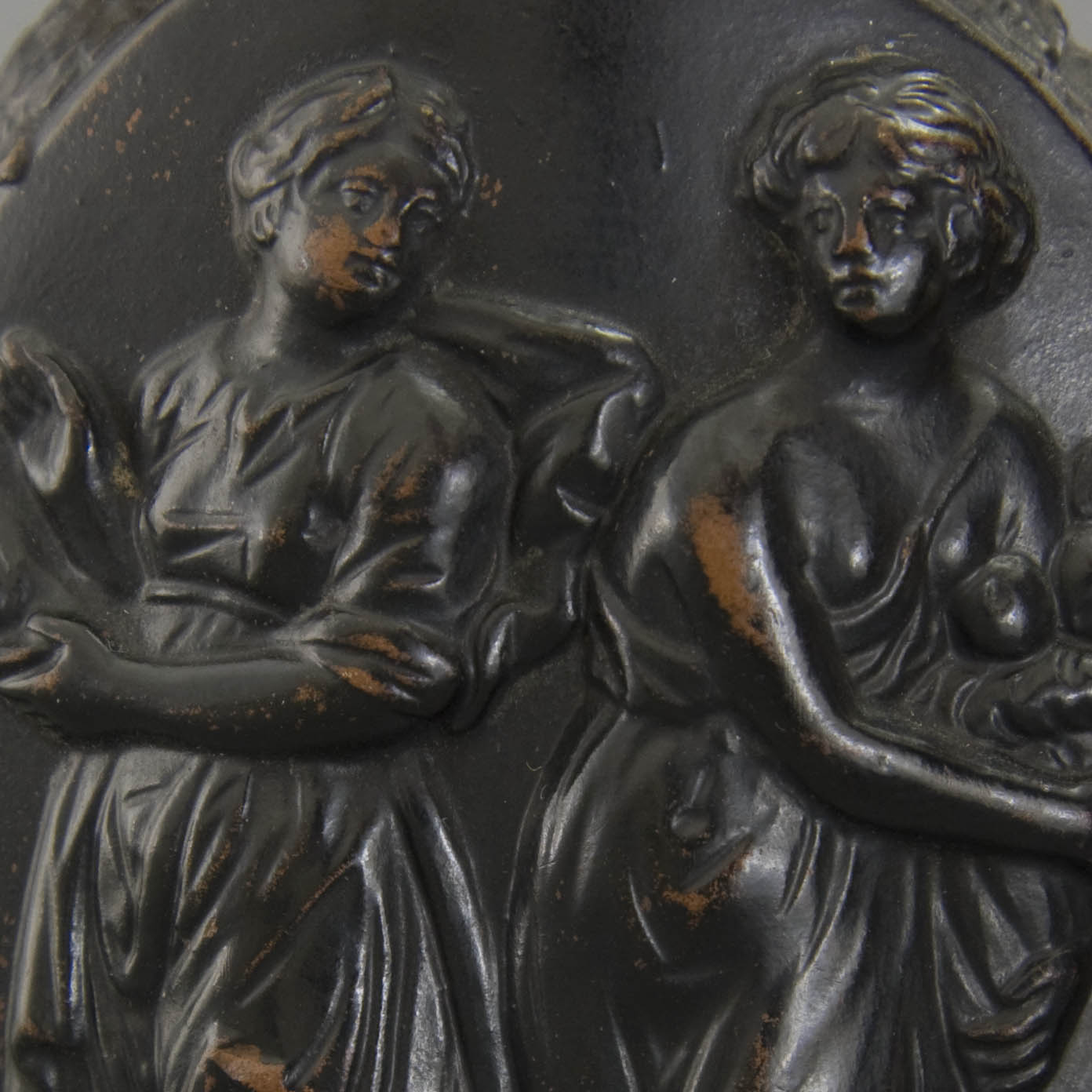
Special about the pipe is the perfection of the oval shape in combination with the extraordinarily artistically modelled figures. It is clear that a professional has made the mould for this pipe and that, in doing so, he took classic examples as a starting point, reshaping them into the fashion of the day. The urge to perfection can also be seen in the details. For example, the bowl shows a mask head with grapes in the hair at the front. A leaf motif is arranged on the stem side. The upright stem is decorated on both sides with a palmette, a motif characteristic of the empire style.
The mounting of this pipe completes the whole. Characteristic for the time is the fine bronze casting that is fire-gilded. This work is beautiful in detail as well: watch the fluted motif on the lid with the subtle air inlet along the edge. Around the frame you can see a subtle edge of wavy lines that contrast nicely against the shaded surface. The clamping spring which holds the lid on the pipe bowl has a question mark shape that is also worked. The original stem, still preserved, is of a light wood, assembled with buffalo horn and a safety cord with tassel.
It is nice to philosophize about what the maker meant with this pipe. Did he suggest a wooden pipe with the brown colour? The material, the so-called siderolith, a fine cast clay, however, was more often used to imitate meerschaum. In that case it would be a deep-dark-brown smoked meerschaum pipe. Both options do not seem probable. More likely the mat black appearance would suggest a pipe of the coveted basalt ware: the black stoneware pipes made by Wedgwood in England that the Germans were unable to copy. By giving the surface a deep black colour, a similar result was achieved. Unfortunately, because the paint was insufficiently durable, it disappeared partly over the years and the somewhat disconcerting red shard appeared. That wear now underlines the age of almost two centuries but does not detract from the really successful time-bound design.
Amsterdam, Pijpenkabinet collection Pk 18.475
A presentation pipe from Zenith
Shortly after 1900, the Gouda pipe industry experienced major changes. Until the last turn of the century, production was done exclusively with pipe clay, around 1900 a new ceramic method was introduced. Instead of pressing rigid clay into metal moulds, liquid clay was poured into plaster moulds. The porosity appeared to be significantly larger, resulting in a pipe that smoked drier and cooler. Provided with a tight transparent glaze, a pipe with a much more luxurious appearance was created. This is how the Gouda pottery pipe was born, the pipe on which often a picture appeared during smoking, the so-called mystery-pipe. In addition, various alternatives were created, all of which were mounted in a modern way with a metal ferrule and hard rubber mouthpiece.
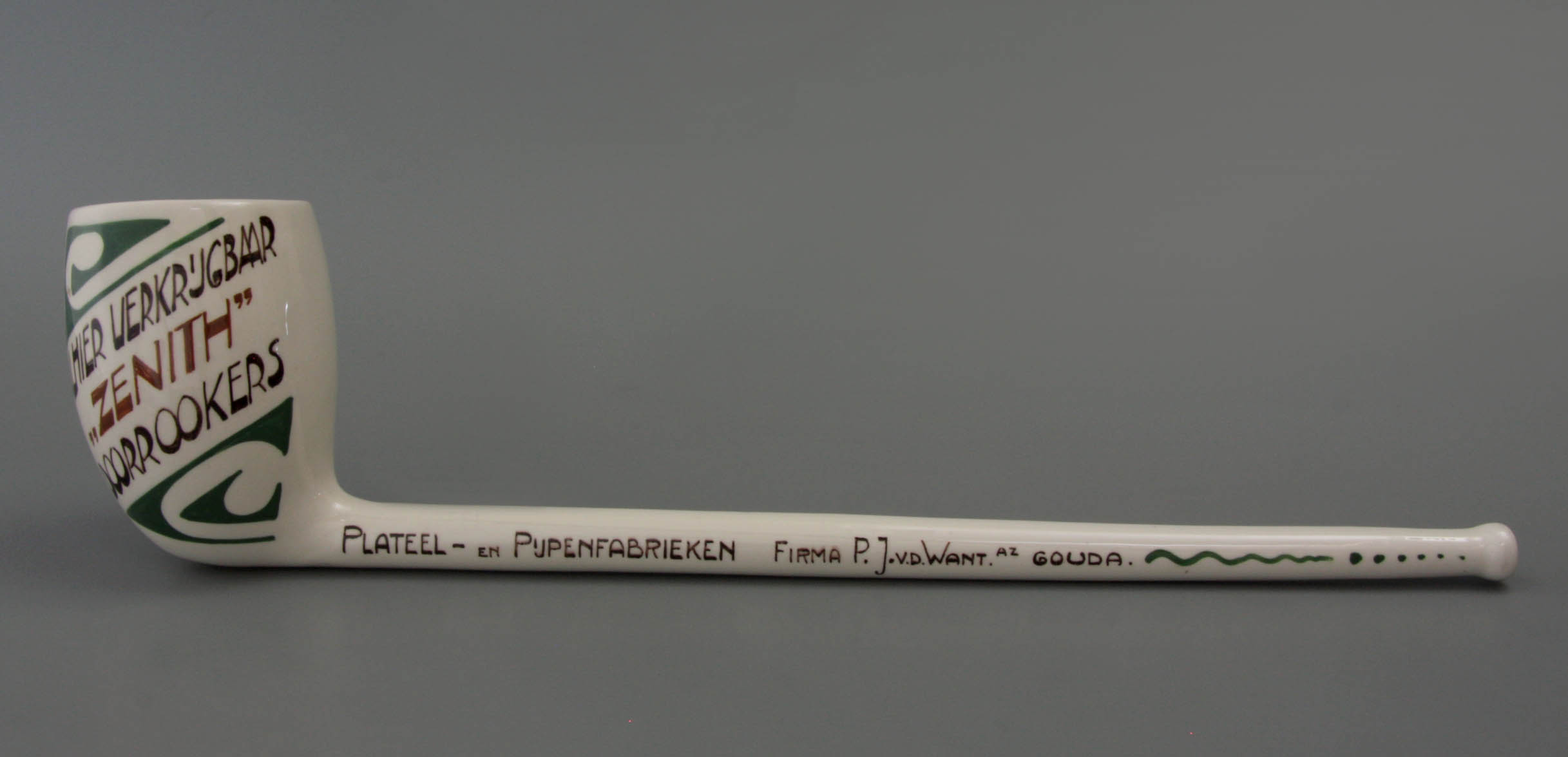
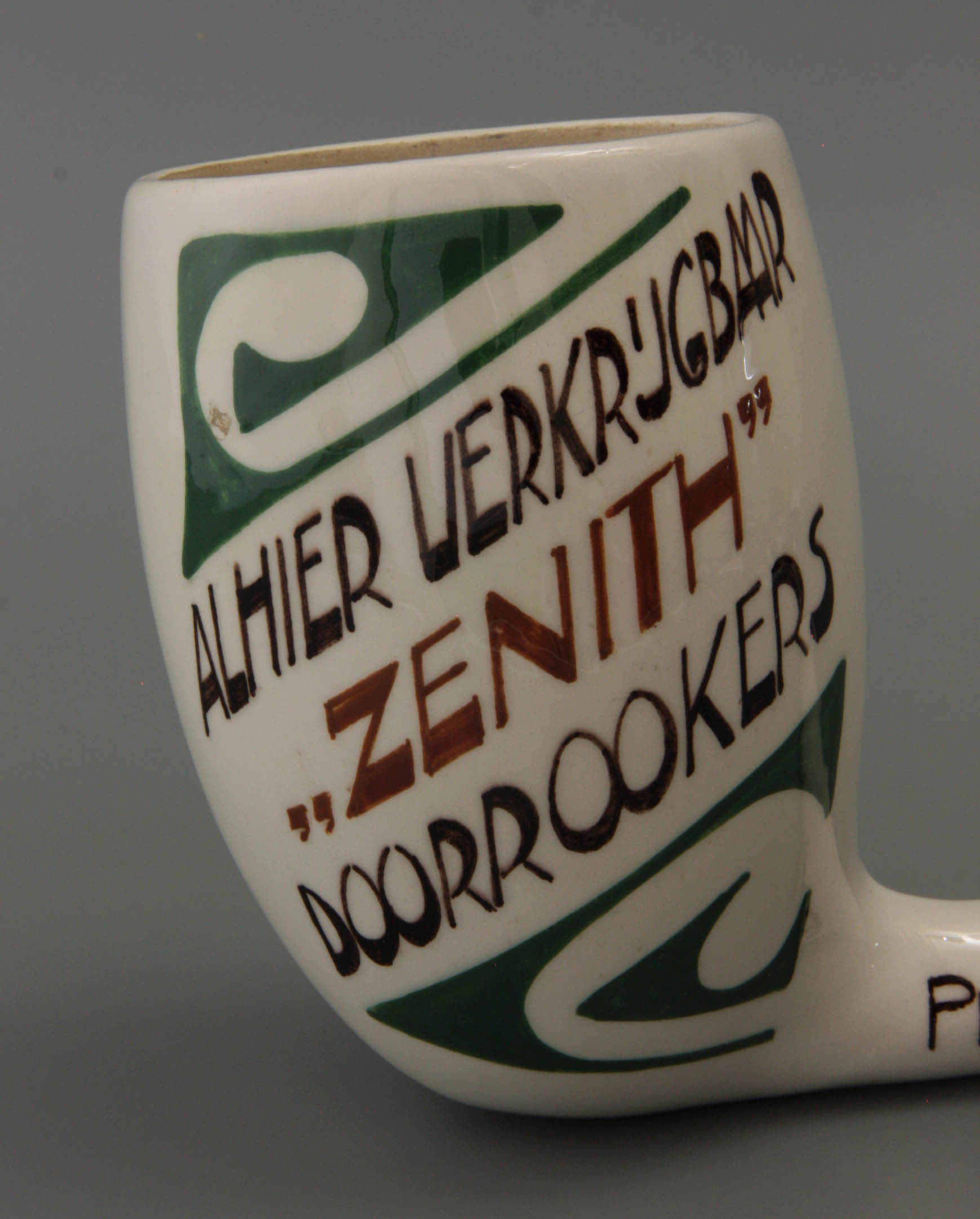
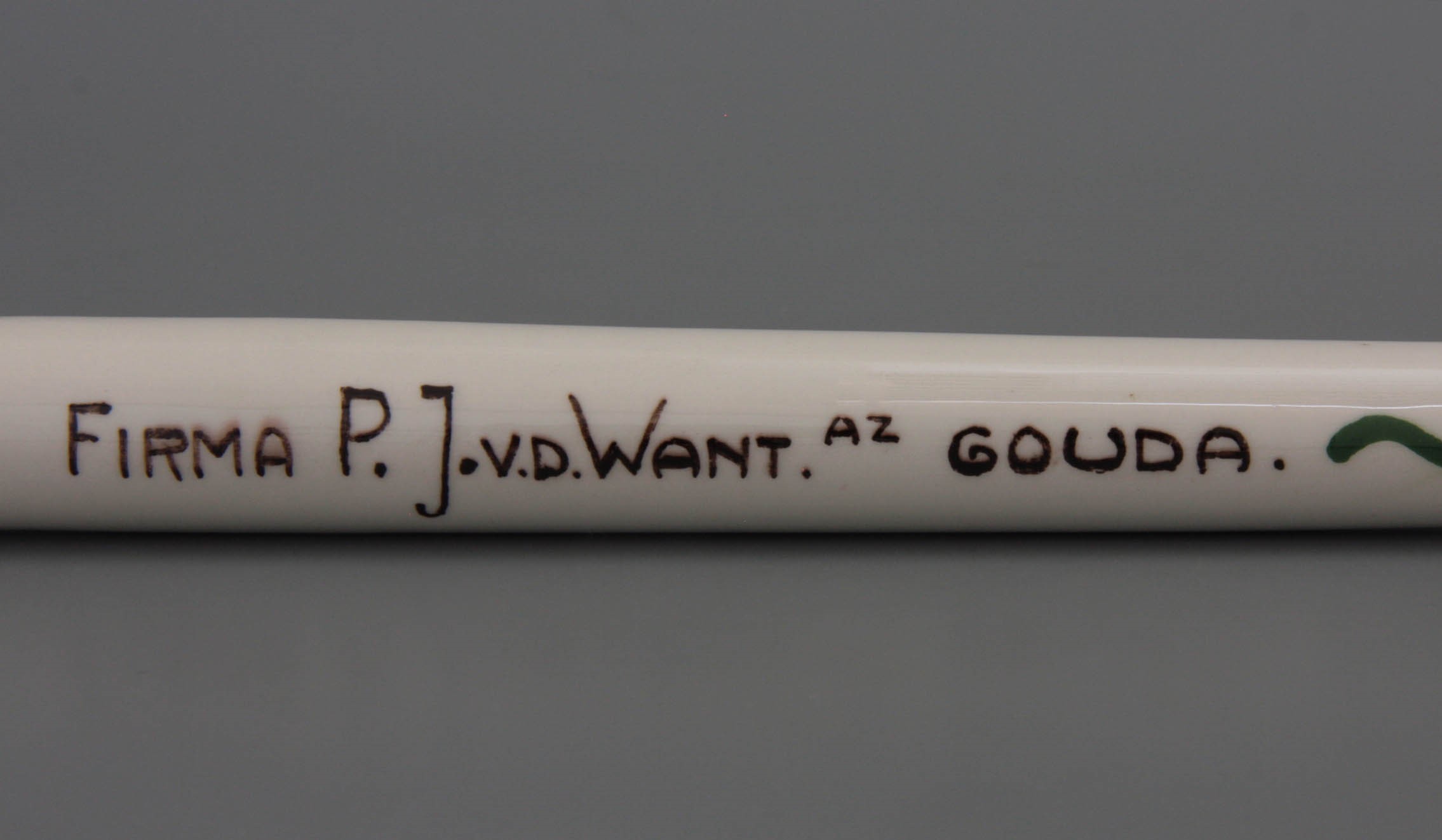
This newly created product led to great flourish in the four companies in Gouda who enlarged their business with this new production line. Their profit margins increased enormously and logically they advertised as often as possible to bring the new product to the attention of the smokers. When the First World War erupts in 1914, the supply of foreign pipes is impeded and these Gouda manufacturers experience good times with their new, modern slip cast ceramic pipes. With the profits they can start a production line in other ceramic objects, the birth of the Gouda pottery.
In addition to their regular products, two pipe manufacturers put a shop-window pipe on the market, intended for the tobacco retailer to advertise their normal tobacco pipes. Both pipes are a greatly enlarged version of the standard so-called doetel, the clay pipe made in a metal mould that was the most common at that time. At the Goedewaagen company, this shop window pipe is an exact enlargement of the usual doetel and shows the factory name on the stem to make the company better known. Because this shop window pipe referred to a press moulded pipe, the pipe was not glazed. With this, the factory saved the tour de force to provide such a large object with a nice even glaze. At the same time, this meant a missed opportunity to advertise the lucrative mystery pipes.
At P.J. van der Want Azn., better known from 1917 under the name Zenith, significantly more care was taken in the execution of the display window pipe. With this cast product it is decided to not only advertise their clay pipes, but also seizes the opportunity to bring the innovative mystery pipe to the attention. The manufacturer does this by placing a striking advertising inscription on the pipe bowl. For a clear message, the pipe must be glazed, increasing the reference to the luxury ceramic pipe.
The left side of the display window pipe is chosen as a visible side, so this got a lettering on it. Across the bowl we read "ALHIER VERKRIJGBAAR "ZENITH" DOORROOKERS" (available here "ZENITH" mystery pipes) in beautiful hand-painted letters in two shades of brown. The open space at the top left and bottom right show a green curl, around 1920 a fashionable ornament that fits well with the Art Deco letters. The factory name is painted on the stem "PLATEEL- EN PIJPENFABRIEKEN FIRMA P.J. V.D. WANT AZ. GOUDA" ending with a green line and some dots. With its smoothly glazed finish, the Zenith pipe had become a precious object. The risk that the application of enamel on the long stem would fail, was great and the dropout in production would have been considerable.
Evidently such shop-window pipes were made in small quantities. They were only provided to the more important tobacco retailers who could actually advertise them. A small shop in a backstreet was not worthwhile. Nevertheless, the circulation must have been of a certain size. The manufacturer had to made a special mould and that was only profitable with a reasonable production. Numerous examples of the Goedewaagen pipe have been known, but from the glazed Zenith version this is the only known one so far. The dating of this giant pipe is around 1920.
Amsterdam, Pijpenkabinet collection Pk 18.953
Porcelain as a material
Pipe bowl with three male heads and a monster
A unique design with an unexpected detail, you could call this tobacco pipe. Around the pipe bowl the designer very cleverly modelled three human faces that each share an eye with their neighbour. The three male portraits obtained their own facial expression with a smiling mouth or bared teeth. But those who look better also notice a fourth head, namely that of a monster and ironically the smoker himself has a view on that. With an opened mouth with sharp teeth, it bites into the stem set and its muzzle is hidden in the stem angle. Here, too, the animal lends its eyes to his neighbours, which makes them lie quite far apart, which is very appropriate for a monster head. All in all it is a special pipe bowl with a beautiful, yet rather creepy ornament all around.
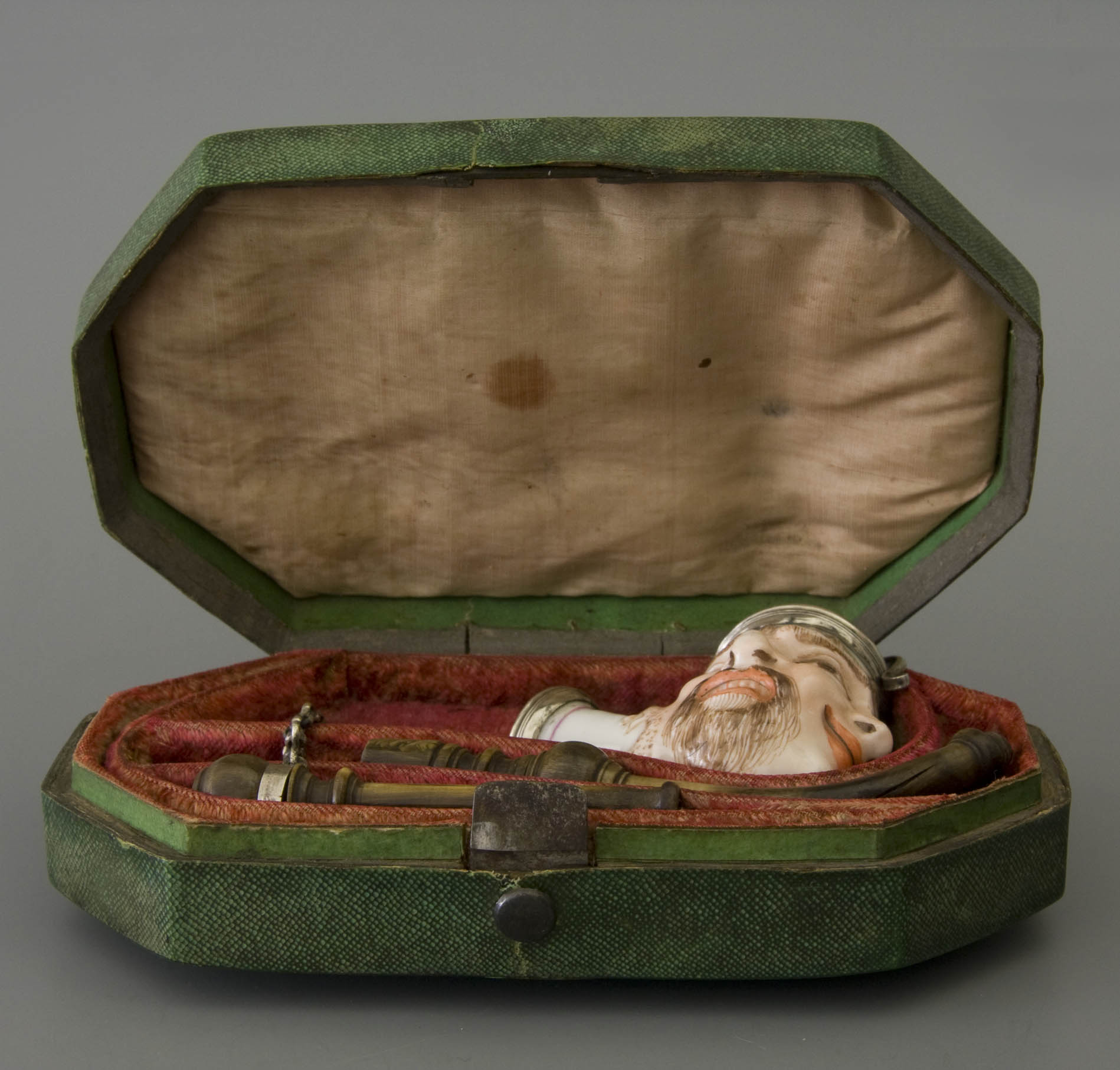
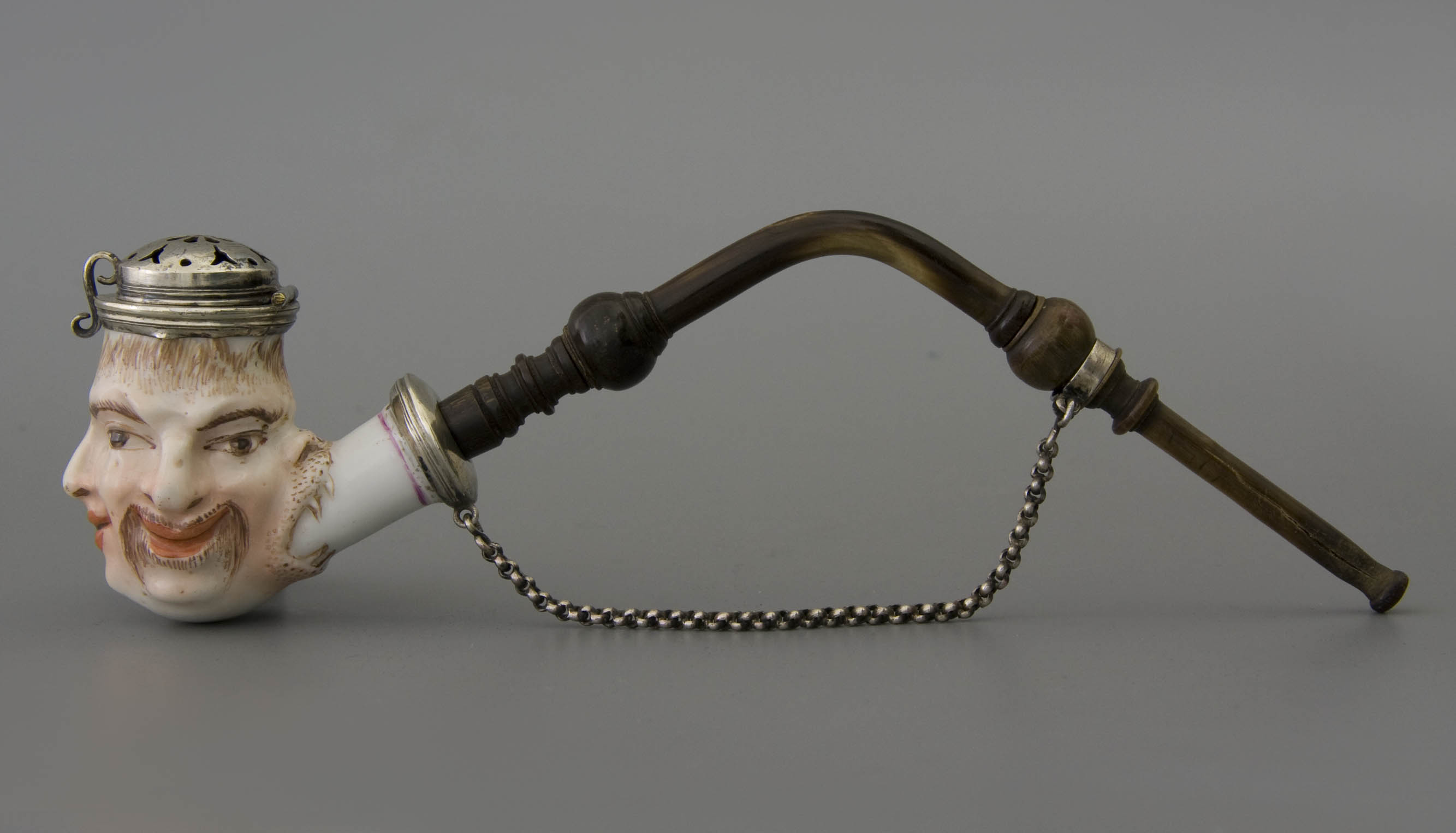
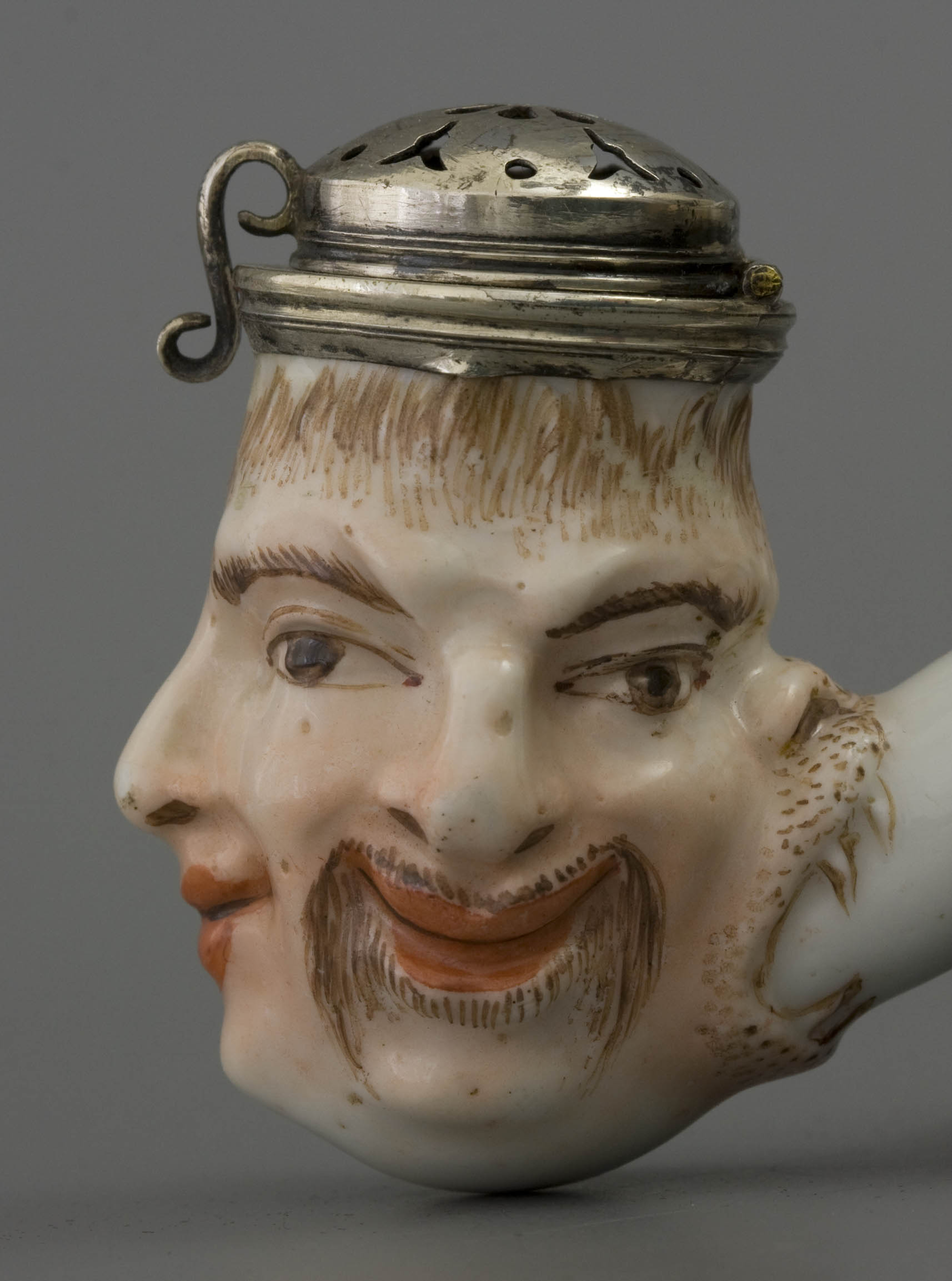
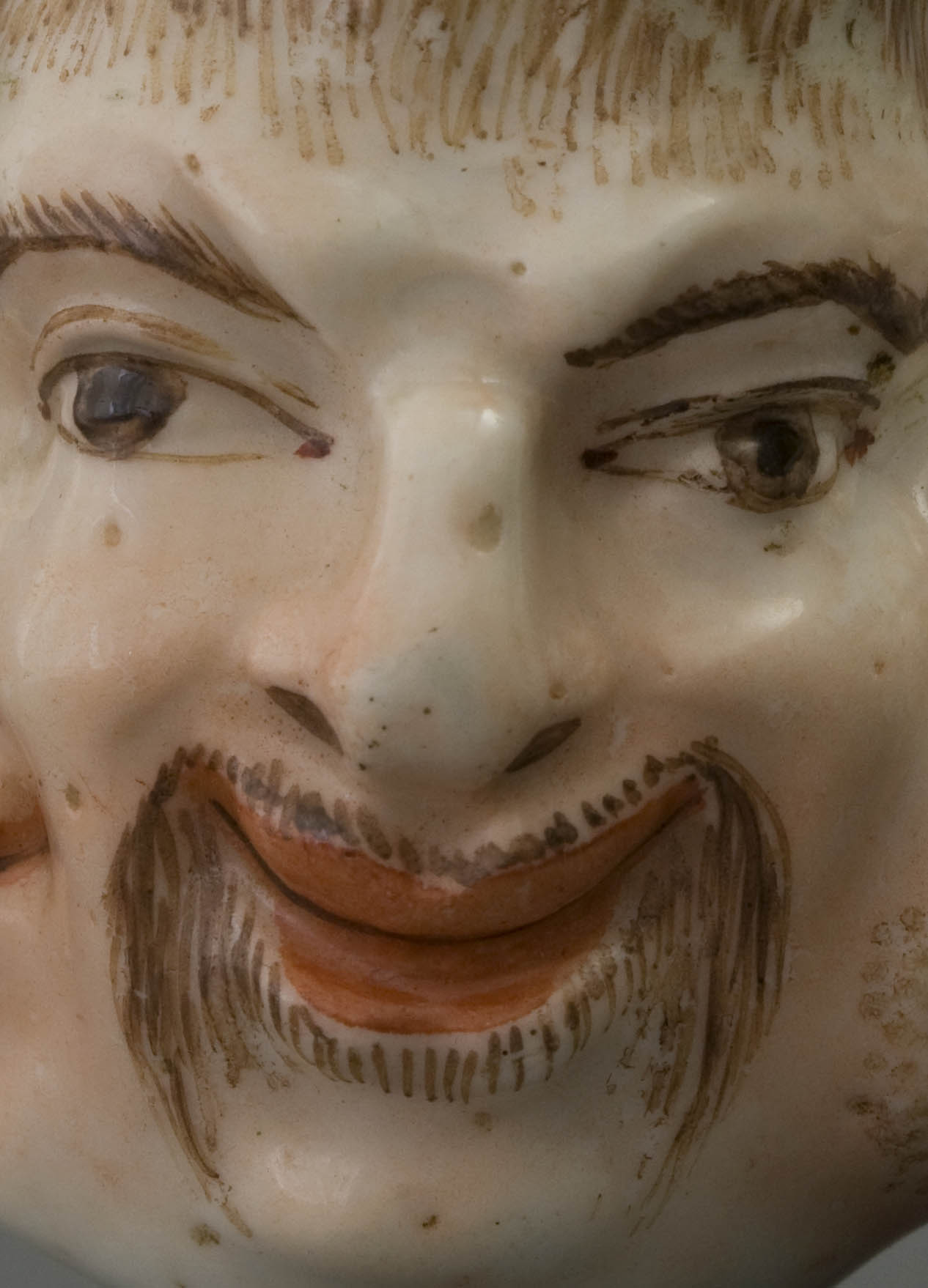
This unexpected design was made by Johann Gottlieb Ehder, modeller at the famous Königlichen Sächsischen Porzellan Manufaktur in the city of Meissen. Thanks to the extensive factory archives we know that this pipe bowl was created in June 1743. The famous master-modeller Johann Joachim Kändler, master of Ehder, registered the design in the shape book. Incidentally, that happened only after he had made some refinements, although we do not know which one. A plaster mould was made from the design and then the pipe was taken into production. After the modelling and finishing of the porcelain paste, the first baking process followed. Then the object is glazed. In the painting department, the porcelain object was carefully polychromed and the three faces each received their own identity. To achieve a good distinction, the painter added a moustache or a goatee. The circulation of this article is not known but at Meissen this usually involved no more than a handful of copies because the customer base for such luxury items was extremely limited.
Everything shows that this tobacco pipe was a valuable item in his time. This is demonstrated by the beautiful porcelain, the careful painting but also the fine mounting. The porcelain pipe bowl is in fact provided with a silver framing consisting of an open sawn domed lid and a silver stub ring. With the aid of an equally silver retaining chain, the stem end is attached to a separate buffalo horn stem. This stem consists of two parts that screw together with a fine screw thread. The result is a usable pipe stem with a strong kink.
After more than 250 years the pipe still has its original gift box, a cassette that is a piece of art in itself. It is a rectangular box with bevelled corners and a slightly curved lid. The outside is covered with green shagreen, the inside is lined with red velvet and pink silk. The parts fit in three compartments: the pipe bowl and stem in two parts. It should be clear that such a luxury box with precious content was at the time almost counted to the category of jewellery.
In the 1740s the figural tobacco pipe was on the rise, not only in Meissen, but also at other porcelain factories. Despite the large variety of shapes, it always remained precious objects, as a gift for princes and the high nobility and certainly not for the ordinary smoker. Such luxury objects were usually handled carefully, initially by the smoker who used the pipe for a year or so. Most copies, however, were quickly promoted to a showcase because of the art value. That also happened with this pipe. Of the limited number of pipes produced, only a few have been preserved. Of this design a second is known, which is located in the museum of the city of Regensburg. That copy is made in the same print mould but has a different paint scheme.
Thanks to the powerful modelling, the detailed painting and the luxurious way of assembling and packing, this tobacco pipe is far above the contemporary smoking pipe. The art and rarity value makes this article a desirable object. That is why it nowadays only happens sporadically that such an item appears on the market. As far as this model is concerned, no third copy has yet been found, but perhaps this web page is the incentive!
Literature: Don Duco, Pijpenkop met drie mannenhoofen en een monsterkop, Amsterdam, 2005
Amsterdam, Pijpenkabinet collection Pk 15.078
Berlin stummel with Dutch landscape
Towards the end of the eighteenth century, a new pipe shape was born in German porcelain factories. It is the Stummel, the shape based on the Gouda clay tobacco pipe. The pipe bowl is oval in shape and equally well balanced as the Gouda example. To get a distinguished appearance, this pipe bowl is even slightly extended in height. At the transition from the bowl to the stem a heel is applied, while the stem is in the same angle as with the clay pipe, at least 120°. What makes the stummel so collectible is the meritorious painting. We see these qualities especially in the first period, after the Biedermeier time the product becomes a mass article in ever diminishing quality.
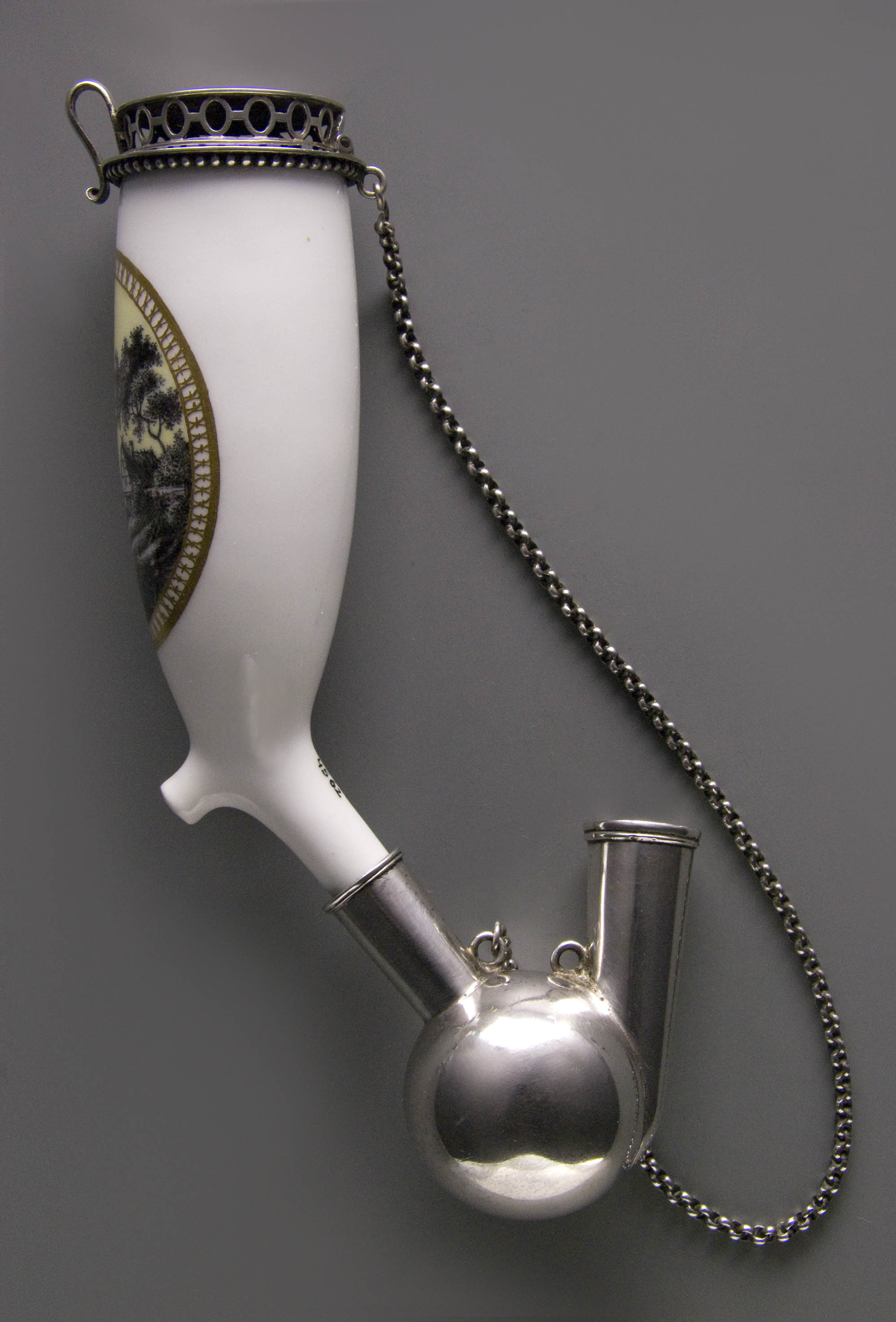
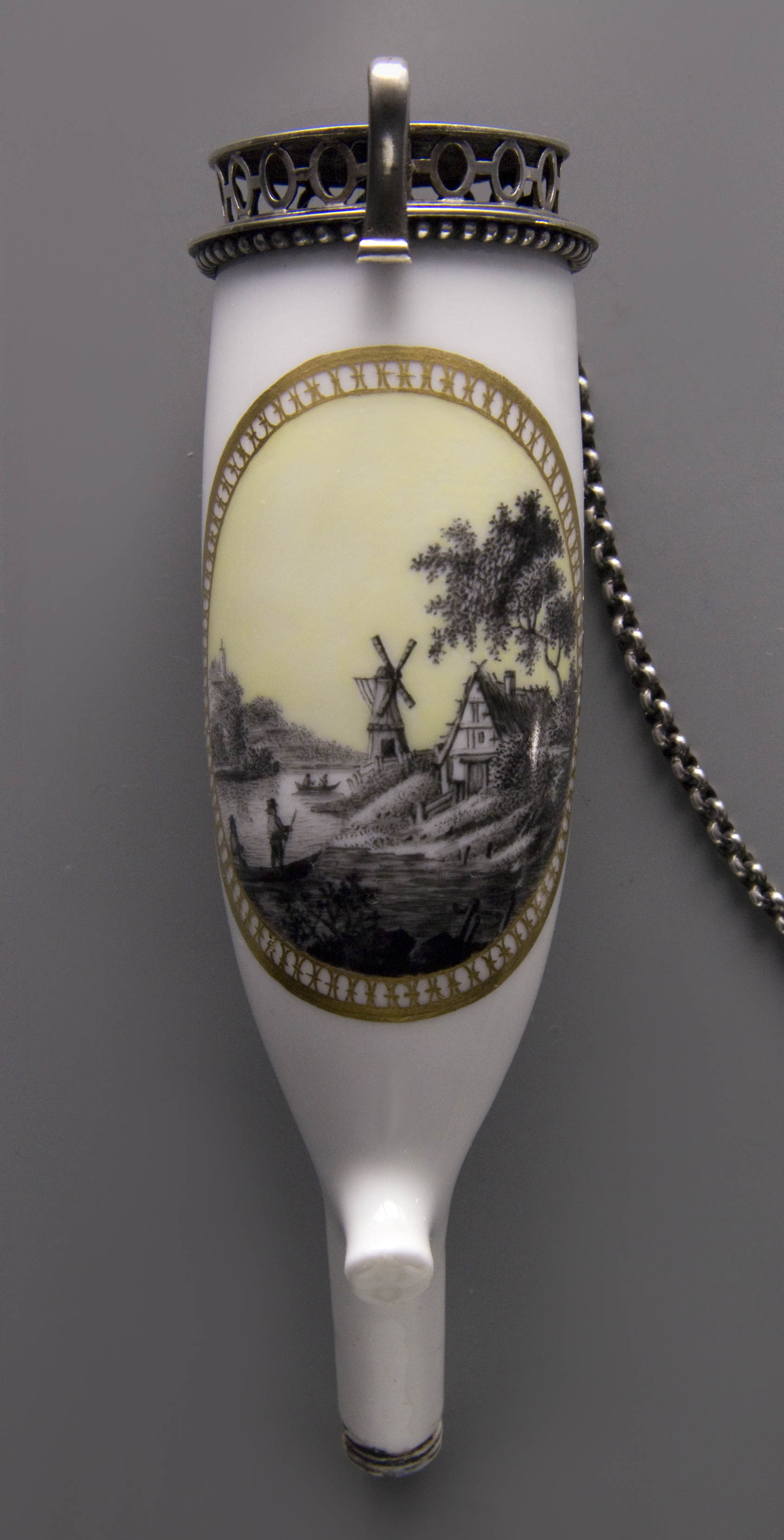
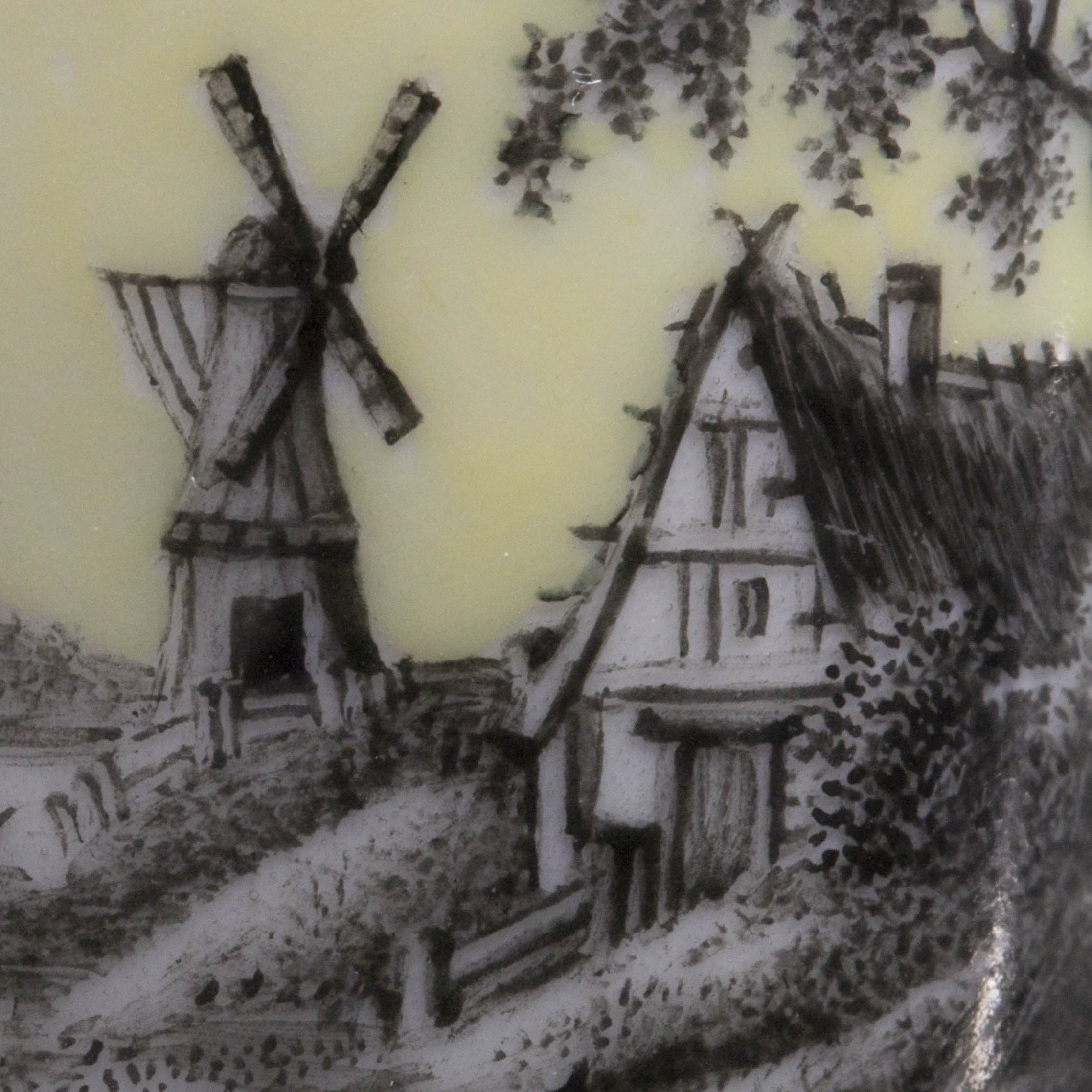
One of the highlights of porcelain painting shows this stummel from the Königliche Porzellan Manufaktur in Berlin. In addition to Meissen, the Berlin manufacturer enjoyed great prestige as well, being one of the leading porcelain factories in the world. Their great quality of the painting is clearly reflected in this pipe. The image on the front of the bowl falls within a standing oval framed by a double wide band of gold leaf that is artfully pierced and resembles an open-cut band. In this oval an extremely finely painted representation has been applied. This painting is not done in natural colours but in monochrome black, the so-called encre de chine, which testifies to a chic austerity. Pictured is a sloping landscape where a river flows through, right under a tree is a farm, in the back we see a high windmill. In the foreground are a few people at a boat. Despite the small size, the painting was done with the utmost care, it seems that the painter used a brush with only one hair. Quite unexpectedly, the clouds have been coloured with a plain, bright yellow background, a fashion colour for those days that is a bit unexpected for us now.
The date of this pipe is between 1810 and 1820. Production at the German porcelain factories was already highly standardized at that time. For example, one used a format number for the different sizes of stummels. This format number was often printed on the heel, in other cases on the stem. The figure "8" was the most common size, which we see very inconspicuously on the heel of this pipe bowl.
The luxurious painted pipe bowls were mounted with a silver lid edge on which a hinged cover is mounted. With this pipe, the lid is more luxurious than average. Around the bowl a silver pearl fillet is applied just under the air inlet consisting of a sawn edge with upright ovals, as it were, following to the oval picture frame. A so-called clamping spring serves as closure. The pipe bowl is complete with its original silver spherical moist bag with a safety chain to the bowl. This bullet-shaped bag also indicates an early date. All in all, this pipe is a luxury example of a pipe bowl from a highly developed porcelain factory. The careful mounting underlines the special quality.
Amsterdam, Pijpenkabinet collection Pk 4.562
A regiment of Napoleonic soldiers
In the porcelain industry, there has always been great interest in figuration of the pipe. It was the authoritative German factories that had come up with unexpected porcelain designs in the eighteenth century, such as endearing pug-dogs turned into pipes. In the nineteenth century that fashion was partly taken over by the French. The porcelaine de Paris and the work of Jacob Petit might have made a special contribution to the figural pipe, although we do not know the full details of it yet. In addition, some series of figural pipes have been created, which also amaze us. An exclusive set of Napoleonic soldiers, for example, was produced by an unknown factory.
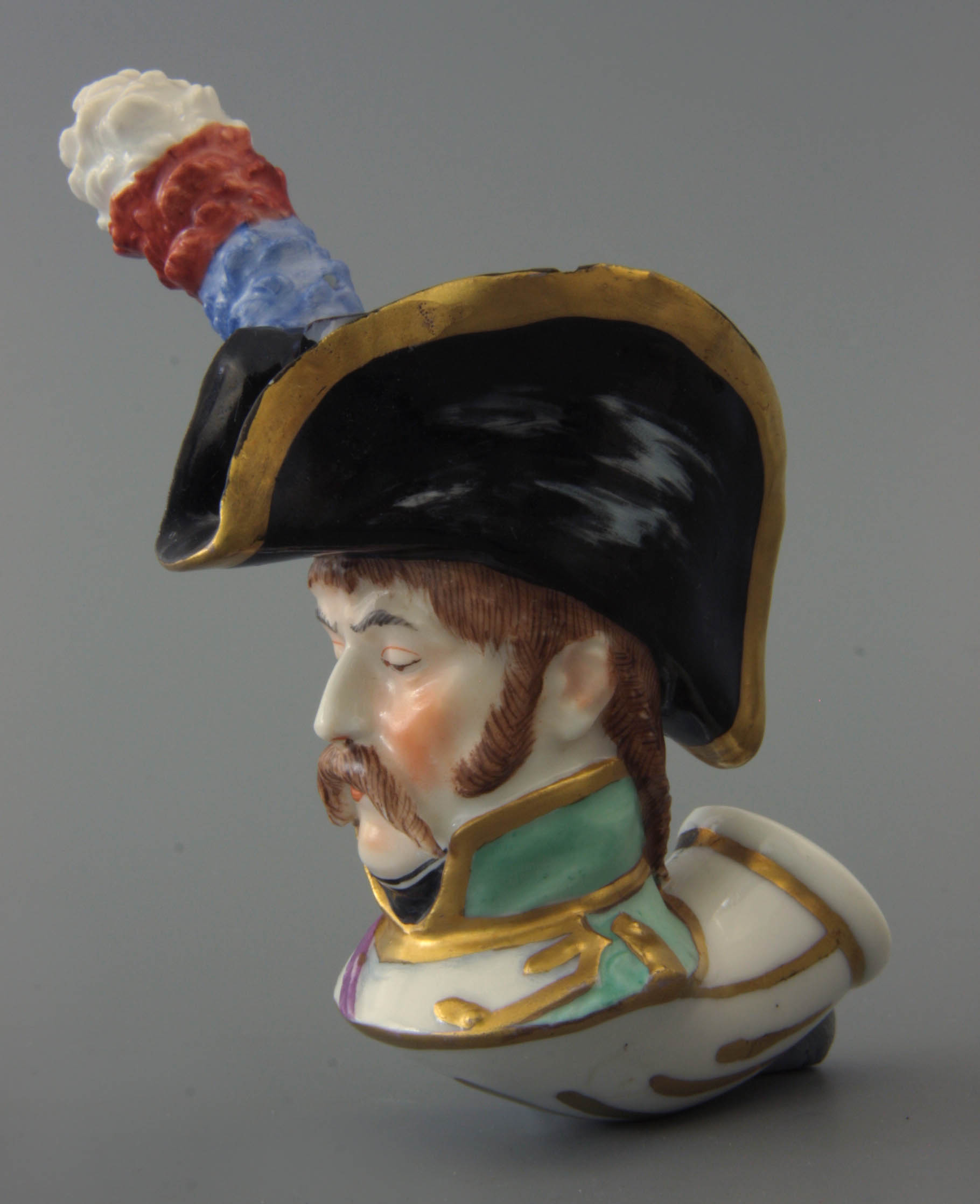
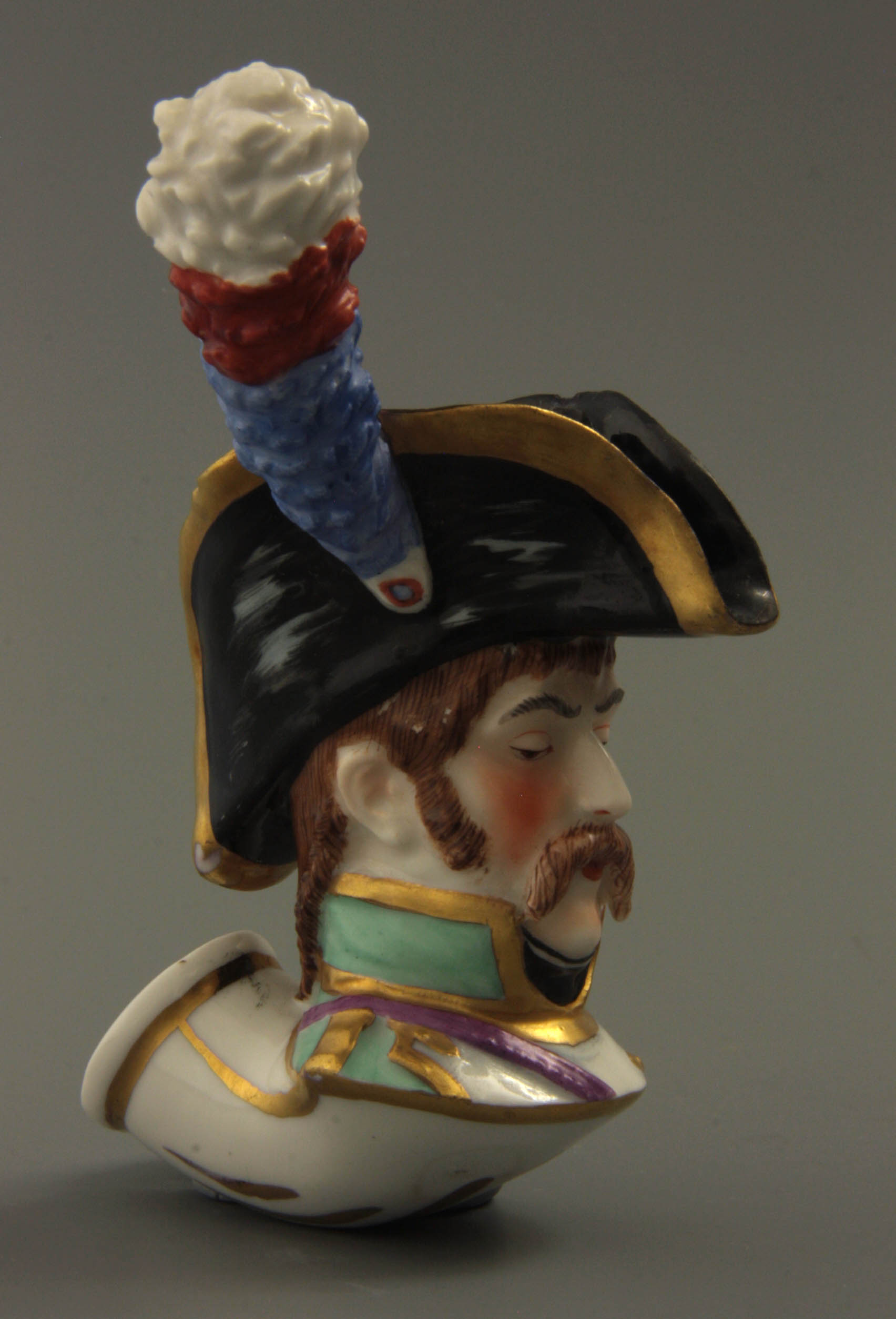
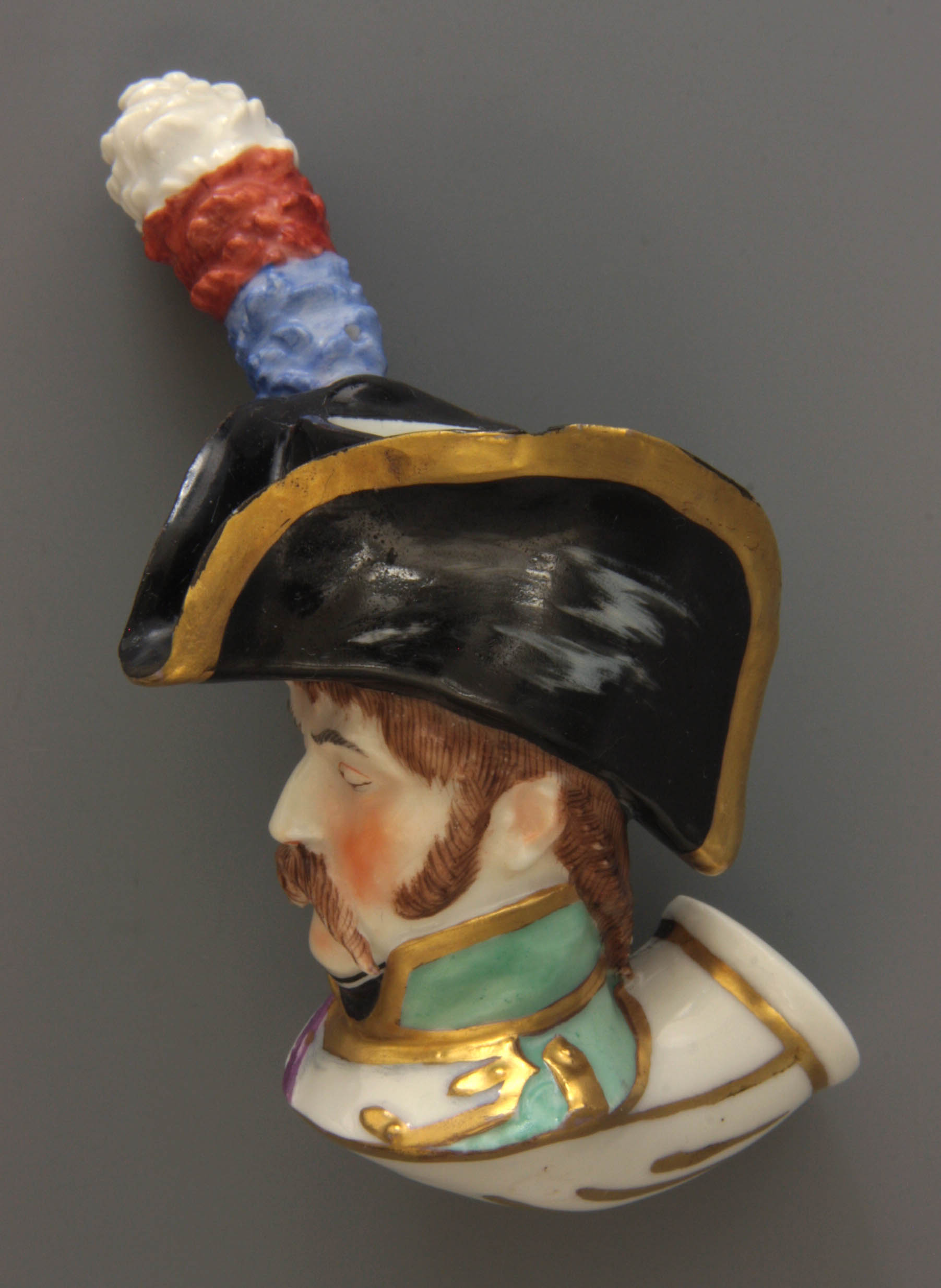
From this series, of which the Pijpenkabinet holds 22 specimen, one copy has been chosen for discussion because it is a really exceptional example. It shows a general with a two-sided stitch on the head with a high feather plume in the colours white, red and blue. Everything about this pipe is over the top, that goes for the flamboyant modelling, the fine finish and the painting in bright colours. Finally, accents were still heightened with dust gold.
We can be certain that these pipes are modelled on existing costume prints depicting the different regiments of soldiers. The modeller studied meticulously the endless series of costumes and he completely faithfully reworked them, an assignment he took very seriously. This went so far as to include the portraits of the depicted men in harmony with their military status. We see faces ranging from iron-eaters and worn-out elderly fighters to immature persons under twenty years of age. The disadvantage of these portraits is that the lips are sometimes too feminine: a plum mouth together with the blushing is not really appropriate for a soldier.
Except that the pipe bowls can be admired aesthetically, we can also appreciate their technical details. In that case, not the artistic merit comes first, but rather the functionality. Well, in terms of usability as pipe, the pipe bowls do not work perfectly. In the case of the general discussed here, for example, the feather plume far above the bowl opening is clearly inconvenient. During smoking, thumb or finger easily hang behind, while emptying the pipe is almost impossible. Because the interior of the bowl is strongly shaped to the outer design of the pipe, it resulted in a rather irregular shape. This is not really convenient for the smoker because inevitably tobacco remains behind in different places. Also the stub of some pipe bowls is not very pronounced, so that it has a risk of breaking when the stem is inserted.
On the inside of the stub, these pipes show an incised shape number in Roman numerals. Those figures increase to far in the forty, so assumedly the complete series has consisted of dozens of different soldiers. This is more an early example of a collecting item than the need for the market to have new models available. Did the manufacturer follow his hobby here? In any case, he ensured that his customers who could afford it would receive a special collectable that could be supplemented almost infinitely. We can assume that the series did not come about in one go, a new copy will be designed at regular intervals. Examination of the different specimens and especially the use of the gold also shows a certain periodization. For example, the gold leaf ornament on the underside of the bust is slightly more extensive at first, while the motif is sometimes even almost gone with later pipe bowls. As a matter of fact, this gold leaf was applied to obscure the prints of the baking support.
Amsterdam, Pijpenkabinet collection Pk 19.501
The magical meerschaum
The horses of the San Marco
This seemingly ordinary undecorated pipe bowl in case has a special history. In terms of shape, this pipe with its reinforced bowl base and round bottom is not special. This so-called bag shape is already in vogue in the eighteenth century and this specimen is a very pure example. In the nineteenth century, tens of thousands of pipes will be made in this bag shape. In addition, the quality of the meerschaum can differ, from the most finest first-rate pieces that are maximally light weight to the less popular heavier blocks. For this pipe the best raw material is used which is not surprising. The pipe bowl was intended to be provided with a really special mounting.
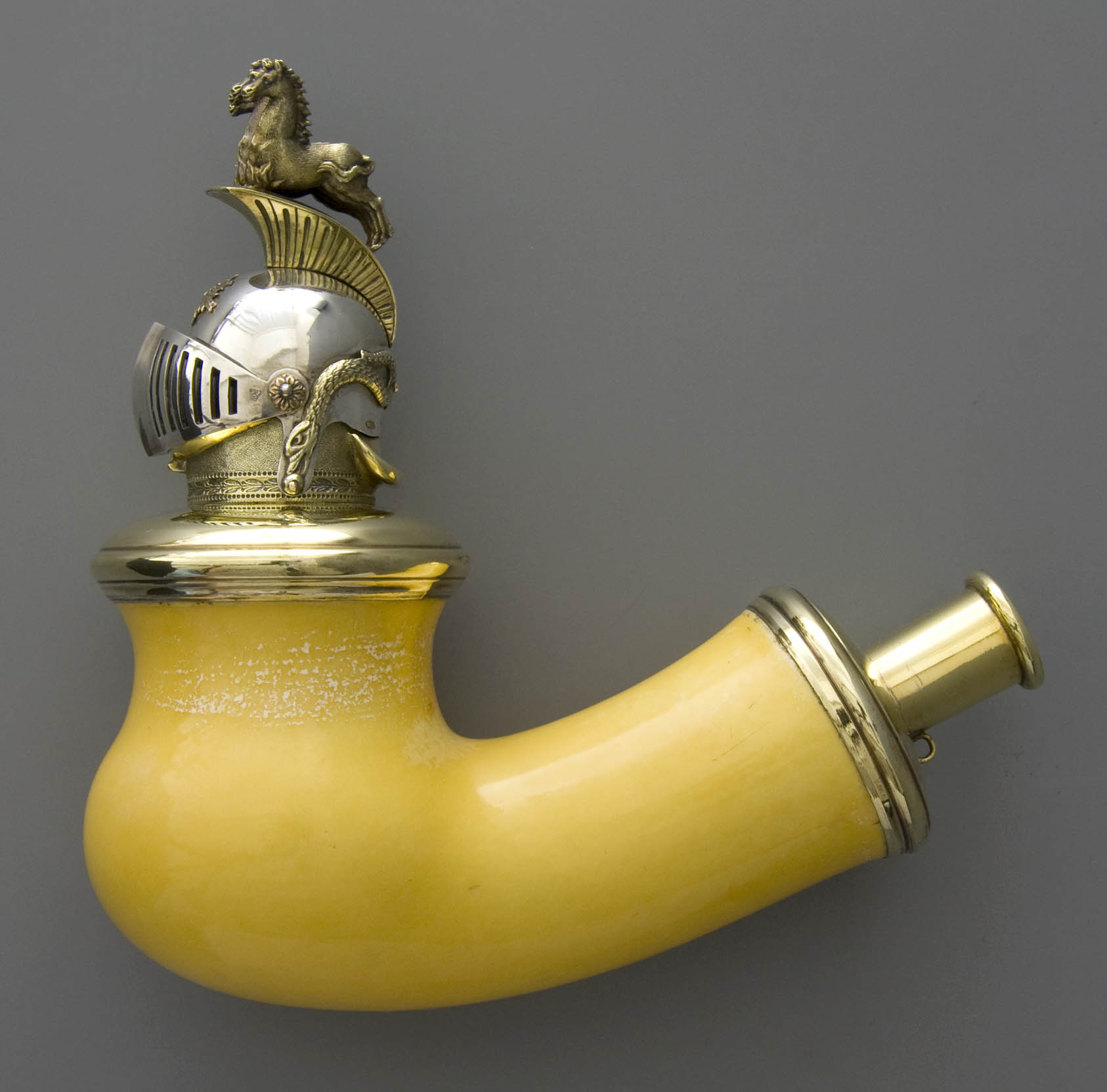
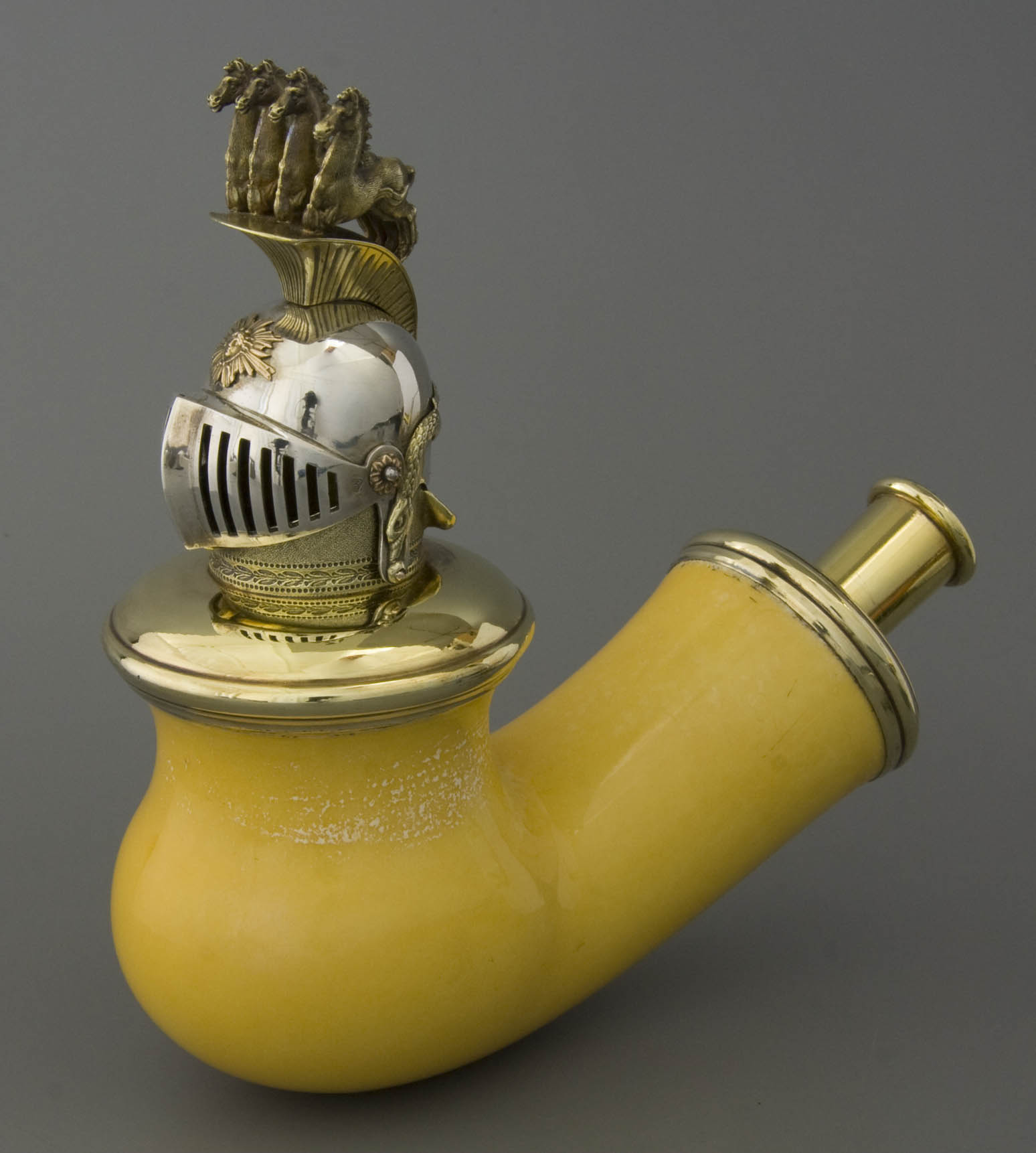
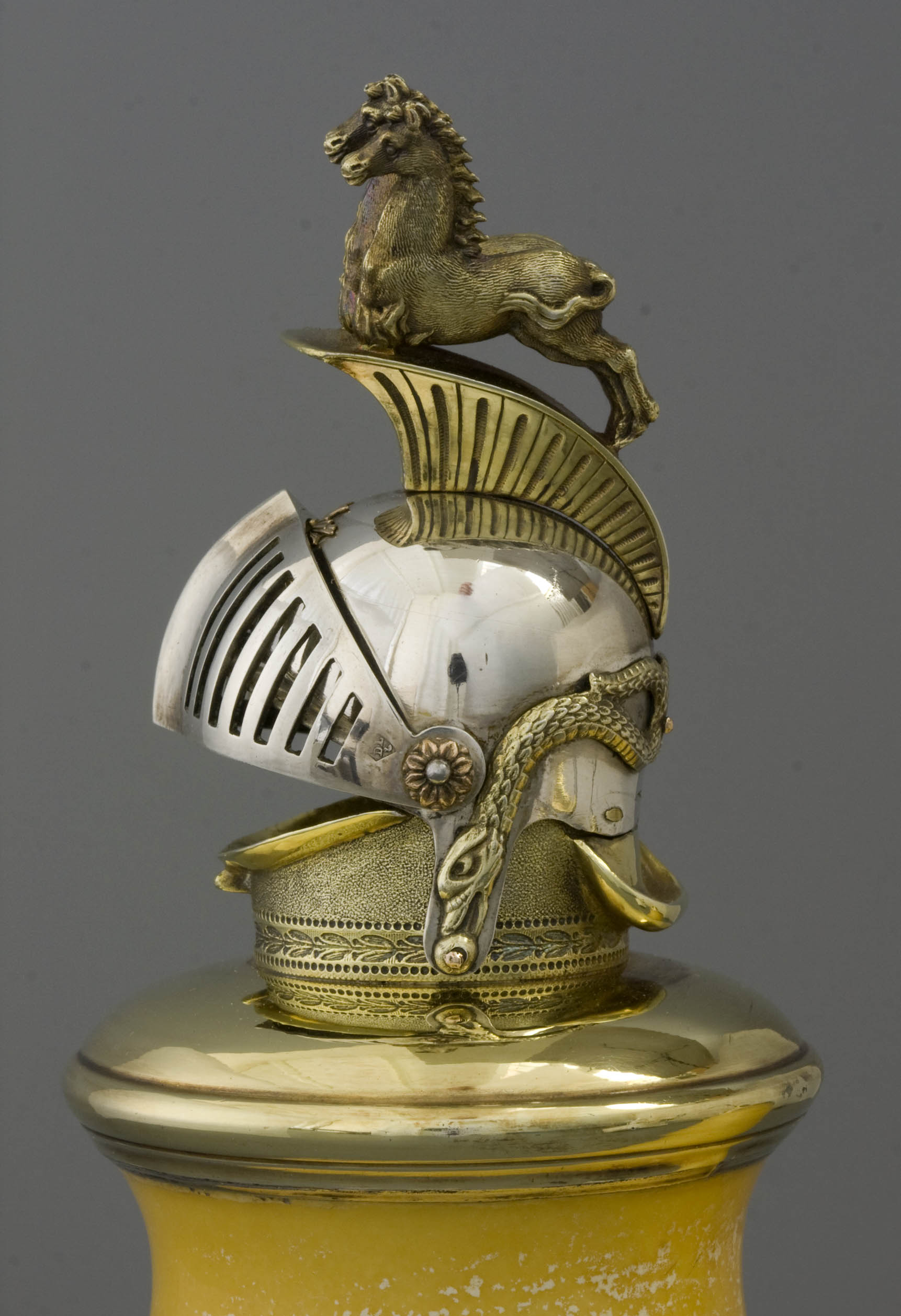
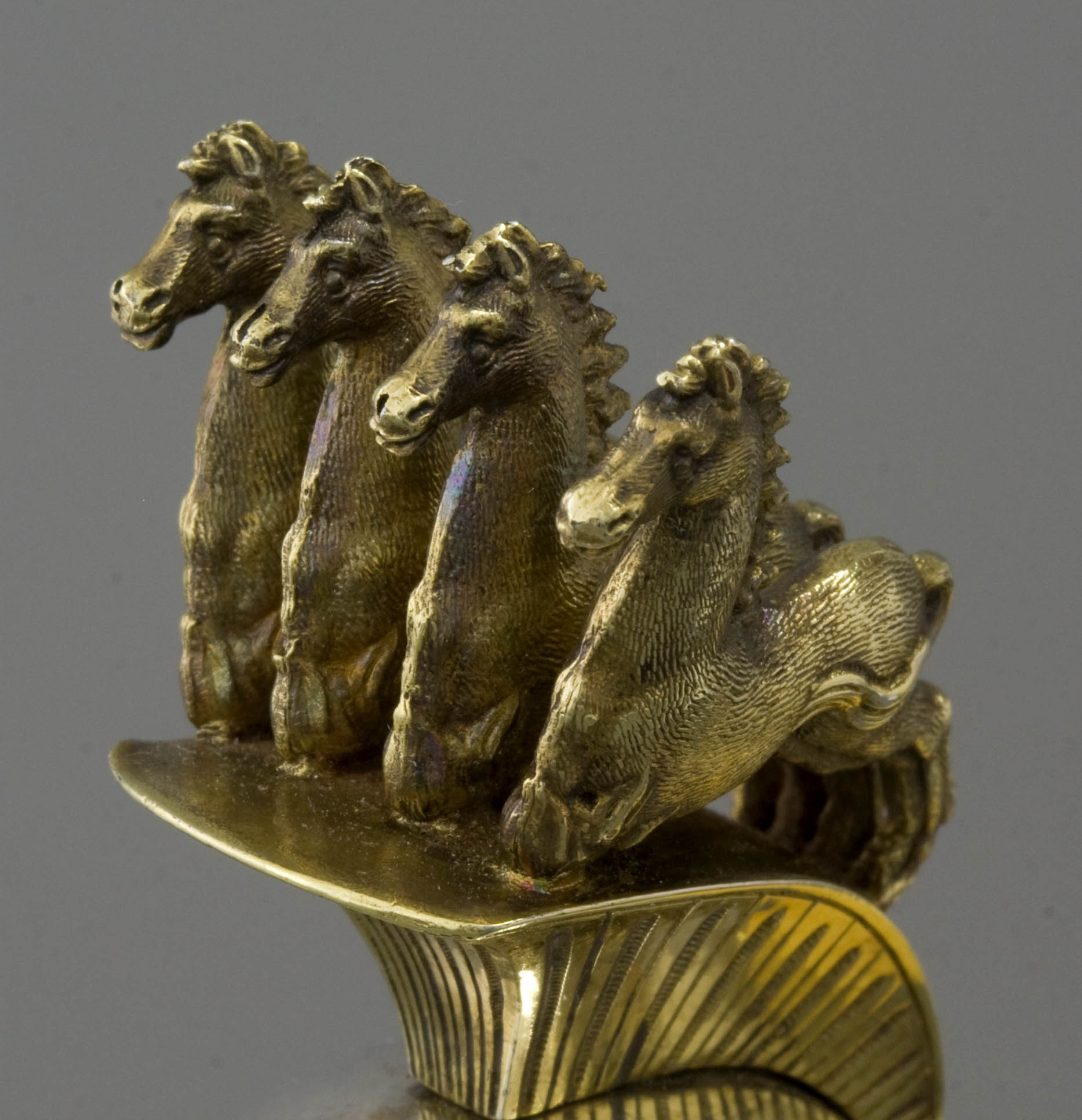
At special request of no one less than Emperor Napoleon himself a luxuriously mounted pipe was ordered in 1807 at the skilled goldsmith D. L'Honorey, working at the Quai des Orfèvres in Paris. It was to be a gift from the emperor to his marshal who had made a special act of war shortly before. He conquered the city state of Venice and presented to his emperor as a trophy the famous horses of the San Marco. The four more than life-sized bronze horses had decorated the most important church of Venice since time immemorial and now arrived in Paris.
Very appropriately, the appearance of the imperial gift had to refer to the martial act. L'Honorey did this by designing a lid in the form of a military helmet with visor and placing the four horses of the San Marco as the crest on top of this helmet. The silversmith was not only exceptionally inventive in the artistic part of the design, but also in the technical execution. The lid was high and heavy and should easily be opened to give access to the pipe bowl. At the same time, it had to stay steady while smoking. To achieve this, L'Honorey used a double hinge with an ingenious closing mechanism. By pressing the visor, it slides up and unlocks the lid, which then opens completely with three clicks. The helmet folds back further each step until the pipe bowl is completely free. To make the appearance even more luxurious, parts of the silverware were gilded. Finally, a case maker made a beautiful, fitting casing, internally lined with satin and velvet, on the outside with red leather. The edges were neatly trimmed using stamps with gold leaf and three hooks made sure that the case was properly lockable.
Given the traces of use on the inside of the pipe bowl, the Marshal has not been an avid smoker. The pipe has only been used a few times and was then carefully stored for generations in the casing. Who afterwards have been the owners of this imperial gift remains unclear. The object surfaced in the Parisian antique trade in 1982 and was bought by one of the most renowned Jewish antique dealers in Amsterdam. Twenty years later this special object was handed over to the Pijpenkabinet.
Amsterdam, Pijpenkabinet collection Pk 16.425
Pipe with two river gods
In artistic terms this is the most beautiful pipe from the Pijpenkabinet collection in Amsterdam. It is commonly referred to as the Tweestromenpijp (two rivers pipe). According to tradition, father Rijn and Lorelei were depicted with the arms of a double-headed eagle. The pipe would be a gift from the Habsburg House to a member of the Russian family of czars, although for the rest details remain vague.
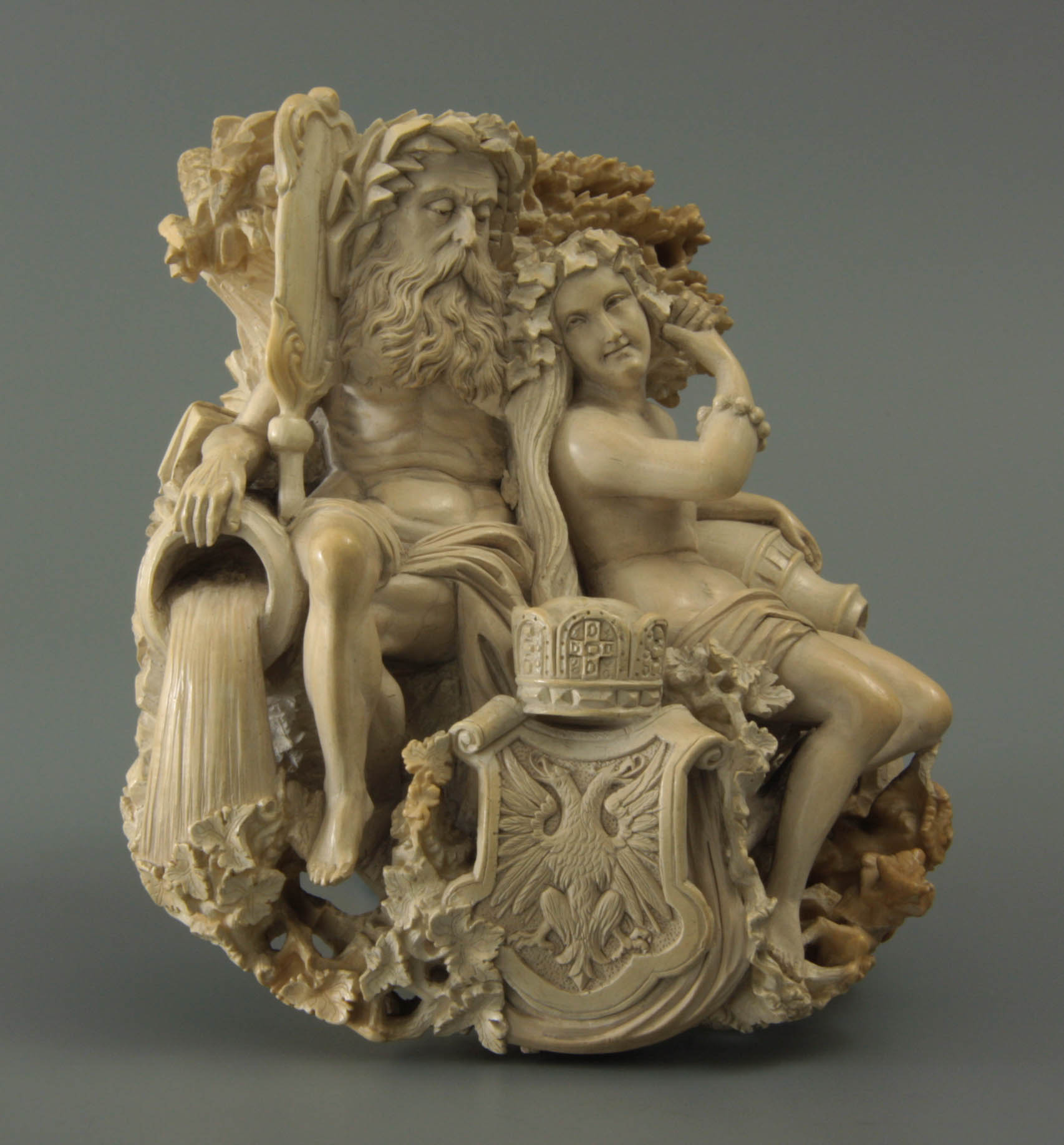
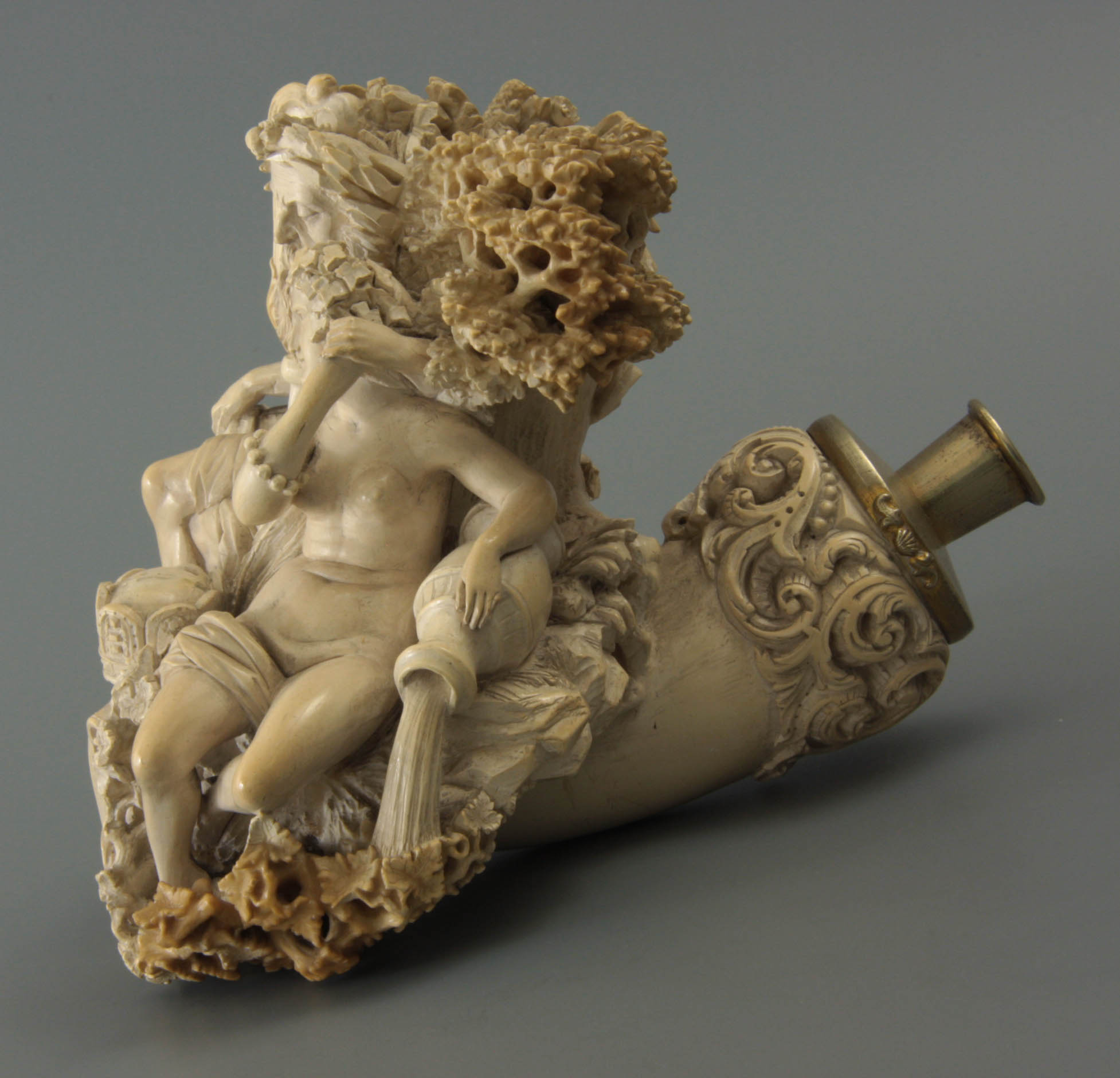
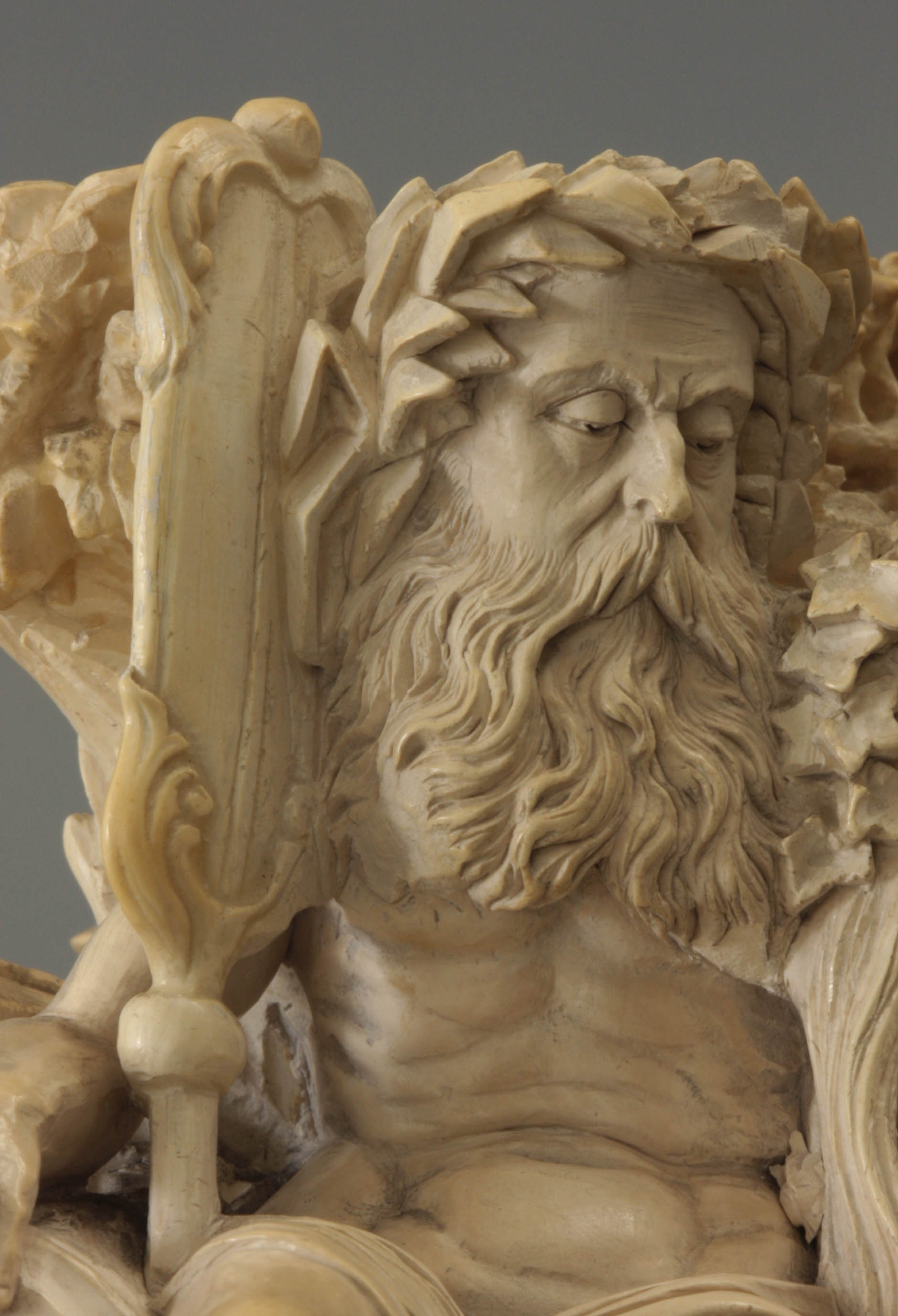
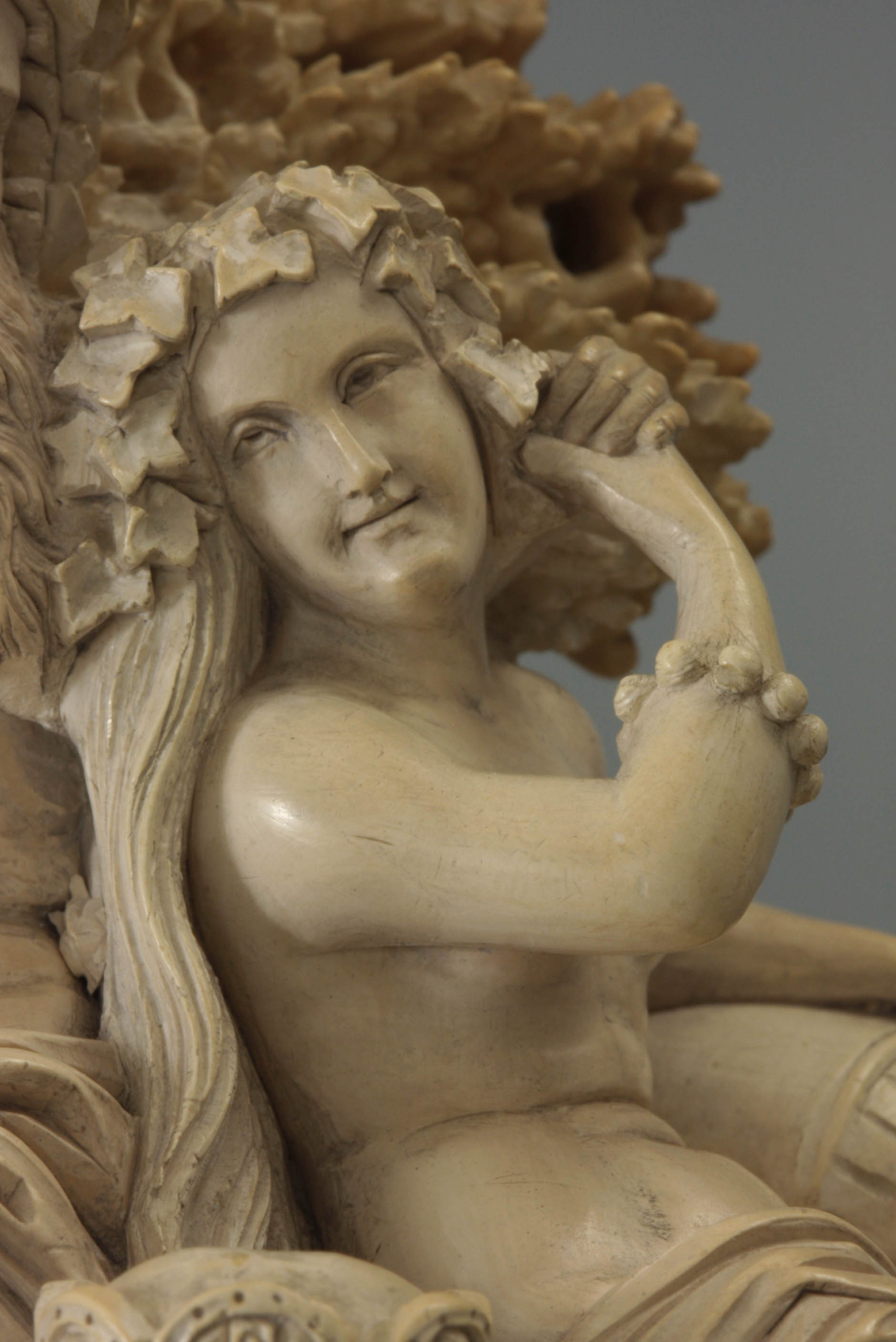
Both sculpted persons are shown as stream gods. The Neptune figure fully meets the iconographic pattern. He is depicted as an old man with moustache and long beard, with a wreath of pointed reed leaves around his head. As usual, Neptune is naked with a rag over his loins, as an attribute he holds an oar that brings a vertical accent into the image. His right arm leans on a wide urn from which a river arises. The woman on the right carries vine-like leaves around her head, with the left hand she leans on a watering pitcher, which gives her the title of goddess of the river. At the base is a standing coat of arms with double headed eagle above which the famous Hungarian imperial crown. Around the pipe bowl the scene continues with reeds in which reed plumes on the right and shrubbery left. The sketch has been worked out completely which makes you almost forget that a pipe bowl is hidden in the centre.
At the rear, the pipe stem emerges from the scene, which is smooth and thickens to a cuff towards the end. This cuff is decorated with a wide band with stylized leaf motifs and c-volutes. The cuff is mounted with a silver plate with punched motifs soldered along the folded edge. A conical stem holder is placed centrally on this plate. The silver shows traces of gilding.
When we consider that the basic shape of the pipe bowl is an Hungarian, a high cylindrical shape with a round bottom and an ascending stem, we see that the decoration on the different sides is unevenly expanding. That unexpected asymmetrical shape of the pipe bowl may be related to the method of the carver. His artistic ability enabled him to adjust the figuration to the block of meerschaum available to him so that he could use the raw material to the maximum. He was therefore not rigid and cut away what was undesirable in the decoration but made optimal use of the material and thus came to an unexpected composition. If one looks through the eyelashes, one can still see the original shape of the meerschaum lump.
There is something strange about the handed-down attribution of the pipe to Rhine and Lorelei. The old river god can very well represent the Rhine, one of the longest and most famous rivers in Europe. The Lorelei is not a river but a dangerous rocky point in the German Rhine valley, personified by a woman who watches over the passage. Therefore the name does not match the representation. Based on the fact that the pipe is an Austrian gift, we should perhaps look for the real meaning more eastward. If we identify the ancient river god as the Danube, the second largest European river, the younger and smaller river goddess can represent the Moldau. The Austrian imperial coat of arms then gets a logical meaning because both rivers lie within the Habsburg Empire.
Because of the high artistic content we tend to attribute this pipe to a Viennese workshop. Determining meerschaum pipes to production site is not easy due to lack of knowledge. Vienna is always seen as the main city for artful meerschaum carving, the role of Budapest is always underexposed. But other meerschaum workers were active in other cities as well. Yet that Viennese attribution for this pipe is justified. The exceptional composition and the beautiful effect elevate this object above all common pipes of that moment. That is why this piece deserves to have served as a royal gift. Seen from the Vienna court, this pipe bowl should certainly be made there. Given the decoration, it must have been between 1835 and 1850.
Amsterdam, Pijpenkabinet collection Pk 1.485
Pipe in a rosewood box
A valuable pipe deserves to be stored safely. This usually happens in a pipe box or pipe rack, which used to be found in almost every household. Some pipes, however, are stored individually, in a box or close-fitting casing. A nice example of this is the rosewood box with rectangular shape that can accommodate a single meerschaum tobacco pipe. Below the flat lid we see five compartments. Left is a spacious and deep compartment for the meerschaum pipe bowl, next to it and behind there are shallow pockets for the three parts of the ivory stem. At the far right at the front is again a deeper compartment that serves the three-tassel safety cord. The front of the box is provided with a lock with heart-shaped lock plate of mother-of-pearl. As usual, the box is internally lined with red-brown velvet-like fabric so that the parts will not be damaged.
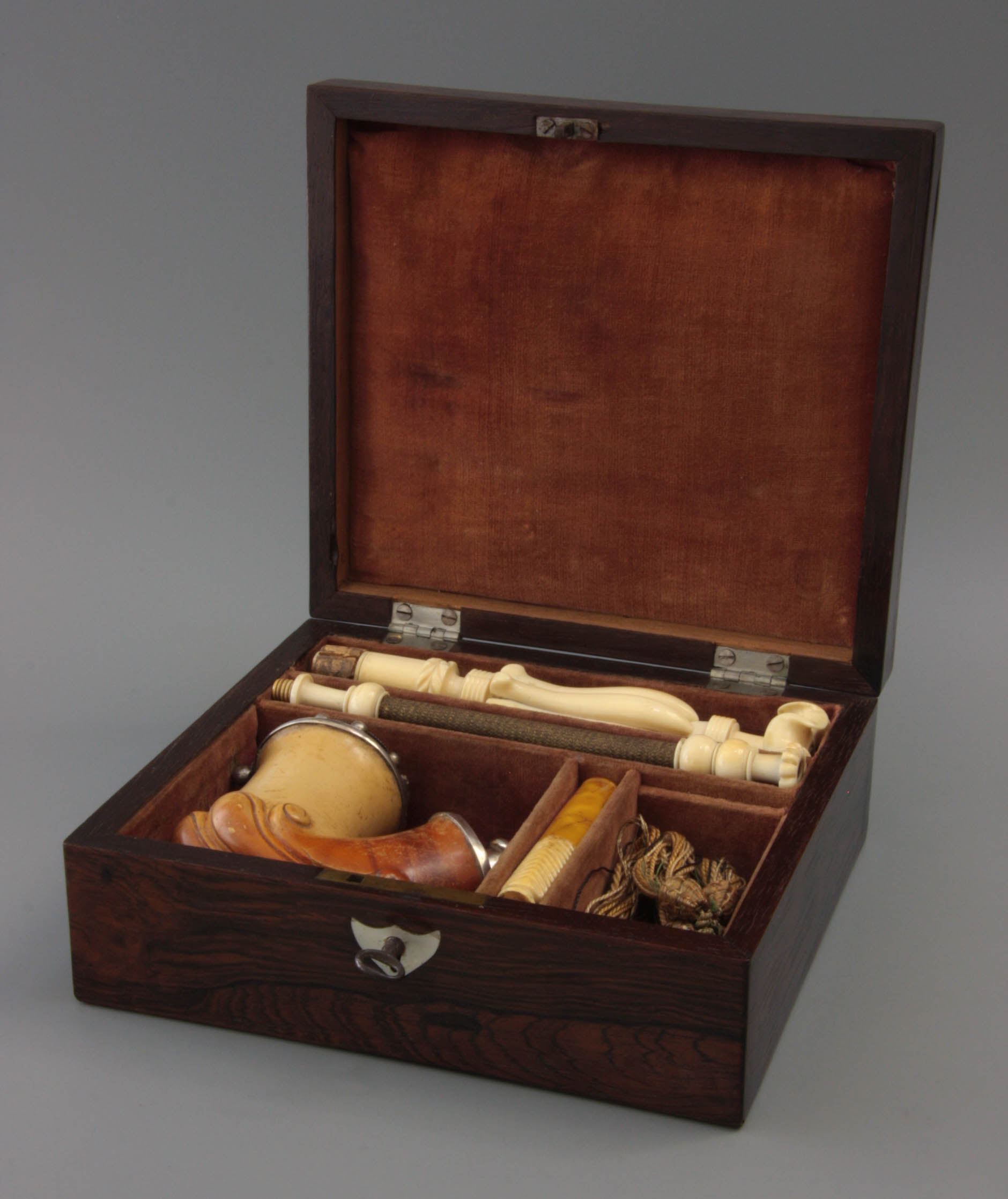
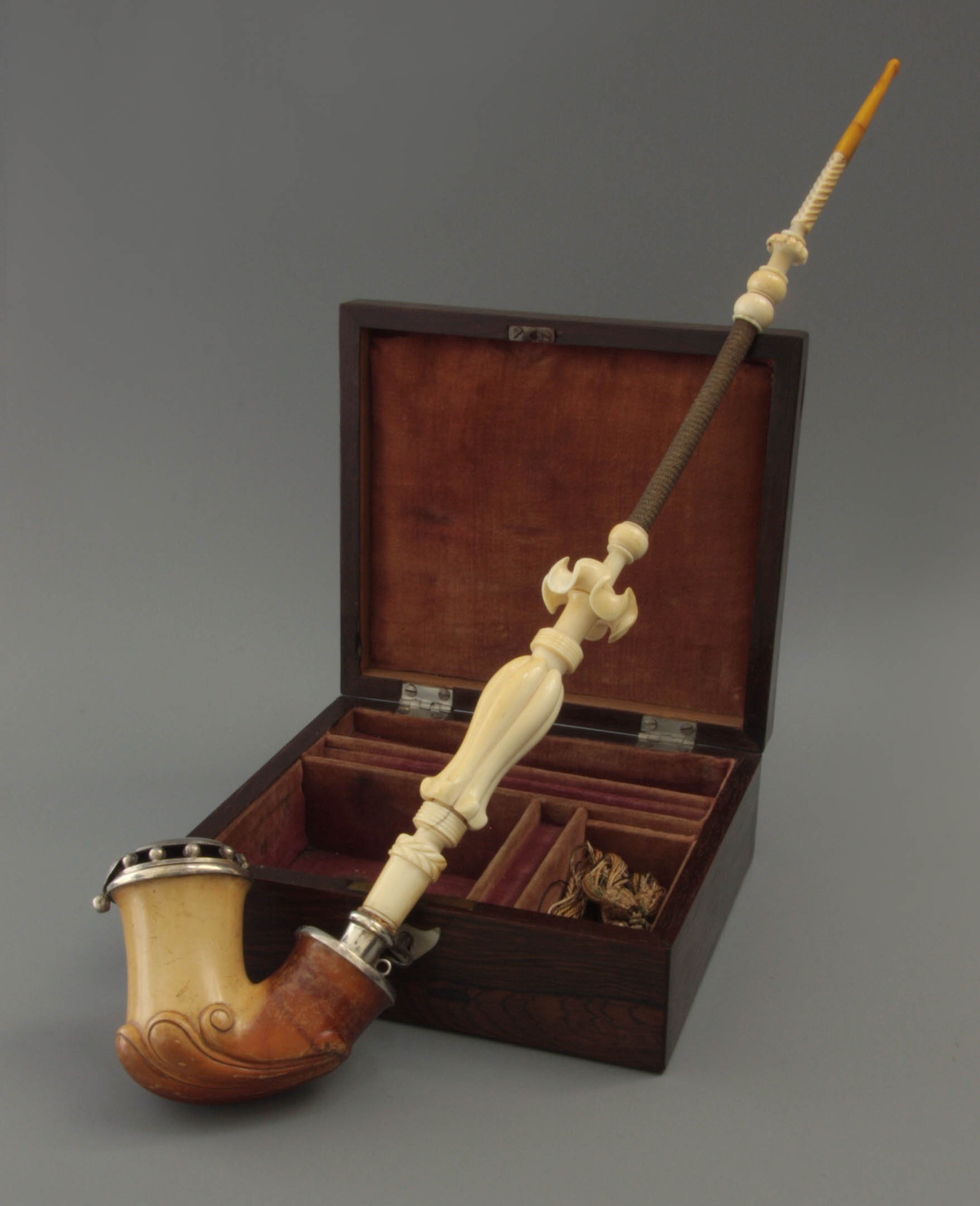
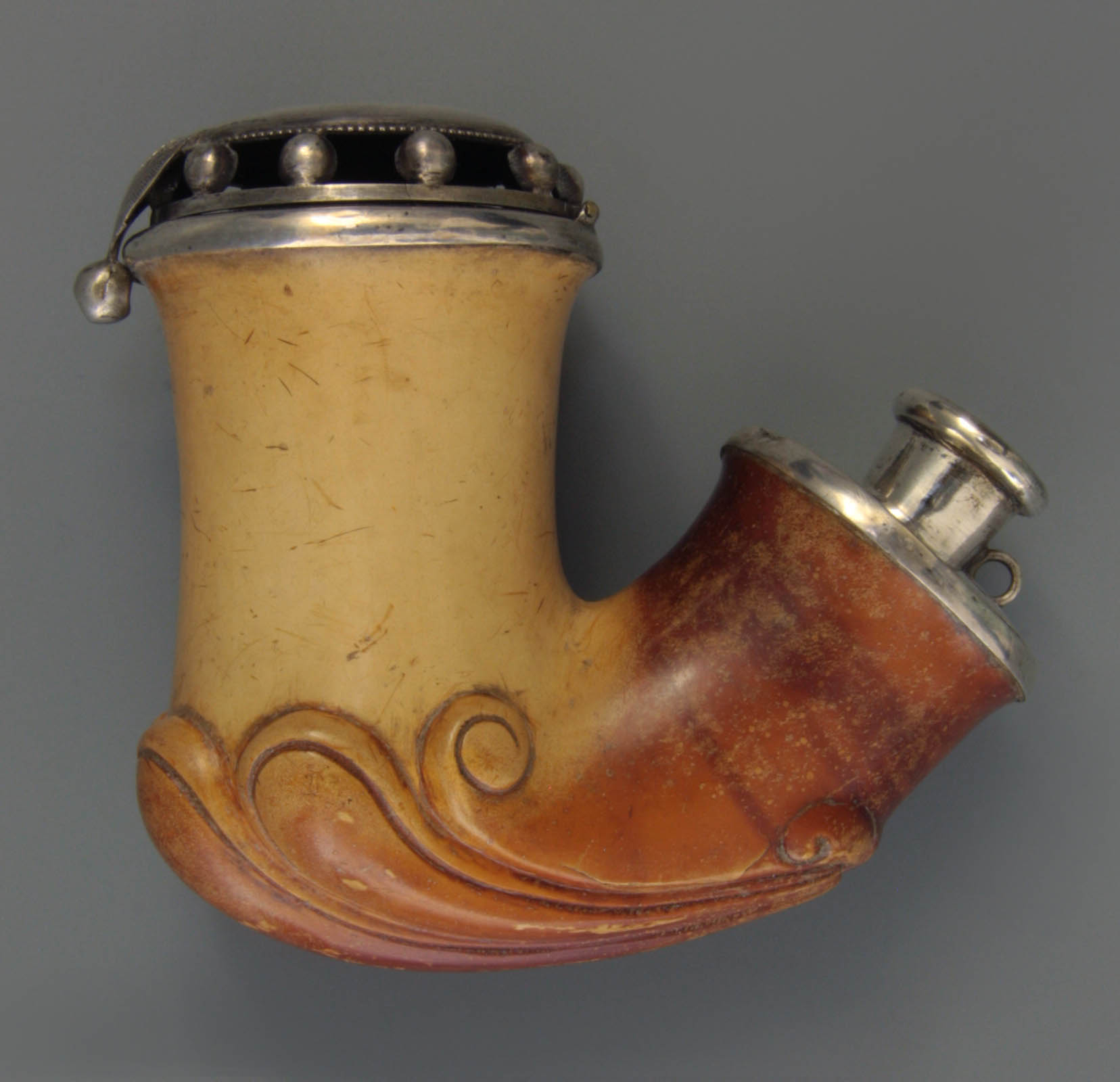
The tobacco pipe that is stored in this box is not of a great peculiarity, but apparently the smoker's favourite. It is a relatively common meerschaum pipe bowl of the so-called Hungarian shape. The base of the pipe bowl is round and merges into a rising stem with a cuff. At the base, the pipe bowl is provided with a popular motif: a shell shape in relief. That motif consists of six outlined lobes and that is remarkable in itself. It is common that this motif consists of an odd number of lobes so that the middle one runs over the centre of the pipe bowl. This is an unusual deviation from that habit.
The pipe-bowl is according to general use in the nineteenth century equipped with a silver hinged cover. That lid has a lens-shaped top and rests on ten balls that provide an equal air inlet around the bowl. The lid clamps down thanks to a spring in which three tobacco leaves can be seen on a ball. In the bowl ring of the lid we usually find the silver marks, in this case a "13" mark and the makers stamp or year letter "R". The cuff is also reinforced and finished with a ring in silver with a smooth stem holder and locking eye.
Based on the silver marks, it must be a German product. However, what often happened is that parts from different production centres elsewhere were assembled into a complete pipe. The roughly turned pipe bowl for example could have been supplied from Austria or even from Turkey. The accompanying stem can also be made in a different location, because turning ivory is a separate discipline. The same applies to the box, which does look more English than German. The date of this object must lie somewhere between 1840 and 1870. Most certainly, the pipe is cherished in the box because even after a century and a half the tobacco pipe still is in perfect condition.
Amsterdam, Pijpenkabinet collection Pk 19.514
A presentation piece with bloody battle
Because of its large size this meerschaum pipe fits into the category of extraordinary tobacco pipes. The bowl of this showpiece has a height of no less than 23 centimetres and shows around a carved scene of a bloody battle in which sixteen fighters attack each other with axes, knives, swords and bows. In the centre of the scene we see an Arab on a rearing horse who is attacked by a soldier who pierces his chest with a dagger. It is a beautiful depiction that undoubtedly reflects on an existing print of high quality.
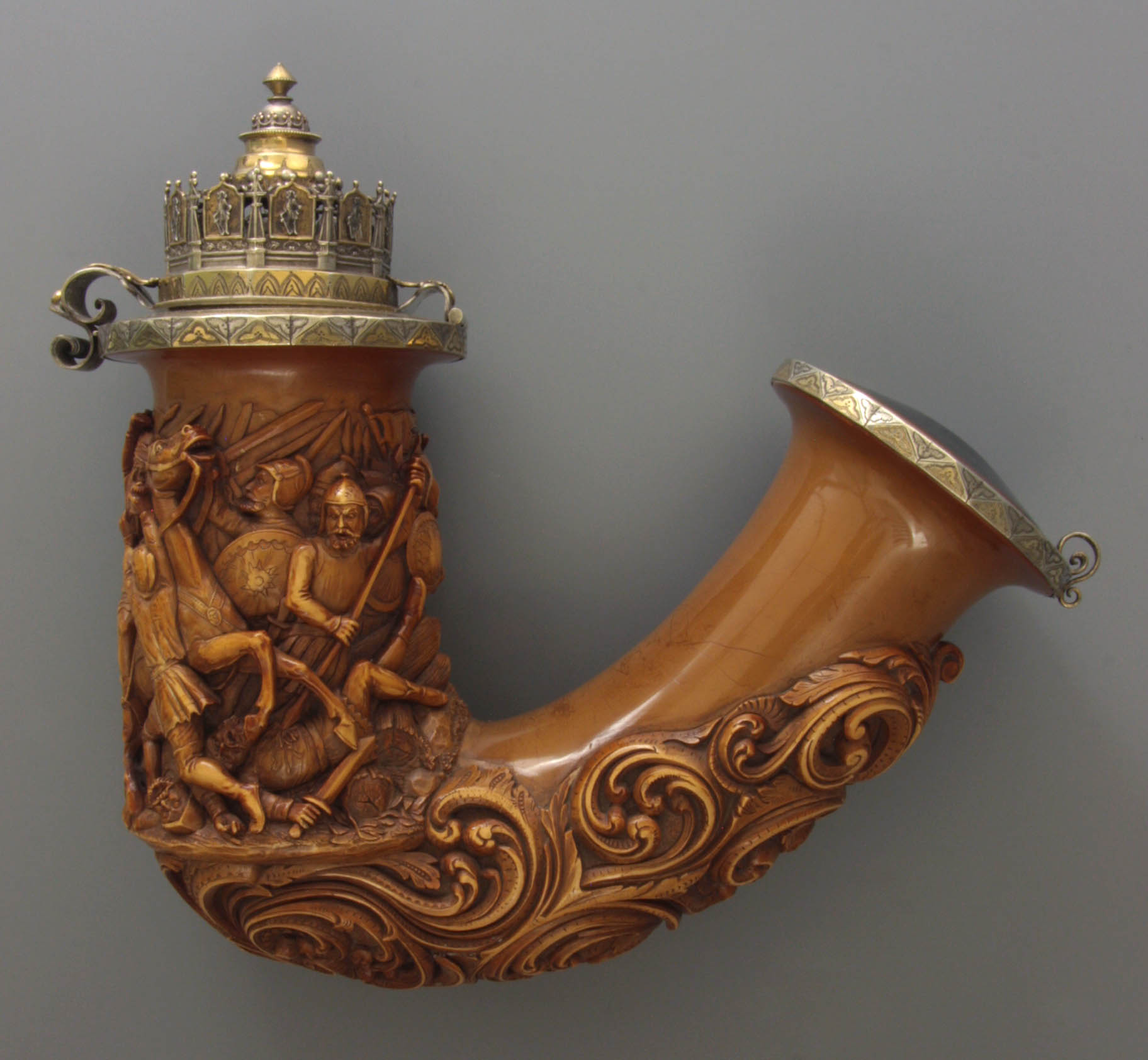
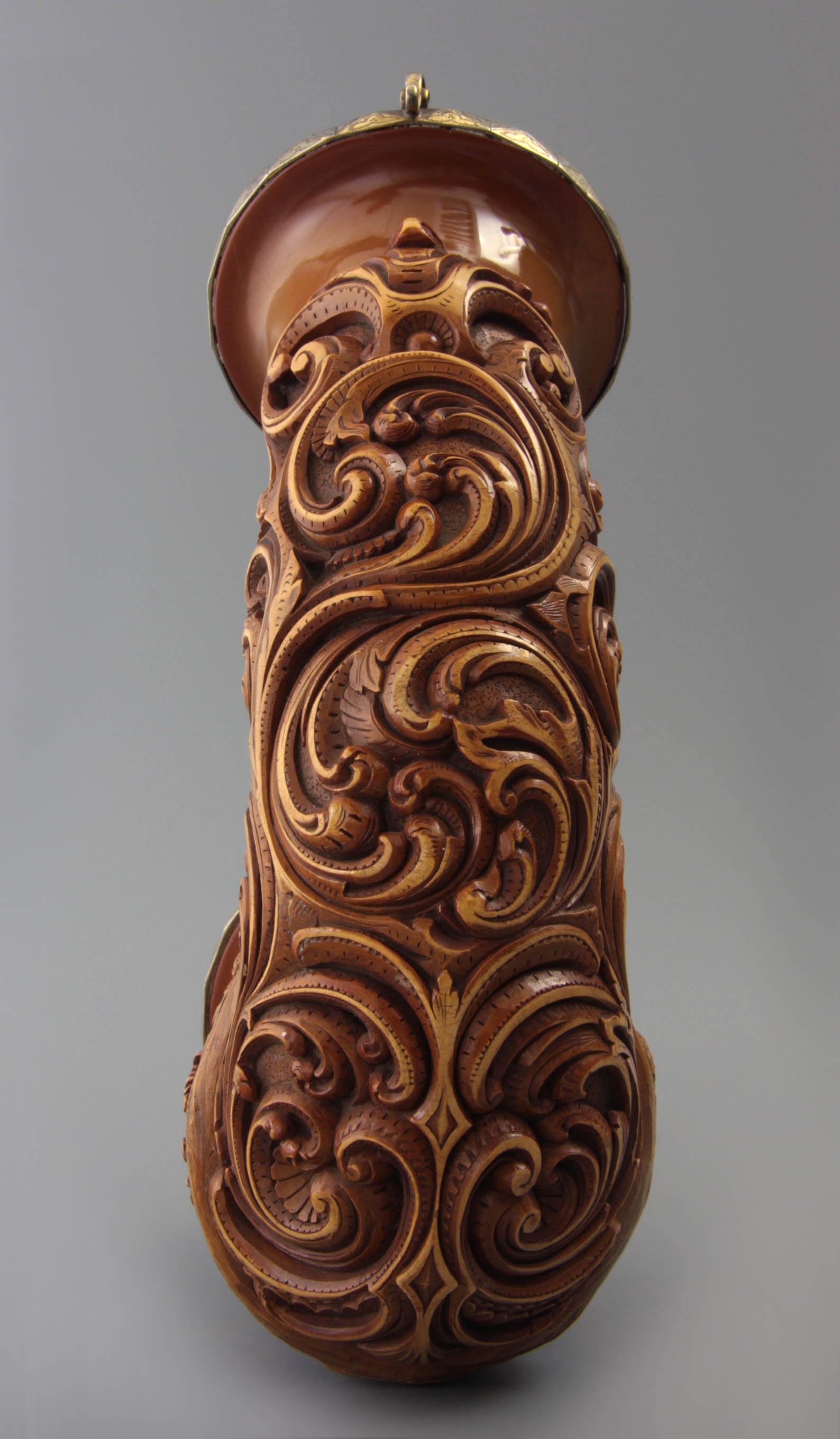
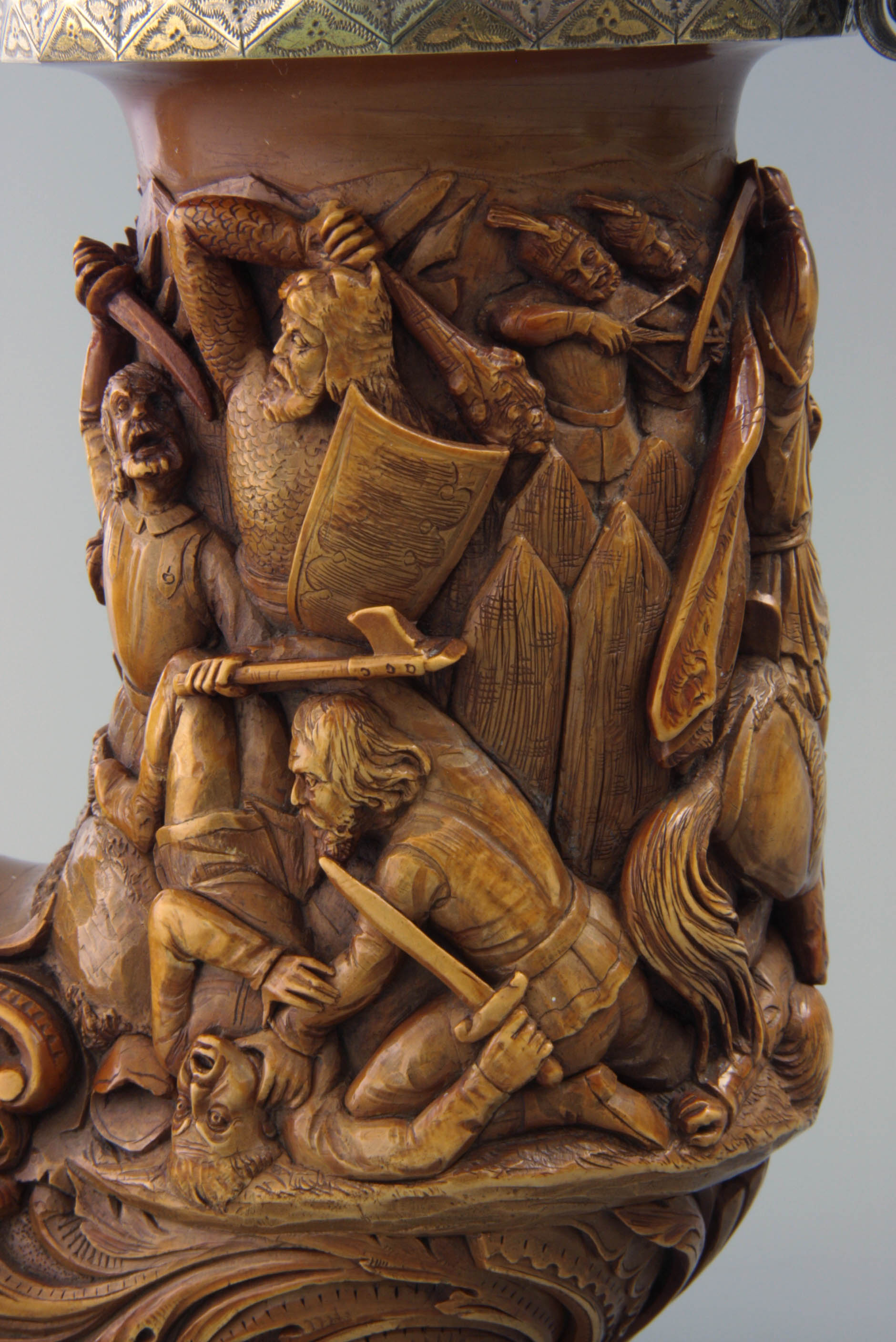
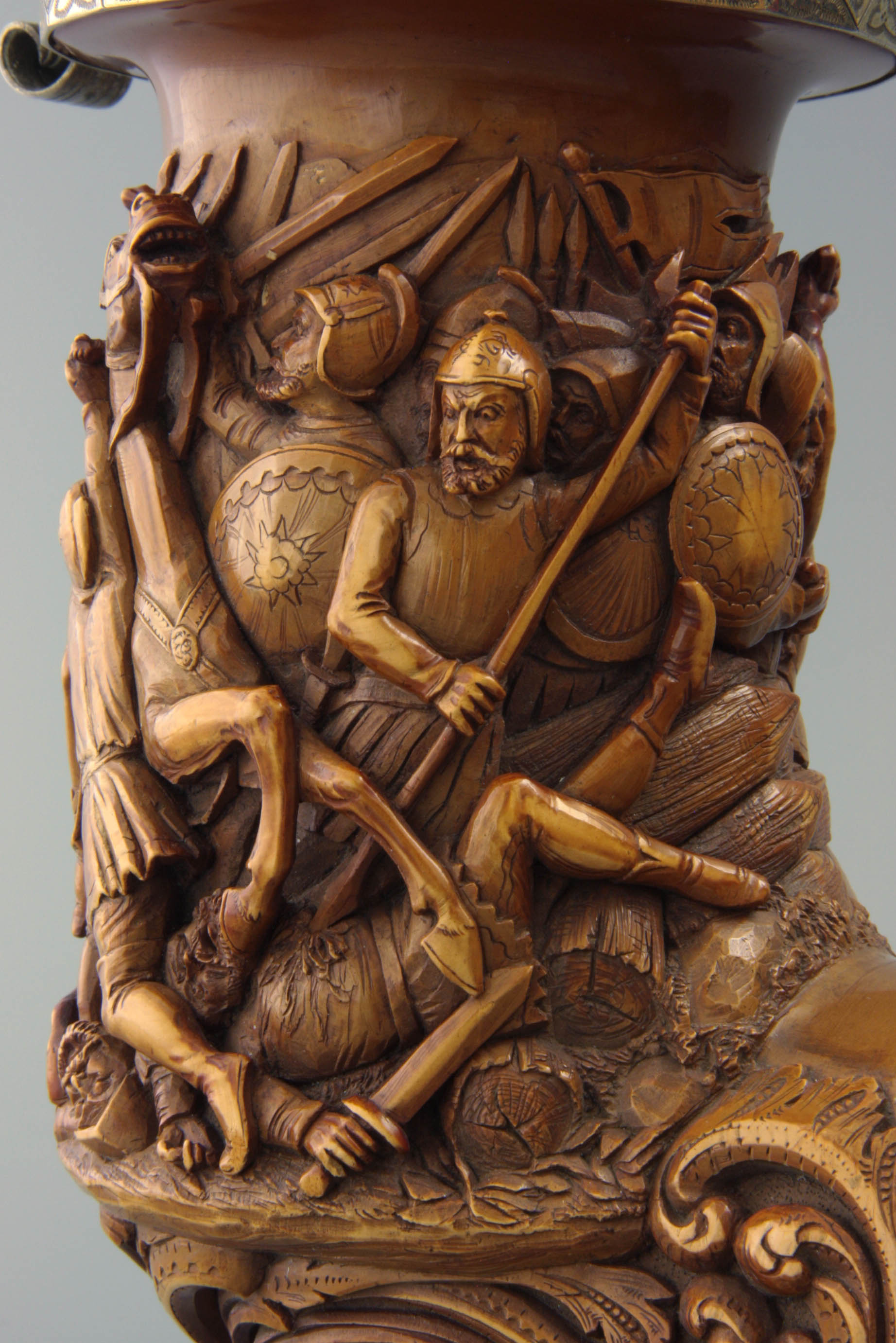
In addition to the swirling decoration that has been skilfully worked out with all sorts of interesting details, there is the shape of the pipe bowl itself. With its high cylindrical bowl and heavy stem that flows smoothly from the bowl and ends in a cuff, the shape of the pipe is very characteristic of the 1860s and later. Around the pipe bowl the battle scene decoration follows the shape of the pipe in an attractive bas-relief that is sufficiently picturesque to radiate a great naturalism. The base of the bowl is overgrown with a carved winding foliage, continuing on the stem, alternated with small rocaille-like ornaments. Those motives form a welcome ornament to the long, rather boring shape of the bowl base and stem.
Special is the mounting with a beautifully openwork silver hinged cover with facetted edge, beautifully engraved. The lid itself has the shape of a ten-sided crown consisting of panels with an embossed standing knight. The inside of the crown is cut open and ends in a point shape. The clip spring has an elegant curl. Despite the white colour, the crown is not cast in sterling silver but made of a lower alloy silver. Because most parts of the mounting are gilded, the gold colour obscures the somewhat grey colour of the silver. Two rectangular hall marks are stamped on the edge of the cover with the letters "JK", a mark that appears more often on pipe fittings. The cuff mounting is made of the same material and also features facets and engraving.
All characteristics of this pipe indicate German origin. This applies in the first place to the meerschaum, which we count to the category of mass meerschaum or pseudo-meerschaum. The pipe is not cut from a large stone, but is pressed from a composite of which meerschaum grit is the main raw material. In the period of origin, between 1870 and 1885, large pieces of meerschaum were extremely rare. German factories had long experimented with imitation meerschaum with particularly favourable results. The meerschaum powder was mixed with an adhesive and then moulded. Then it could be cut just like real meerschaum. It even had an advantage for the cutter: the stone was completely homogeneous which made work a lot easier. Finally, the Germans were also masters in creating the patina of the pipe so, even unused it could get the appearance of a long-smoked pipe.
With its solid shape and transparent lid, this showpiece has been a masterpiece among the smoking equipment of a German nobleman. For us in the 21st century, however, the question remains unanswered as to how this pipe was valued at the time. Was the owner aware that he did not have a real meerschaum? Certainly he would have known that the desirable patina was not obtained by smoking but was artificially applied. Apparently, it did not bother him in his pomp and pageantry. Whether the pipe really impressed contemporary connoisseurs remains the question. Anyway, with its somewhat pompous appearance, this product fits perfectly into German culture as we know it from the various country houses. Refinement of material and technology is more an Austrian affair than a German custom. We can see that even in the tobacco pipe.
Amsterdam, Pijpenkabinet collection Pk 17.550
European wooden pipes
Wooden pipe bowl with mirror monogram
The bowl shape of this early wooden pipe is called kalmas, a shape that originated in Turkey. Already in the seventeenth century it became known about Central Europe and is generally followed. The kalmas is characterized by a bulging round lower part of the pipe bowl, a top part that narrows, while the opening widens slightly outwards. The short truncated stem smoothly emerges from the bowl and ends in a slight widening mounted with a silver stem holder.
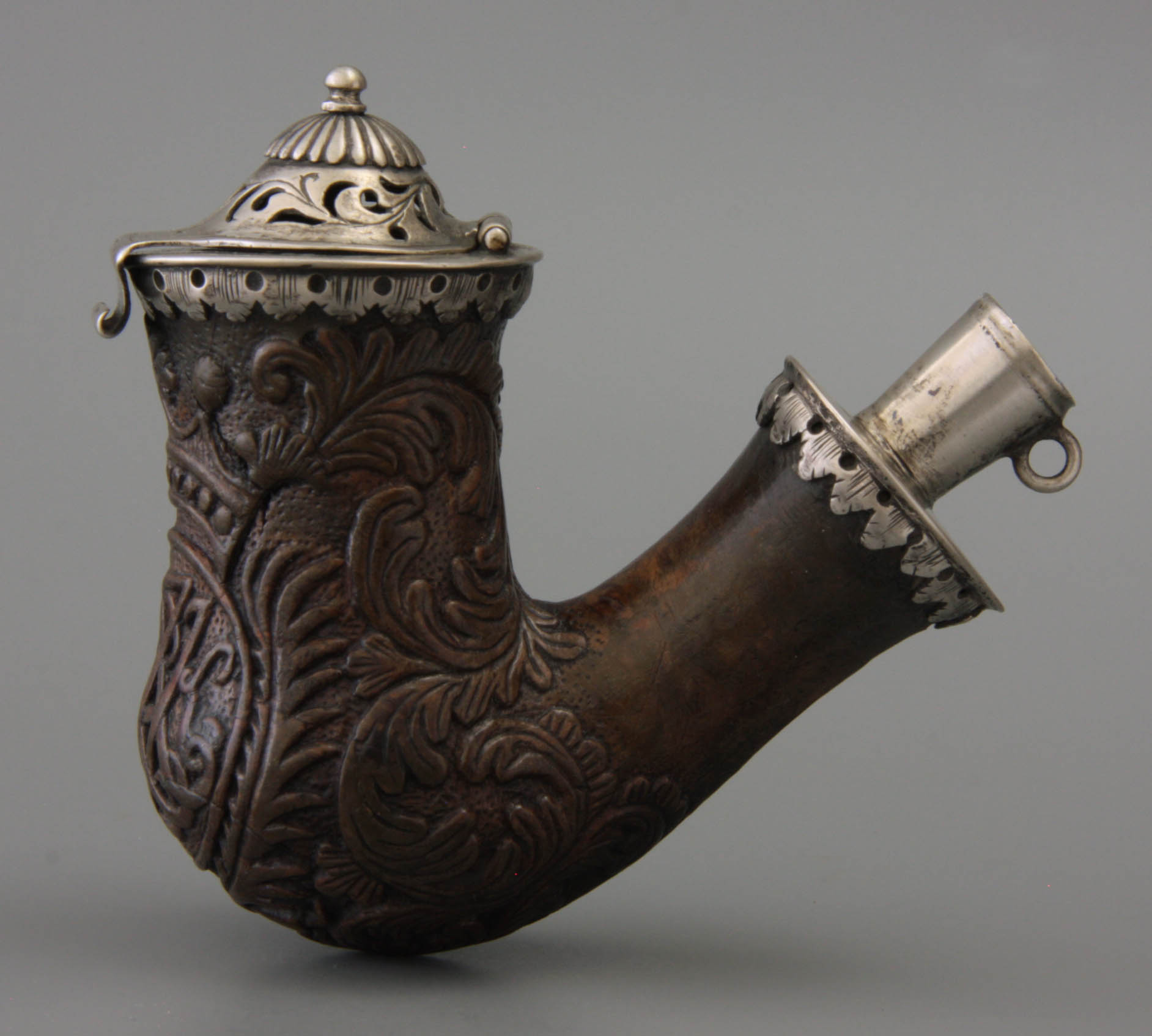
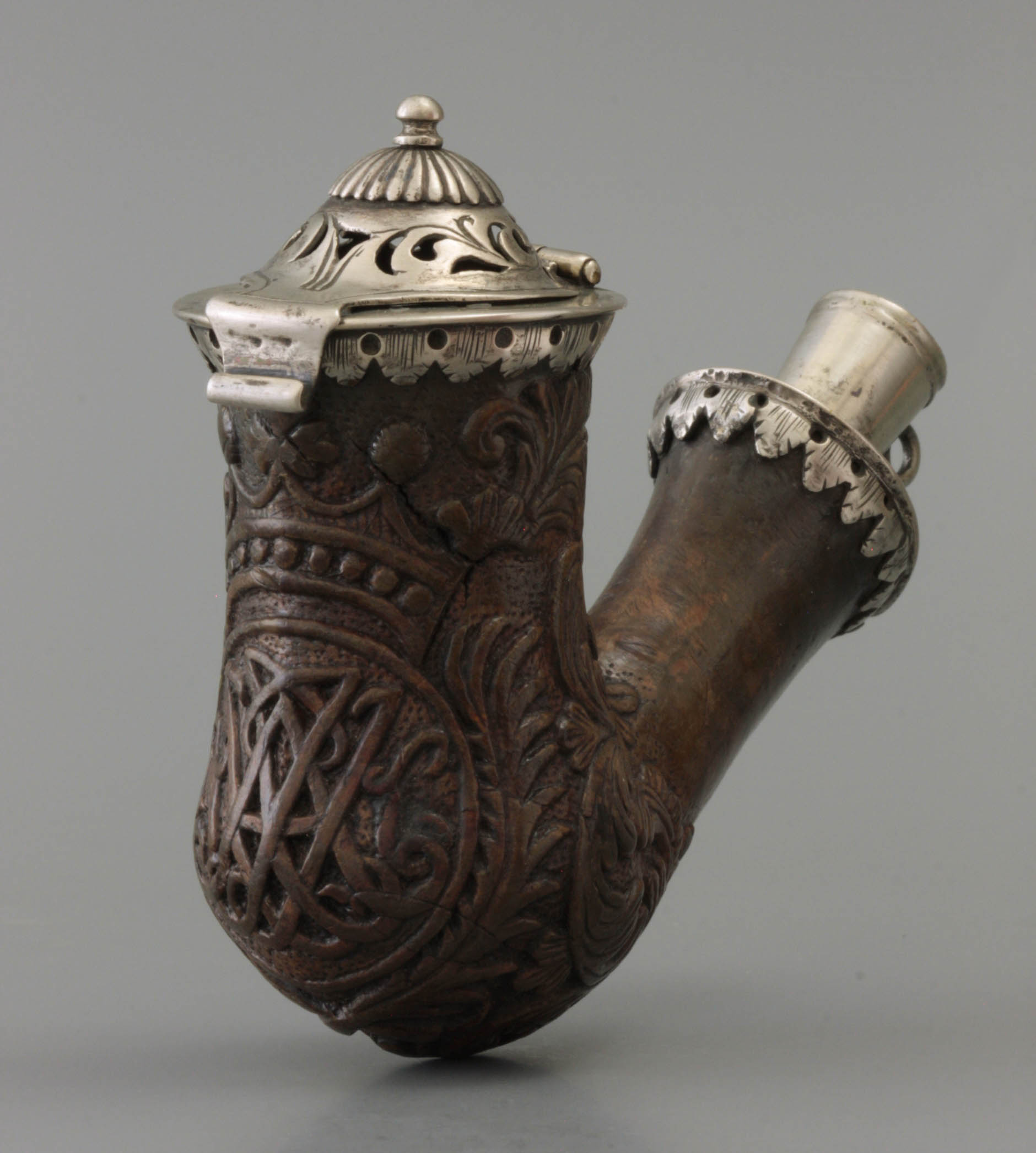
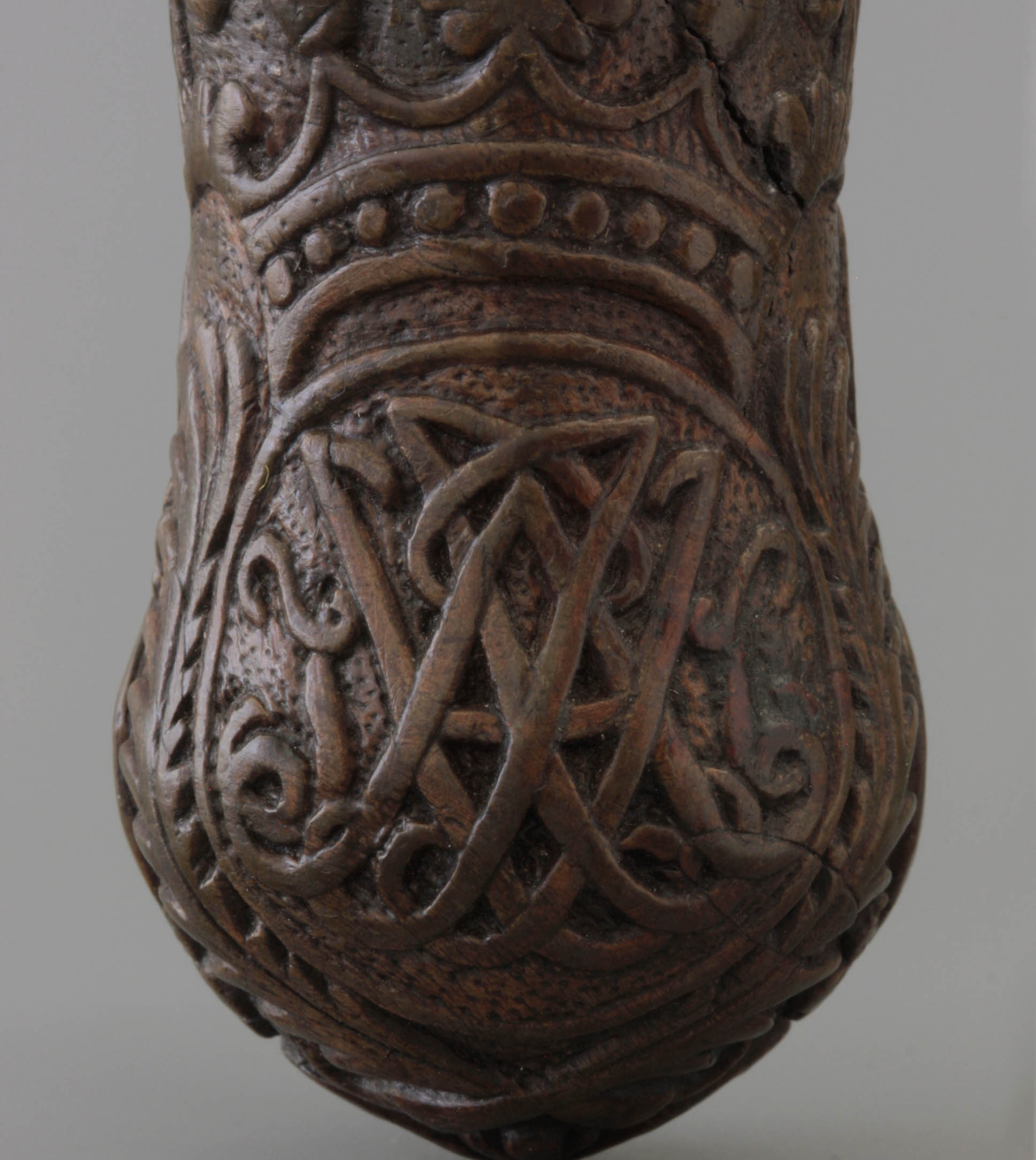
All around the bowl this wooden pipe bowl is embellished with carving. The main motif is located on the front, placed inside a crowned circle. It shows a mirror monogram consisting of the letters J and A artfully intertwined, both plain and mirrored. This created a beautiful balanced contour that was loved in the period of Louis XIV. The medallion itself is again framed by two palm branches, the symbol of honour. The rest of the pipe bowl is decorated with curled foliage that looks most like acanthus. These leaves are evenly spread over the surface, continuing to the stem.
Such a beautifully carved wooden pipe was regarded as luxury smoking equipment at the time. Completely in style they were provided with a silver mounting. The hinged cover on the bowl was more or less standard for central European pipes. It’s dome-shaped cap with button on top of a circle of flowerlike lobes, shows asymmetrical openwork sawing. The stem end has the same silver fitting, which gives greater strength when mounted on a separate stem. A locking eye serves for secure attachment to this detachable stem. Both mountings are fixed with a sawn edge of leaf motifs that fold over the wooden bowl. In order to appear true to nature, these leaves are engraved with a few engraving stitches.
Given the skill of the carving, this is a regular product, made in series by a pipe maker who understood his métier. Because of the mirror monogram, however, it appears to be an object with a personal accent, made on special order. This monogram does not have to be from the smoker himself, who ordered the pipe. It also happened that a pipe was donated as a gift and that the initials of the donor were cut out. In both cases, however, it is the monogram of the client. The person behind the initials will never be traced.
It is difficult to assign a date to this pipe. The shape was already developed at the beginning of the eighteenth century, the fitting seems to be of a somewhat later date. That could argue for a date between 1730 and 1750. Based on the fact that the pipe industry was often very traditional, such a pipe bowl could even have been made up to fifty years later. Yet it does not seem that way, because, inevitably, in that case a few later style features would have crept into the decoration. We assume that the place of production must have been Germany, although it is not possible to specify where.
Amsterdam, Pijpenkabinet collection Pk 16.716
As curious as meritorious
With some pipes, the maker loses sight of the purpose of use and is focussing exclusively on the design. That seems to be the case with this wooden tobacco pipe whose bowl is shaped as a sitting owl and the moisture reservoir represents another bird. If one is not very keen on decorating and figuration, this is an abomination. On the other hand, anyone who has carved a figure out of wood himself shall realize how much craftsmanship is in this pipe and how original the design is.
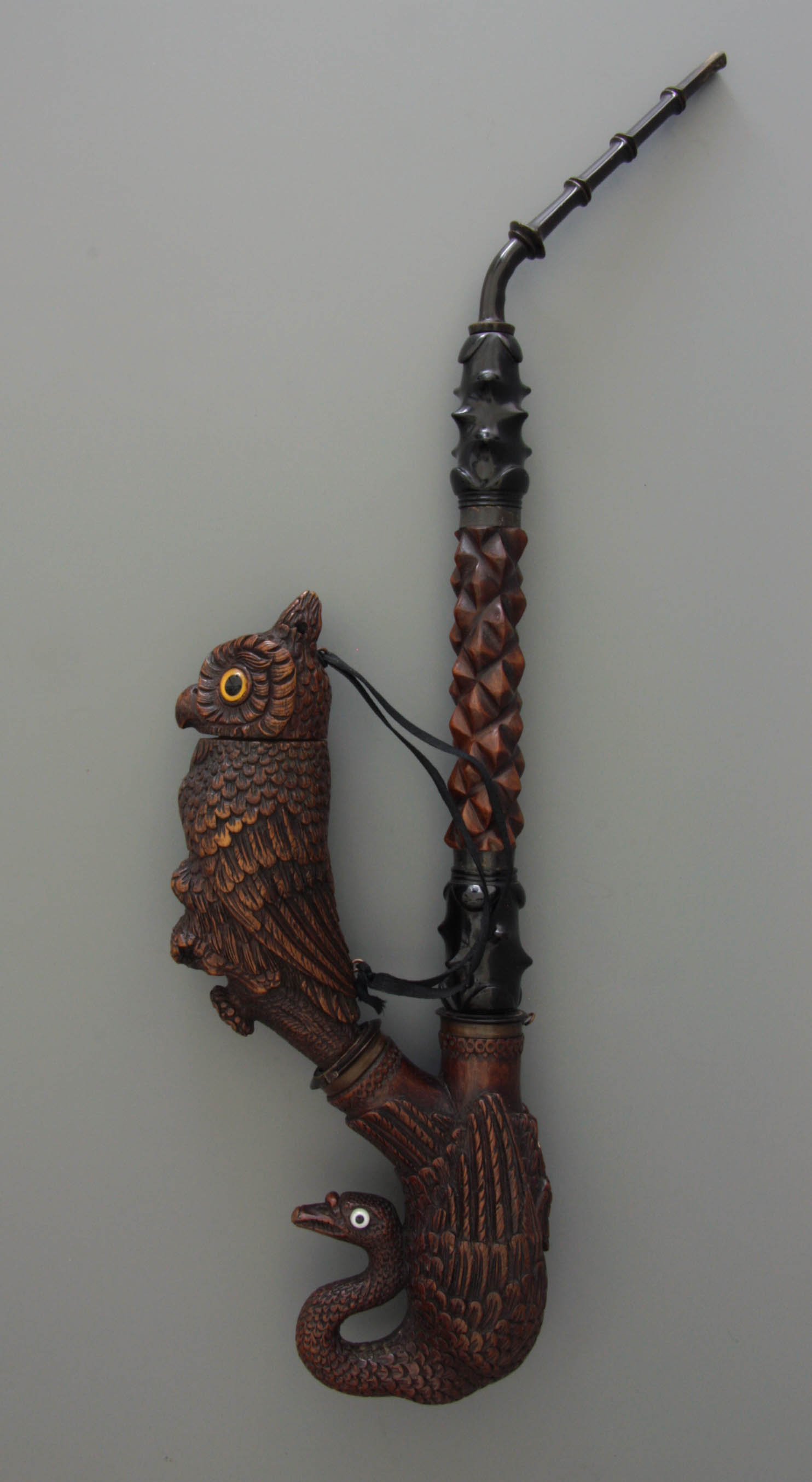
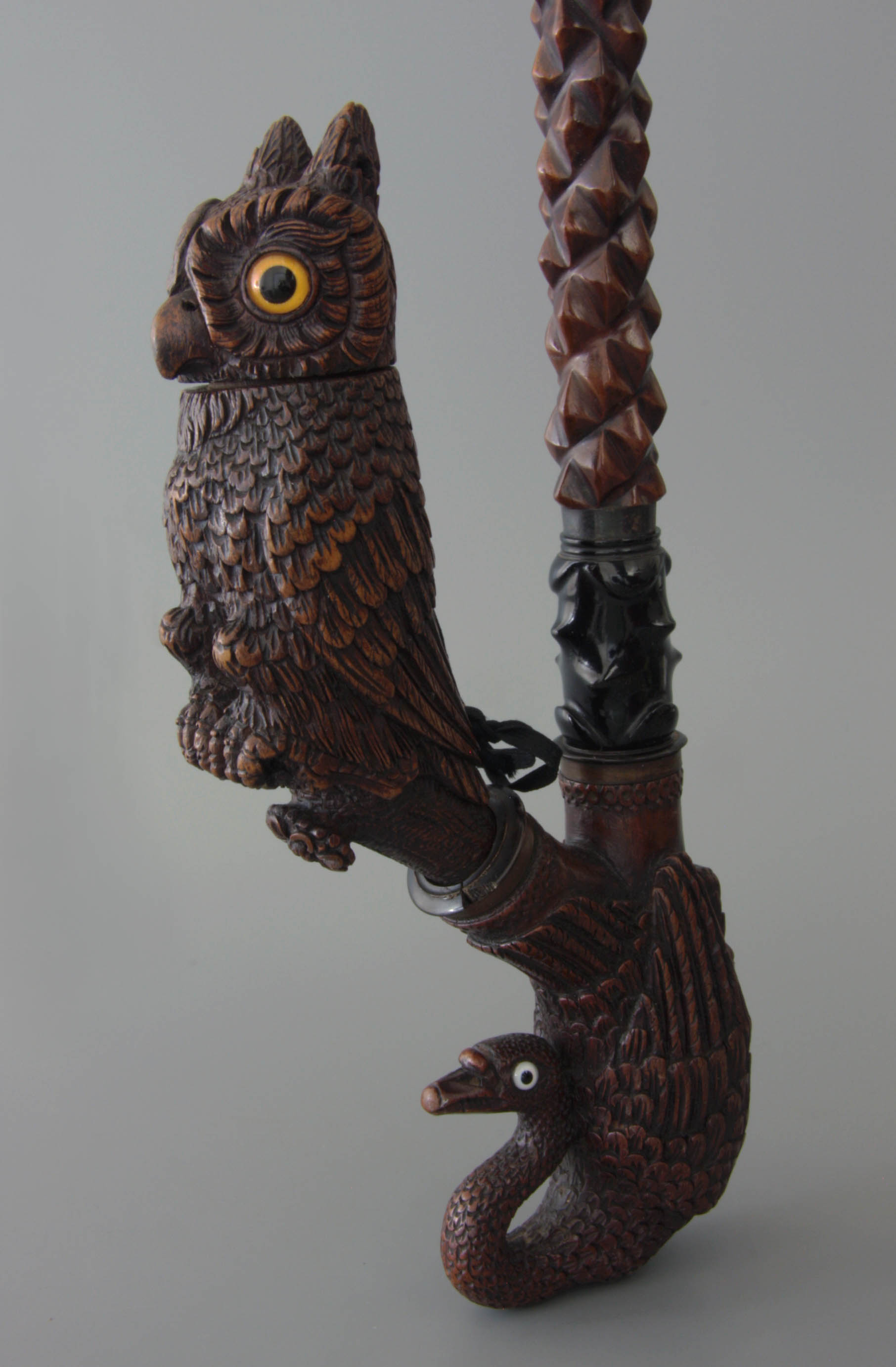
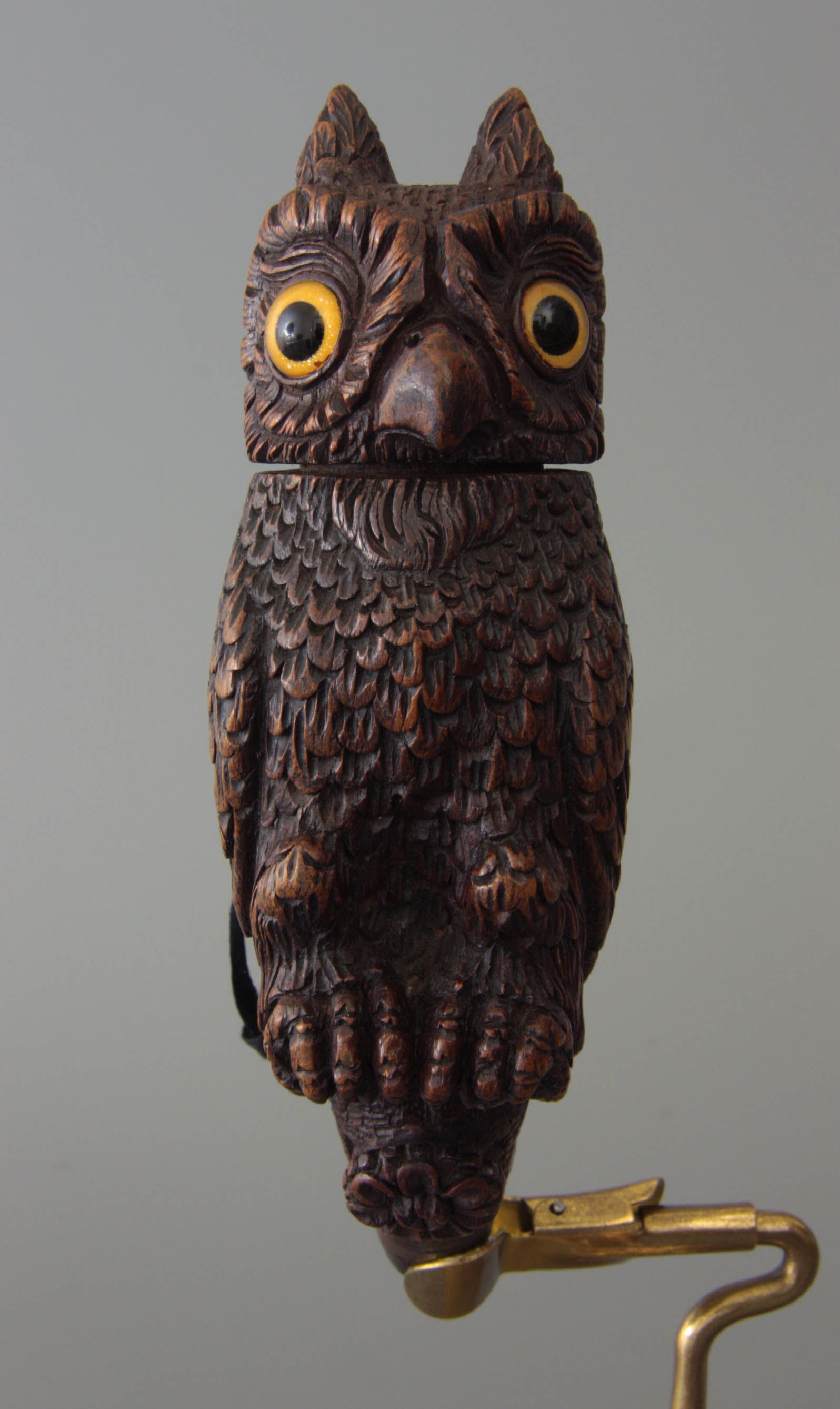
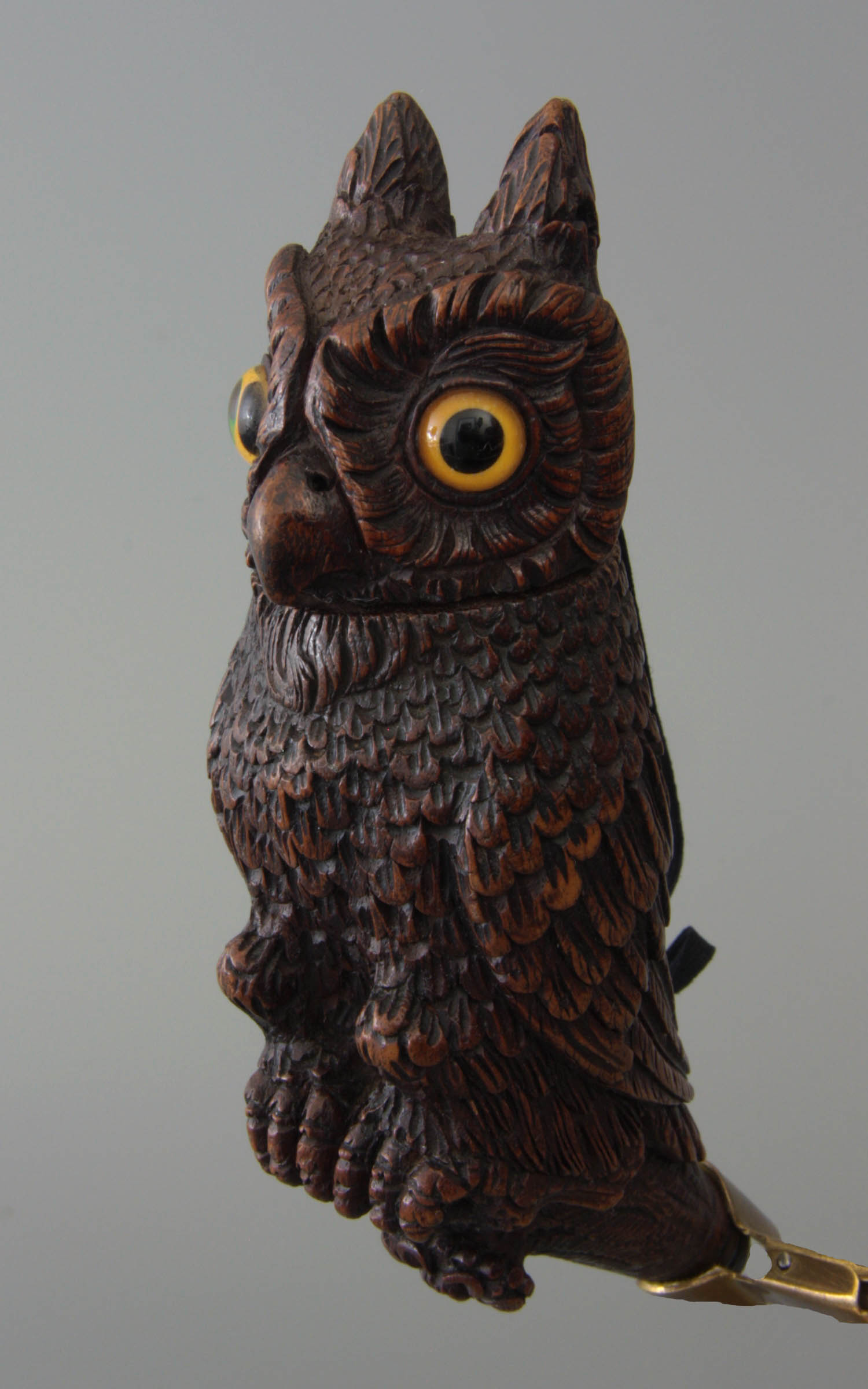
Let’s look at the pipe bowl: it follows the usual oval bowl shape, customary for that period and is equipped with a lid as is common in most German pipes. However, the design of a sitting owl is very convincing because the animal exudes the patience and dignity typical for an owl. The pattern of the feathers has been cut out in detail with the utmost care. Very appropriately, the air holes for the lid are quite inconspicuously hidden in the nostrils in the beak of the animal. By adding glass eyes, he gets the sympathetic look of a toy animal.
In the end, this pipe is completely functional. The beautiful fine wood has been doubled on the inside with a sheet-metal mantel to protect it from burning-in. The German pipe makers have been doing that since the seventeenth century. In addition, the drilling to the stem and the moisture reservoir are optimal so that the pipe guarantees a good draft.
The moisture reservoir itself, also a standard part of the German Gesteckpfeife, is designed in a less natural way. The decoration follows the usual bag shape so that the swan with its long neck gets a quite artificial posture. Did the creator attempt to express that the swan had fallen into the claws of the owl or did he not see a better solution for the design? Again, comparable glass eyes were added, which were considered to be more pronounced than to drill pupils into the wood.
Fortunately, the pipe was preserved as a whole with its original mounting of stem and mouthpiece. Here we see how strong the Gesamtkunstwerk (overall work of art) is. The materials including the carving of the stem fit in seamlessly with the pipe bowl. Moreover, the alternation of the brown wood and greenish-black buffalo horn is very attractive. The stem shows a rhythmic pattern of diamond shapes. The horn work, possibly made by a friendly horn turner, has the same rhythm of more sharp points. Colour and material texture provide both strong unity and an attractive contrast.
Those familiar with the design of the German pipe will see that the maker has created a beautifully balanced pipe. It has become a recognizable German Gesteckpfeife, but with an entertaining image of high artistic level. What is unfortunately missing when discussing this pipe is the exact origin. No matter how German of origin it looks, there is no clarity about the exact region of origin nor about the dating. The pipe probably looks more recent than it is. We estimate the date of creation between 1860 and 1890.
Amsterdam, Pijpenkabinet collection Pk 19.837
Pipe of the Prince of the Netherlands
Without doubt, Prince Bernhard, consort of Queen Juliana, is the most famous Dutch pipe smoker of the twentieth century. For the Prince, smoking was not only a hobby for an optimal taste experience, but also an expression of fashion and style, a part of his image, as important as his white buttonhole carnation. For the prince, his pipe became an object to flaunt, always appropriate for the occasion.
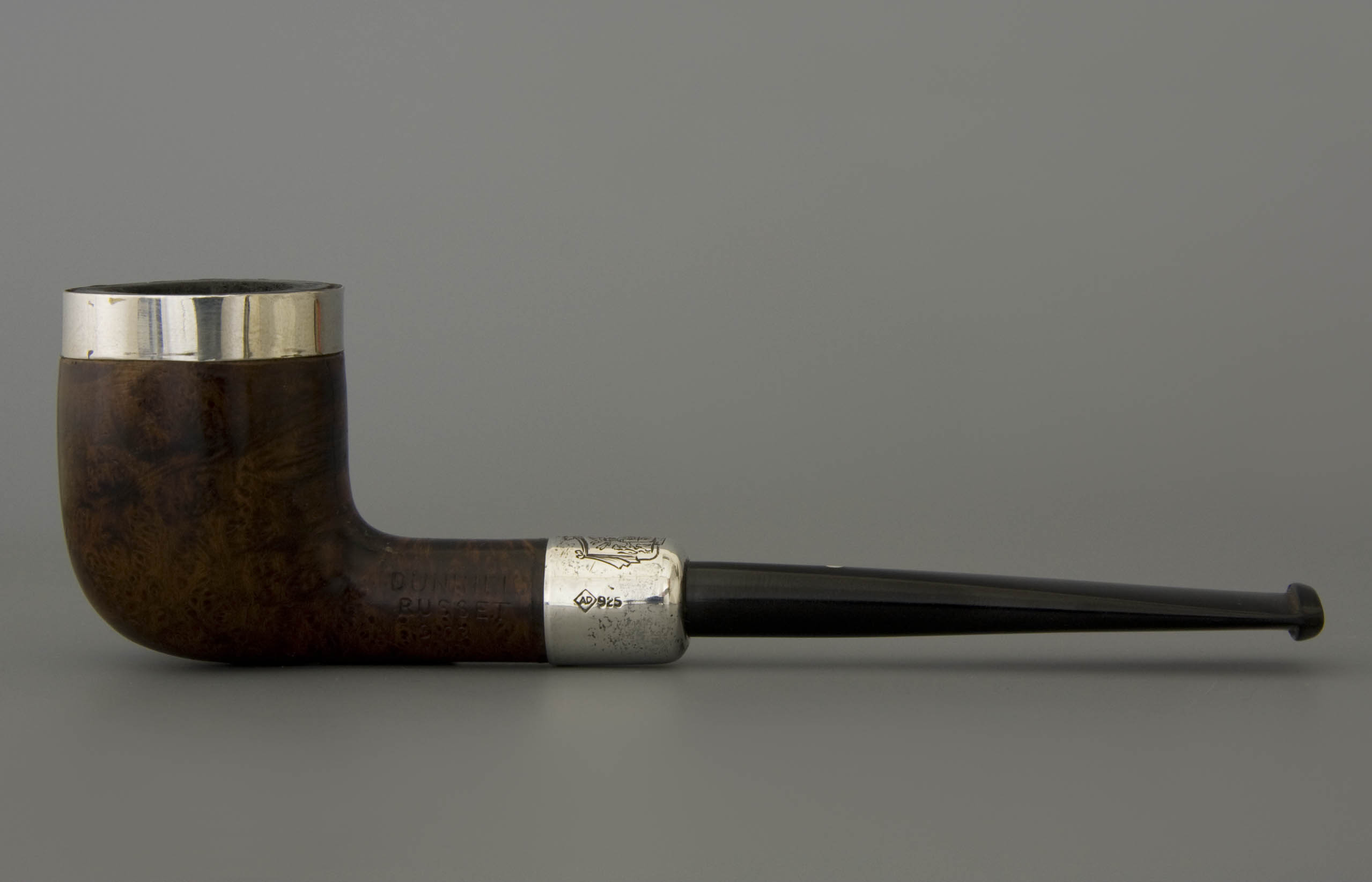
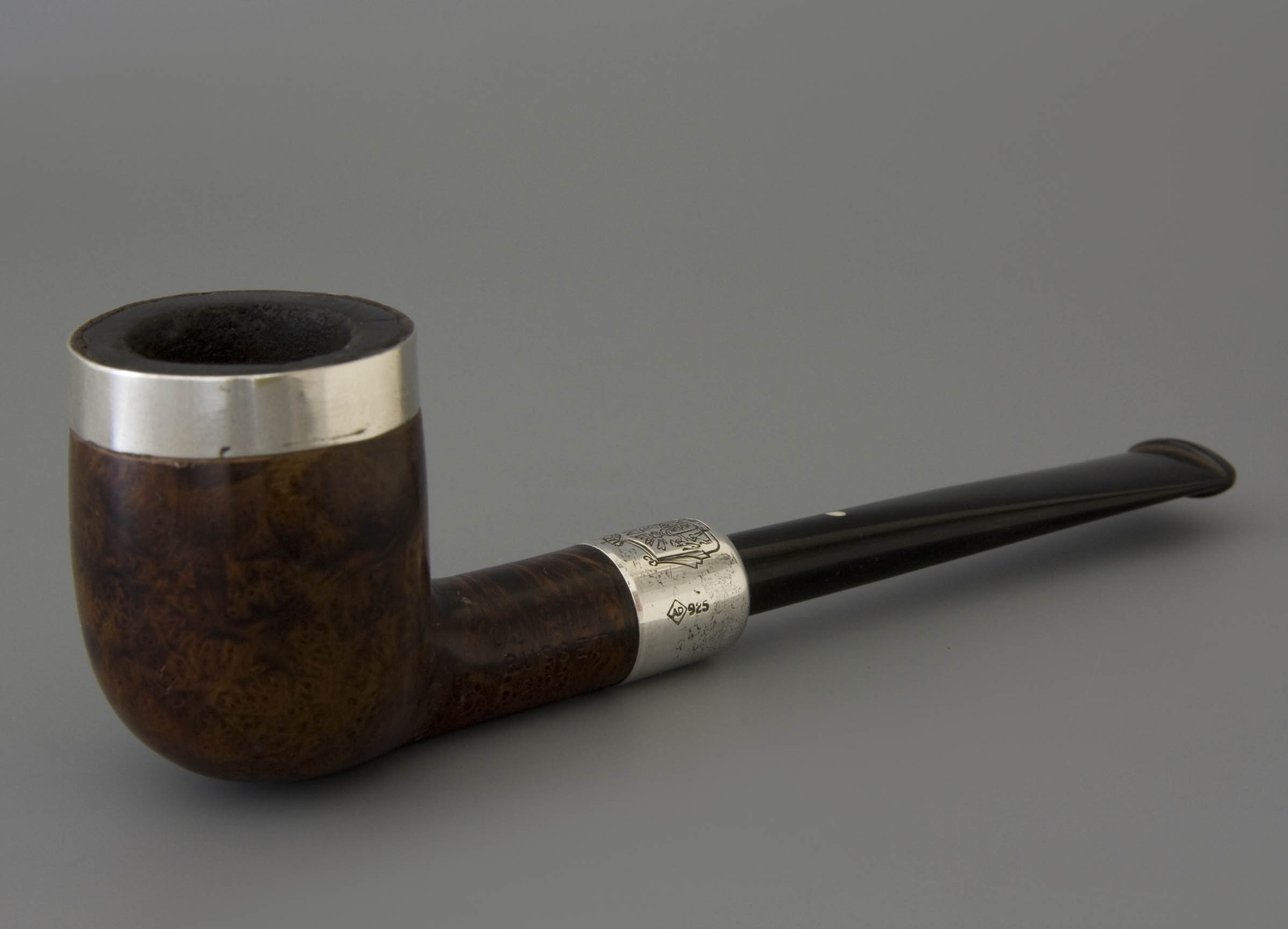
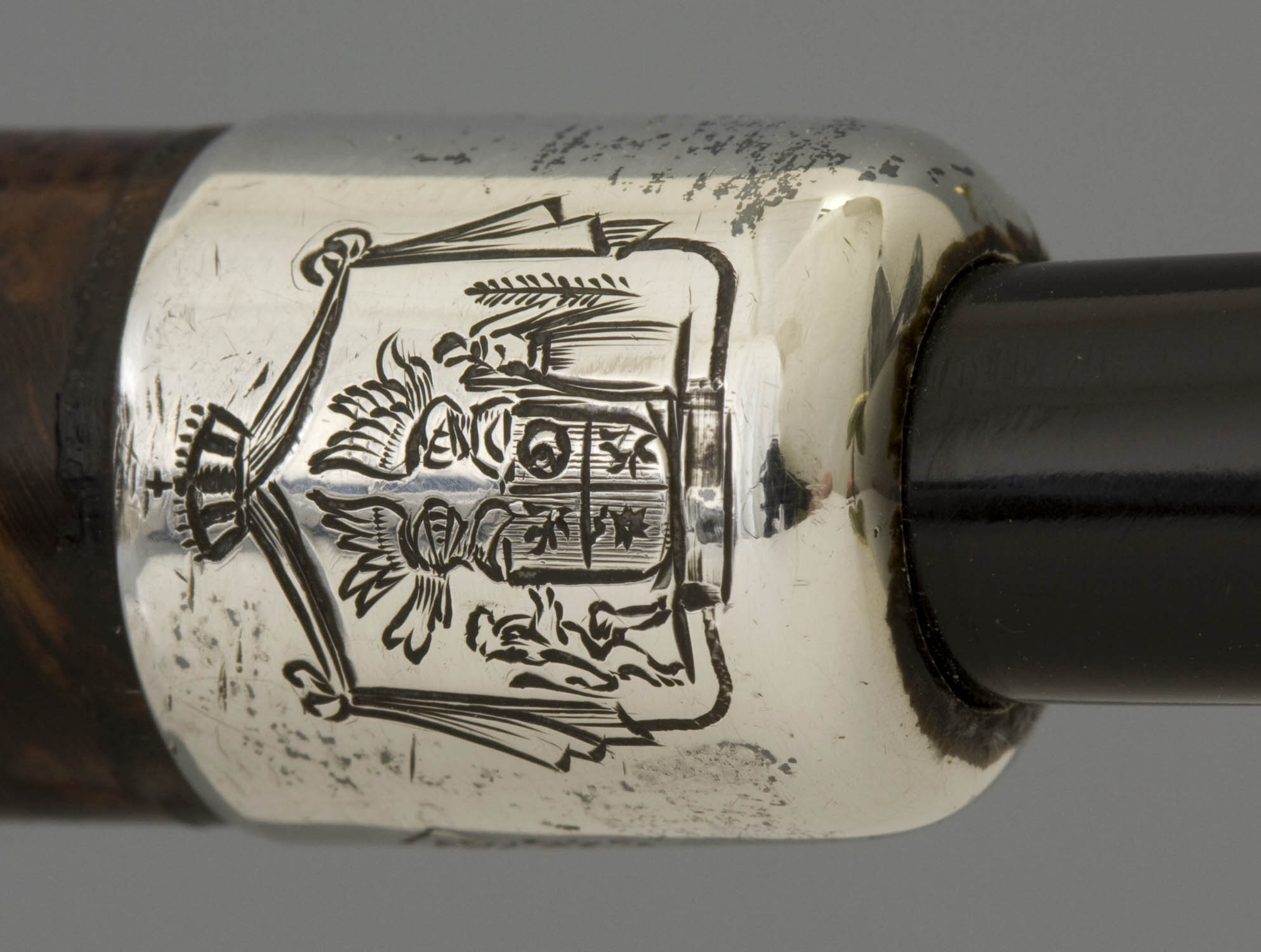
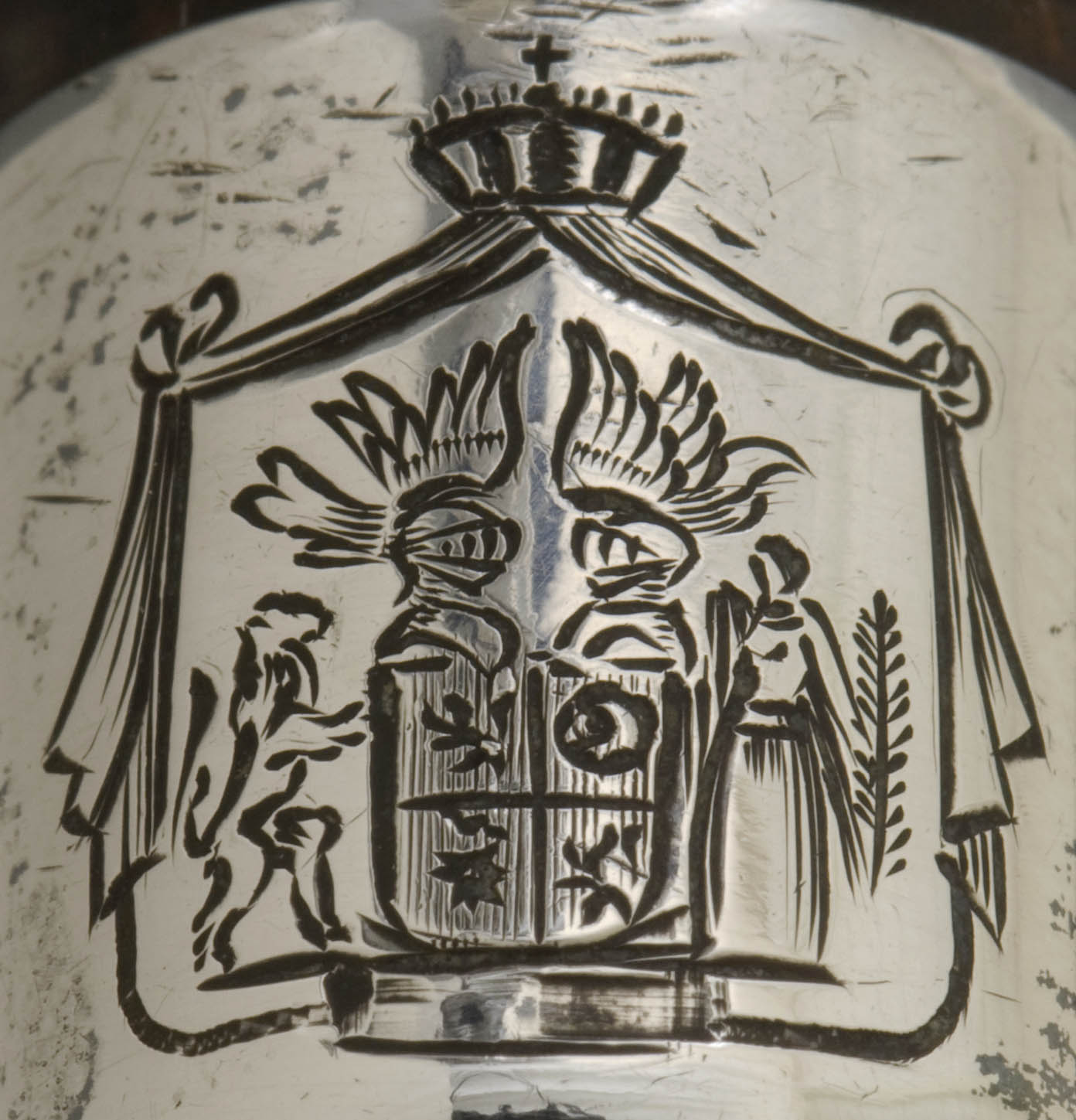
Prince Bernhard's favourite brand was Dunhill, the brand for smokers who can distinguish and hanker for quality. On many of his portrait photographs the subtle but exclusive mark of the white dot on the mouthpiece can be discerned. But a prince with panache and charm used the pipe not simply as a status symbol, but especially as a fashion accessory. At no individual one can see so well that the choice of his pipe corresponds to the clothing as it is fitting to a specific occasion. Sporty or just dressed, modest and unobtrusive or just flamboyant and extravert, the pipe goes along with all expressions, if well chosen. Especially for that choice, the prince had the discerning eye: during painting a rusticated meerschaum with gentle bend, for a gala an implacable straight dress with a modest silver band.
But a pipe is not merely an expression of fashion. It is first and foremost a commodity item, comfortable in the hand, with a bowl size that matches the cut of the tobacco and the duration of the moment of smoking. The prince bought his pipes with these criteria: inspecting the shape personally, see if they were well handeable and fit his posture. Fitting a pipe in front of the mirror was not necessary for the prince, he knew how to make his choice. Although he listened carefully to advice, he always took the decision himself.
One pipe smokes better than the other, that secret cannot be provided at purchase but the smoker has to experience that by trial and error. One of Bernhard's favourites was the Dunhill pictured here from the year 1992. An ordinary shape but a top brand. A beloved pipe because it smoked so well, but also because the Prince received this particular pipe as a gift at a personal jubilee. For that occasion the family had engraved the coat of arms of Von Lippe-Biesterfeld in the silver band around the briar stem end. Thus this pipe became even more personal than all other Dunhill’s that the prince possessed. Since then the pipe has been smoked almost to its end, until the pipe repairer even had to put a silver band around the bowl to prevent bursting. Let's be honest, even a Dunhill wears through use.
After ten years of loyal service, it was time to give the pipe a new destination. Prince Bernhard offered it to the Pijpenkabinet, accompanied by a portrait on which he is depicted with his favourite. An ode to pipe smoking but also a token of appreciation for the piece of historical work that the museum performs in preserving the culture of pipe smoking.
Amsterdam, Pijpenkabinet collection Pk 16.874
Other European pipes
A clay pipe translated in ivory
The Gouda pipe of white pipe clay has been a source of inspiration for pipe makers for centuries. The bright white colour, the outbalanced bowl shape and the extremely slender stem were admired worldwide. Unfortunately, hardly any materials can be found that makes it possible to imitate the appearance of the clay pipe. The pipe shown here deserves a price in that respect. The pipe was made by an ivory worker from Dieppe after the example of a clay pipe.
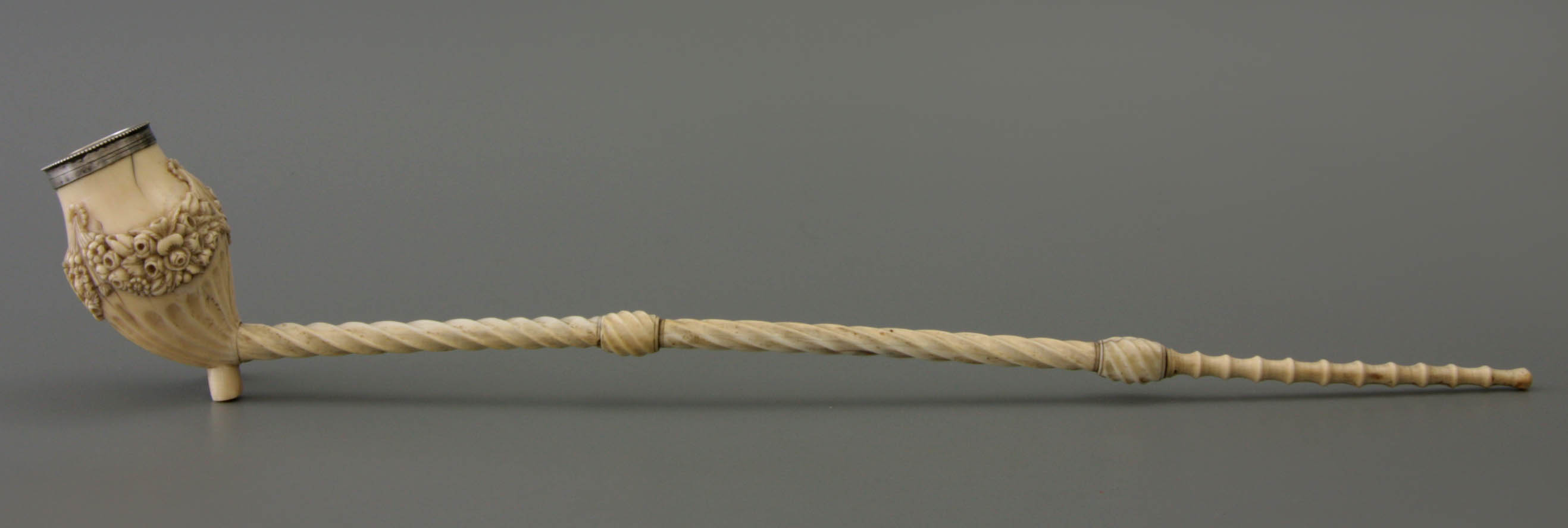
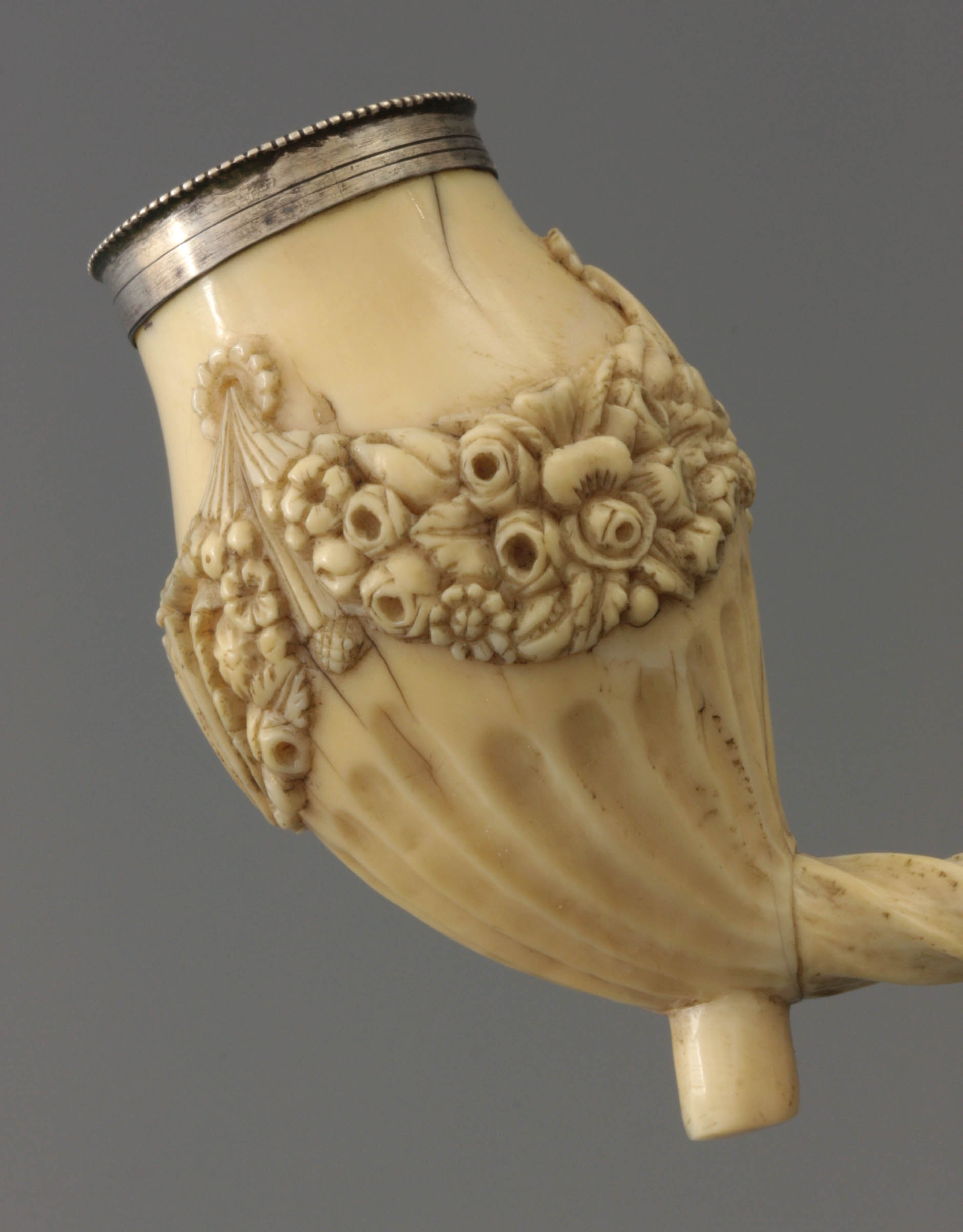
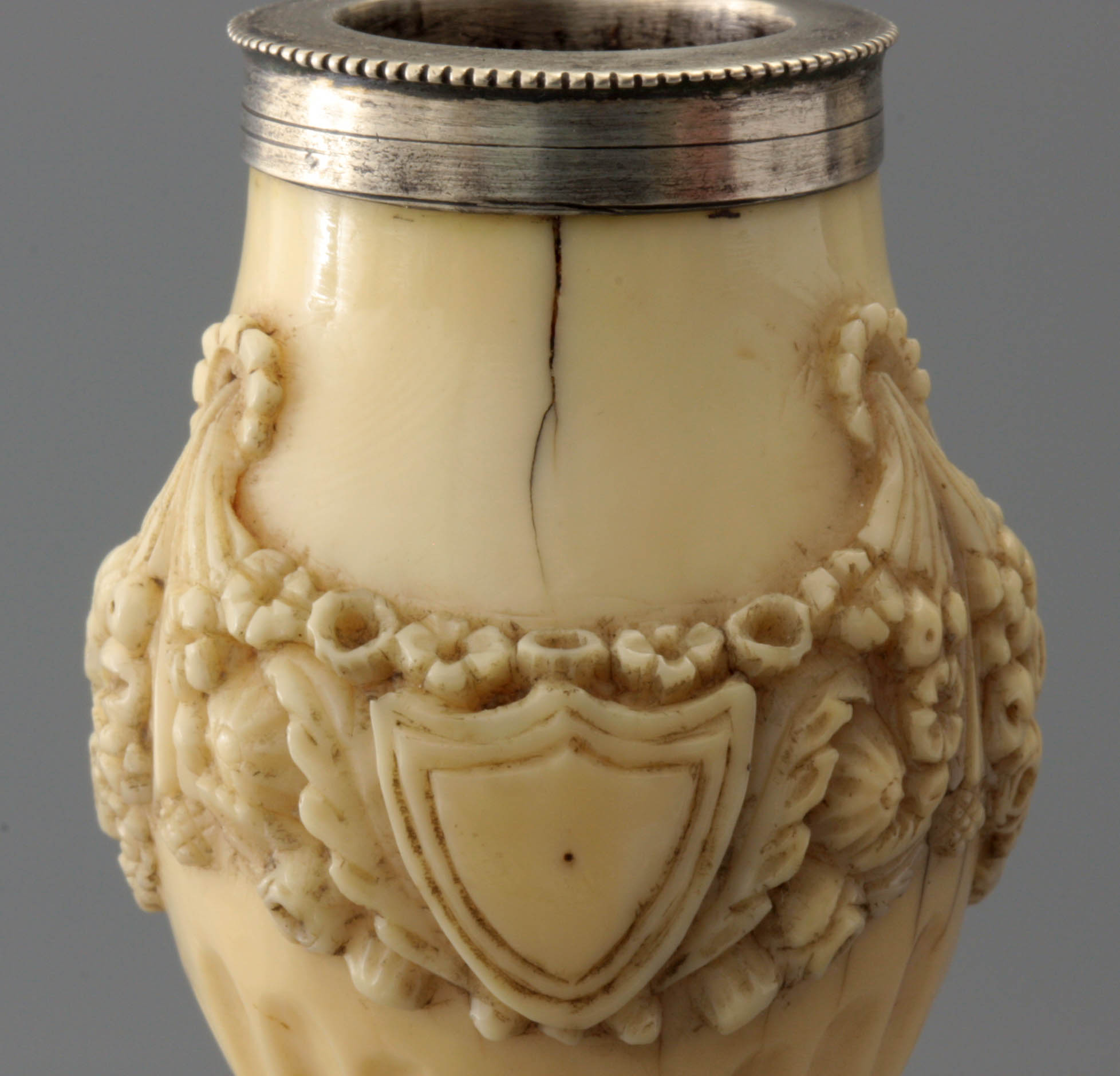
This tobacco pipe has a bowl that is inspired by the oval shape, although it is somewhat thicker and more conical. At the base the well-known heel is applied as marking to the stem transition. Thanks to the heel, the smoker could easily hang the pipe in a pipe rack. The lower part of the bowl is adorned with a band of fluted grooves, while around the belly embossed flower and leaf garlands in Louis XVI style are cut out. These tendrils seem attached to three nails. On the front of the bowl we see a heart-shaped shield, originally intended for the monogram of the smoker or the generous donor. However, this never happened. The silver ring around the bowl opening is subtly decorated with a slightly protruding pearl fillet. That ring was used to reinforce the pipe because ivory is at great risk of cracking.
Noteworthy is the twisted stem of the pipe, showing a fine regular torsion that fits perfectly with the fluting around the bowl base. The two buttons as spacers conceal a threaded tab that makes it possible to disassemble the pipe in three pieces. This work is characteristic of ivory turners who had no trouble building objects from different parts and attaching them tightly with screwing tabs. The stem end of the pipe is formed by a thin mouthpiece with ten buttons. The test of time caused the stem of the pipe to gradually show a vague bend. The tension in the tusk made the stem too large and caused a slight deviation to the right. We cannot blame the maker for such a problem after more than two hundred years.
For whom would the pipe be made? The exclusive creation of rare material with so many hours of craftsmanship must have been a precious object. Probably this pipe was meant as a display piece, put on view to impress guests. The pipe is not misplaced in the tradition of the Kunstkammer, where collections of exclusive ivory work were always present. It is less likely that this pipe was intended as pipe du nouveau marié, as has been suggested. The use to offer a pipe to the groom was also known in France and it seems logical that sometimes a special pipe was made. This specimen, however, is of too great a luxury for the rather vulgar wedding feast.
All in all, this ivory pipe is a wonderful attempt to recreate an object from another material. Whether the alternative ivory is technically successful, you may wonder. Dental material is not very suitable for smoking: it hardly absorbs and is also not heat resistant. In the hands of a fiery smoker, cracks will soon appear in his pipe. However, the material is beautiful and especially desirable because of its rarity. Ivory pipes are therefore made on occasion, but it seems that they are always single pieces. No matter how perfect the technique of this specimen is, there will have been no question of regular production. It was certainly the intention of the wealthy customer that his ivory pipe should remain a most exclusive possession.
Amsterdam, Pijpenkabinet collection Pk 19.828
A tobacco pipe wrapped in silver
Meerschaum is the most suitable of all materials for smoking pipes. It absorbs moisture, is lightweight and therefore enjoyed great prestige. Not surprising, therefore, that the nobility liked to smoke from a meerschaum pipe. Nevertheless, for some smokers the appearance was insufficiently prominent. We think of the most spoilt smokers. The breaking in of meerschaum was a long way during which the appearance of the pipe changed by the colouring process; that did not always look fine. By packing the pipe in a metal jacket, the appearance could be better controlled. With this tobacco pipe, this has been achieved successfully so that the appearance is more elegant than with any other pipe.
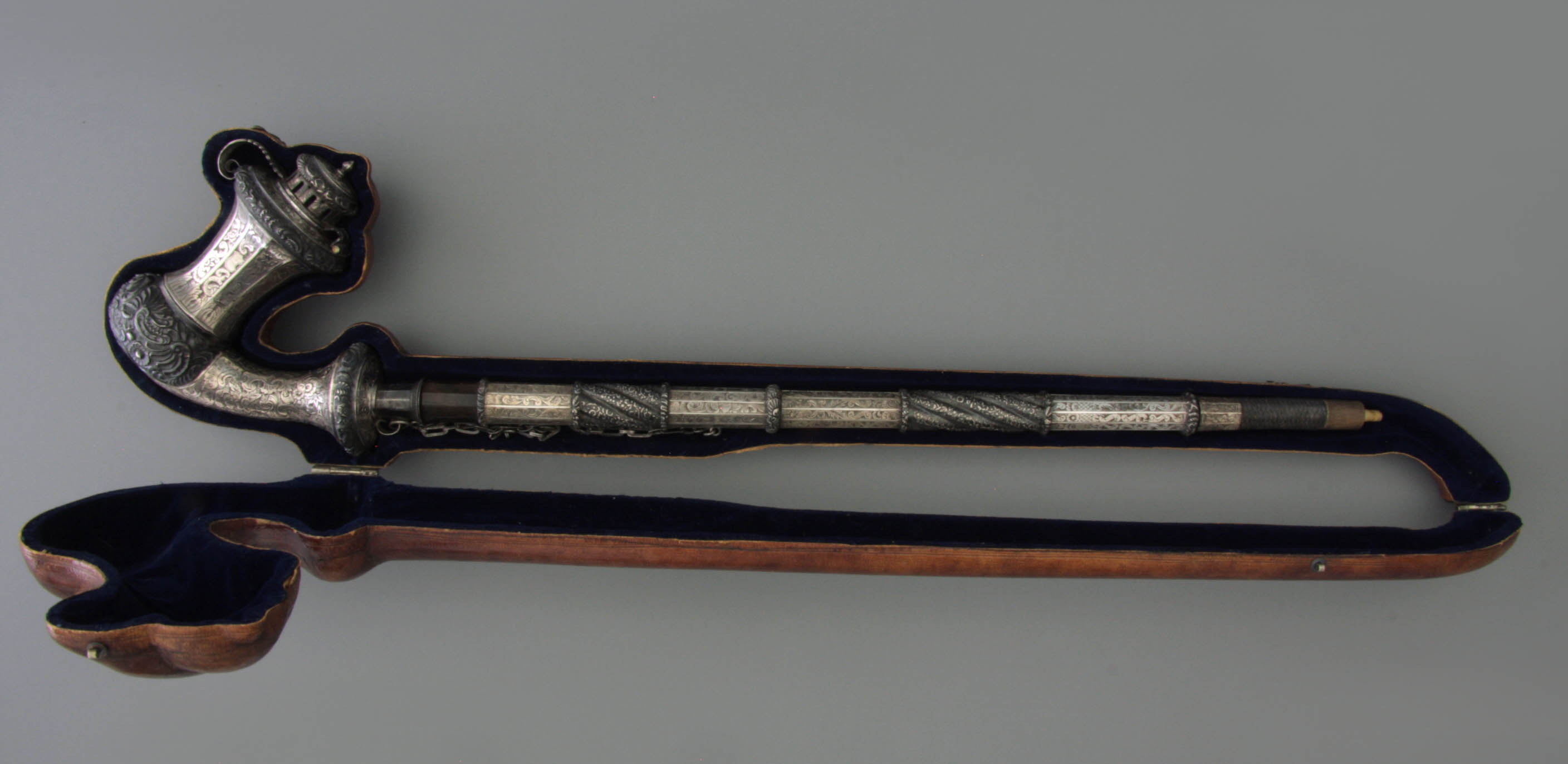
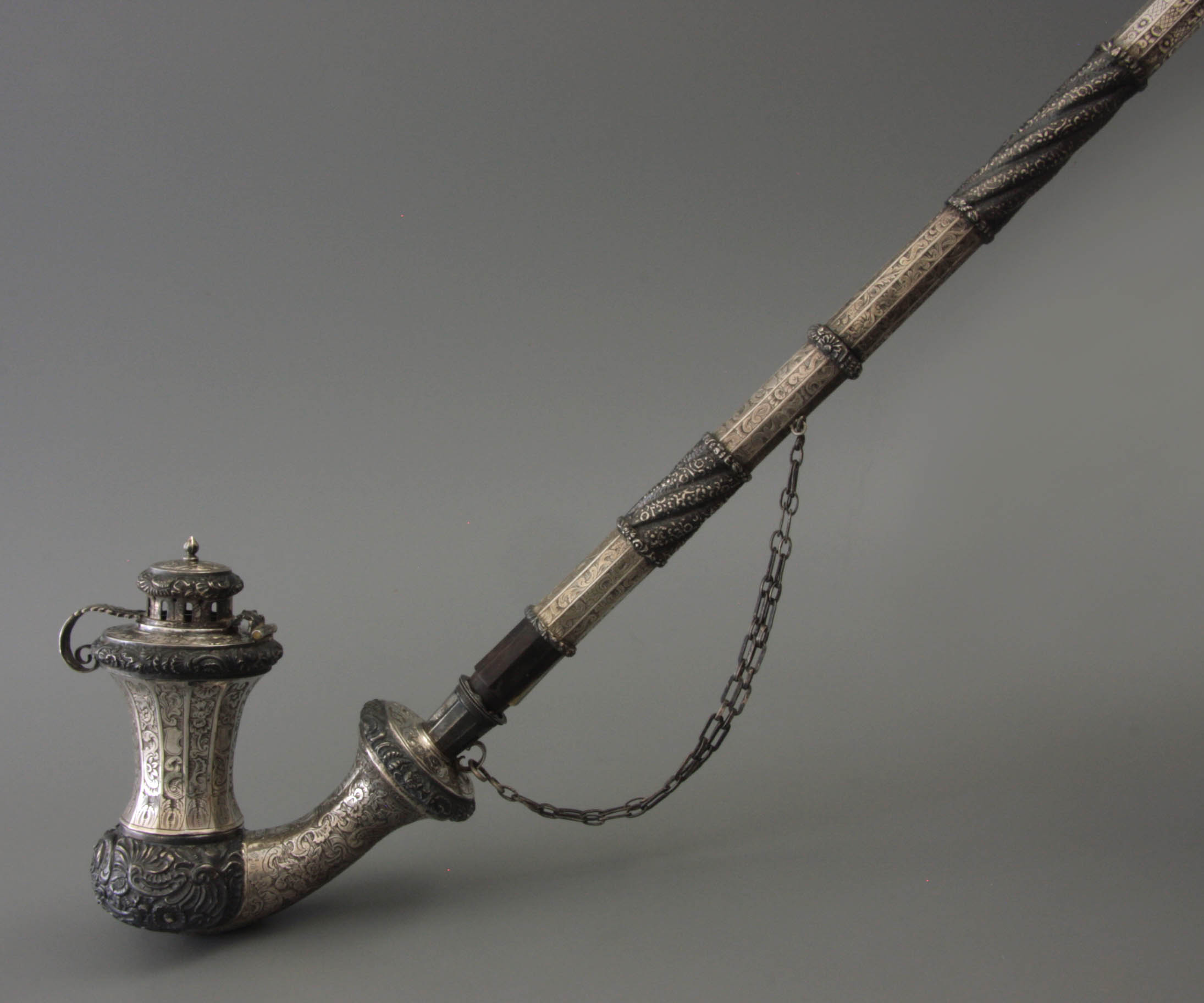
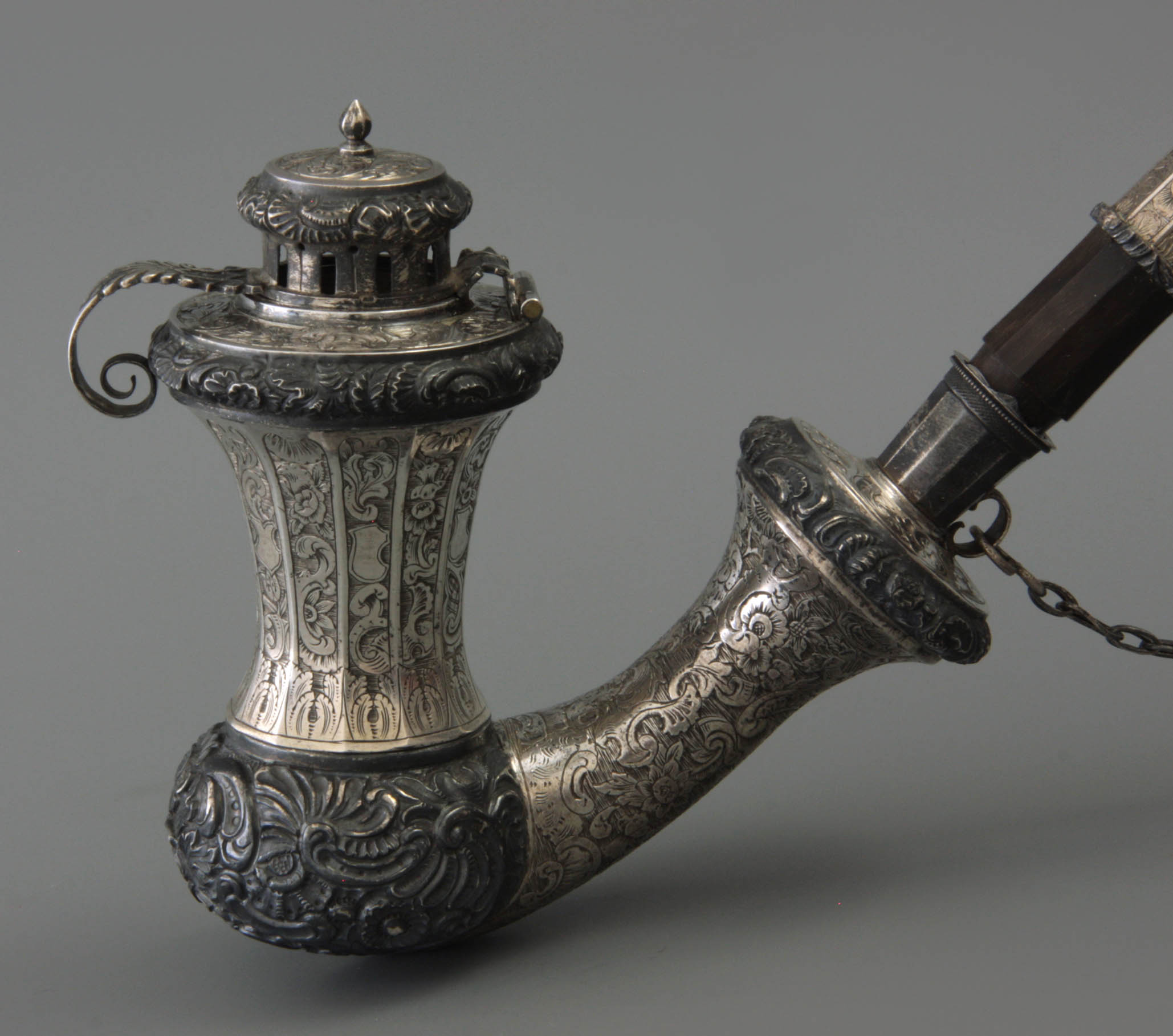
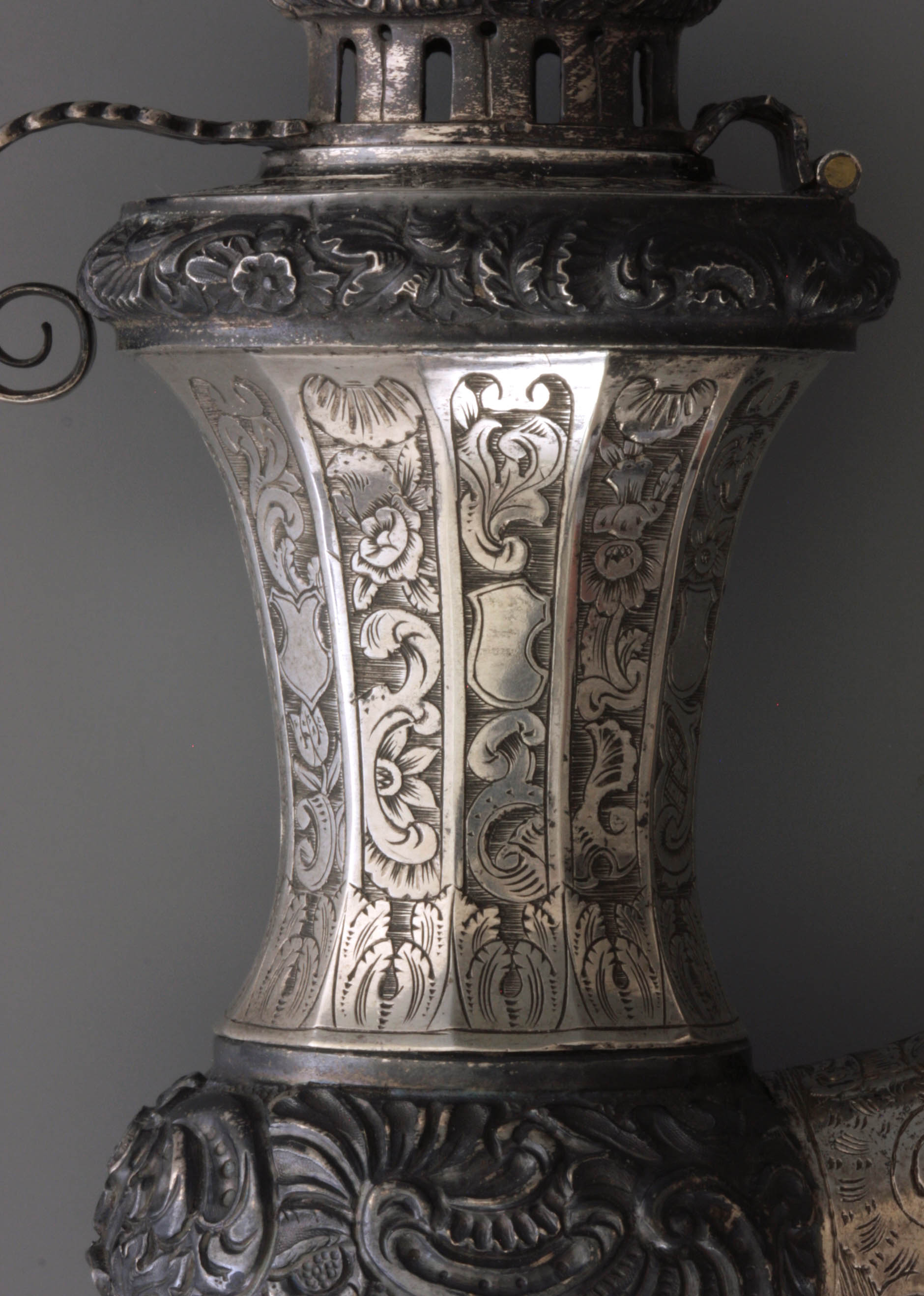
A meerschaum pipe bowl with a Turkish shaped bowl was taken as a starting point. Not a simple shape turned on a lathe, but a twelve-sided bowl with a funnel-shaped model and the characteristic bulging spherical base. Given the shape we can assume that it was a better piece of meerschaum, otherwise all the trouble to flatten the bowl into facets would not have been worthwhile. Characteristic is also the rounded rat tail along the bottom of the pipe bowl. It is therefore a pipe shape that is characteristic of Turkey, but that was copied in Hungary and Austria in large numbers, later even in Germany.
Afterwards this bowl was completely mounted in silver. Not just in a simple die-cut cover that was pressed into two or three pieces and then soldered together, but with a much more luxurious design. Sheets of silver in two different alloys with respectively embossed and engraved decorations were soldered together until an attractive rhythm emerged. Fitting in this lining, the silver hinged cover is shaped like a drum, pierced with standing slot-shaped air holes. A fine pinnacle adorns the top. And note the beautifully worked clamping spring with double curve. The motives, purely ornamental, are completely executed in neo-rococo style. This style is characterized by asymmetrical details in a symmetrical structure in which cartouches and foliage dominate. The decorations are extremely pure and perfectly detailed which makes us assume that the silversmith consulted a modelling book for the ultimate example.
The pipe is well preserved with its original stem: long, straight and also multi-sided, consisting of sections buffalo horn. Fully matching in style, this stem is also lined with silver, in alternating engraved and embossed zones. At the end of the stem is the so-called slab or flexible part, wrapped in silver wire, ending in a horn mouthpiece. That flexible part gave the smoker the comfort of a stem that follows each movement. To ensure the connection between bowl and stem, a double silver chain with elongated links runs from the stem to the bowl. This precious pipe is protected by a wooden casing, which is shaped tightly around the object, closed by two brass hooks. The exterior is covered with brown leather. Dark blue velvet is applied internally. The total length of the case measures no less than 49 centimetres.
All in all, due to its garnishing this pipe got an exceptional appearance. The labour-intensive lining in two silver alloys in two changing techniques gives the pipe a luxurious appearance, if not ostentatious. In any case, at the time it was a very valuable and, above all, unusual piece. The special case shows the same high degree of luxury. Yet it has not become the owner's favourite. However prestigious, the pipe has never been smoked. Considering its pedigree, the date must be between 1835 and 1845.
Amsterdam, Pijpenkabinet collection Pk 19.535
A tooth as a pipe bowl
Many pipes that we classify in the category other materials are made as souvenirs or as special pieces of craftsmanship. It is not about serial products, but about individual pieces with a high level of oddity and often a lower value of use. That is also the case with this pipe bowl made from a sperm whale tooth. Much carving in tooth and bone was made abroad by Western European sailors. They had the time when the ships were waiting for a favourable wind for weeks. In other cases the exotic material was taken to the home country giving birth to a small-scale industry, often in the port cities. We can no longer determine whether we are looking at foreign products or local home-made goods; the work of the patient dilettante remains the same.
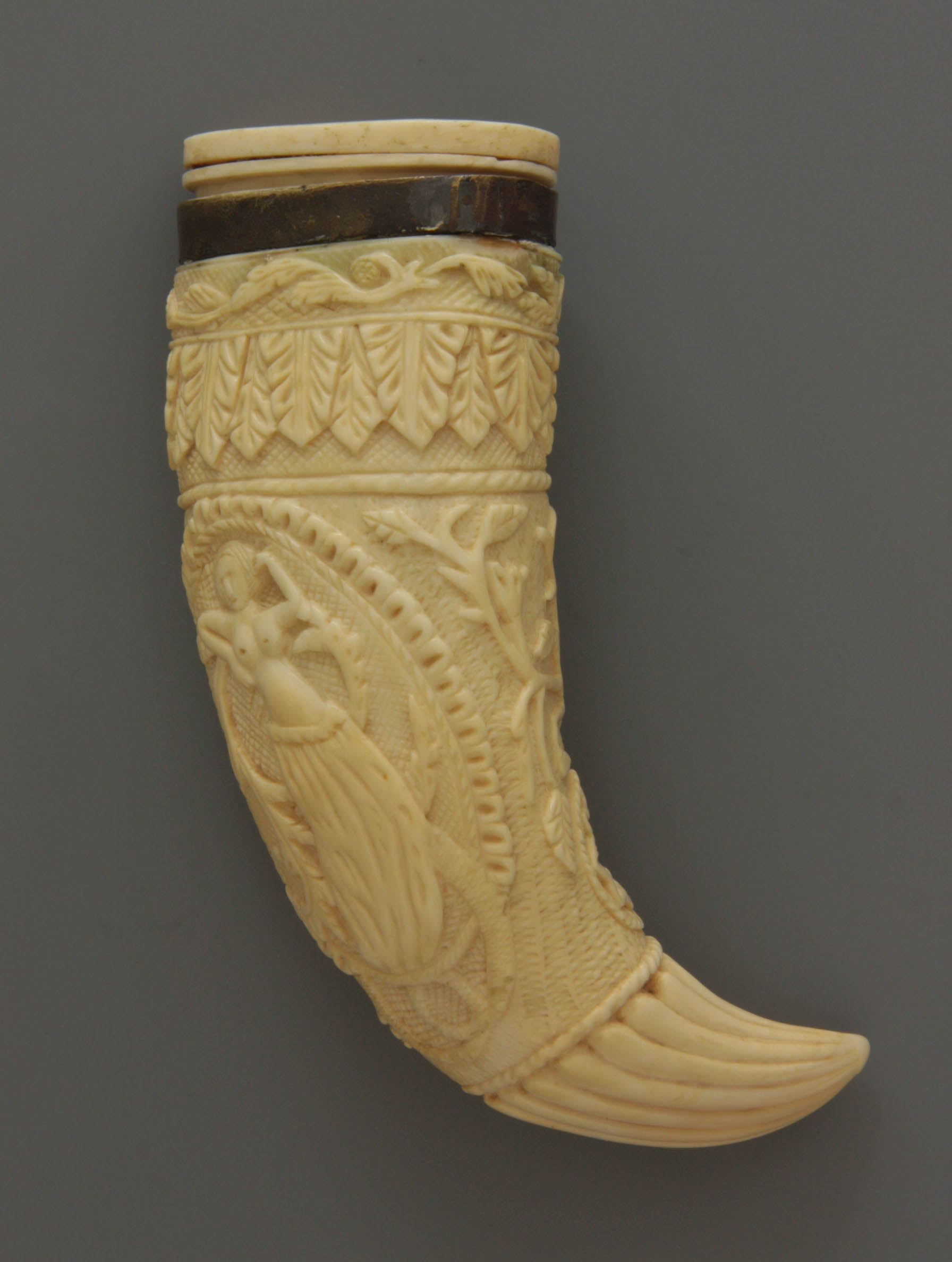
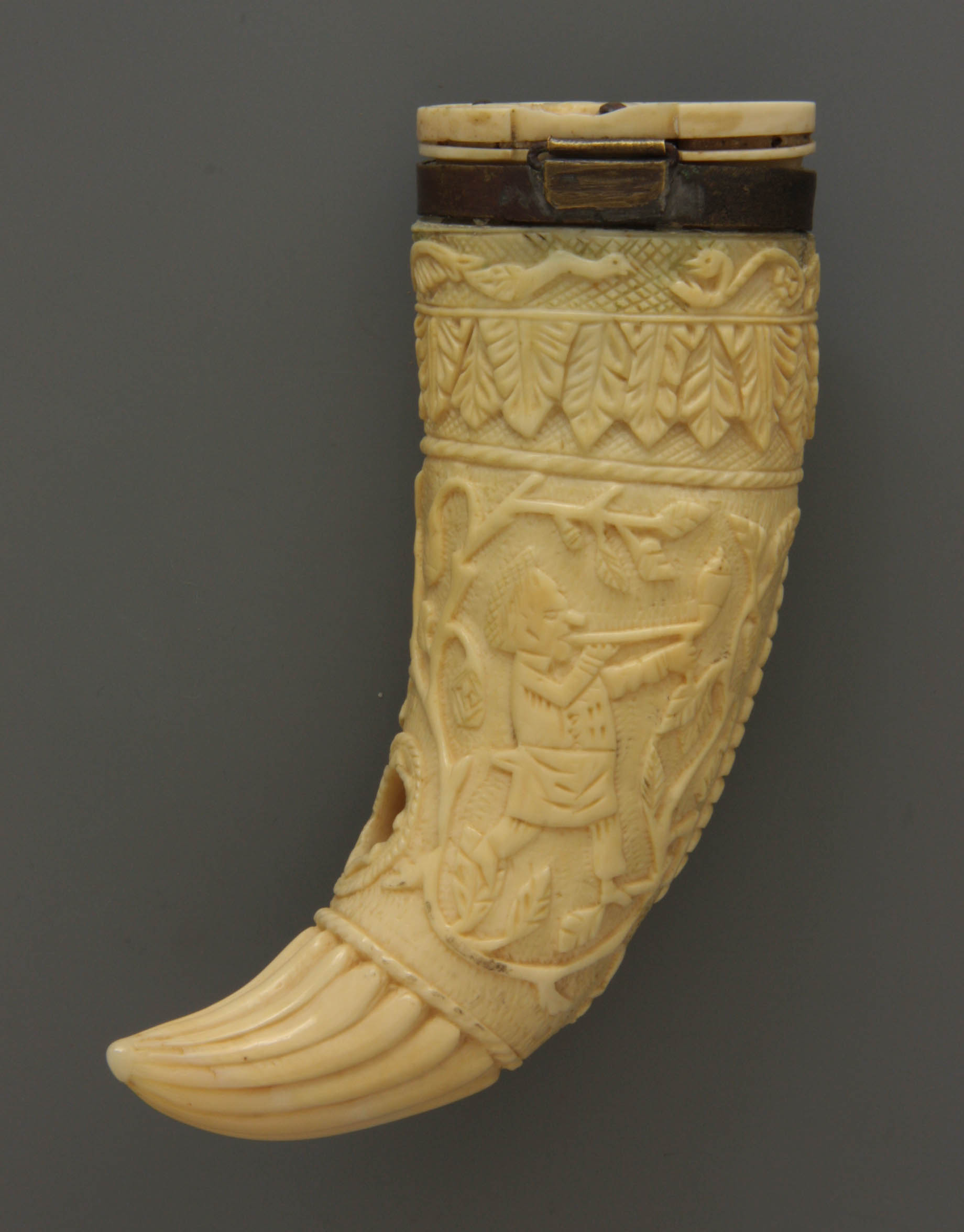

In any case, the pipe bowl depicted here is carved from a sperm whale tooth, even retaining its shape. By simply scraping out the hollow part of the tooth and sawing off the root part, the pipe bowl was created. Then it is provided with a relief decoration that runs completely around the bowl. Slightly to the left of the front we see a dancing woman with bare torso in a standing oval. On the right side a standing man with pipe is surrounded by branches with leaves. Both depictions closely connected with the life of a sailor man. Along the top edge the maker has carved a sloping tendril with leaves that end in the shape of animal heads. As filling, a ring with acanthus leaves was appropriate. The bottom of the pipe bowl, in fact the tip of the tooth, is decorated with fluted lobes.
For the stem, a hole was drilled halfway the pipe, at the base of the inner bowl. A stem of wood, bone or other material could be inserted. The bowl opening is mounted with a flat hinged cover also made of tooth material. This part is carved as well, very appropriately with a standing smoker with gun on a broad shoulder strap.
Whoever made this pipe bowl will never be known, but given the motives a maker of German origin is most likely. It is possible that the pipe originated in northern Germany, where fishing boats could easily catch a sperm-whale tooth in the northern waters, either shot or otherwise by exchange. The choice of the subject in the carving is more a reference to manufacturing during a trip than to domestic art at home. The period of creation is also rather unclear. That may be at the end of the eighteenth century but may also have occurred in the first half of the nineteenth century.
For years, this pipe bowl was the mascot for the Seita museum in Paris. As a bookmark or postcard this object has become known worldwide. Furthermore, it is also depicted in half a dozen books. In 2009 the collection of this French museum came under the hammer and this object was acquired by the Pijpenkabinet in Amsterdam. This is where the object functions as one of the bizarre examples of pipes made of special materials.
Amsterdam, Pijpenkabinet collection Pk 19.891
Bristol or Nailsea glass
No material in the world is less suitable for making pipes than glass. It is fragile by nature, does not absorb and conducts heat poorly. When the pipe is filled and lit, the chances of fracture are extremely high. Quite unexpected, numerous pipes have been made of glass. The main production centres are in England: Nailsea, Bristol and Stourbridge are always mentioned in the same breath. It is not surprising that the names of these three places are often used as a generic name for the glass pipe. However, there is hardly any evidence for this statement.
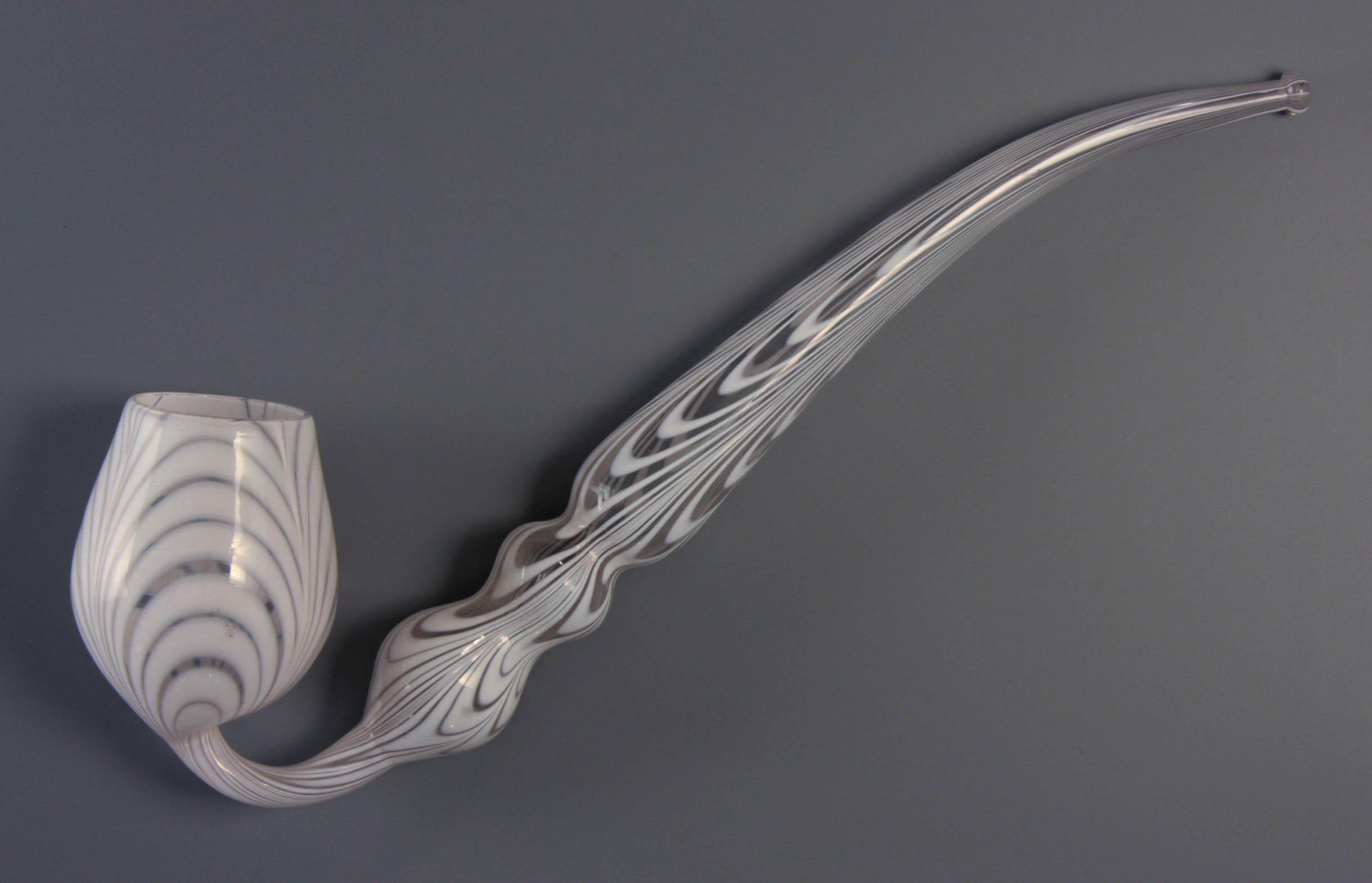
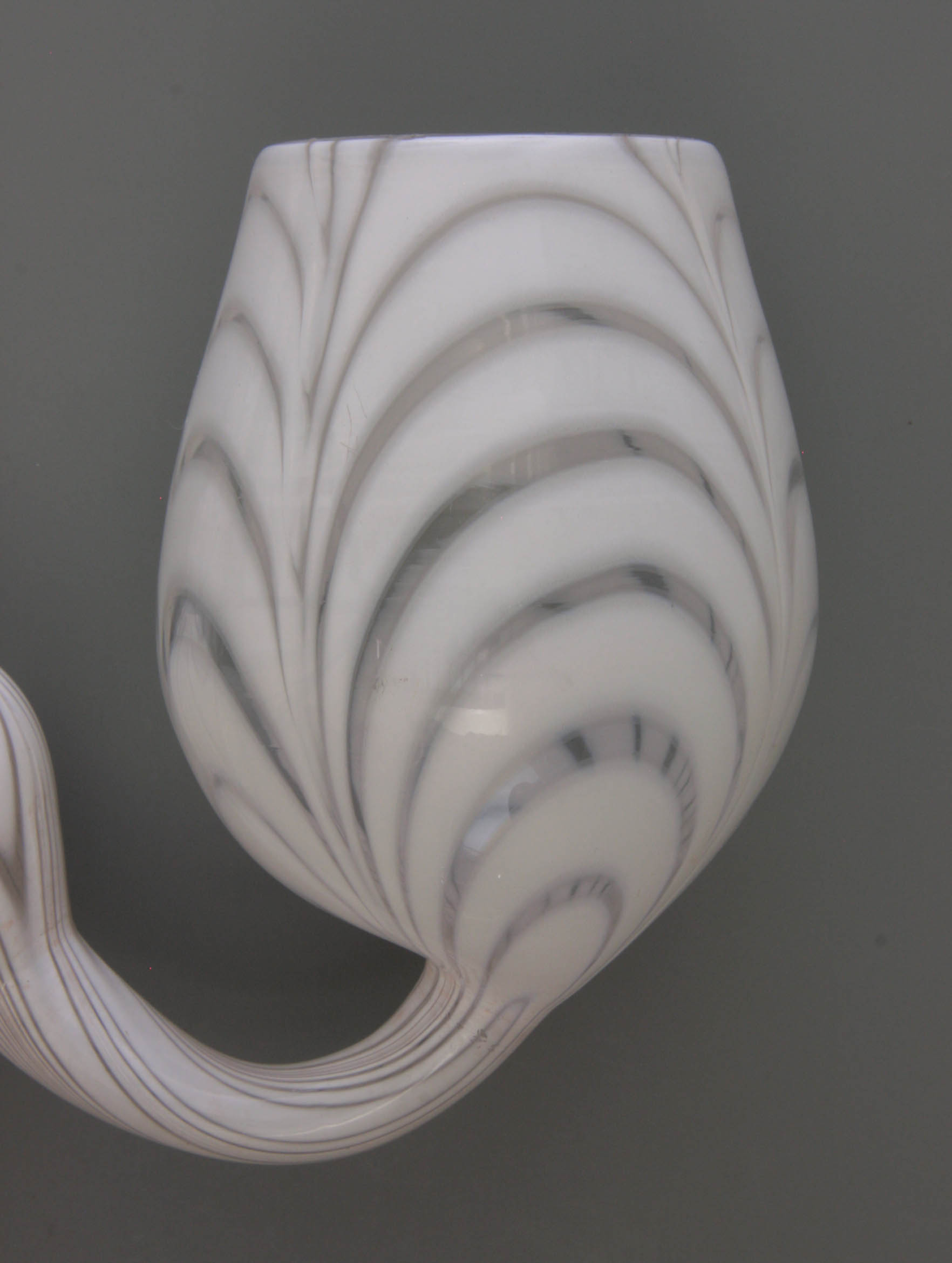
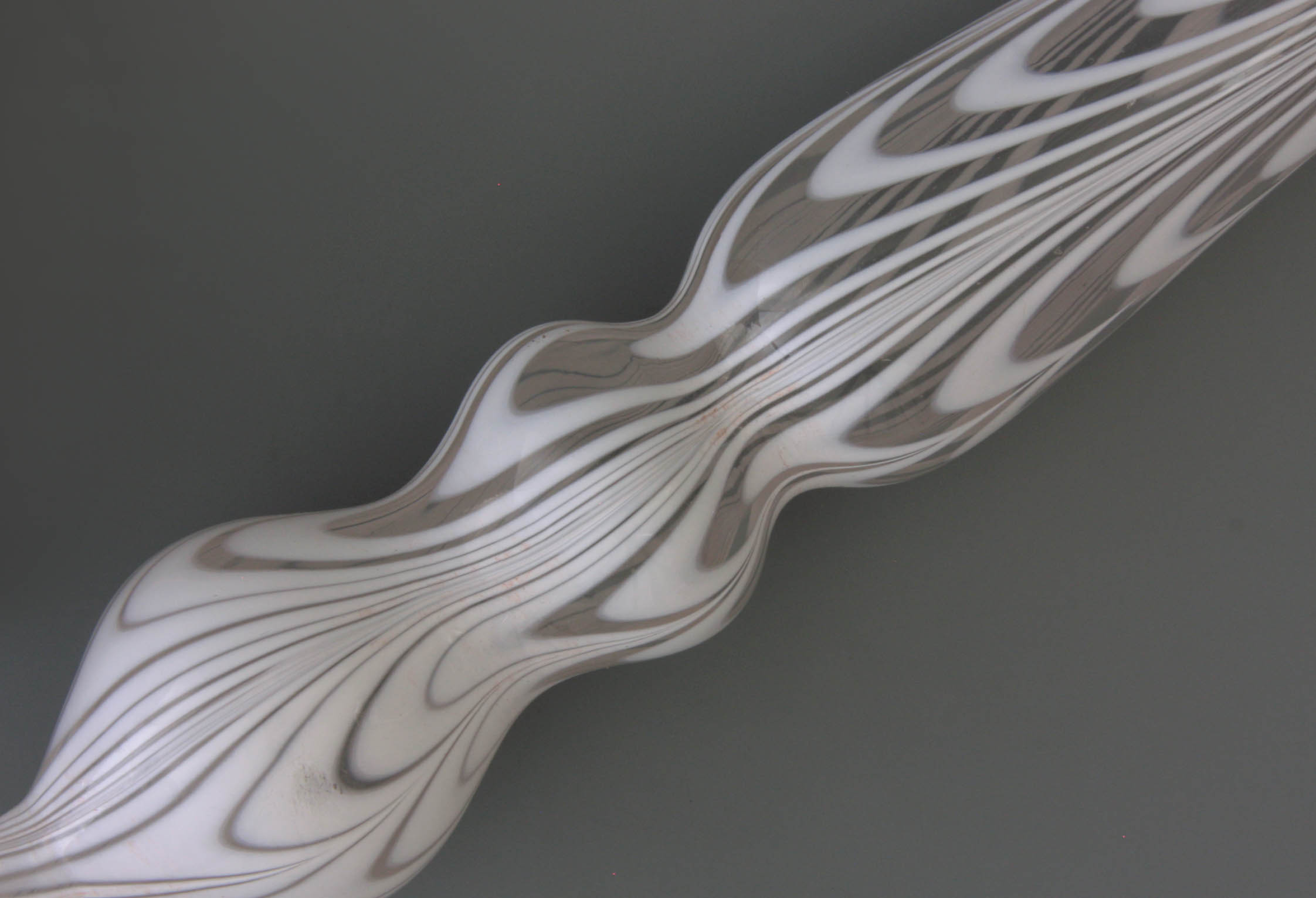
The Pijpenkabinet also has a series of such eye-catching but also kitschy pipes. It is certain that they are never meant to be smoked, with the exception of the small versions that could be used as cigar holders. The rumour that they were signs for the tobacco shop, is still unproven. More logic and therefore true, is that they have only an ornamental function. That is why they were sold at specific locations, especially as a curiosity on annual markets.
The pictured specimen with giant bowl and thick, slightly curved stem is 44 centimetres long. Because of the work, this can be attributed to both Nailsea and Bristol. The pipe is blown out of transparent glass and is decorated in the so-called latticino technique. A pattern of milk white stripes with a certain regularity runs like a network over the object. It is an admirable piece of glassblowing art, but with its wondrous convex shape and wide stem with two spheres and a baluster it still has a somewhat unusual shape without any practical use.
As a matter of fact, no pipe collection is complete without these remarkable glass objects. They are added to many historic collections to show the most extreme of smoking equipment, but the question remains whether it is related to smoking at all. They come into being during the nineteenth century, the oldest mentions date from before 1860. The production will continue until the year 1900. Because of their fragile material they quickly become rarer, but for the current pipe enthusiast the interest focus more likely on more serious smoking objects in other materials.
Amsterdam, Pijpenkabinet collection Pk 19.872
Pipes from North and South America
A tubular Indian pipe
The pipe shown here is primitive in design and finish, but beautiful in its simplicity. It is the most obvious pipe shape: the tube shape, which is referred to by scholars as tubular. The pipe is just over fifteen centimetres long and is made of brown-black steatite with a slight hint of green. In terms of shape, this pipe is mainly cylindrical but narrows at both ends, resulting in a slight oval shape. Around the bowl opening an inconspicuous trim can be seen, referred to as raised ring in professional circles. The stem end is slightly taping and nicely rounded. The final edge of this mouthpiece is somewhat uneven and a bit worn. The pipe has obvious traces of use, but at the same time it is excavated as an archaeological object in great condition.
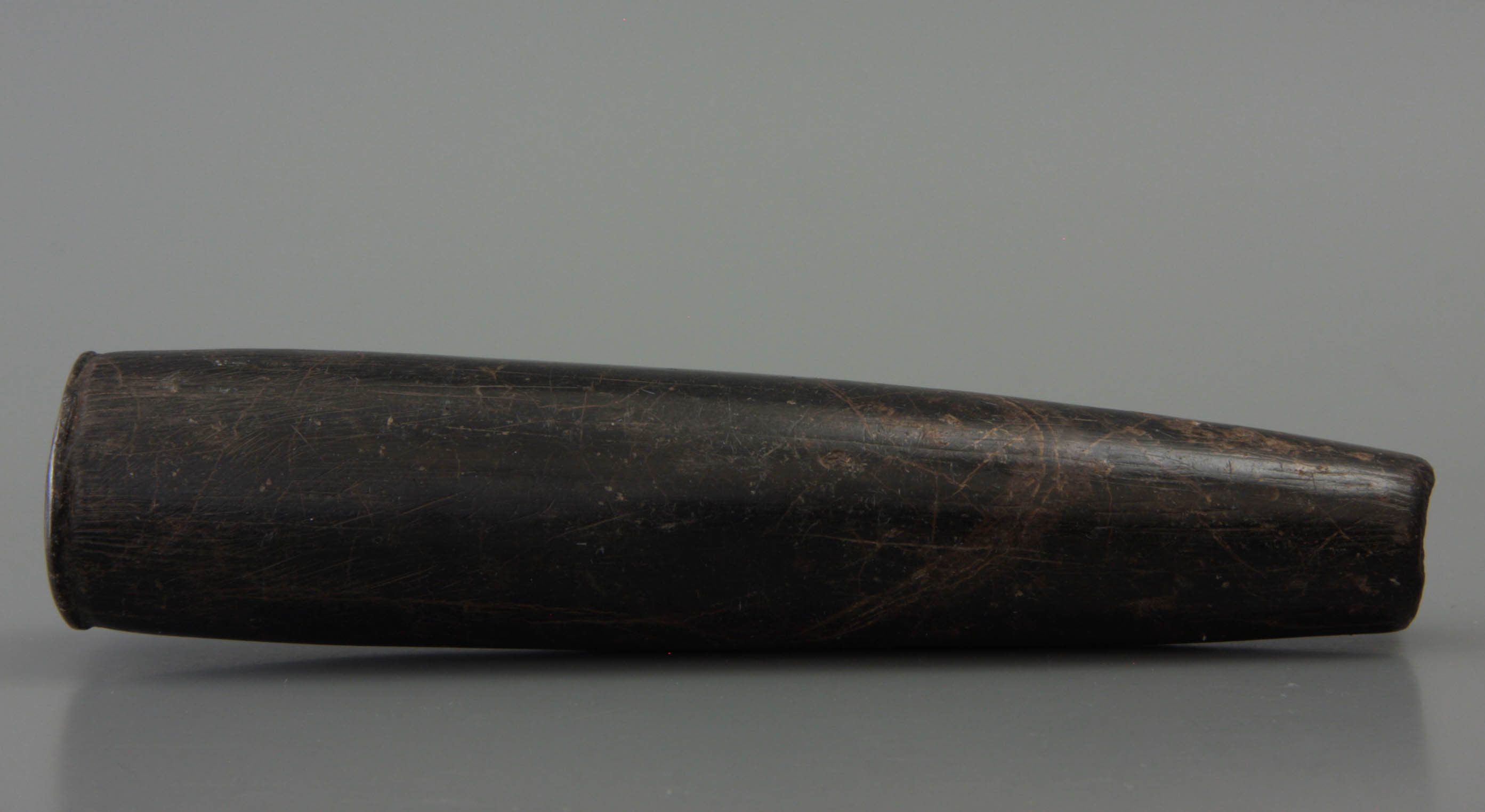
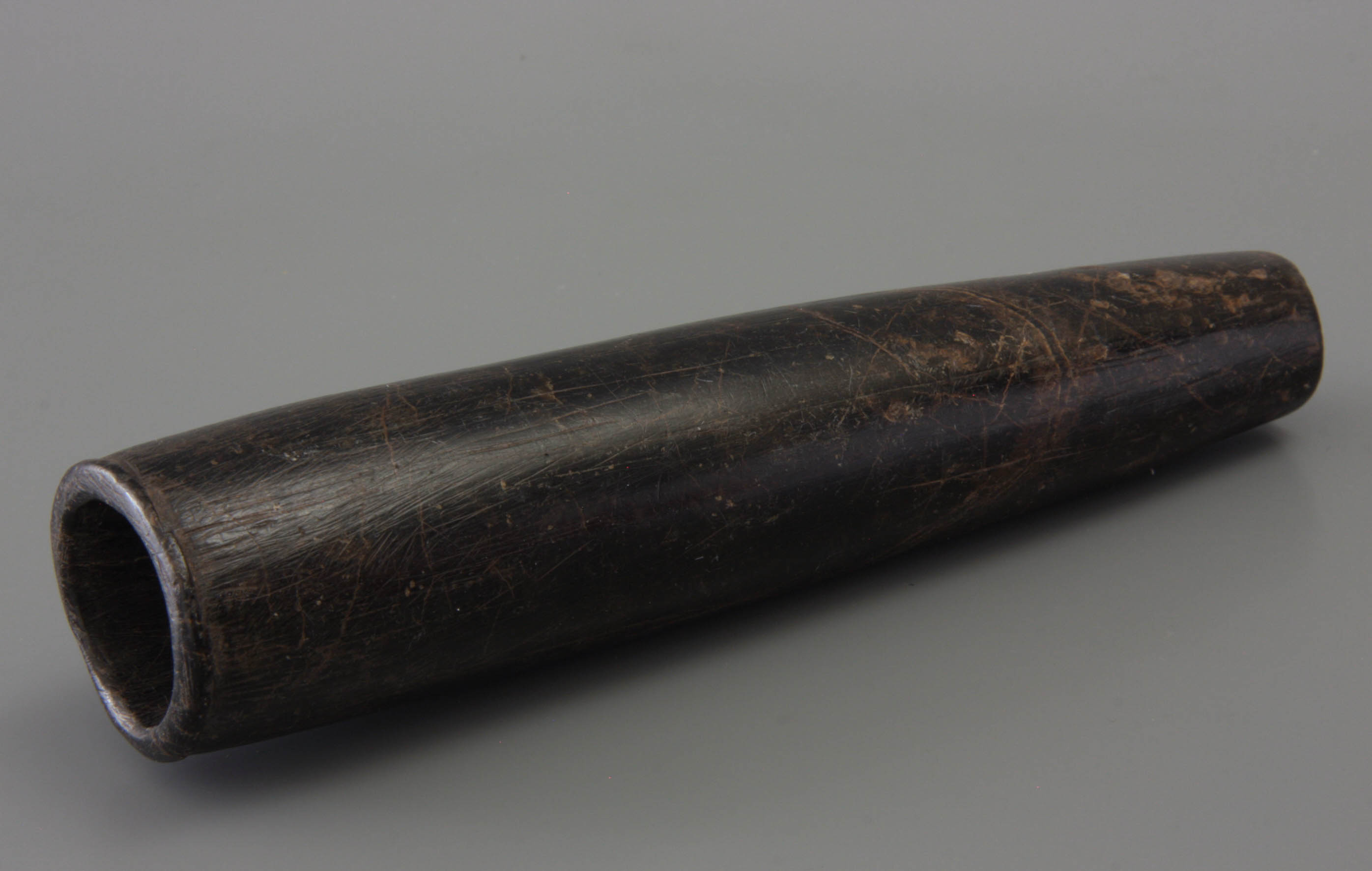
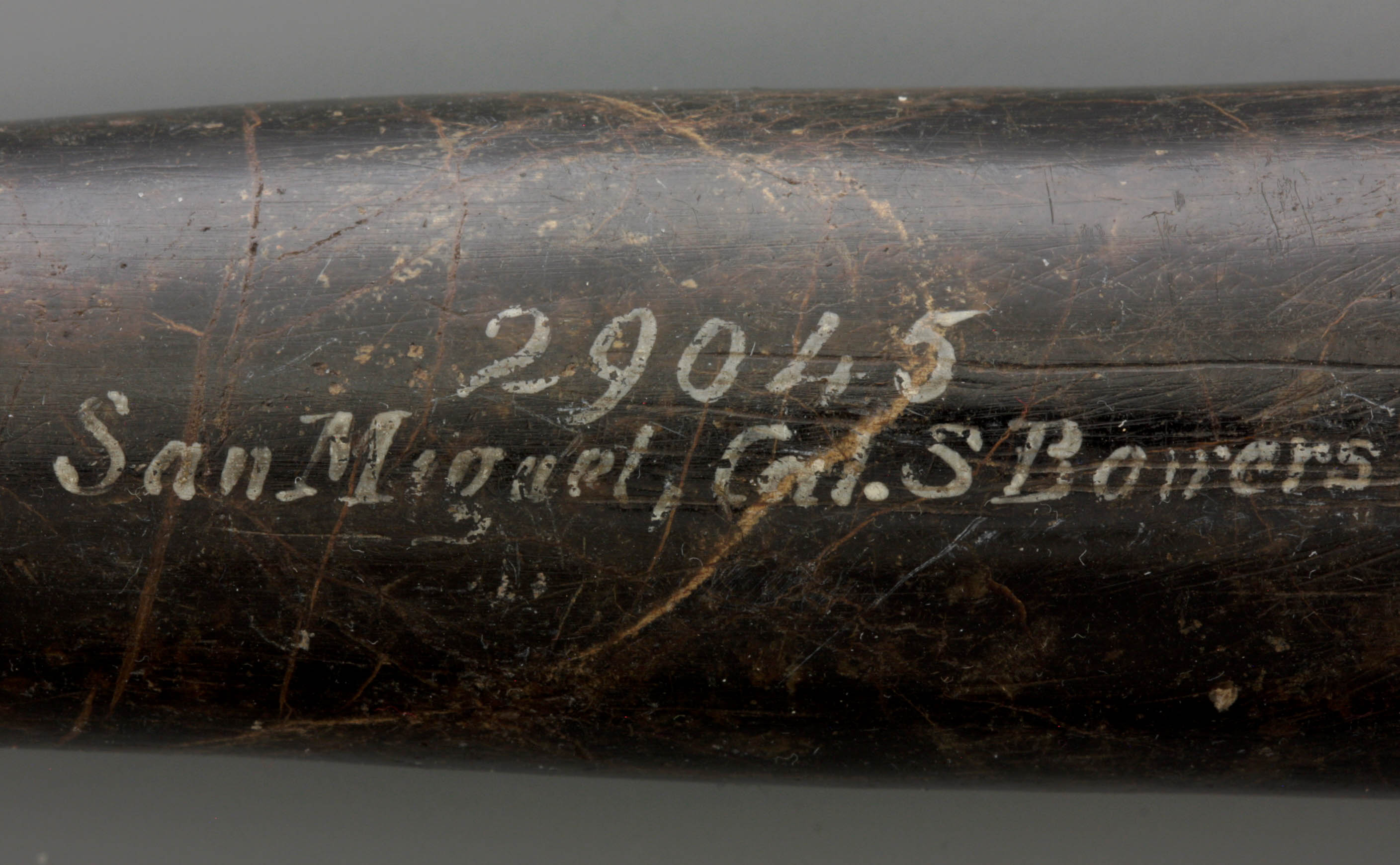
Although the tube shape gives the impression of being made on a primitive lathe, that is certainly not the case. In the early period, the Indians were still working completely manually. The object was hollowed out with a flint on a stick as a drill. The stem is drilled from one side of the pipe, of course with a rather thin drill, then the bowl is created from the other side. By manually rotating the drill, the shaft is not purely cylindrical and straight, but shows rings with a slight gradient. The outside rather seems to be scraped and polished to the desired shape out of hand, including the milling around the bowl opening. In short, it is a completely manually made object.
After drilling, the pipe has been extensively finished. Internally, the bowl part has been further hollowed out in order to get rid of the rings of the drilling and to make the bowl more spacious. On the outside the pipe has been smoothed, although the surface still shows numerous scratch and grinding marks that testify to working with primitive tools. Apparently, at the time a new pipe was characterized by a web of such grinding tracks. In the course of use, these scratches were washed away until a nicer, smooth surface was obtained, naturally with a warm patina of frequent handling. Internally, half of the pipe length consists of the bowl intended to be filled with tobacco, so it is about 7 centimetres deep. The bowl and stem sections cannot be distinguished on the outside of the pipe.
The tubular served a way of smoking that has been common practice for centuries. The pipe was filled with pulverized tobacco and smoked in a lying position. With the Indian tribes this has become a use that even contributed to the ceremonial meaning of pipe smoking. An additional component was part of this pipe, which is understandably lost. However unexpected, the native Central-American Indians have mounted this bowl on a hollow stem or on a bird bone. With the aid of bitumen, the two parts were tightly connected. That joining is still visible in the stem section where traces of adhesive are still present despite the age.
It is hard to put a date on this object. The period of use of such pipes runs from 500 BC until the turn of the last century, since the tubular pipe has remained in use in many Indian cultures until shortly after 1900. Our example does not seem to be a really early specimen, nor a recent one, but rather a regular product from the time that the manufacture was already somewhat standardized. To be on the safe side, we can definitively put a period dating between 500 and 1500 on this specimen, probably more exactly between 800 and 1200.
Literature: Don Duco, Alfred Dunhill's fascination for the tubular pipe, Amsterdam, 2007
Amsterdam, Pijpenkabinet collection Pk 18.084
The peace pipe of the Indians
The Indian tribes of the Great Plains, the prairie area east of the Rocky Mountains used pipes in a specific style. We are talking about pipes that are officially called calumet but are generally known as peace pipe. For the latter, the term ceremonial pipe would be more suitable, because besides the peace pipe a war pipe was also used. Characteristic of these pipes is the red stone, called catlinite in the particular, so-called calumet shape.
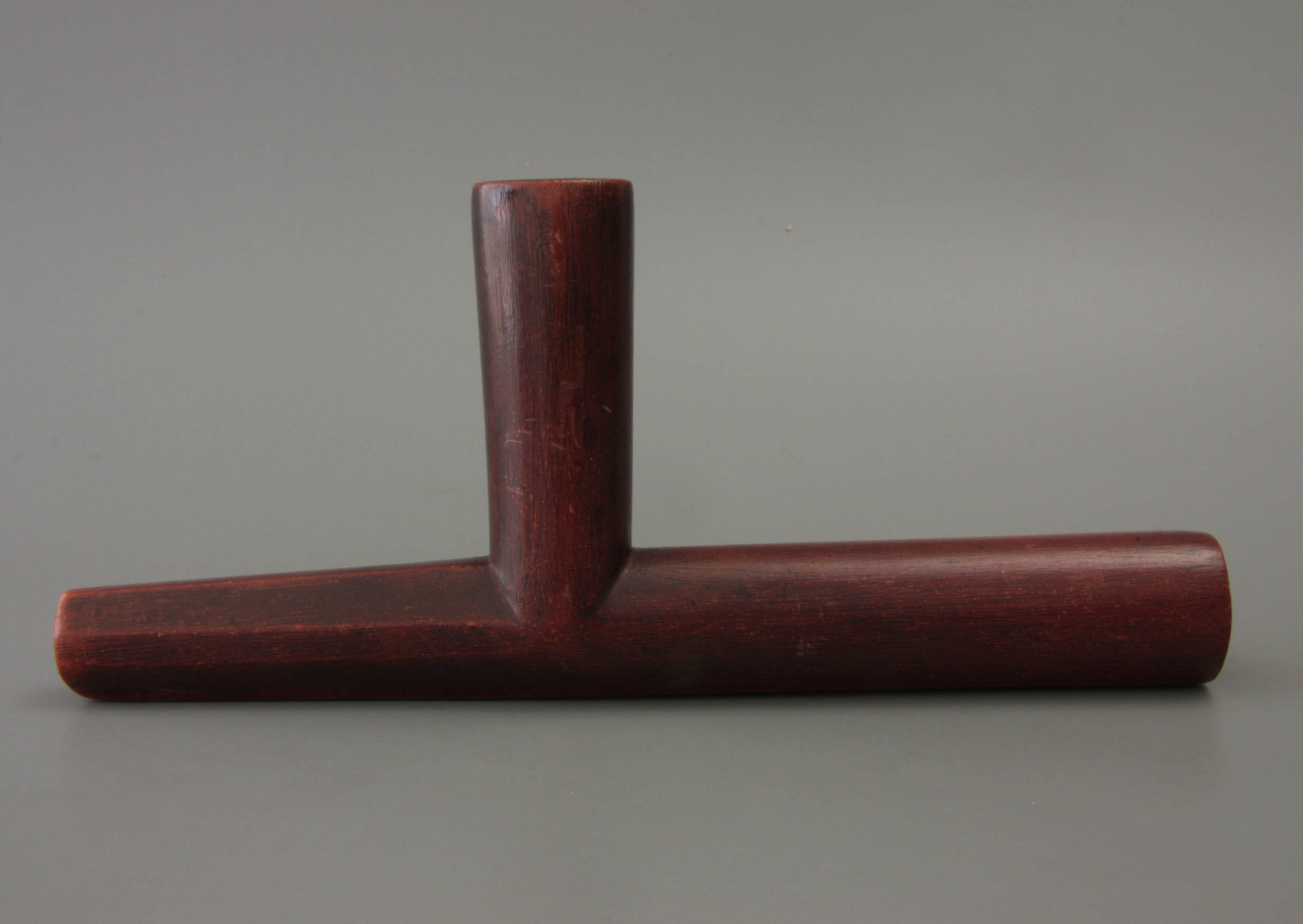
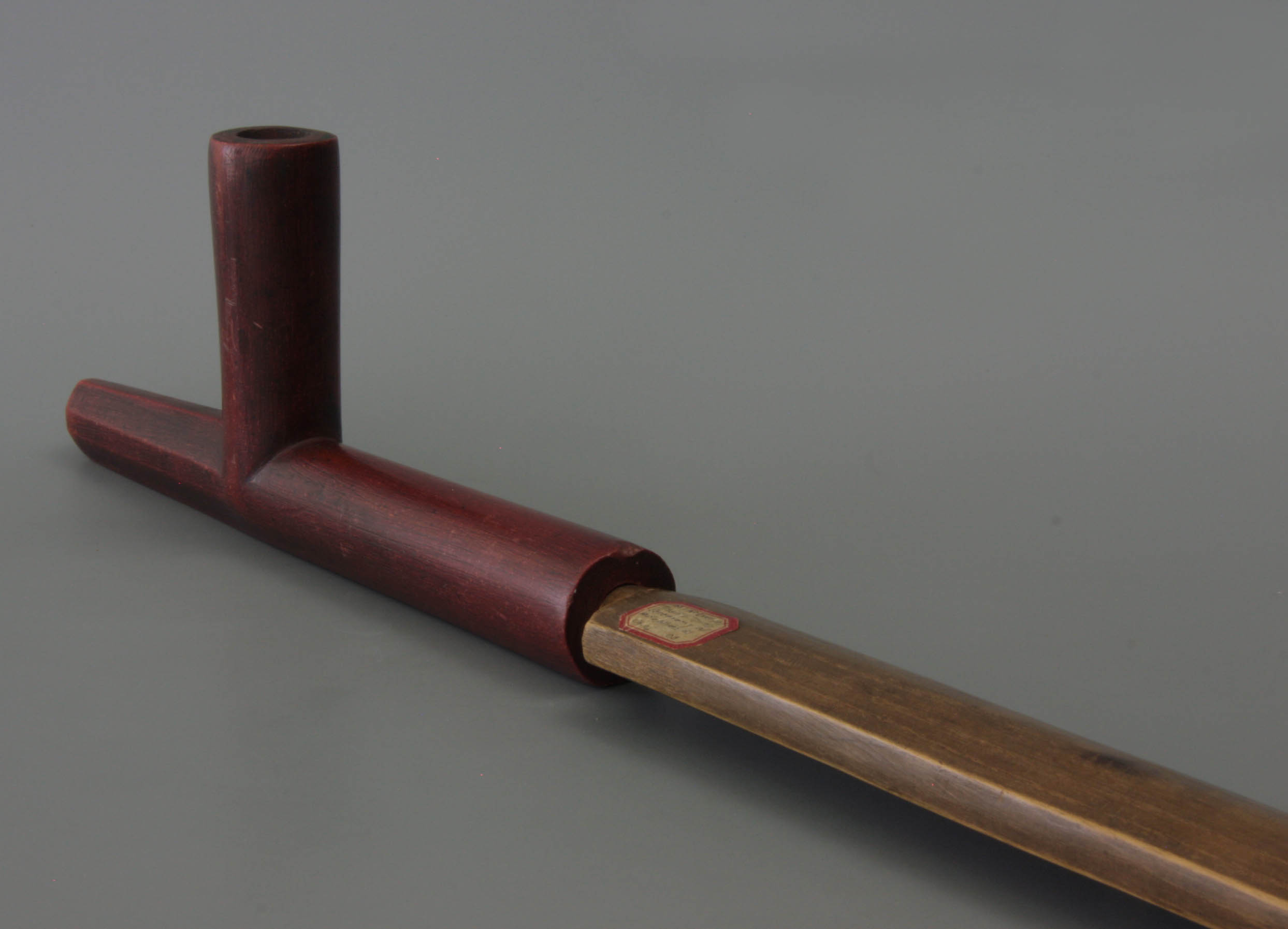
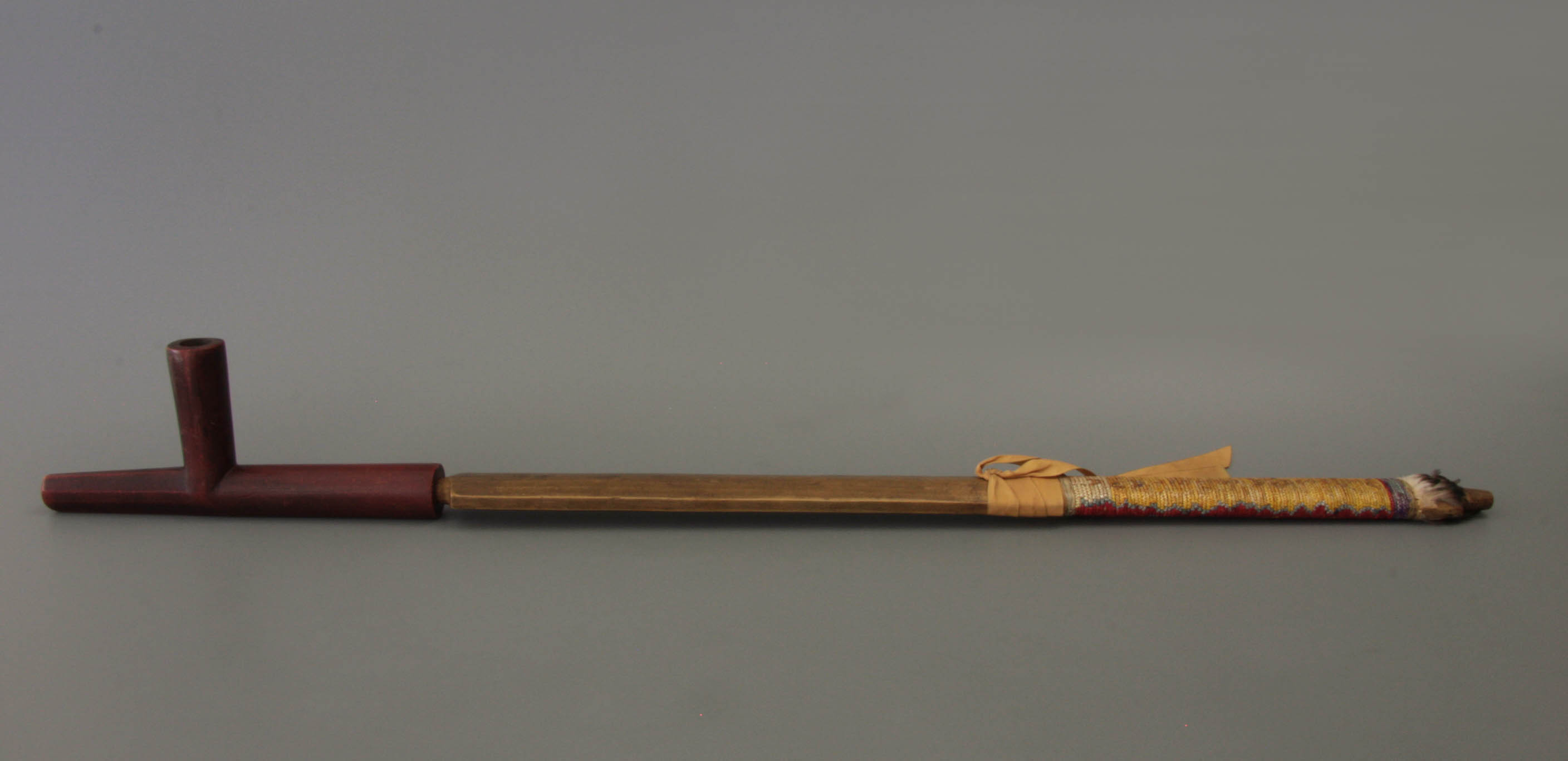
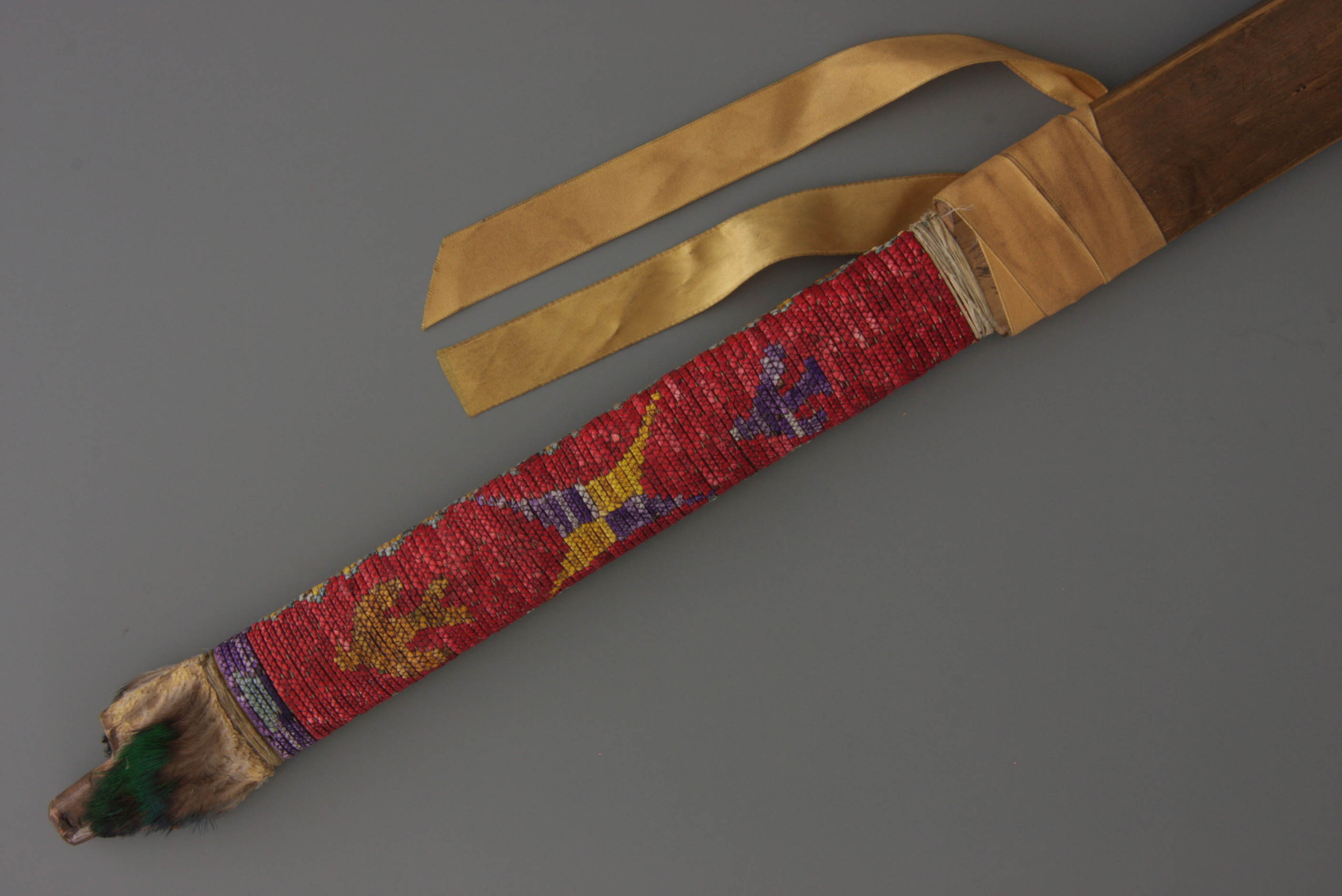
The beautiful red stone for these pipes is found in layers that can easily be sawn away from the rocks. The colour can vary greatly, sometimes it is completely plain, sometimes slightly speckled. For the red version the name Minnesota pipestone is used. As a commodity, this stone is sold to all areas. Because the type of stone is relatively soft, it can easily be processed with simple tools, which applies to drilling, grinding and polishing. A positive feature is also that it resists heat well, while through use it gets a beautiful patina.
Typical for the traditional Plains pipe is the high cylindrical upright bowl which is usually slightly shorter than the stem part into which the stem is later inserted. This stem continues beyond the bowl, getting slightly slimmer and often ends in a nicely bevelled point. Because of this characteristic silhouette, such pipes are simply designated T-shaped, corresponding to the shape of an inverted letter T.
Both quality and age are shown in the way the pipe is finished. Initially it is only cut and polished, resulting in a smooth surface. In the historical period, more and more metal tools are used, leaving mechanical traces on the object. We see that especially in the drilling of the bowl and stem opening.
The stone pipe bowls are originally mounted with a long straight wooden stem with a flattened shape. Sometimes such a stem is decorated with some carving, but usually it is smooth. At the end this stem is decorated with the so-called quill-work, braided leather bands in different colours. Often this braid has patterns, as with the pipe of the Pijpenkabinet with two arrowheads in a red field around a four-pointed star. On the underside, even a text has been made in the quill-work. The mouthpiece ends in a point adorned with a band with colourful bird feathers. As an extra decoration a yellow silk ribbon with hanging ribbons is added.
IInteresting is the label that is glued on the stem of this pipe. This label has a red border and with ink we read "M.I.McCREIGHT TCHANTA-TANWA CEREMONY OR ADOPTION AS CHIEF '08". It refers to a certain Israel McCreight who received the pipe as a gift when he was elected as Chief. That must have been in June 1908 in DuBois, Pennsylvania. At the time, the pipe had been in use for some time, and that goes well with a gift to a Chief who was also an expert on Native American cultures. Eventually this object ended in the Tobacco Museum of Vienna and when that collection was auctioned the pipe moved to Amsterdam.
Amsterdam, Pijpenkabinet collection Pk 16.847
The American Indian tomahawk
The American Indian tomahawk is a pipe that appeals to the imagination. However the object looks like an axe, it is not. It is a pipe combined with an axe. Above all it is surprising that this characteristic Indian pipe is not an Indian invention but was conceived by Europeans to trade with the North American natives. Soon the tomahawk becomes a prestige item: every self-respecting Indian had one. It is not surprising that these pipes were used by the tribal chiefs as the ultimate status object. When we see nineteenth century Indian portraits, the tomahawk is often worn as a symbol of power, like the king's regalia.
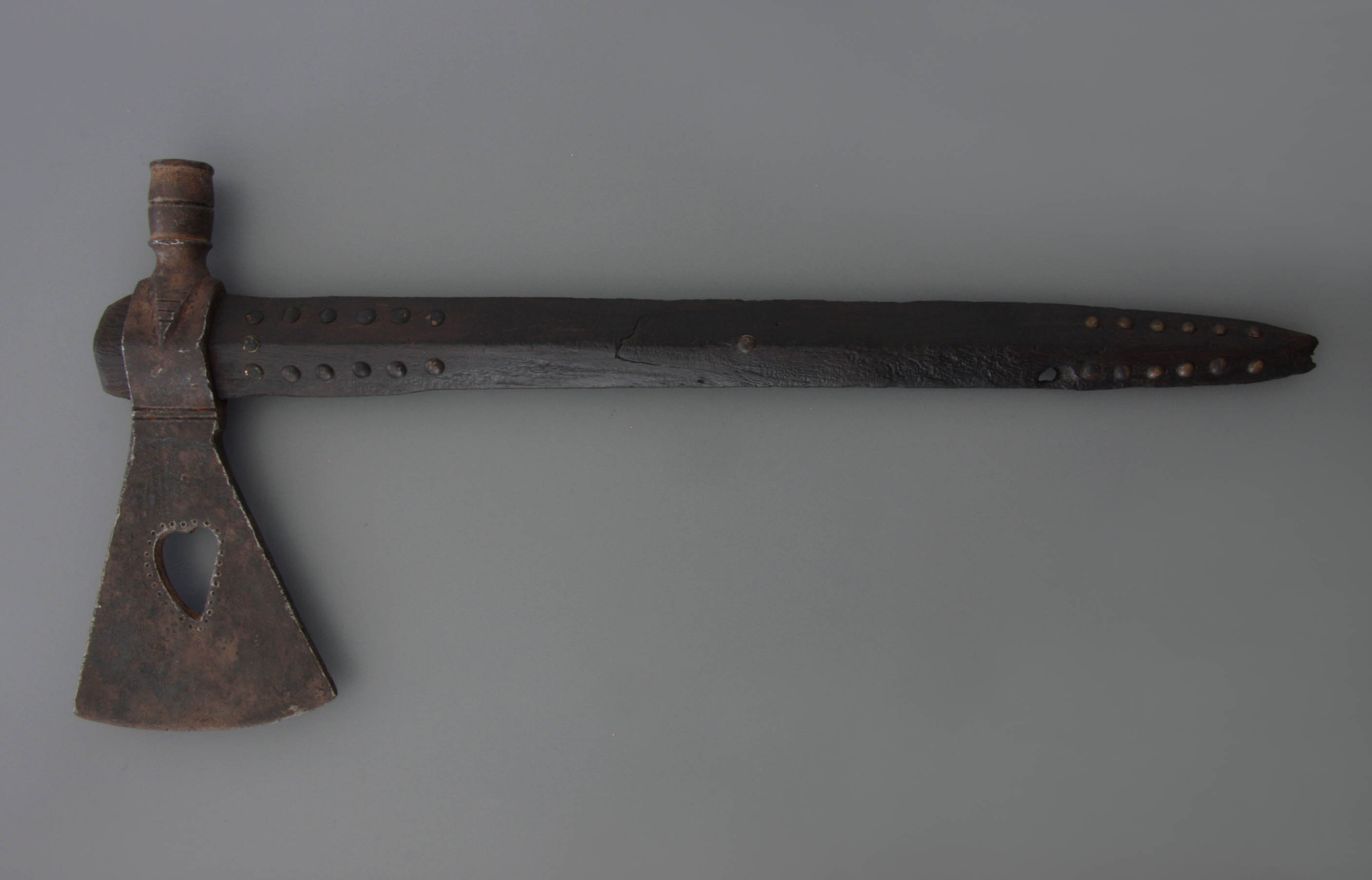

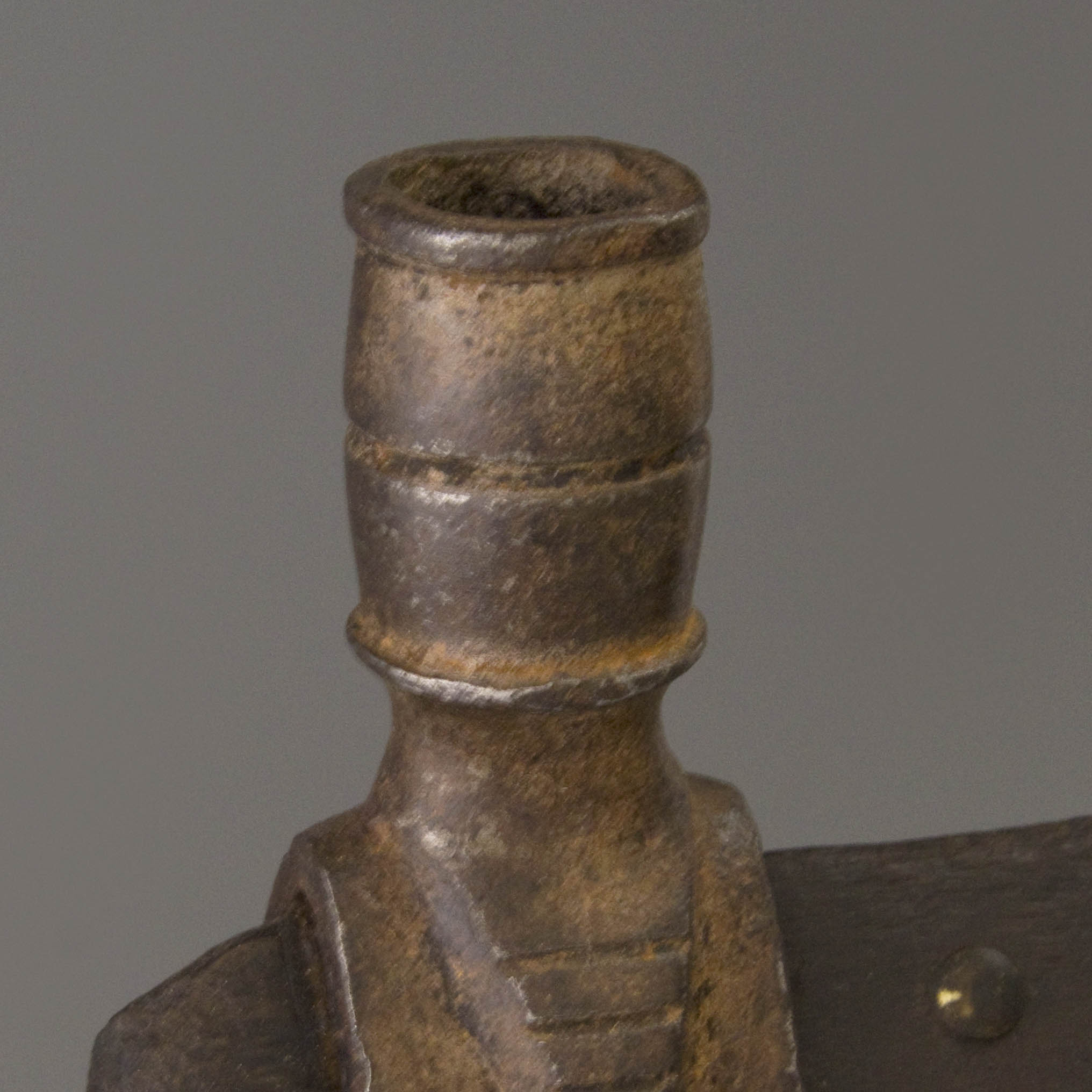
The combination pipe bowl and axe remains strange, but we should not take the function of the axe too seriously. Certainly not when the pipe is made of brass or a soft type of stone. The best tomahawks, however, are forged from iron or cast from brass, even combinations of both materials occur. The decoration is usually limited to the blade of the axe. Often motifs are cut out like a heart or a star. In our case, there is a distorted heart, with punched outline markings. Sometimes the metal is engraved or provided with an insert in silver.
The stem of the tomahawk is made of hardwood and drilled over the full length. The connection of this stem to the pipe bowl is made by drilling in a vertical channel. The far end is then closed with a wooden plug or a metal pin. By removing that pin, the pipe can better be cleaned. In order to prevent false air when smoking, the joint of axe and stem is sealed with a leather strip. The stem itself is often decorated with hammered brass nails, here for example in simple rectangles. A piercing through the stem at the stem end serves to attach a decoration of fabric, leather or more often of a few feathers. With the older ones like this tomahawk, that decoration has been lost long since.
The oldest tomahawks were made by the English, the French and the Canadians. Later that happened mainly locally in the American colonies. Tribal chiefs could come into possession of a tomahawk by exchanging hides or other goods. The story goes that a tomahawk had a counter value of a pile of pelts as high as the length of the stem.
The example shown here is of the earlier type, fully functioning as a pipe, although in principle it could also be used as a battle weapon. The pipe bowl at the top looks round but is slightly four-sided and is profiled with two protruding and one constricted band. The stem of the pipe has a diamond-shaped cross-section and is of course completely drilled. The leather between the metal and the wood is still present. It secures the draw in the pipe. In short, a full pipe although the balance is not too good due to the axe. For a status object you take that for granted.
Amsterdam, Pijpenkabinet Pk 16.883 collection
Pipes from Africa
Wooden pipe with three people
This beautiful pipe must have been taken from Angola by a traveller who stayed there in the first decades of the twentieth century. The tobacco pipe will be bought in the Ovimbundu region, a tribe that lives in the border region of Angola with the Congo. Such pipes were ceremonial pipes, called Peshi. The funnel-shaped pipe bowl with flat bottom and also the straight wooden stem with the pronounced disc-shaped end are characteristic of the common local smoking pipe. The use of an iron stem as an extension to the wooden stem is also common. The figural stem decoration, obviously reserved for more influential smokers, distinguishes this pipe from its everyday counterparts.
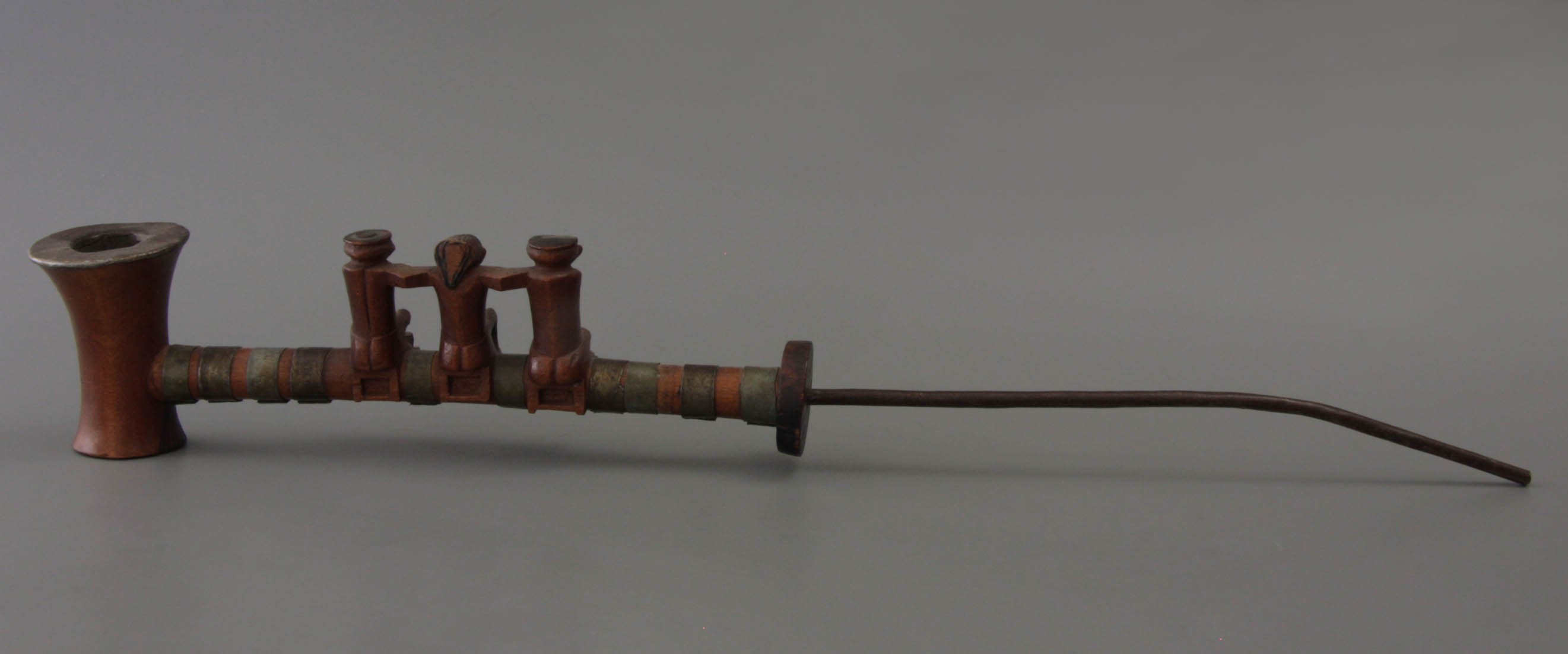
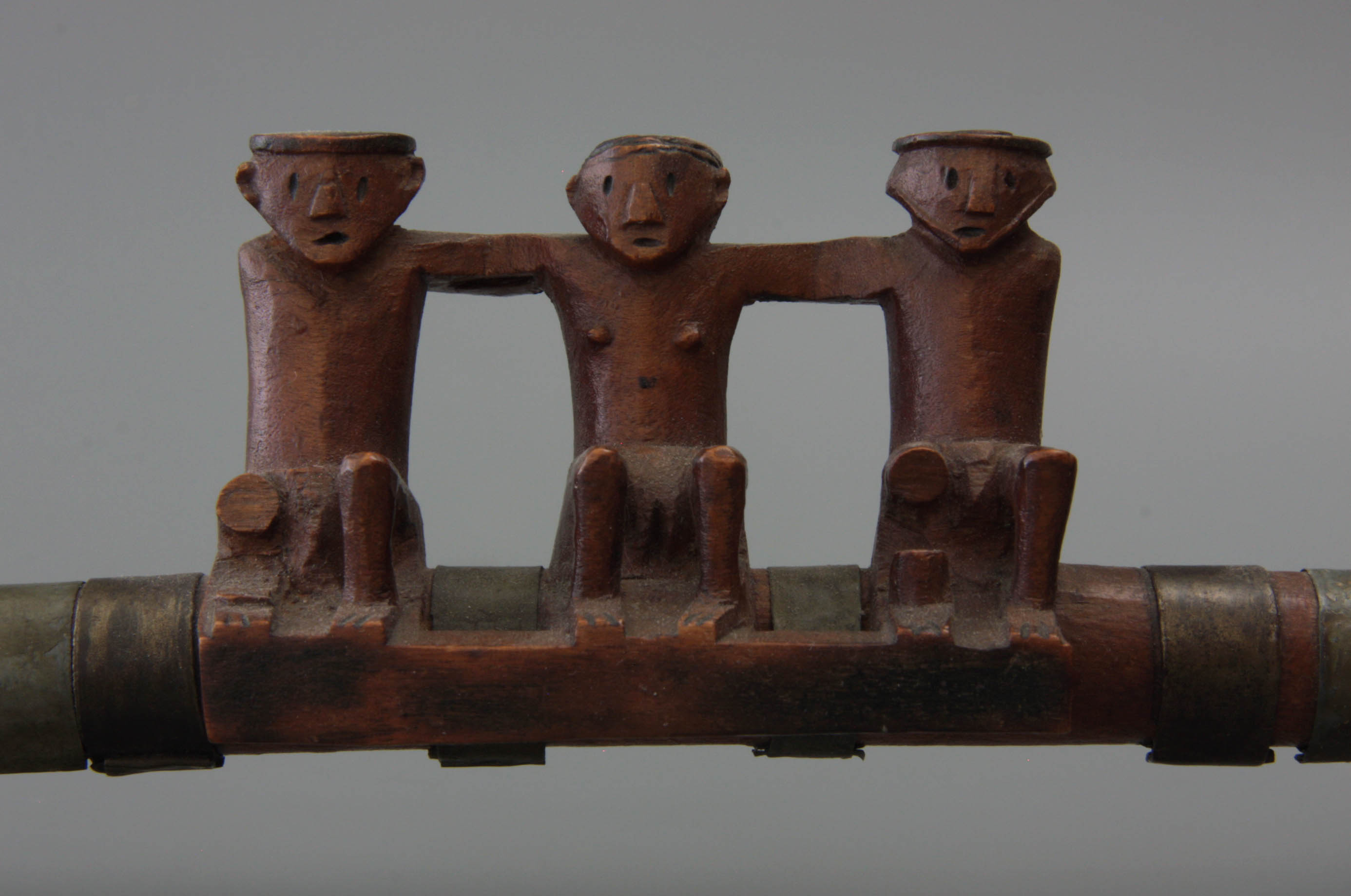
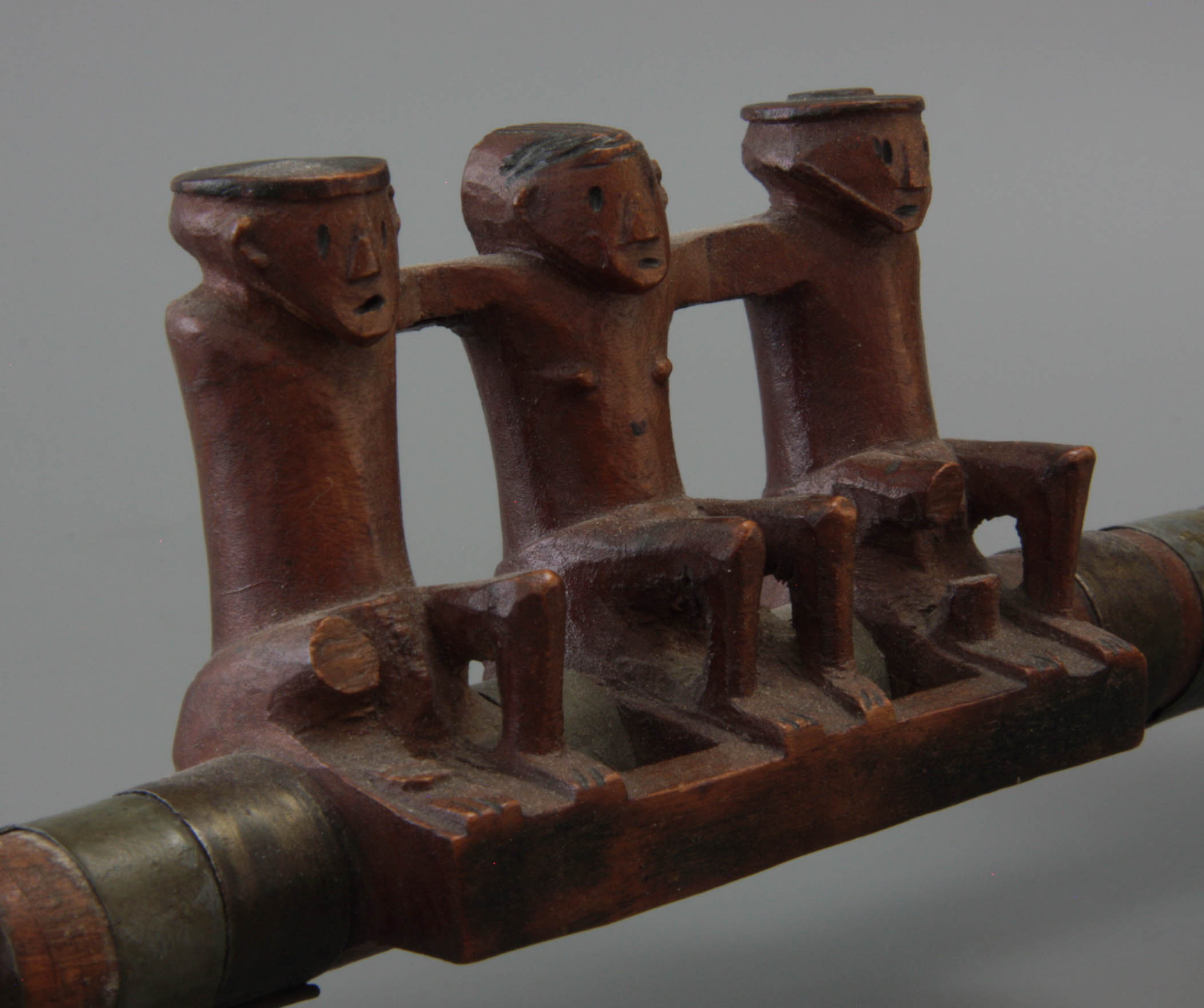
On the stem of the pipe three seated figures are depicted, facing left for the smoker. The naked figures are sitting on a kind of platform, a woman in the middle, flanked by two men, their feet are resting on a beam beyond the pipe stem. The carving shows routine and artistry. Only by subtly indicating a few details like the hair, eyes and mouth the representation of the figures is suggested. Some of these details are accentuated with a lick of black dye. More than enough to represent human figures without truthful detailing.
As a reinforcement a series of tin straps in two colours are forced around the straight pipe stem. Additionally they fulfil a role as decoration. The bowl is internally coated with sheet metal as well, which is necessary to protect the soft wood from burning. This metal runs on the flat bowl opening and forms a subtly folded edge on the transition to the wood. The entire object is covered with transparent lacquer to smooth the rough surface. It is possible that this did not happen in the country of origin, but later in Europe.
There is no discussion about the dating of this piece. The characteristics are completely stereotyped for the region, the tribe and the period between 1880 and 1920. Because we do not know how the style of the Ovimbundu pipe developed, an older age is even possible. The oldest written source about this object dates from 1951 when J.H. Kruizinga wrote an article about the collector Henk van der Hoef. In that article, this pipe is mentioned with name and tribe. With these few ephemeral sentences and a group photo, this object is one of the few copies from the Van der Hoef collection that have been documented. Unfortunately in journalistic style without much background knowledge, typical for such writing. The essential details when and where the object was collected were unfortunately lost.
Amsterdam, Pijpenkabinet collection Pk 17.135
Two bowls on one stem
You can continue to amaze yourself about the way peoples shape and decorate their smoking pipes. Regional and tribal-related characteristics prevail in a certain area and have disappeared in another region to make space for other properties. This pipe originates from the Malawi, in the former Nyasaland. It is a wonderful example that shows us characteristics that we cannot find in any other culture.
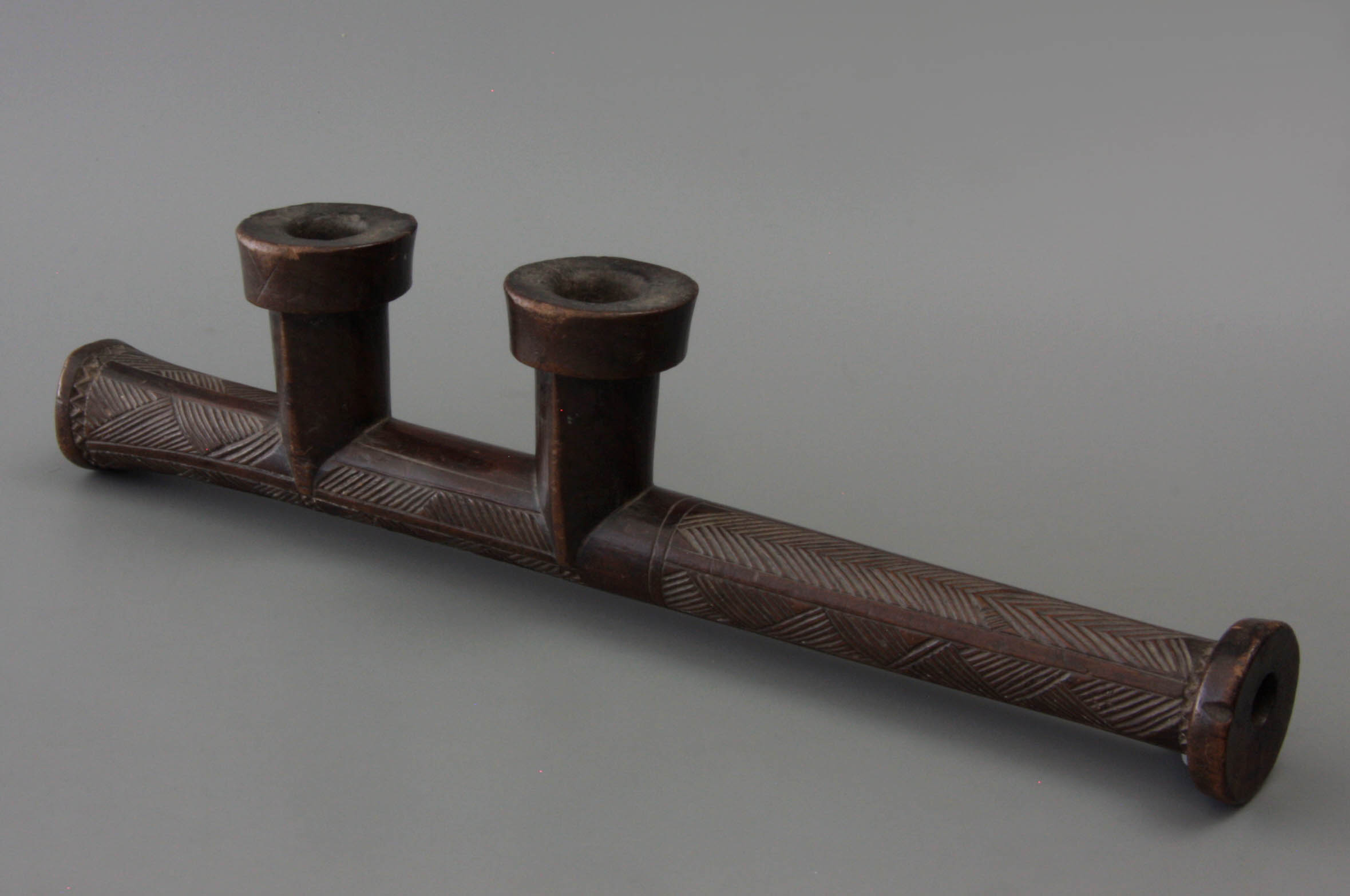
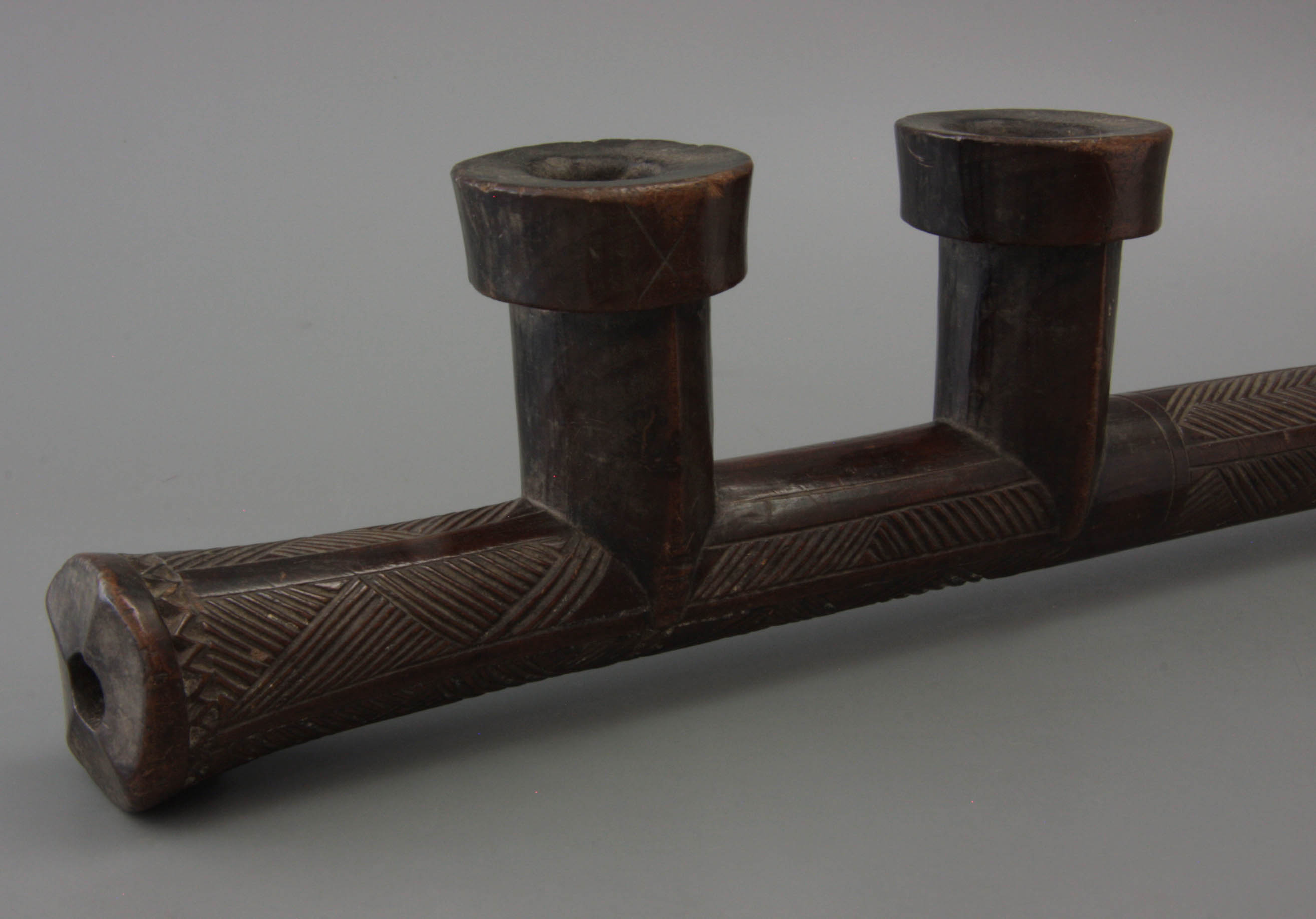
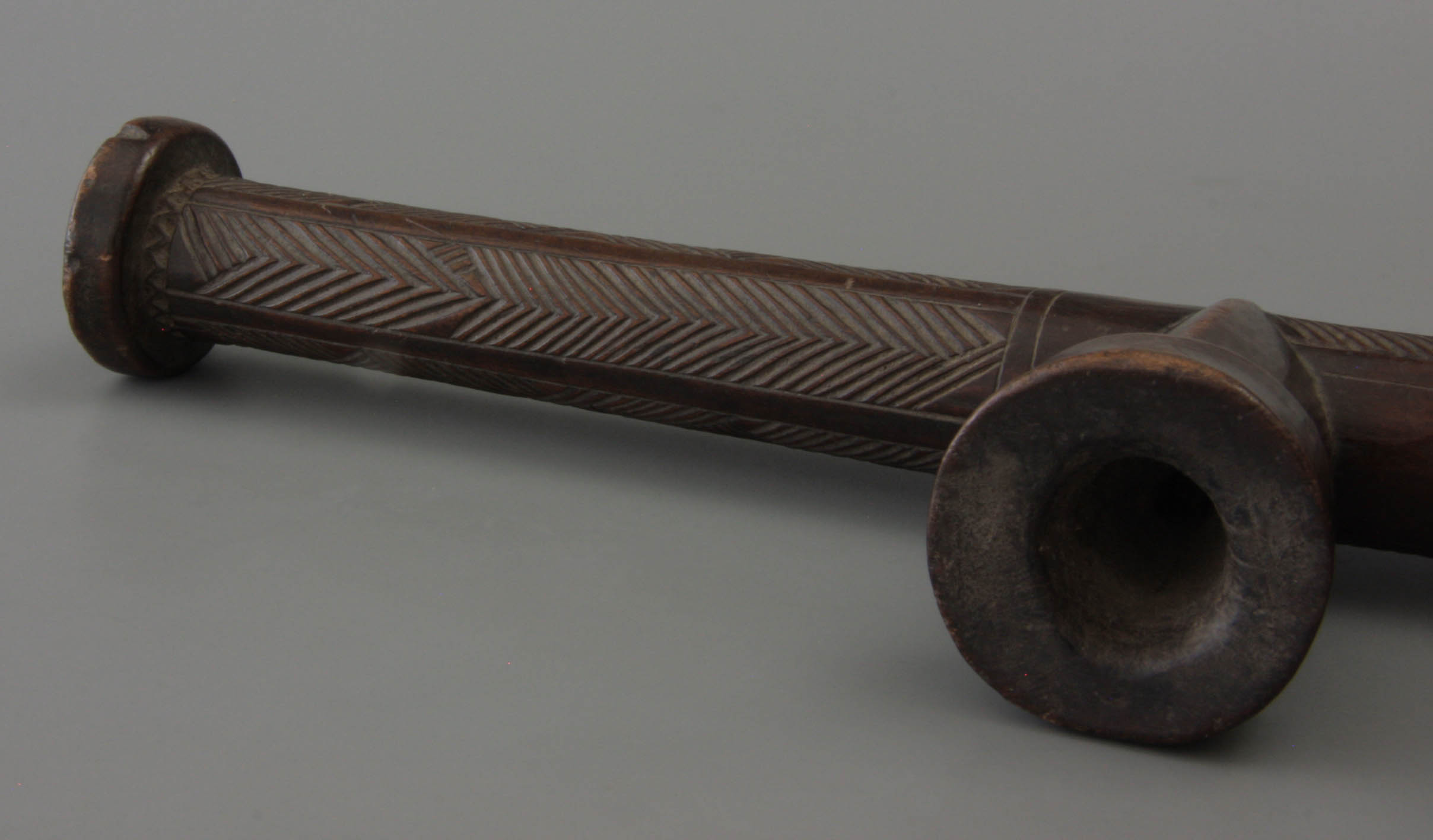
It is a tobacco pipe made of wood in a really particular shape. The straight stem is cylindrical, rather thick, slightly extending toward the end of the pipe. The front side is decorated with four bevelled, slightly hollowed surfaces. At the other end the mouthpiece is shaped like a cylindrical disc. It is not clear whether that is the actual mouthpiece of the pipe that was held against the lips or that a thin metal stem was inserted into it. While this is common practice in the Congo, Angola and elsewhere, no examples of this metal stem have ever been seen at the Malawi.
The positioning of the pipe bowl, in this case even two, is most peculiar. They are not located at the end of the stem as usual but well in advance, providing a kind of handle behind the pipe bowl. Both bowls are in a right angle on the stem. The two identical bowls are very subtle in shape. Their diameter is not round but slightly flattened with a seam on either side that brings them to the same width as the relatively thick stem. The two bowls join into the stem in an ingenious way. The pipe bowls have a heavily pronounced top edge which corresponds to the mouthpiece.
Both pipe bowls are left undecorated, except inconspicuous notched crosses on the rim of the bowl opening. The stem, on the other hand, has an interesting incised decoration of three geometric bands. The first and widest at the mouthpiece, the second between the two bowls and the third at the end piece. The panels are separated by incised bands with a zigzag line. Although seemingly identical, the three panels are filled in different ways. The elongated fields were alternately provided with hatchings, continuous or herringboned, in other cases composed of triangular fields with hatchings alternately directed left and right. The variation in the patterns makes the surface exceptionally lively, although we should not try to find a system in the composition. The patterns seem to have been cut away at random, without having devised a certain rhythm in advance.
How the shape of such ethnographic pieces developed, whether it was copied anywhere and when this happened, it is all a mystery. Little is known about the life span of such objects. The style must have existed before 1850 and will remain in use beyond the beginning of the twentieth century. When it disappears is unclear. With a degree of certainty, this piece will date between 1850 and 1920. The curious shape, the high quality of manufacture and the rarity value make this pipe an attractive ethnographic object.
Amsterdam, Pijpenkabinet collection Pk 16.956
Bead knitting from Cameroon
If you believe in the expression the more the better, then this exceptional African tobacco pipe is one of the best. With its length of almost two meters and its bowl height of about thirty centimetres, for sure, it is an impressive smoking instrument. The same goes for the pipe stem with extensive beaded knitting with thousands of beads. In Cameroon, the tobacco pipe is, apart from a popular smoking instrument, a status object. La pipe du chef or chief pipe is the large to oversized pipe, which is not meant to be smoked, but has a clear status function as a show piece. Such a pipe is the one shown here.
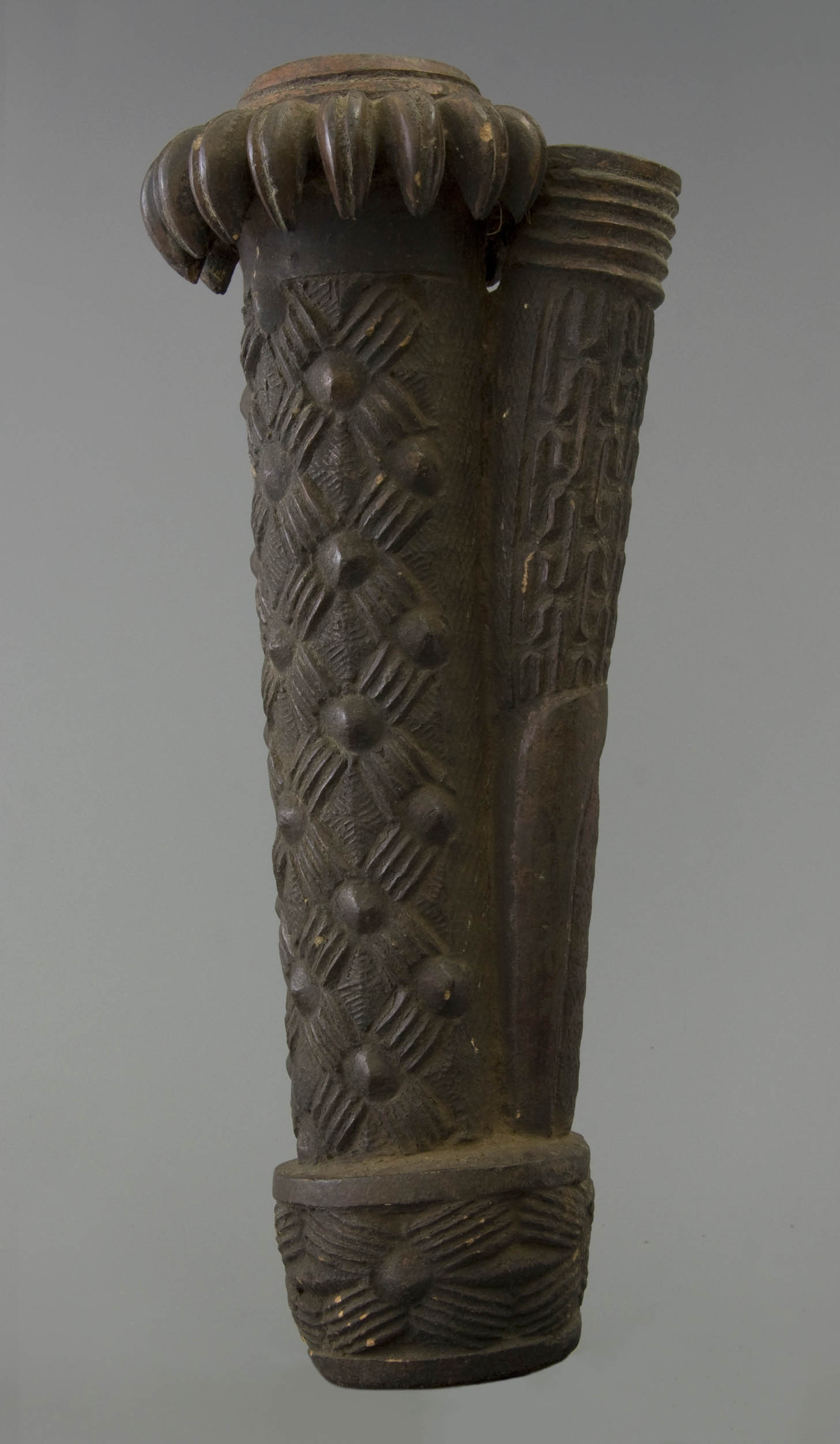
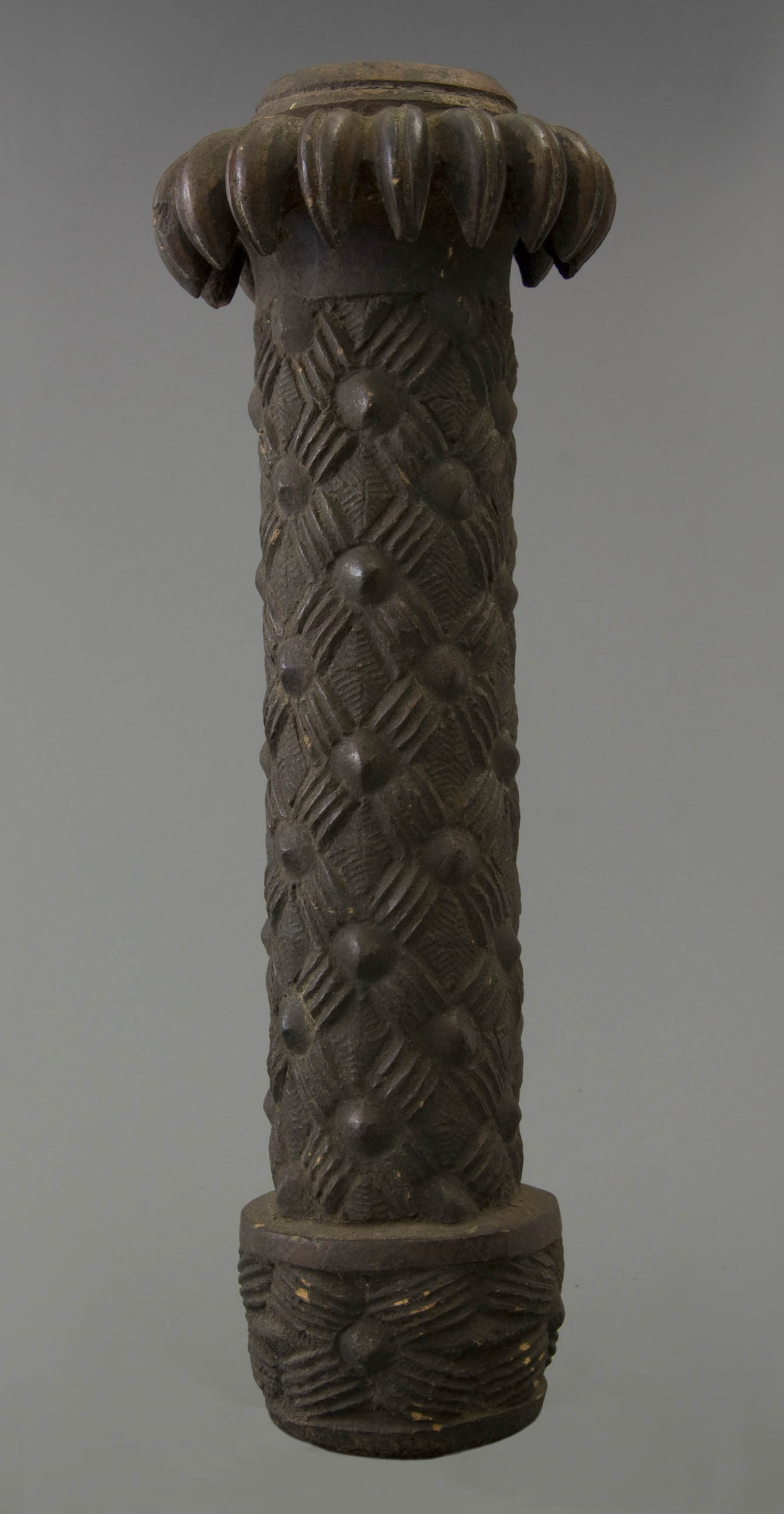

The earthenware pipe bowl has a high, rather narrow shape and is slightly conical. The bottom is flat with a leak hole, because the used tobacco has a high humidity. Traditionally, the pipes are artfully decorated with a geometric repetitive pattern with a high symbolic value. For example, the bowl shows a decoration incised in the clay consisting of stylized spiders with lozenge-shaped residual space that is shaded to four sides like a diamond head. The edge around the bowl opening is adorned with pronounced lion nails, which enclose the bowl opening like a crown. Finally, the bowl base has been strengthened with four of the same stylized spiders. The stem, nearly parallel to the bowl, is decorated with three different geometrical parts. The bottom is accentuated with an oval roughened panel, the middle has a meandering line and the narrow top edge has five concentric rings.
At the time such pipe bowls were made in series and were not built up in soft clay and moulded by hand, but were cut from a block of leather-hard clay. That is why the motifs have a specific design. In the places where the knife in use ended, burr edges occur.
The pipe has its original wooden stem with an incredibly elaborate decoration. A beautiful and colourful geometric braid of glass beads has been applied around the stem. This decoration is made up of alternating bands with triangles and overlapping diamonds. The repetitive pattern evolves from simple and explicit to more refined and more complicated. Because the stem is thinning towards the mouthpiece and at the same time the decoration is getting more complicated, a very special effect is achieved. How labour-intensive this work has been, is evident from the fact that about 27,600 beads have been used!
The wooden stem is topped by a detachable mouthpiece of cast bronze that fits over the end with its slightly tapered shape. One end has an inconspicuous pearl edge, while the stem end shape is provided with a disk shape. Although it is not a very striking part, the bronze contrasts beautifully with the shiny beads and the matt dark pipe bowl.
Such grand pipes were not smoked, but served as a promotional gift to a high-ranking person. On official occasions they were carried around in order to underline the status of the owner. It is unclear who has ever owned this pipe. After unknown wanderings, this specimen popped up in Madrid in 1988 and was sold at auction, along with four other royal pipes. Since then, this pipe dominates the extensive collection of Cameroon pipes in the Pijpenkabinet museum.
Literature: Don Duco, Smoking utensils full of symbolism, tobacco pipes from the Grasslands of Cameroon, Amsterdam, 1999
Amsterdam, Pijpenkabinet collection Pk 15.885
Pipes from Asia
An arctic tobacco pipe
There are areas in the world where raw materials are scarce. When people living there wants to make a pipe, the choice is limited. This applies, for example, to the Tongoosk, an arctic tribe in Siberia. They live with a minimum of materials that they find in nature. Once the tobacco became known in this remote region by trade, smoking became a beloved form of relaxation. While the tobacco itself was imported, for the pipe a tradition and its own design was created. We now see these pipes as a remarkable and interesting ethnographic object.
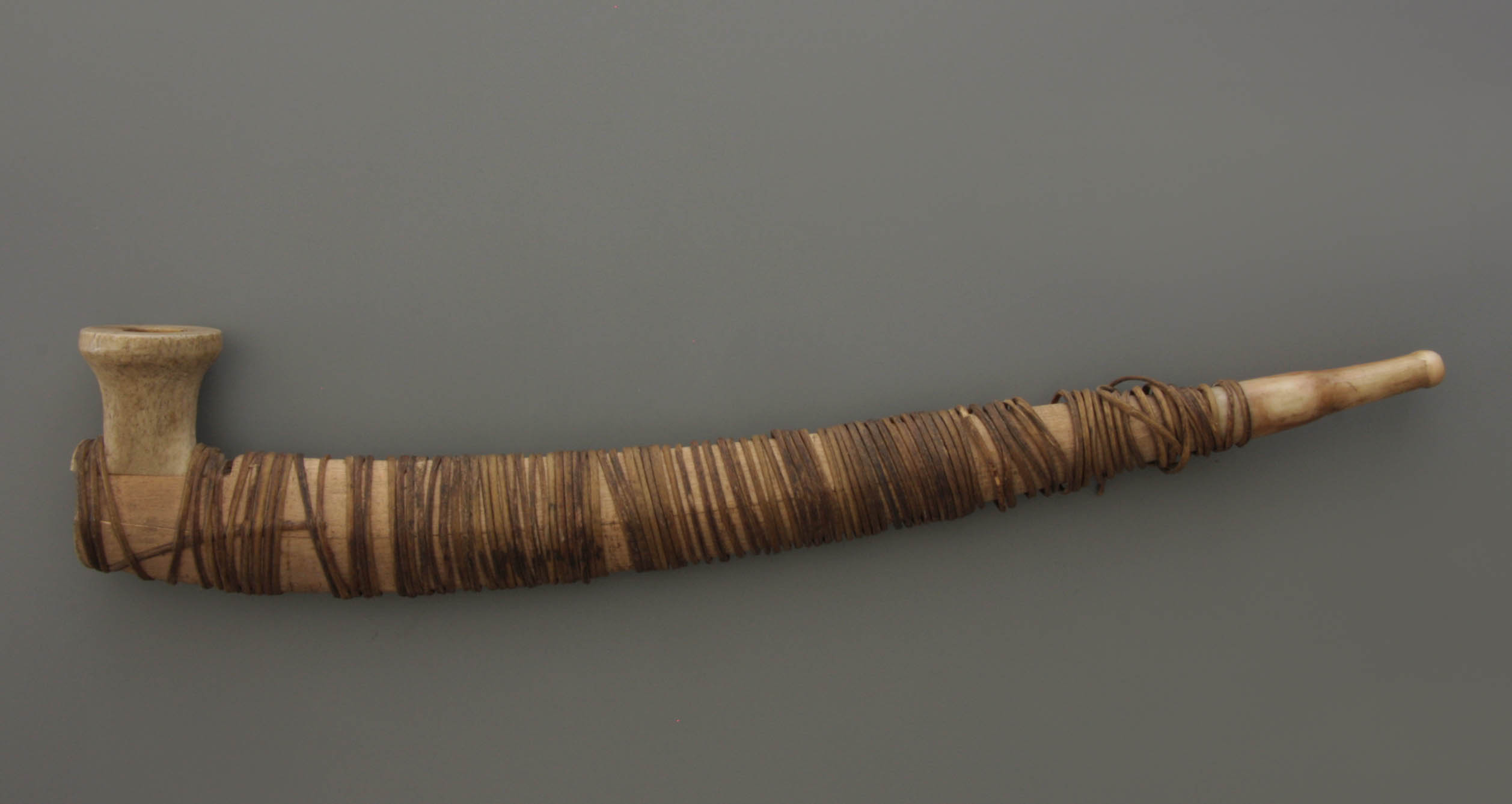
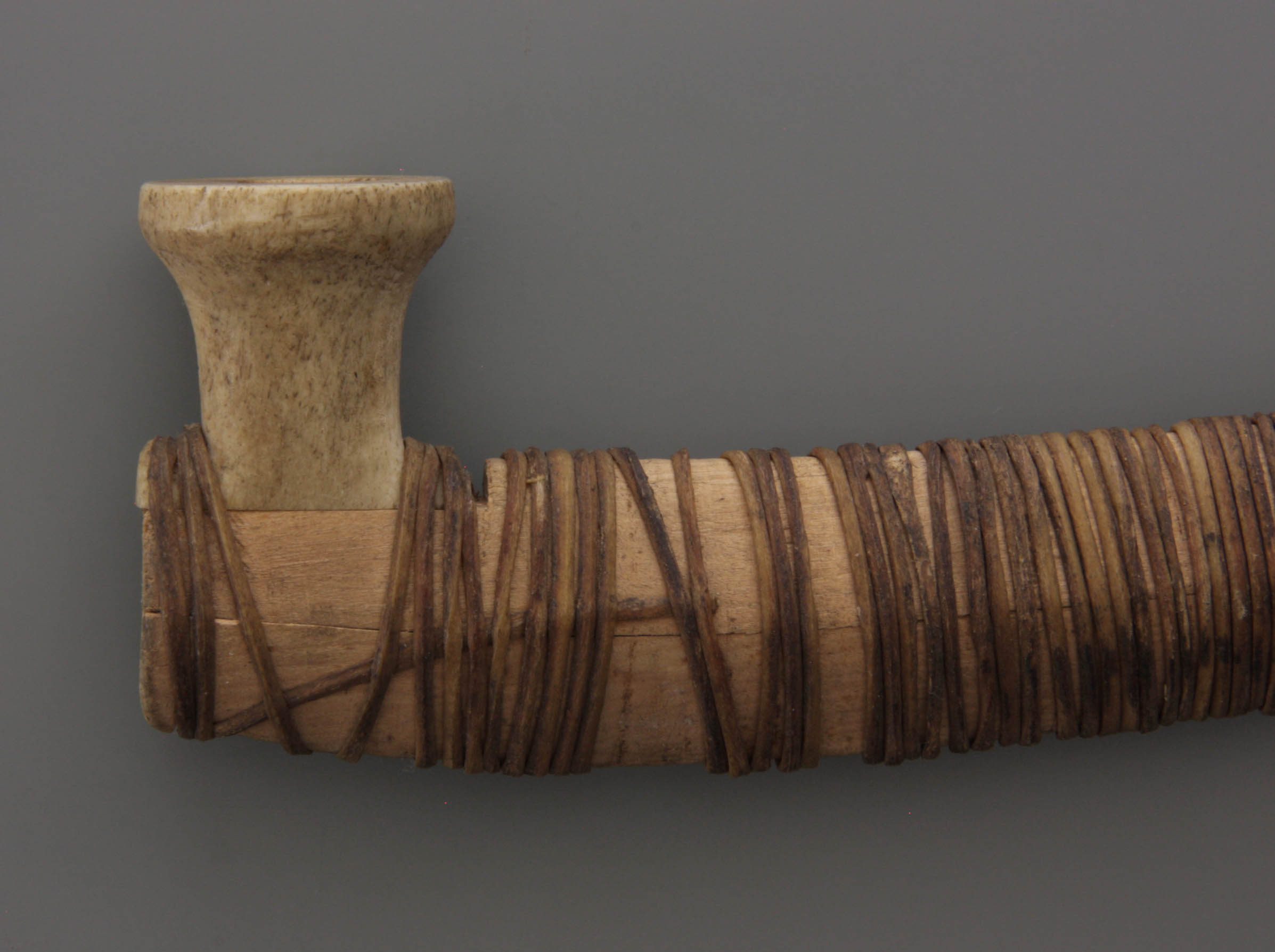
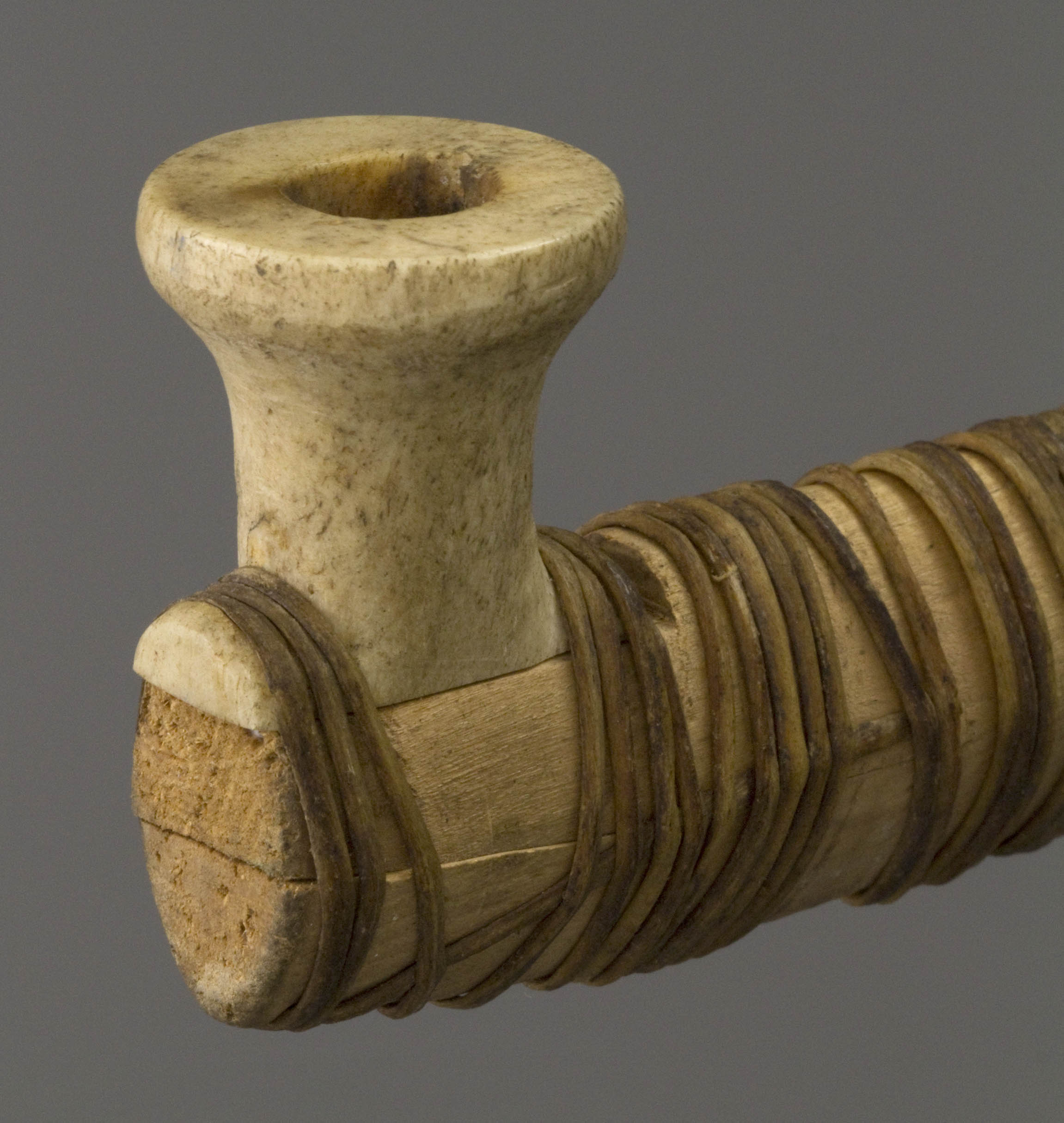
The pipes of the Tongoosk are usually composed of different materials. The stem is of a soft wood type and always has a slight upward bend. These stems often have a diamond-shaped diameter getting thinner toward the mouthpiece. Because they fail to pierce this wood, the stems are made into two halves, each being hollowed out. After the air passage has been made mirror-wise in both halves, they are tied together with a simple piece of wire or cord. This cord gives the pipe a characteristic appearance and, in addition to a binding function, also has a great decorative value. This thread is usually made from fish skin. The literature speaks of seal skin, but in the example shown here it seems more like a gut string or tendon.
For the pipe bowl, a better fire-resistant material must be sought. Sometimes it is metal like copper or lead. In this case, walrus bone has been used that has been cut into a very specific shape. The bowl is funnel-shaped and small and the size of course corresponds to the scarcity of tobacco in the region. A small amount of tobacco can be burned on the funnel shaped pipe bowl. This, evidently matches the economical way of life of the people. A filter of grass or animal hair is inserted into the shaft of the bowl and must ensure that the tobacco, which has been completely burned to ash, is not sucked into the smoke tube. Such a filter against so-called flying ash is also known in other cultures.
In this case the pipe is provided with a separate mouthpiece which is also cut from walrus bone, even provided with a knob nozzle. That nozzle makes the pipe significantly more durable than the soft wood of the base material.
Many arctic crafts are identified as Eskimo from Alaska or more general North American. This object is an exception because it is of Asian origin. The date of this specimen will be in the first quarter of the twentieth century, but the pipe in this form has been in use for much longer at the Tongoosk.
Amsterdam, Pijpenkabinet collection Pk 19.820
A golden kiseru for ladies
From the moment that smoking is known in Japan, a special type of pipe is used. It is the so-called kiseru, a pipe with a small funnel-shaped metal bowl and a bamboo stem. The mouthpiece is made of metal as well, mirror-like to the bowl part. The kiseru will remain popular for centuries, until it is supplanted by the Western European wooden pipe somewhere between the two World Wars. At the same time, the taste experience of the Japanese smoker changes. The extremely finely cut, semi-heavy kiseru tobacco is exchanged for the flavoured European tobacco. The pipe smoker who wants a stronger taste can switch to the cigarette.
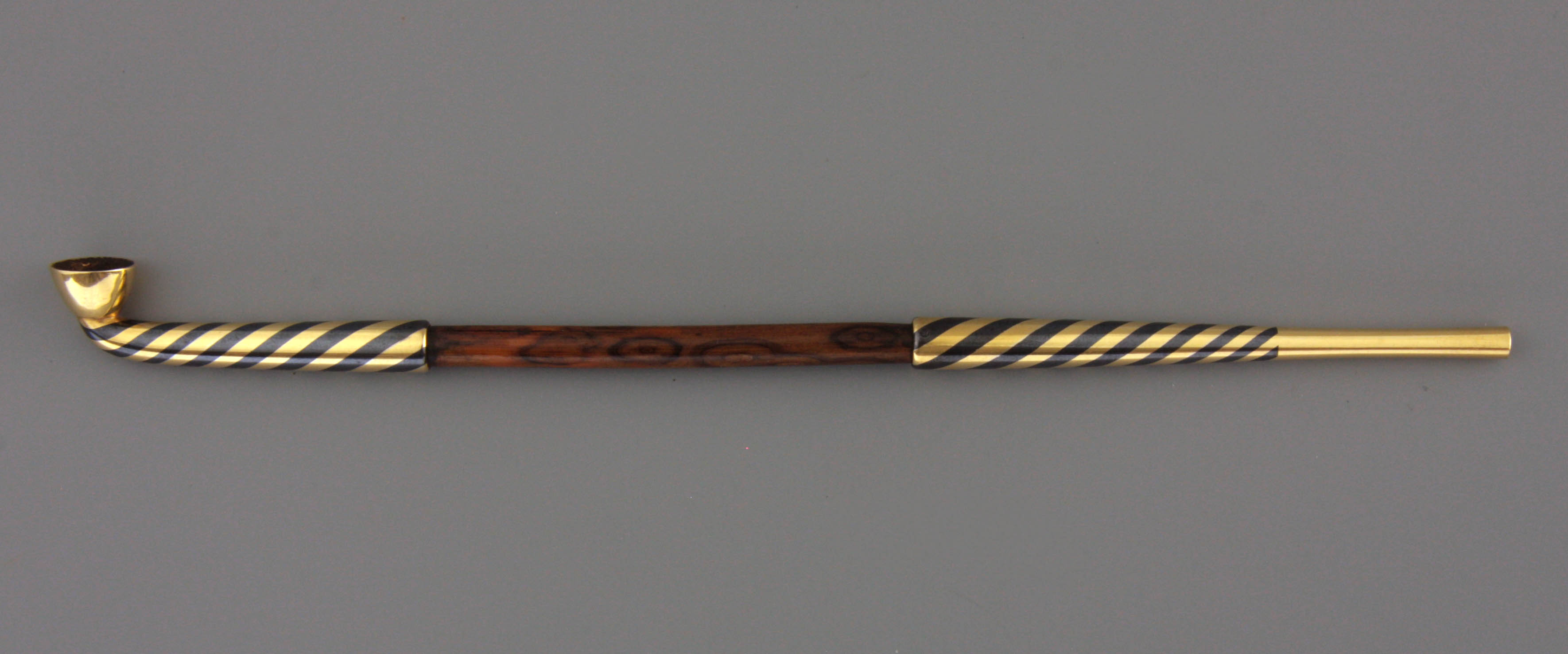
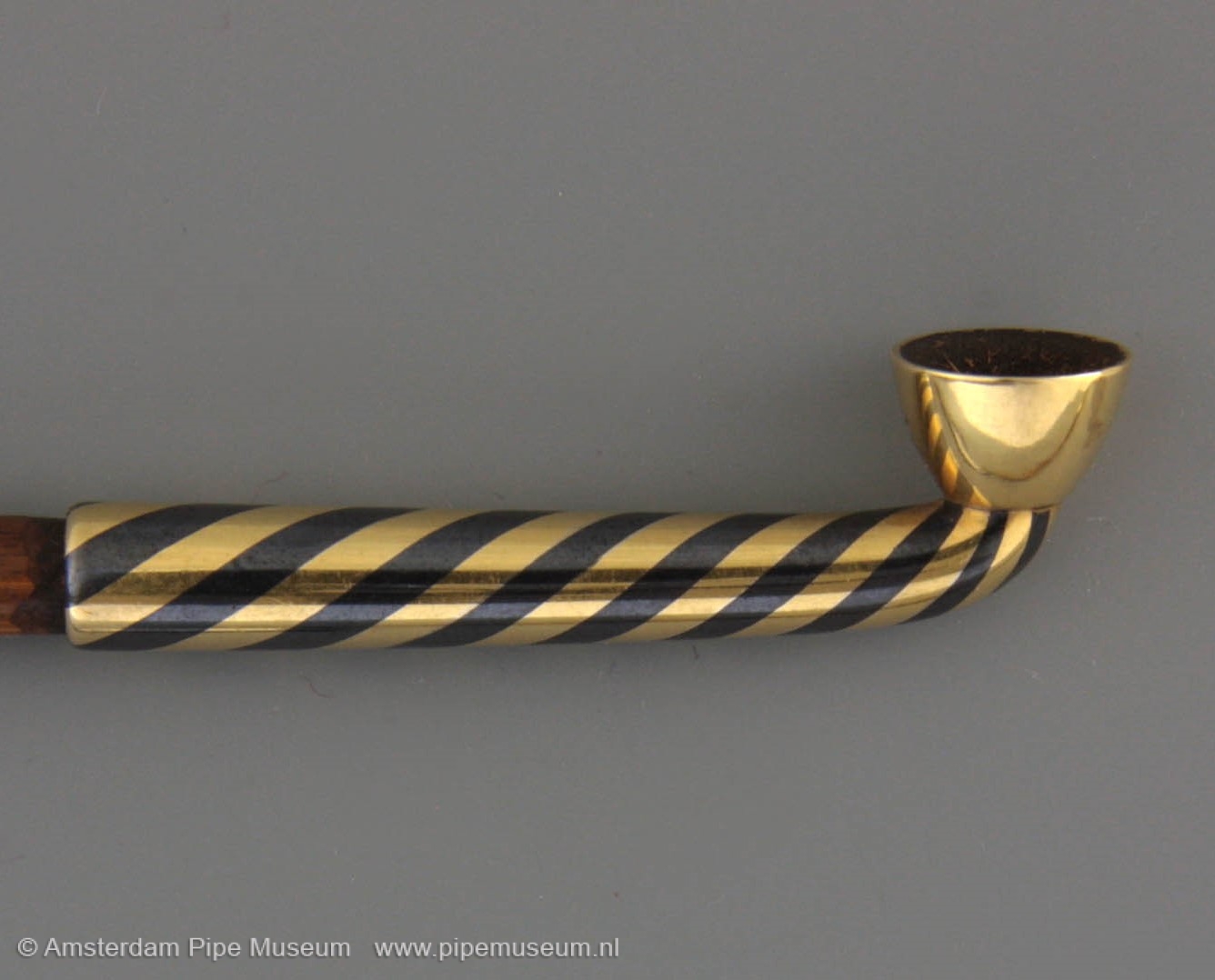
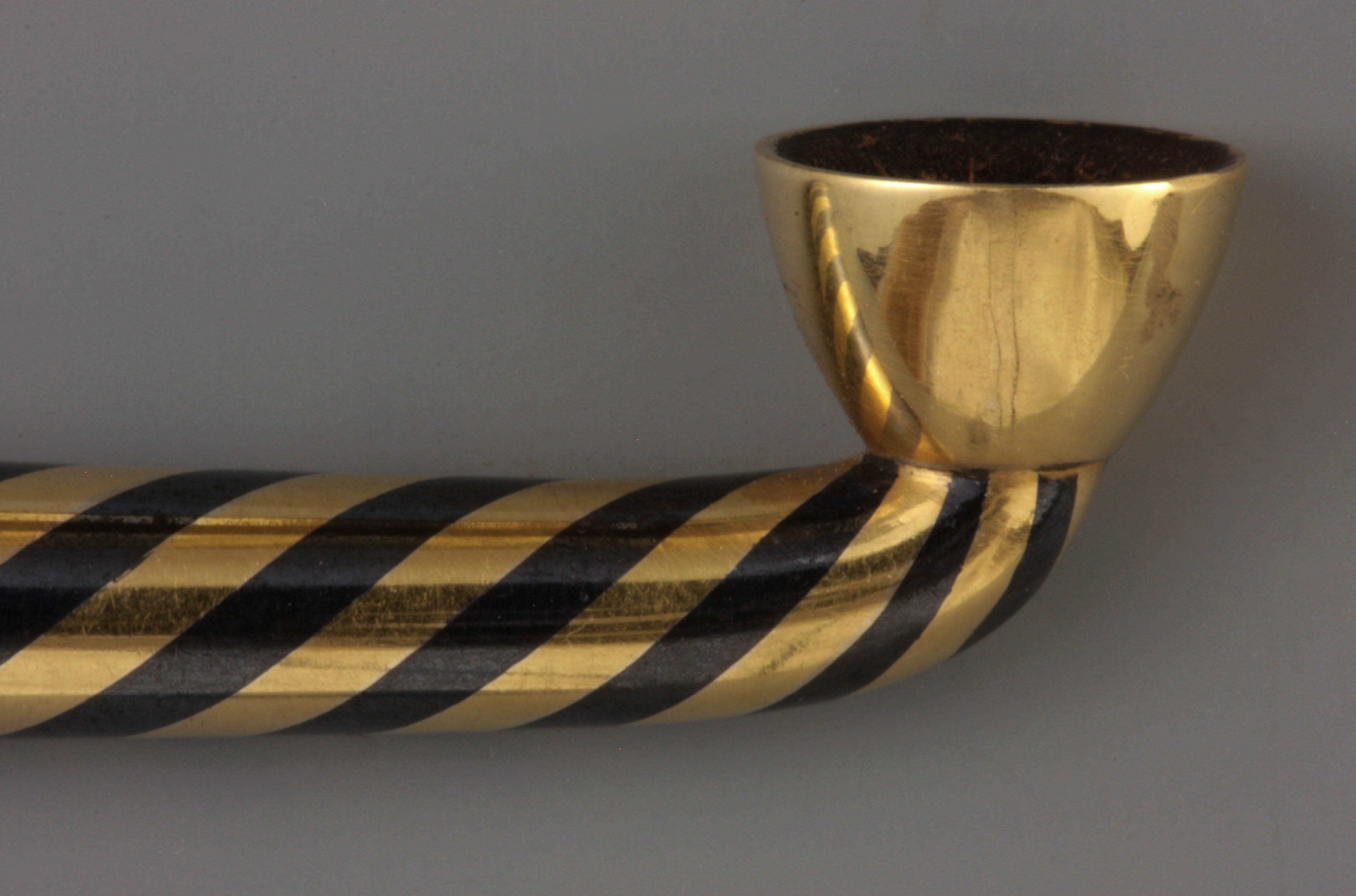
In Japan, both men and women smoke pipe, although there is clear distinction in the smoking instrument. The pipe for the man is significantly larger and coarser, while small and elegant for the woman. The execution of the pipe is also strongly related to the smoker's status: rank and class consciousness of the user can be read from the pipe. A beautiful example of a particularly chic ladies' pipe is this golden kiseru. This pipe is one of the most precious species because of its exclusive appearance. With the most expensive material, no showy but a very modest result is obtained.
With this pipe, the golden surface is left undecorated except for a twisted line applied in a refined manner to both metal stem parts. This was done by engraving the metal, which was then filled in with an alloy of gold, copper and sulphur. This technique called niello and is seen often in silver but rarely in gold. That burned-in mixture resulted in a special bluish tint. After polishing a beautiful smooth surface was obtained with an indestructible decoration.
A date for this pipe is difficult to give. The kiseru is hardly subject to development. Minimal differences in the bowl shape or mouthpiece are the only indication for more accurate dating. With this example, the straight unprofiled mouthpiece and the burnt decoration on the bamboo point to an earlier date. In this case, the Japanese would speak of a pipe from the Edo period. Although that period starts in 1603, this is a product from the last decades of that era, between 1850 and 1870.
Amsterdam, Pijpenkabinet collection Pk 19.672
A prestigious kiseru with carp
The Japanese pipe is called kiseru and is made of metal. It consists of a small pipe bowl in funnel shape with a short stem. The mouthpiece, also metal, is pushed together with the bowl onto a wooden or bamboo stem. The standard pipe is of undecorated base metal such as brass. For those who can afford, there are more luxurious kiserus to show off. At meetings, both private and public, the appearance of a nice pipe can underline the status of the owner. Especially in the nineteenth century the Japanese gratefully took advantage of this fashion and status aspect.

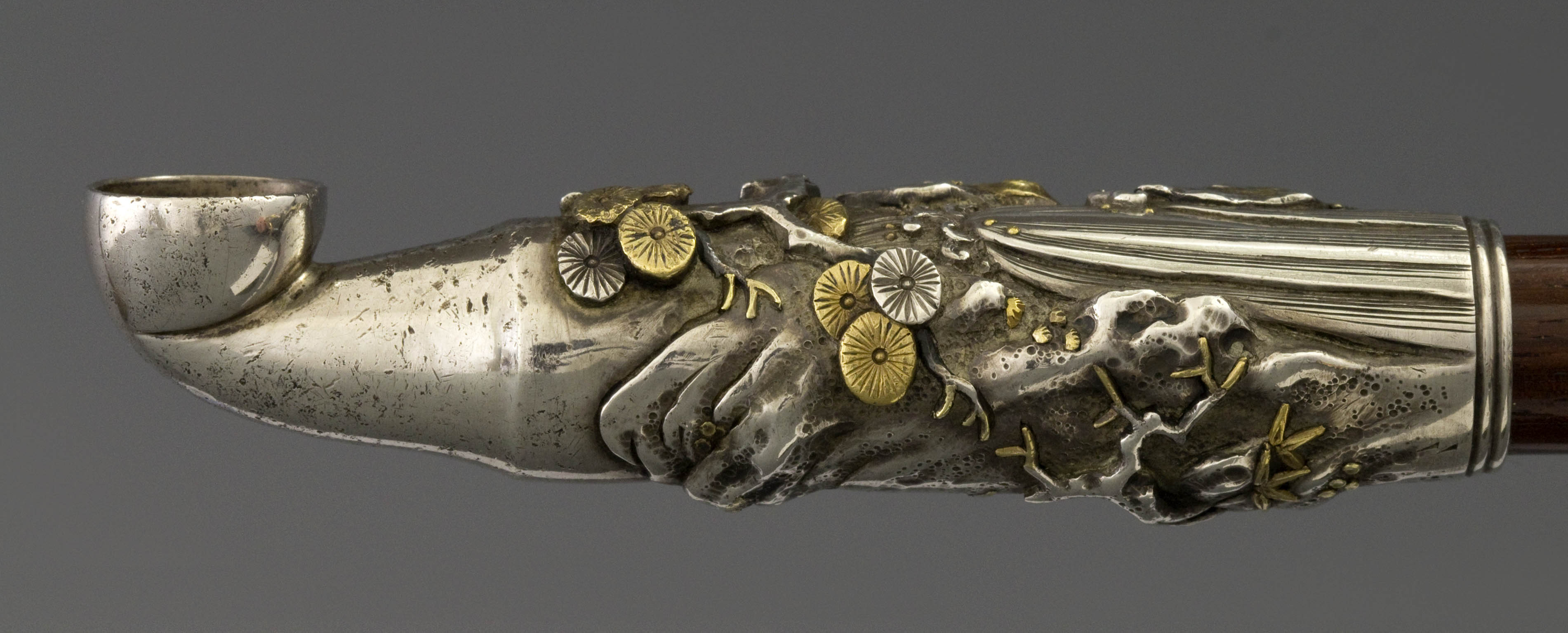
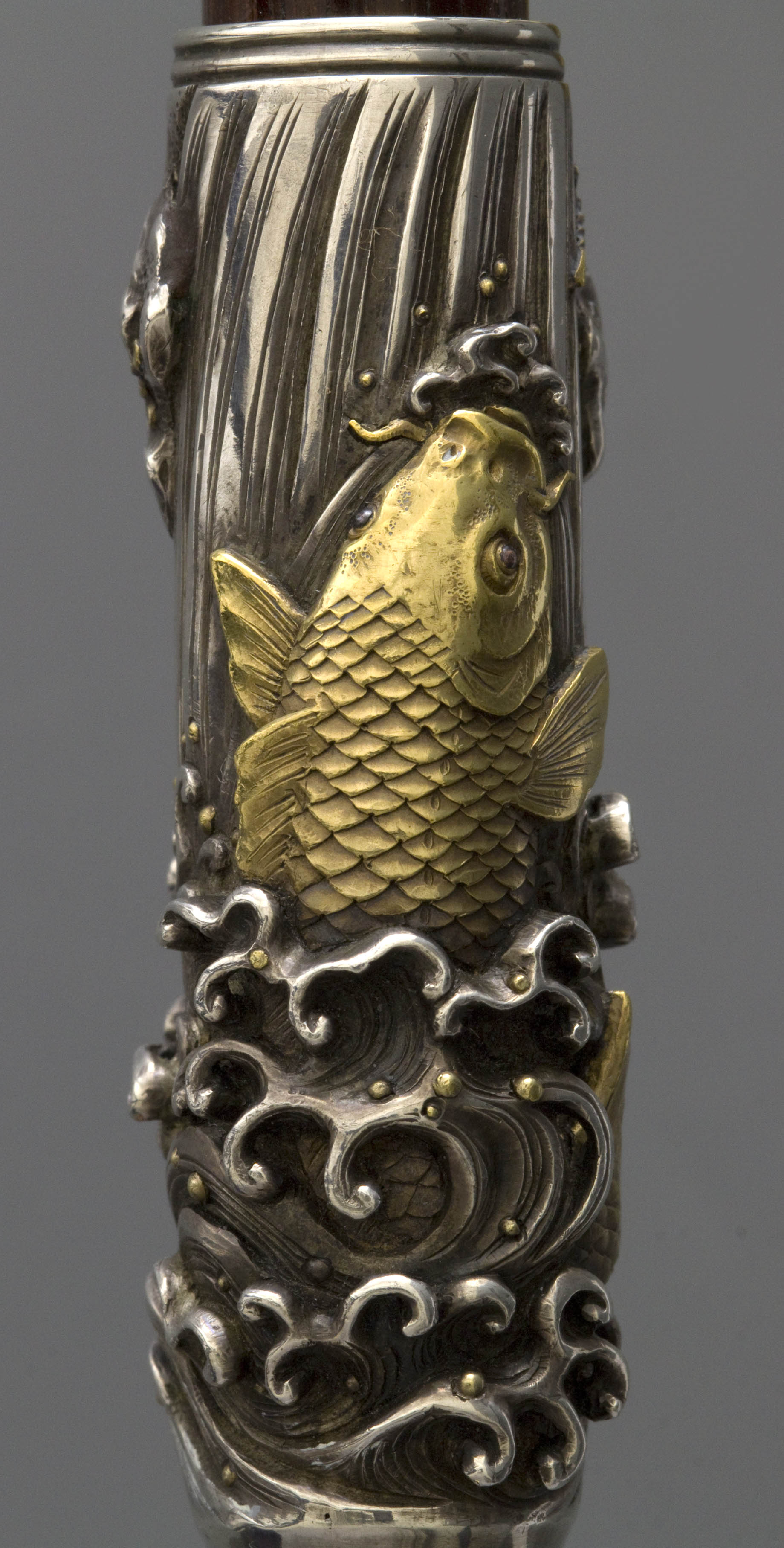
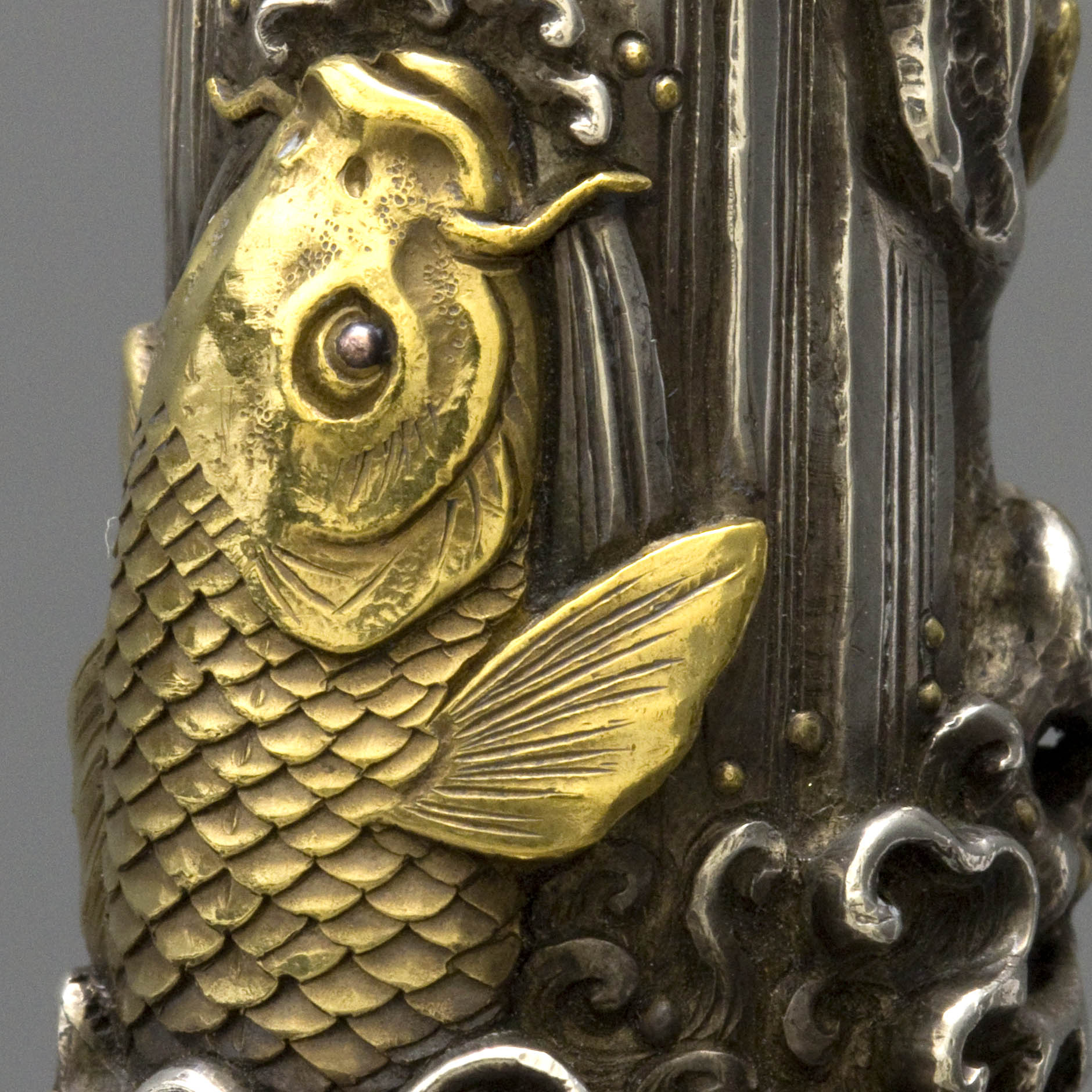
The summit of luxury is shown in this silver pipe, decorated with gold inlays. The two stem parts of the pipe, those parts mounted onto the wooden stem, are richly adorned with a circular decoration of extraordinary craftsmanship. Main motive is a carp rising from the water, beautifully executed in solid, high grade gold that contrasts with the deeper surroundings in a different tint. The foam crests on the waves are very aptly modelled with a strong embossing of the silver. As background, cane stems and leaves are applied in a much lighter relief.
The section near the pipe bowl shows a landscape with mountains in the background. Because the reeds with foam crests are repeated along the bottom edge, it seems a continuation of the image on the mouthpiece. The waves and the reeds disappear unnoticed into rock soil with flowering prunes and other flower bearing plants accentuated in gold. The relatively high relief of the image enhances the depth effect in an extremely clever way. The continuity of the elements all around the stem and of course the close relationship between the two parts makes this pipe so intriguing.
The main motive, the carp is the symbol of perseverance in Japan. According to tradition, carp, in Japanese Koi, would jump every year over the waterfalls in the Hunang-he to reach their spawning grounds. The story went on that when they crossed the rapids with the name Drakenpoort they would turn into real dragons. The carp was therefore also a sign of success. The armour-like scales of the carp made him a symbol of martial spirit for the Japanese samurai.
Inlays of gold in silver was a favourite activity for the Japanese goldsmith who masters his profession. This pipe scores high as an esteemed example of the most expensive types of kiserus existing. Obviously, the question remains: who smoked from such a striking pipe? Rich smokers, that’s for sure, but whether they belong to the elite or to the nouveau riche, that is not betrayed by the pipe, but lies hidden in the sense of culture itself. For the Western European, such cultural patterns are difficult to read.
Amsterdam, Pijpenkabinet collection Pk 19,645
A bat as a pommel
The Chinese opium pipe is characterized by a long tubular shape on which the pipe bowl or damper is placed at a right angle at three quarters from the end. The stem end that is created behind the pipe bowl is used by the opium smoker as a handle to adjust the pipe exactly above the flame of the opium lamp. When heated, the opium vaporizes and the opium taker can inhale the vapour. Bamboo is the most suitable for such pipes because it is hollow by nature and absorbs moisture, but there are status objects ass well of which ivory is one of the favourites.
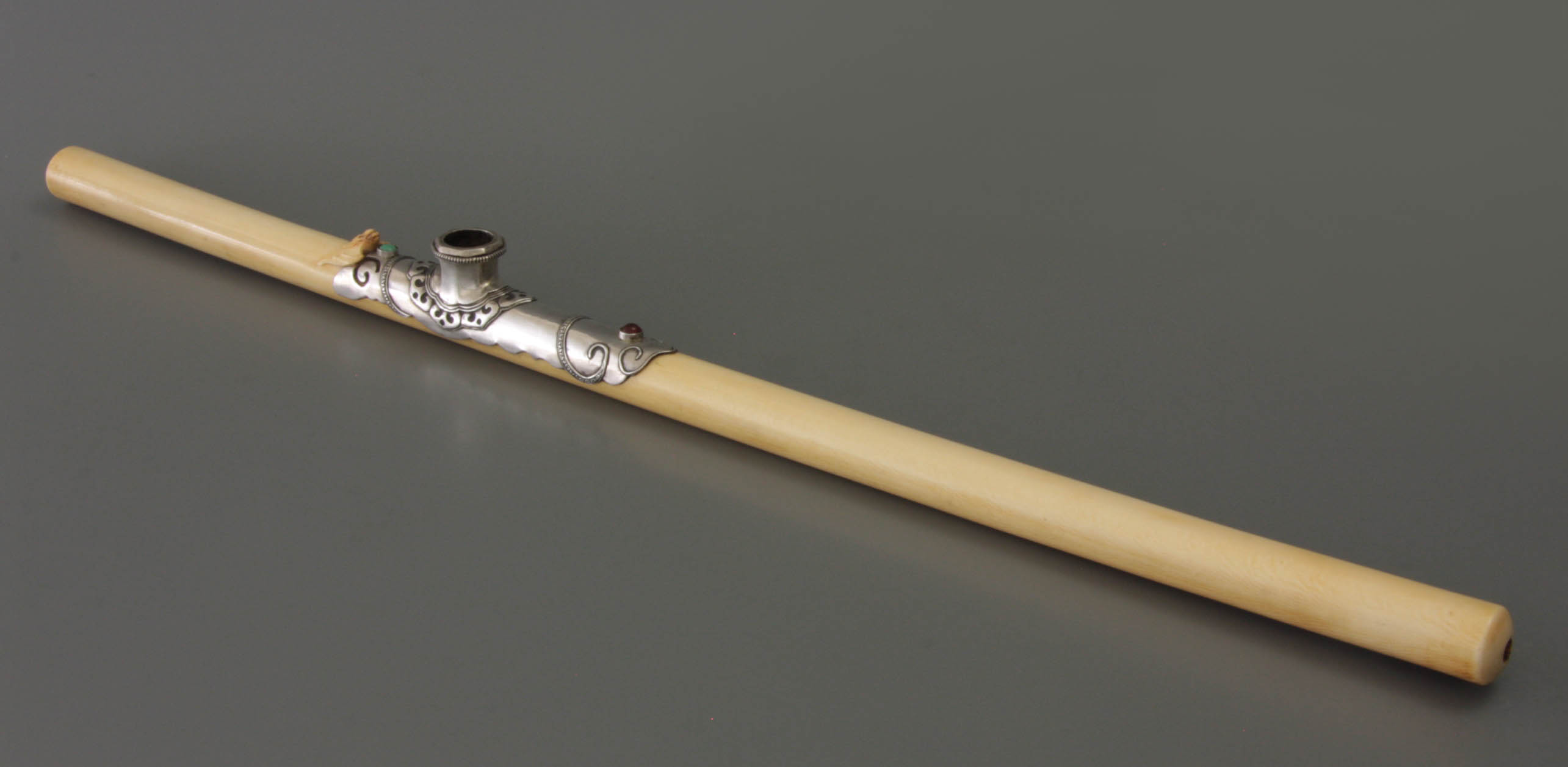
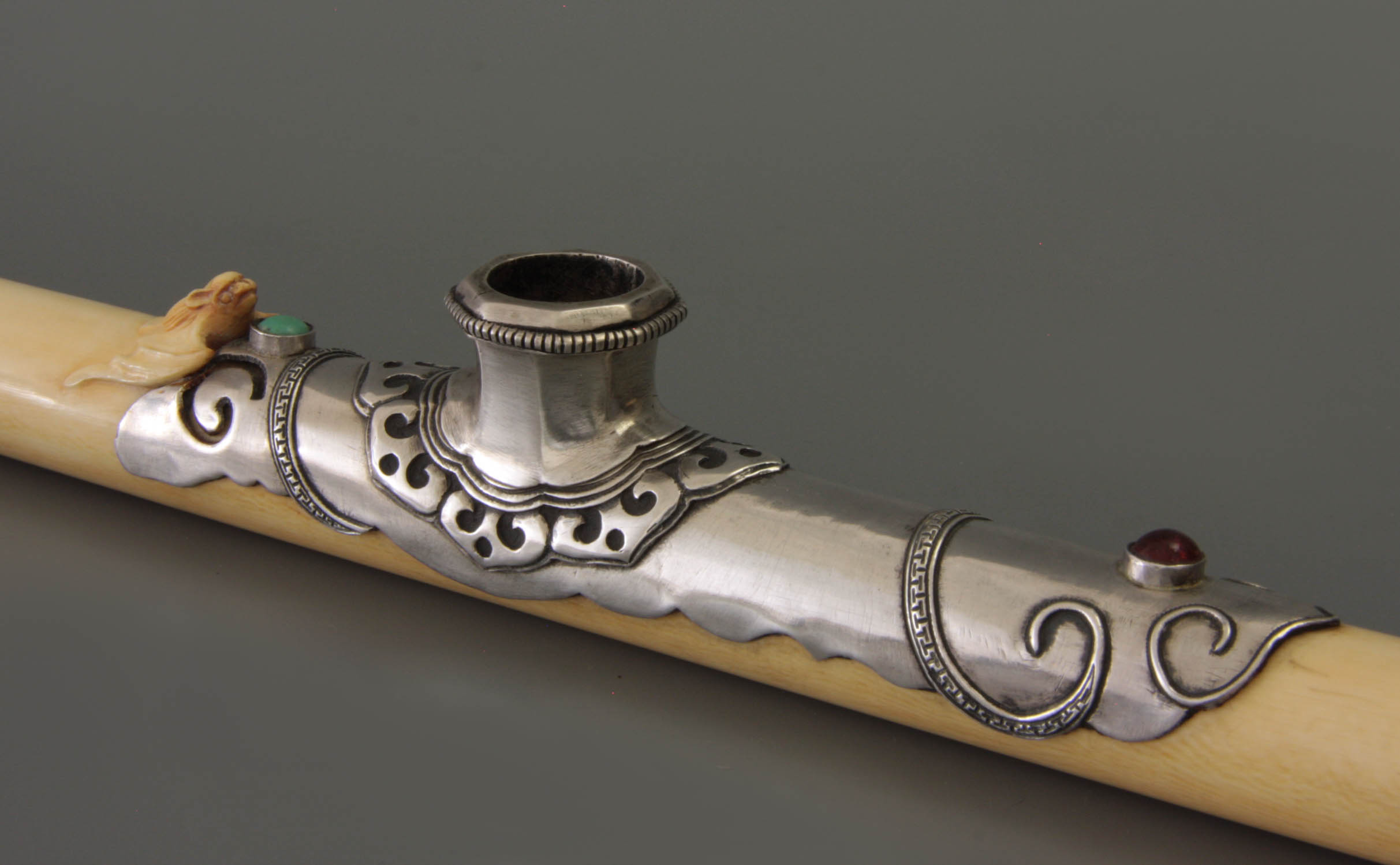
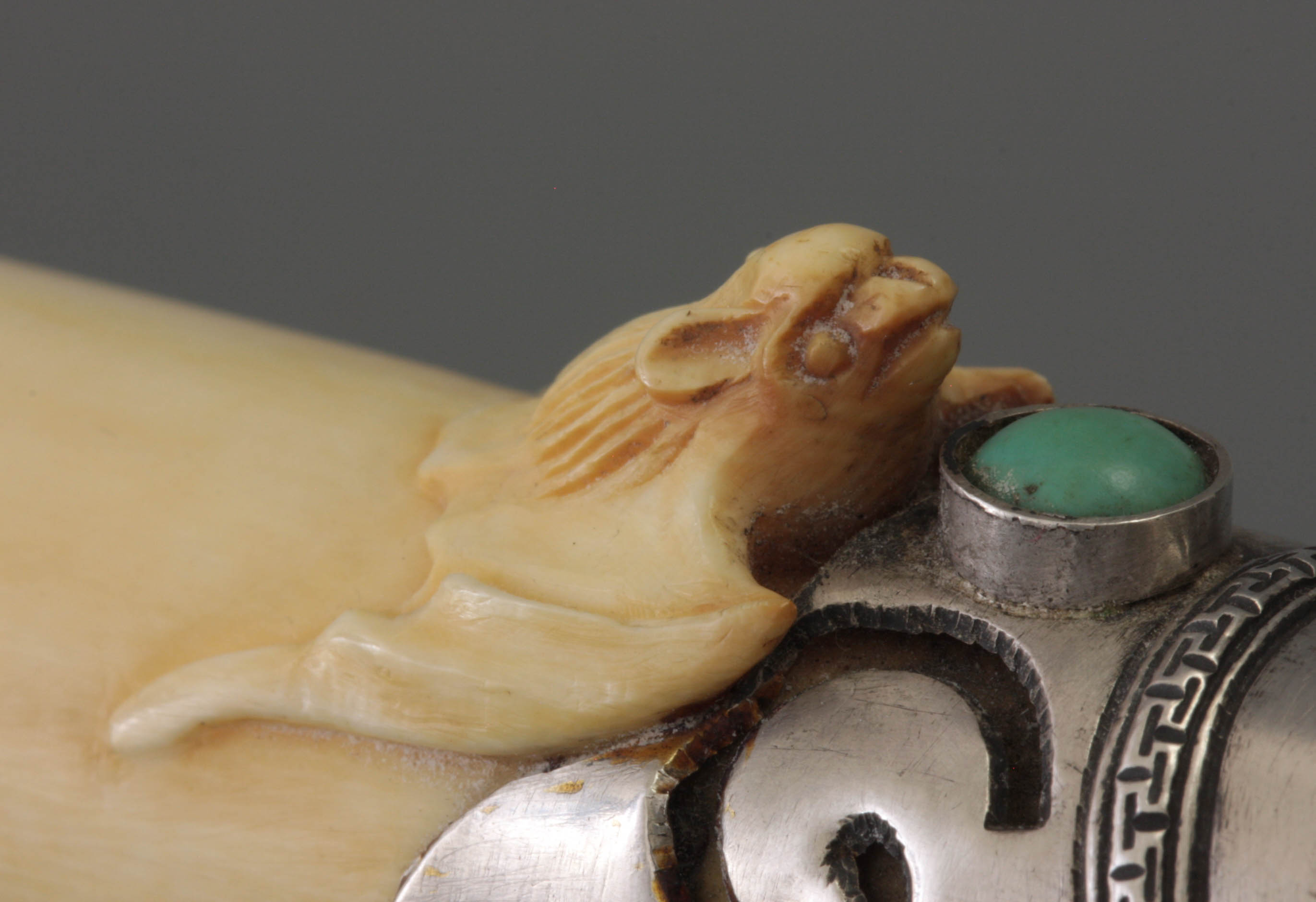
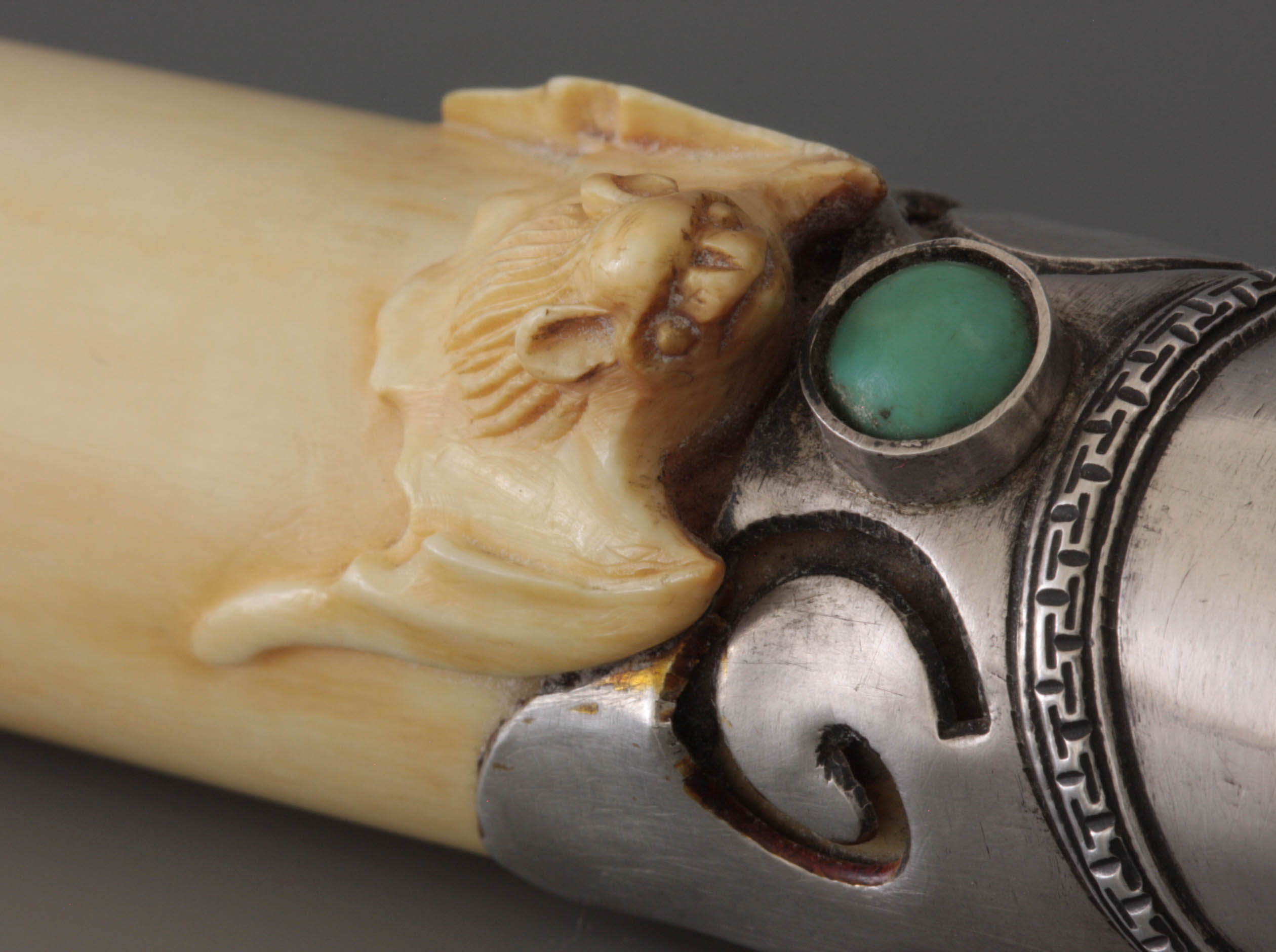
Characteristic of ivory opium pipes is that they show a slight bend, which has caused quite a few speculations. Some people claim that this is the bow of the tusk of the elephant. The carver would like to follow the grain structure of the dental material because this is not only efficient for the use of materials but also favourable for strength: the grain structure makes an object to burst less quickly. Unfortunately, that theory turns out to be incorrect because even the largest tusks are bent too strongly for a straight or almost straight opium pipe. It seems more likely that the pipe maker did not take into account the grain structure of the material because he was bound to make the product as straight as possible. The very slight bending of most opium pipes could have been caused by the autonomous action of the material.
Enough about the theory of the straight and slightly bent opium pipe. The most special aspect of this pipe is not the minimal curvature but the pommel. Opium pipes are tilted to one side when they are smoked. In order to give more grip on the polished stem during this tilting, a pommel or finger rest is always applied to a serious opium pipe. In bamboo pipes this is usually the beautifully cut shoot of a side branch. In ivory this pommel is carved out of the ivory. When turning the tube shape of the pipe, a solid block was saved for this purpose, from which later on a figuration was cut by hand. In terms of subject, the Buddha is the most common in the ivory pipe. With this pipe, the carver choose for the heavenly rat, or in other words a bat with a spread of wings, for the Chinese an important sign for longevity, but also for joy and good fortune. The animal is shown in a slightly stylized manner and becomes the fixation point for the eye of everyone who watches this pipe.
The bowl itself is connected to the pipe by a saddle. This connecting plate on the stem of the pipe opens into the centre in a circular holder for the pipe bowl. In accordance with the luxurious nature of this ivory pipe, in this case the saddle is made of silver. It has beautiful wavy contours and is further adorned with two semi-precious stones in circular setting: a cloudy green and a transparent brown-red stone.
All in all it is a simple yet chic pipe. Modest in appearance but exclusive in material use. It is clearly a pipe with a high status. Ivory pipes were not the best to use, but the most appreciated as a showpiece. We can notice the show factor of this pipe: it has been used minimally and is therefore beautifully preserved. The origin is China, impossible to give a more specific region of origin. A qualification as being from the Canton region is often given but without foundation. The date lies between 1880 and 1900.
Amsterdam, Pijpenkabinet collection Pk 17.415
Pipe making tools
An oversized press mould
The highly developed Gouda pipe industry had classified its products into categories. The so-called maatpijp was the pipe with a certain standard length. All pipes longer than that type were indicated with bovenmaats of oversized. They were products with a stem length over 21 inches or longer than 55 centimetres. The longer pipes went up in four steps, each with their individual name. They were made only by the best manufacturers, who were able to attract work force capable of doing this difficult job.

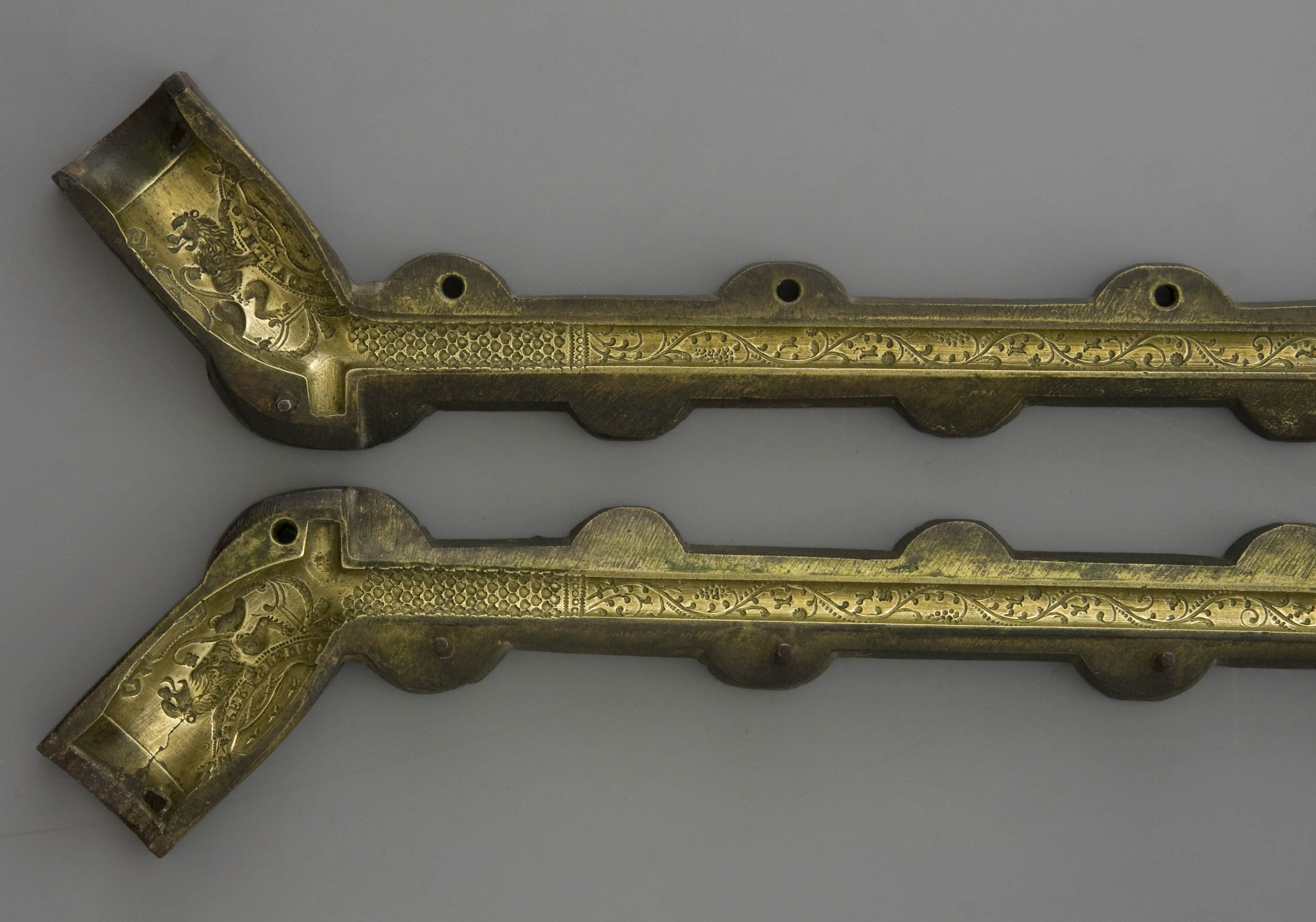
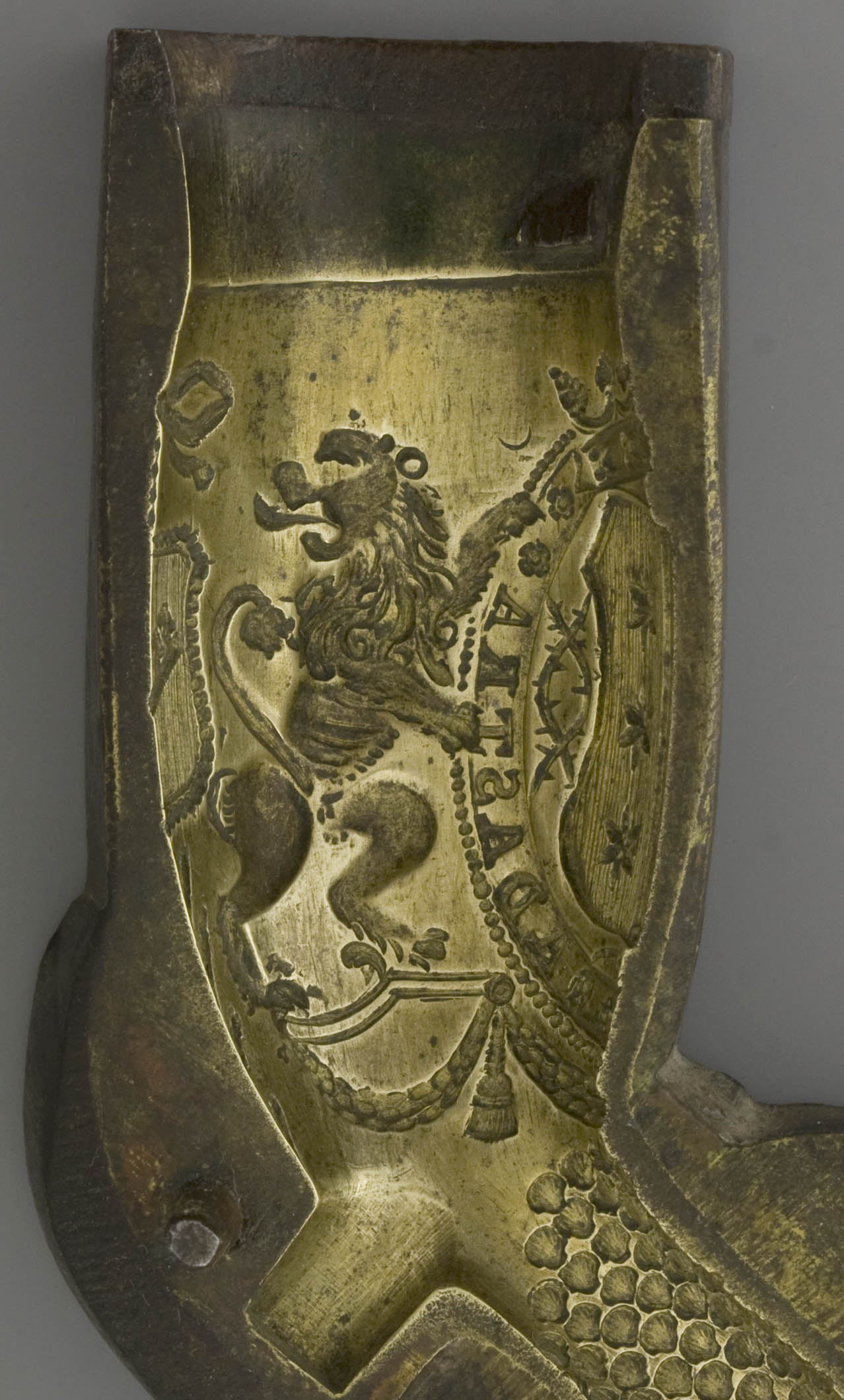
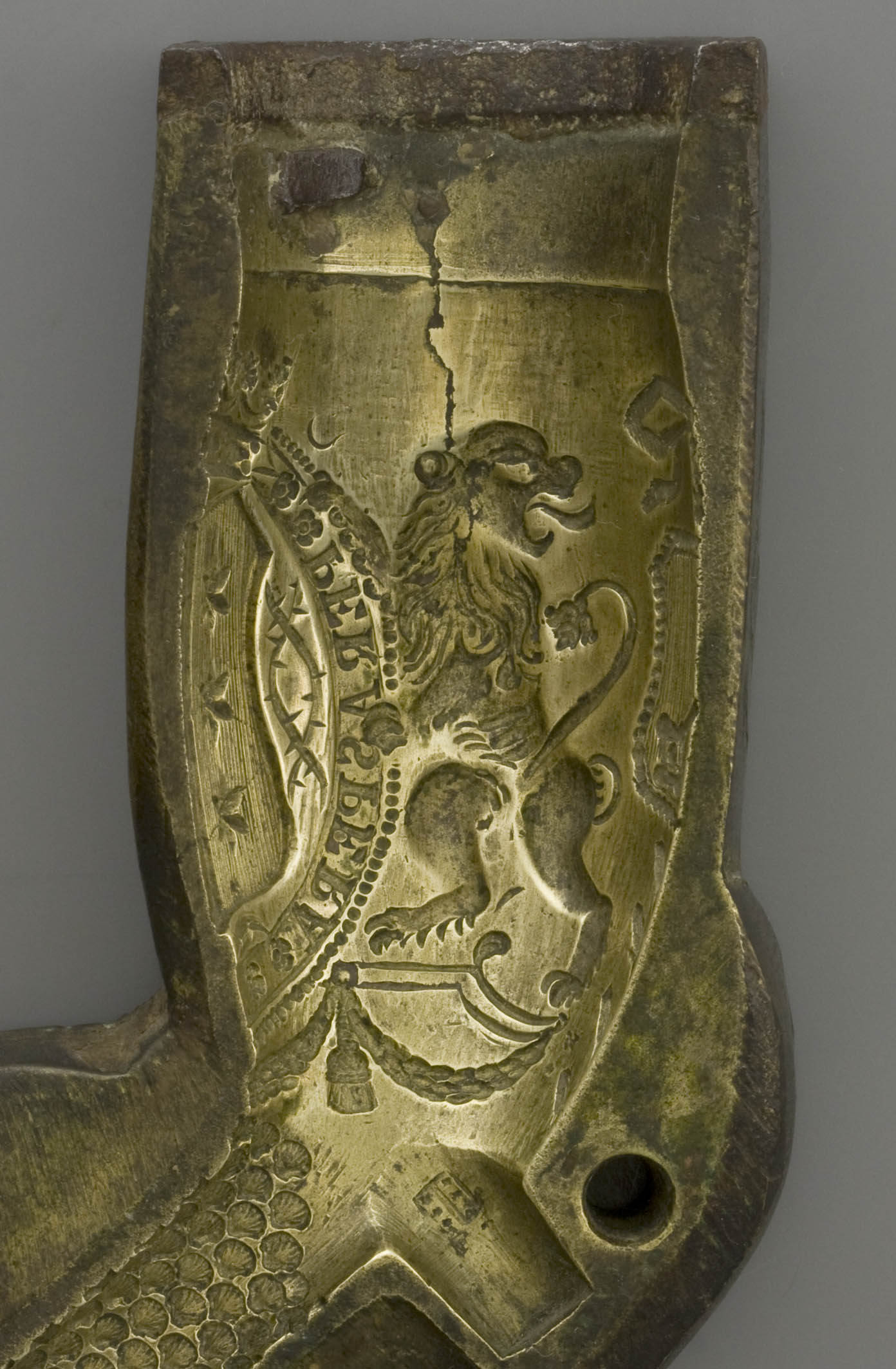
Such a manufacturer was Willem Begeer, since 1792 master pipe maker in Gouda. In his company they focused on the higher quality category, not surprisingly including the oversized pipes. A really well equipped manufacturer even delivered every stem length in two versions. The smooth one as standard pipe, obviously the most commonly sold. In addition, a worked version was made, a high-decorated pipe that was donated as a gift to a gross of ordinary pipes. Of course, these pipes were also available separately, usually in quantities of a quarter of a gross because the higher price kept their sales limited.
This so-called 33 inch press mould was engraved around 1815 at the request of Willem Begeer. The press mould consists of two parts that close with pin-hole connections. In the bowl of the pipe the coat of arms of the city of Gouda is engraved, framed by a ribbon saying "PER ASPERA ADASTRA" or along rough roads to the stars. The shield is held by climbing lions, the heads turned away of the shield, standing on a simple lambrequin. Interesting is the reverse of the bowl. Here the coat of arms of the city of Bremen is shown, consisting of a slanting key.
Even the stem of this pipe has been extensively decorated. It starts with a band of shells and continues with a swaying floral tendril with bunches of grapes. In the windings of this tendril, minute jumping dogs are punched as decoration. At the centre of gravity of the pipe this branch is interrupted by a band with an oblique twists. Along the stem Begeer mentions his name as a signature. The last piece of the stem is undecorated.
With a stem length of almost ninety centimetres you wonder who has been the target group for these pipes. This question is explained by the coat of arms on the reverse of the pipe bowl. In the German Hanseatic cities the oversized pipes were extremely popular. They were smoked in coffee houses, but also at private homes. Both men and women eagerly used it. It is therefore not surprising that Begeer put the Bremer coat of arms on the pipe bowl to satisfy his German customers. By doing so, the pipes matched the consumer demand in that region optimally.
How long the press mould was kept in use is unknown. A complete pipe from this mould was not retained. Supposedly the production stopped already with the death of Willem Begeer in the year 1844. Two other manufacturers have then had this press mould in their possession, but it is not clear whether they actually made production. From functional point of view, this was certainly possible because the press mould doesn’t show excessive wear. It was the changing fashion that caused that these extremely long clay pipes were no longer in demand. Waiting for new production, the mould survived its time and shifted in relevance from production material to museum object.
Amsterdam, Pijpenkabinet collection Pk 10.000
The agate stone as a quality symbol
Very few tools have a baffling aesthetic value. Logical because they are not made as an ornament, but as a means of production. This agate stone is an exception to this rule. It was used in Gouda to smooth the clay pipes. The so-called geglaasde pijpen, stroke burnished pipes had already been invented by the first generation of pipe makers dating back to before 1600. In Gouda, this use developed to the highest level. The agate stone became the symbol of the most beautiful and expensive pipes, the so-called porceleyne, porcelain quality.
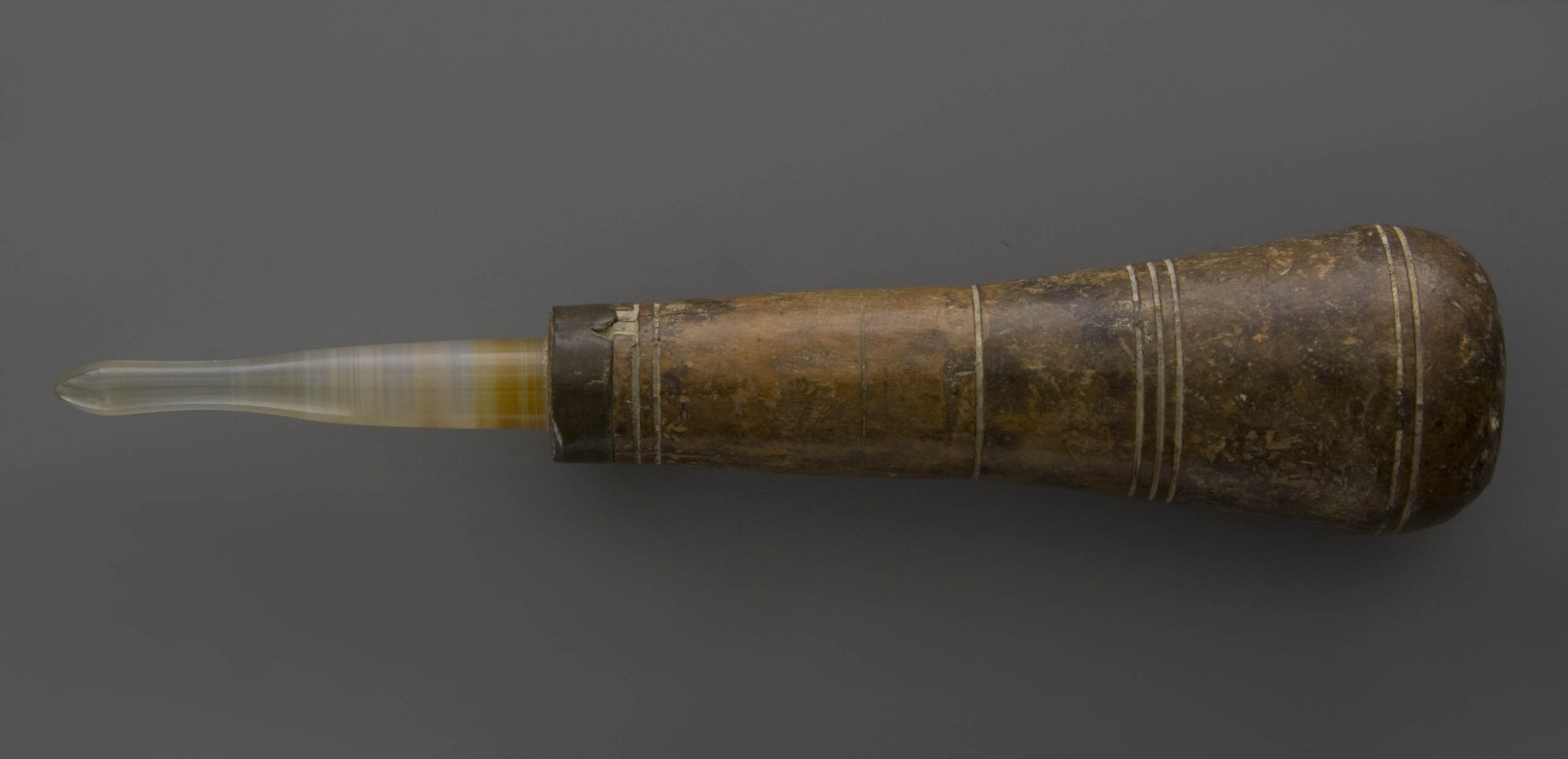
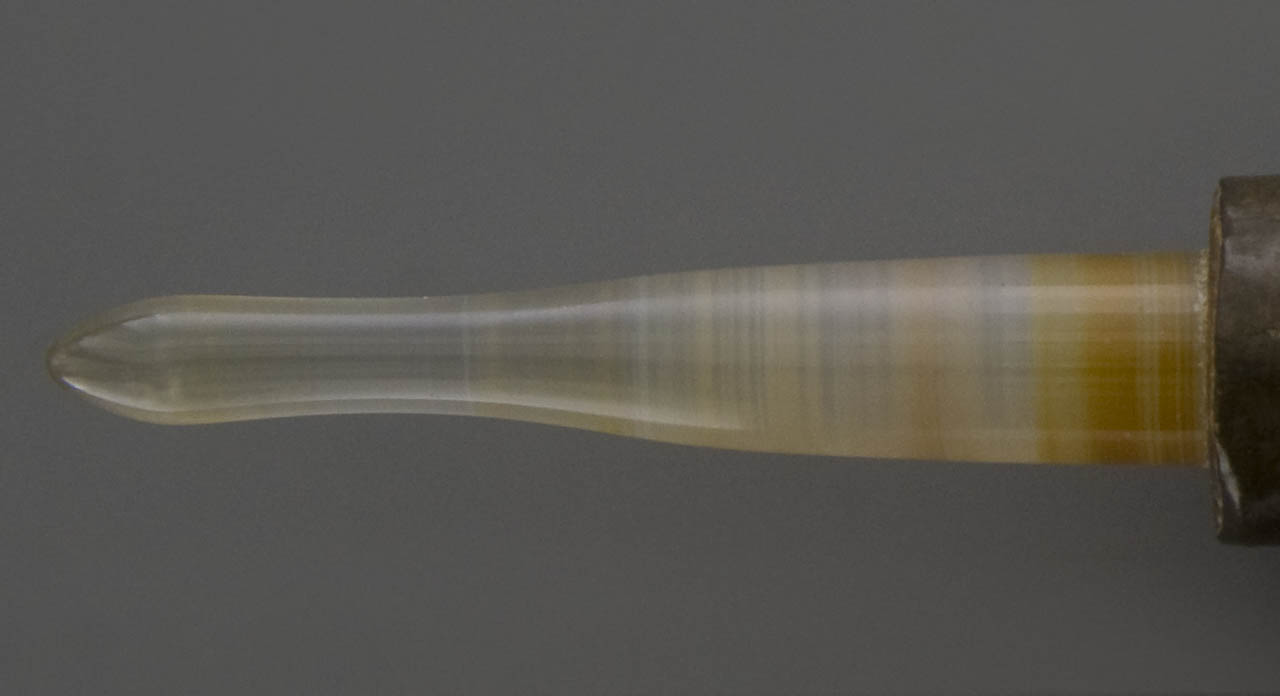
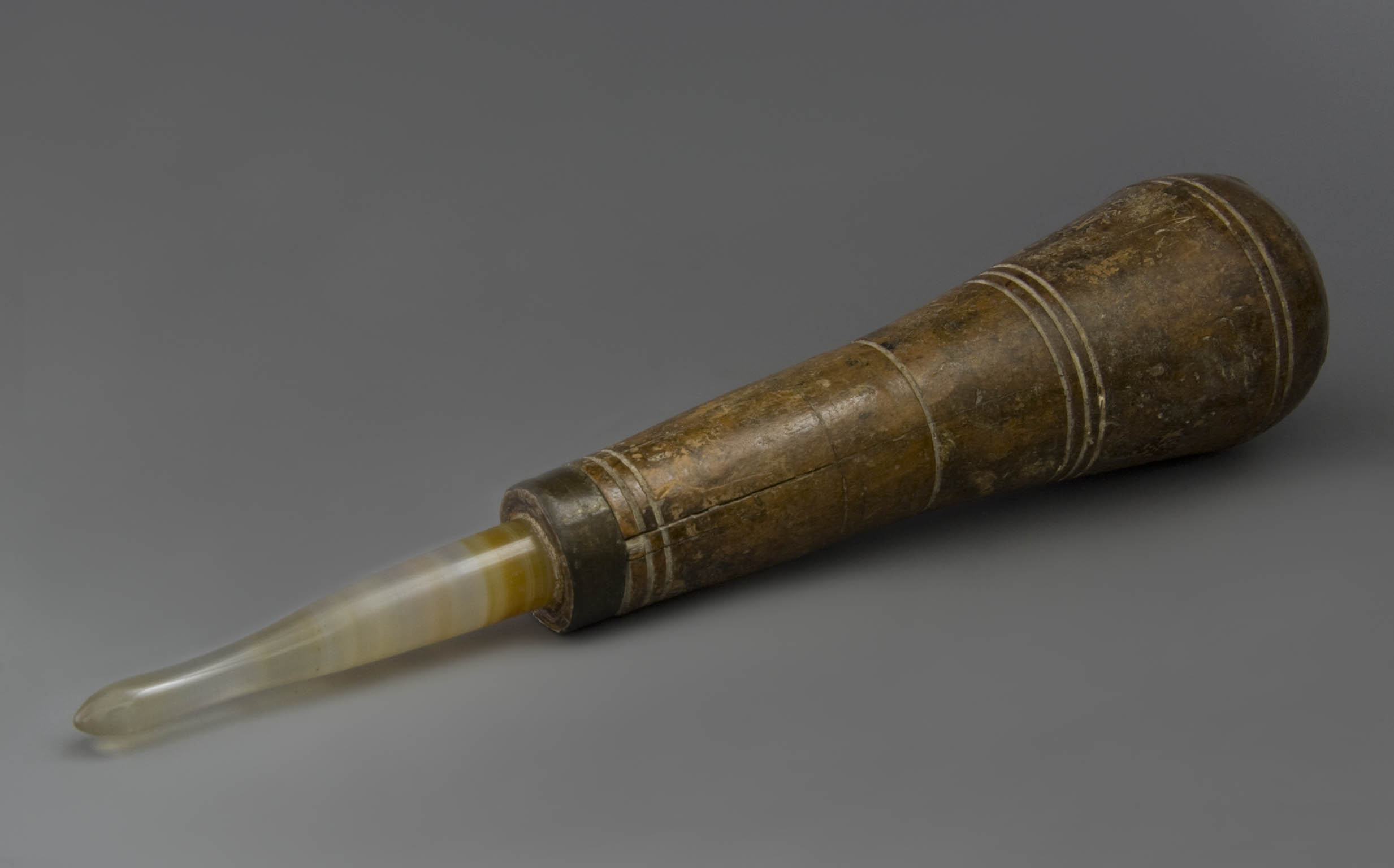
The stroke burnishing was done by women, who were usually older, because the burnishing was not a heavy job but a task that had to be done very cautiously. These so-called glaasters stroke with the agate pin along the leather dry clay and forced the clay plates in one direction. After the pipe was baked, a beautiful shine was obtained. For the best specimen that shine was enhanced by rubbing the product with some white wax.
In the pipe making workshop the agate stones were issued to the female workers by name. A glaaster signed for receipt and the manufacturer knew exactly how many stones were in circulation at his workshop. The purchase price was high, they were the most expensive piece of hand tools. The care for the stones was therefore well-founded. Rumour has it that the tools were called glaassteen, literally glass stone, in order to keep the employees in the dark about the preciousness of the stone.
What makes the tool shown here so special is the beautiful layering that is at right angles to the stone and thus shows an attractive pattern of stripes. Furthermore, the handle is striking, not turned out of wood but out of bone. Usually murky stones are used, ultimately it was about the use and not about the ornamental. The handles were made of ordinary roughly finished wood. With the help of a brass or iron ferrule, the stone was attached to the handle. What has inspired the maker to deviate from this custom and to make such a luxurious tool is still the question.
Due to its careful execution, this tool certainly gives the impression that it is intended to be exhibited. That is very possible. From the beginning of the nineteenth century the Gouda pipe makers exhibited at national and even international exhibitions. In addition to their product, the tools were also displayed to show visitors how the manufacture of pipes worked. This stone could very well be made for such a presentation. The fact that the wear and tear is minimal this might be a sign into this direction.
Amsterdam, Pijpenkabinet collection Pk 5.261
The mark panel of the Gouda pipe makers
From 1660 onwards, the Gouda pipe makers were united in a guild. This guild stimulates the economic possibilities of its members and the result is that the Gouda pipe industry is growing tremendously. With the increase in the number of independent bosses, the number of pipe marks is also increasing. For the guild it is becoming more and more difficult to register it all. It is not surprising that the board decides to make a mark card, on which all marks are depicted.
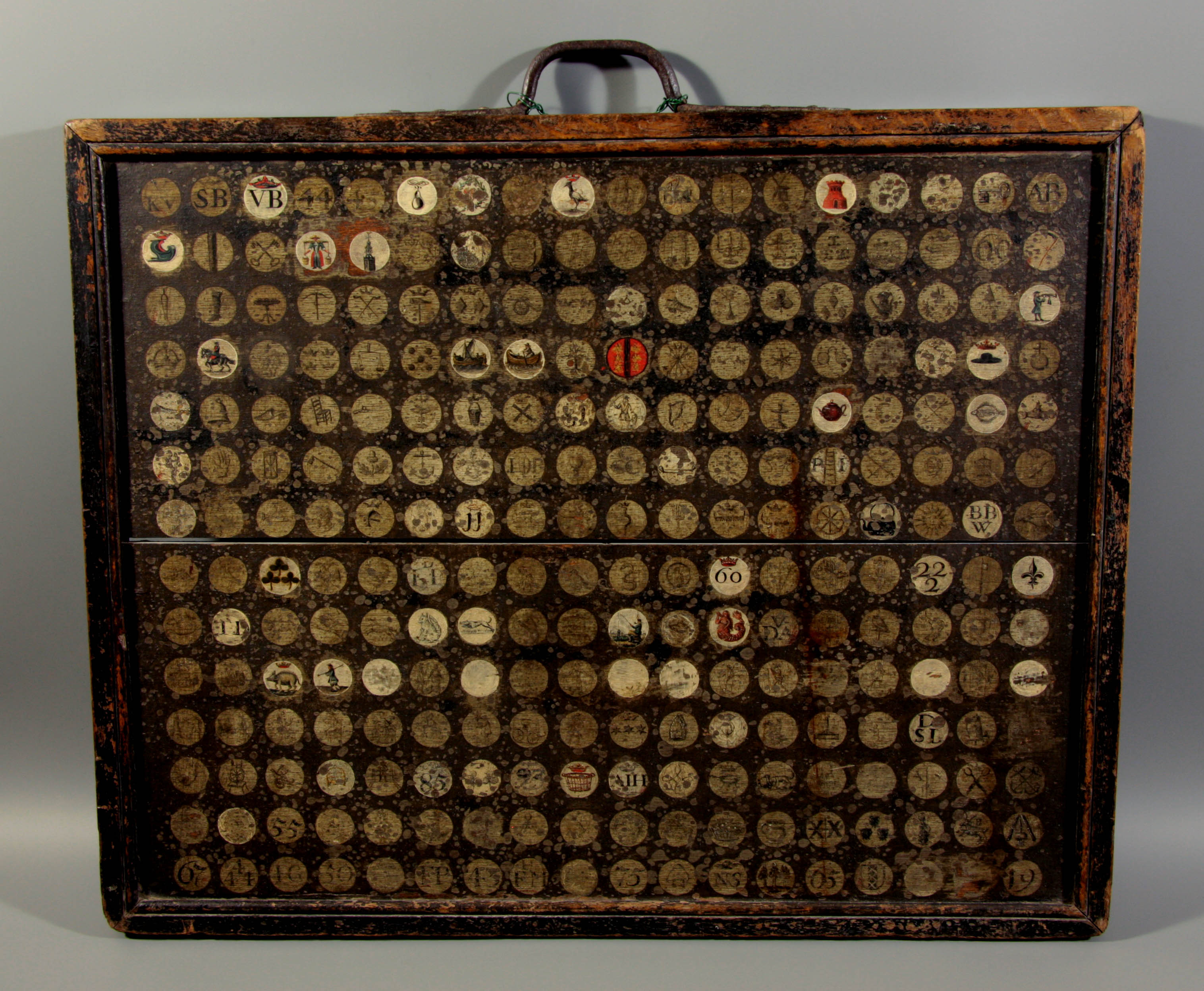
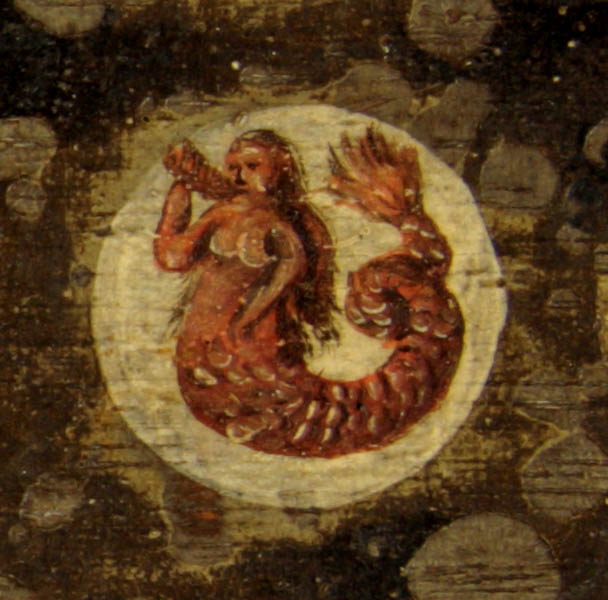
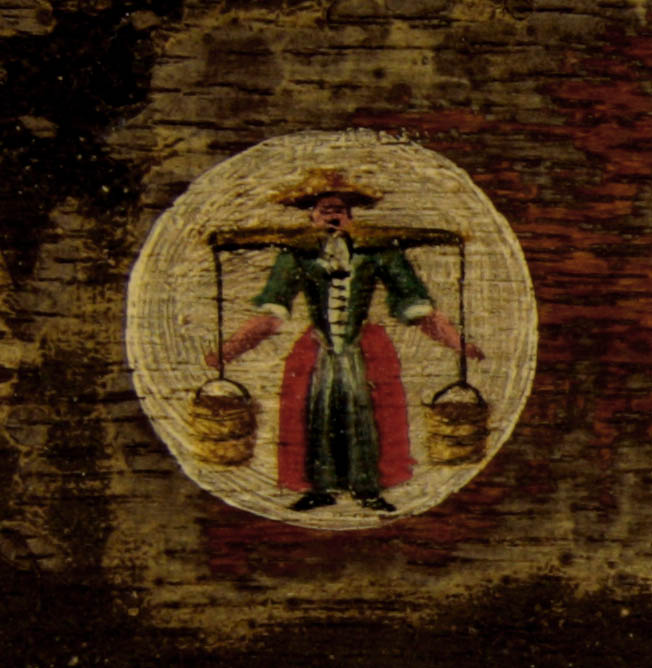
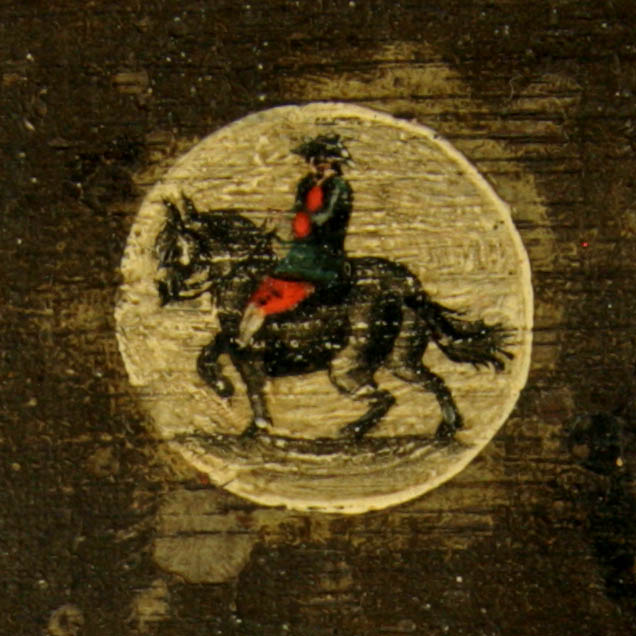
This card is not a paper or cardboard administration but a wooden panel on which the marks are painted. That panel soon becomes the symbol of the mark protection that the guild tried to guarantee. The servant of the guild would be able to visit the workplaces with the board in hand if there was reason to believe that a certain boss did not follow the correct use of the mark. At meetings, it also served as proof of supposed similarity of marks or other service in disputes.
As a carrying board this object served until it was substituted in the 1770s by a large mark board that decorated the walls of the guild room. A new painting was then made of the marks then in use. From that moment on, it became a use to overdye the banned marks and those marks that had become out of use. This obsolete mark panel was no longer updated. However, sometimes a mark has been erased and replaced for another.
When in 1908 the guild records and insignia of the Gouda pipe makers were handed over to the municipality of Gouda, this mark panel was not there. According to say it had been left at a meeting during a quarrel and was taken home by one of the manufacturers. That was in a period when people did not take it too seriously with the historical material of the pipe makers guild. Eventually the panel came in the possession of Pieter Jacobus van der Want, a manufacturer and director of one of the oldest companies, having a serious interest in the history of the pipe industry. For years, this sign hung over the canapé at the family's home, next to a pamphlet about alcohol abuse, another hobby of the manufacturer. The next generation was less committed to history and put it away in a cabinet. So it survived the time until it was given on loan at the opening of the Museum De Moriaan in Gouda. That was in 1938. In 1953 this sign was retrieved. The manufacturer did not agree with the one-sided presentation in the museum of the Gouda pipe industry and he was right.
The sign would no longer return to Gouda. Not long after the appearance of the standard work on the Gouda marks by Don Duco, the mark panel was granted to the Pijpenkabinet in Amsterdam. Since then, it has been a permanent exhibit as a symbol of the long-lasting endeavour of the Gouda pipe makers for mark protection, but also as a silent opposition to the lack of interest shown by the Gouda museums for their local pipe history.
Amsterdam, Pijpenkabinet collection Pk 17.424
Printing block of allure
In the eighteenth century it was fashionable among the Gouda pipe makers when bringing their pipes on the market, to provide these with a brand paper or velletje. These long and narrow paper sheets were printed with a central mark of the manufacturer, usually in an appropriate frame. The brand paper was fixed around the baskets or barrels with pipes and served as a seal for the merchandise. It was also custom to write an address on it when the pipes were shipped.
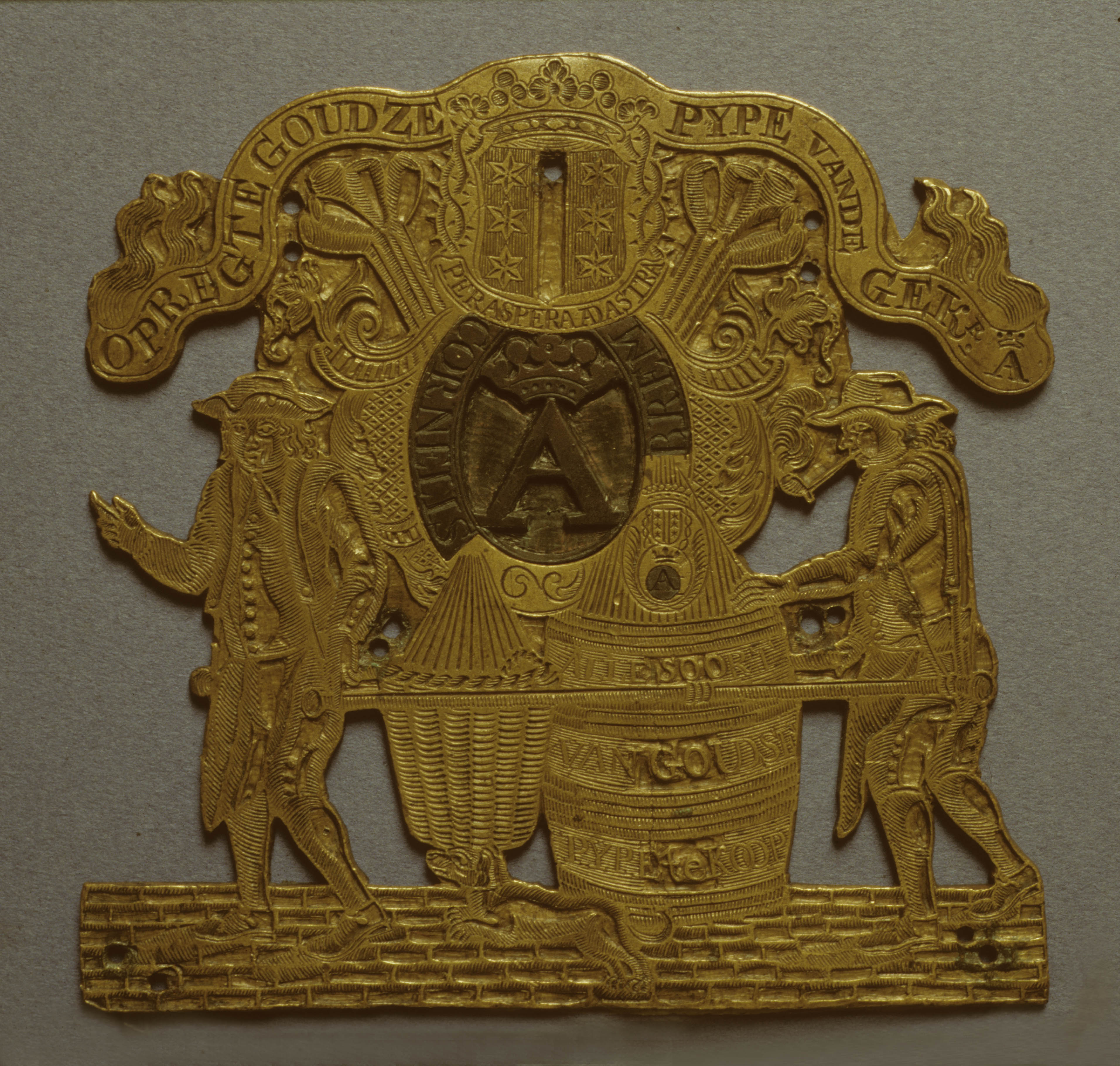
Already in the first half of the eighteenth century, beautiful mark frames were created with the name of the supplier, the arms of Gouda flanked by bunches of clay pipes and additional praise. Most pipe makers used a standard mark vignette. A very appropriate image of exceptional design is the printing block shown here: two pipe carriers walking on a cobbled street with a barrel and a basket filled with pipes, accompanied by a jumping dog. It is a daily scene from life in the city of Gouda, when there were at that time some four hundred independent pipe makers workshops.
Above this scene an oval shield holds the pipe mark A under crown, surrounded by a ribbon with the makers’ name. On top of all this we see the Gouda coat of arms, flanked by bundles of clay pipes and the text "PER ASPERA ADASTRA". A wavy text ribbon reads "OPREGTE GOUDZE PYPE VAN DE GEKR. A " (genuine Gouda pipes marked crowned A).
This elaborate printing plate is made of rolled brass, in which first the contours of the image have been cut out. Then the scene and texts were carved out with the burin very accurately with steady hand. That must have been done between 1735 and 1745. Engraver is Dillis van Oyen, at that moment the most gifted silversmith in Gouda. Incidentally, the image is not a conception of that moment but this was taken from the silver funeral shields that the Gouda pipe makers had ordered at a Rotterdam silversmith a few years earlier.
Such a merkplaat (mark printing block) as it was named were rather expensive. They symbolized the commercial value of the pipe mark and the engraving was not cheap at all. That is why most smaller manufacturers used a printing block of wood. Not surprising, therefore, that if the brand was transferred to a new owner, the plate was sold with it and the text was adjusted. That has happened here as well, even several times. In the end, the entire mark insert was replaced with copper. That change was executed between 1795 and 1820 when the last owner Cornelis Brem started to use this printing plate. This brand printing block is not the only one that stayed in use over a period of almost a century. The Gouda pipe industry was thoroughly traditional and many habits lasted for generations, surprisingly enough also those of the advertisement of the pipe mark.
Literature: D.H. Duco, Merken en merkenrecht van de pijpenmakers in Gouda, Amsterdam, 2003.
Amsterdam, Pijpenkabinet collection Pk 2.047
Tabacological objects
A faience vase for Gouda pipes
This beautiful urn is generally called pipe vase. A vase that is meant to exhibit the long clay pipes in a pipe or tobacco shop for selling. This custom was not or hardly known in the Netherlands. The clay pipe was too general and was sold directly from the transport basket. In many European countries, however, these products were significantly more expensive and therefore offered in a more exclusive way. The pipe vase was the most appropriate way to present the precious clay pipe.
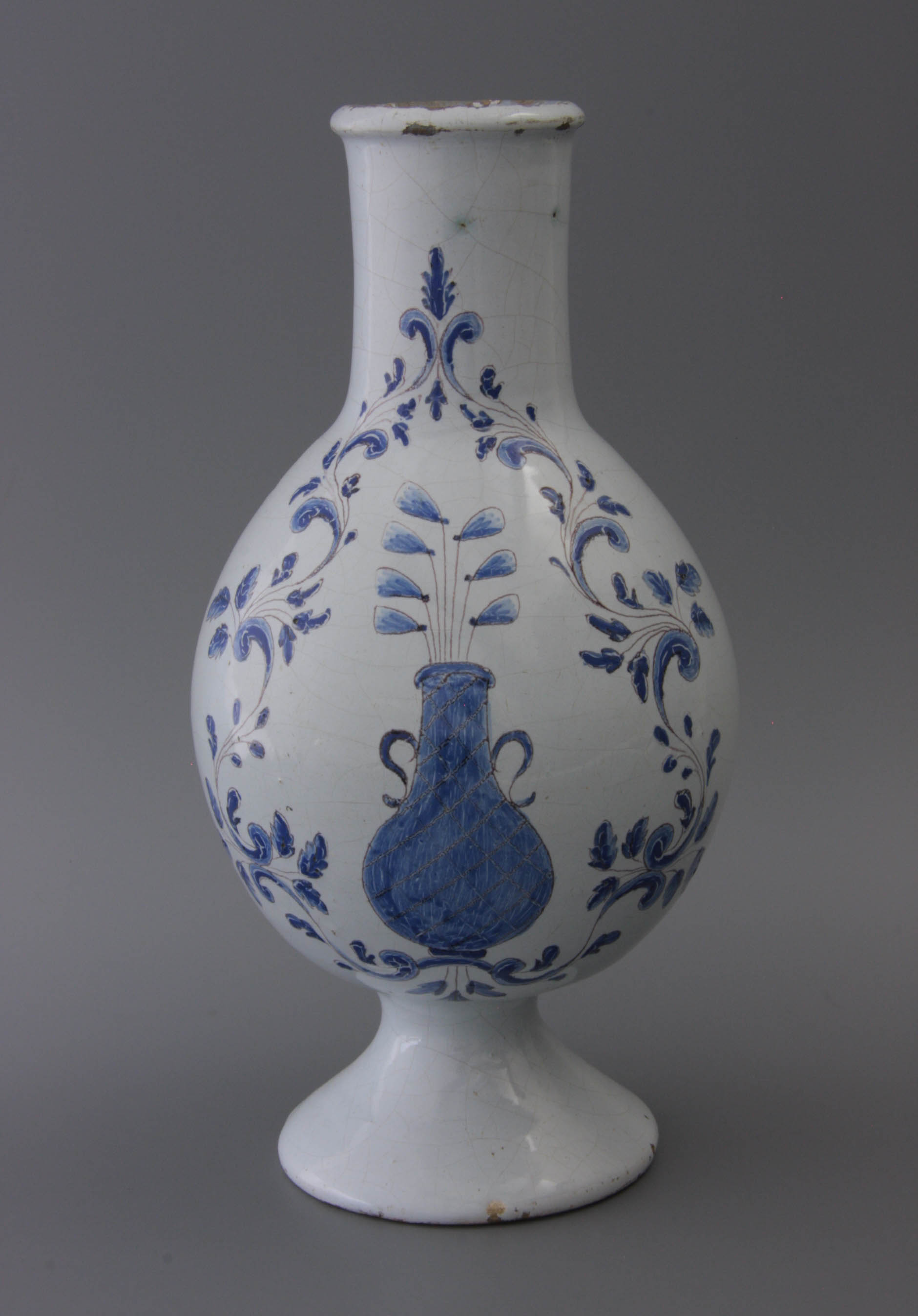
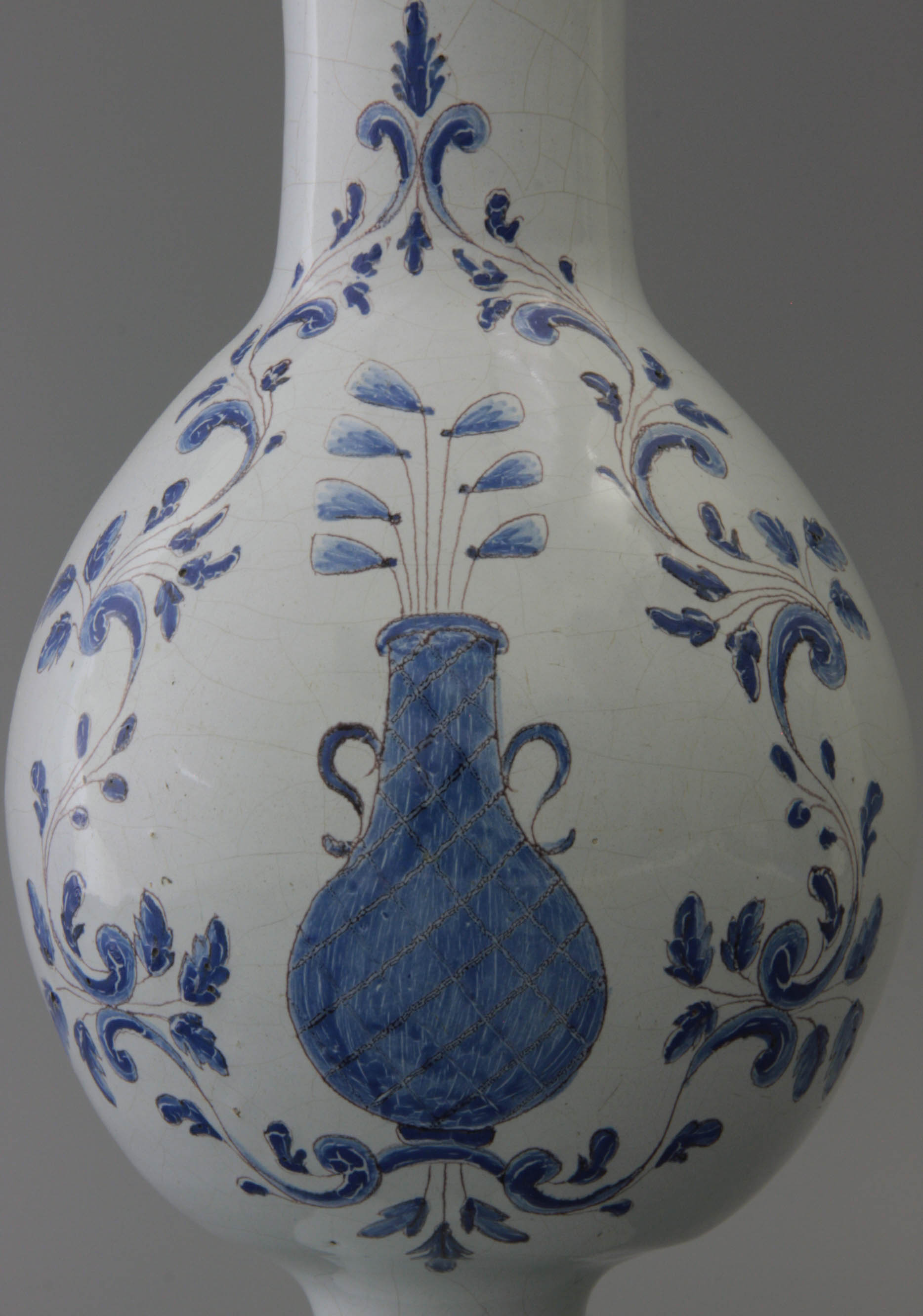
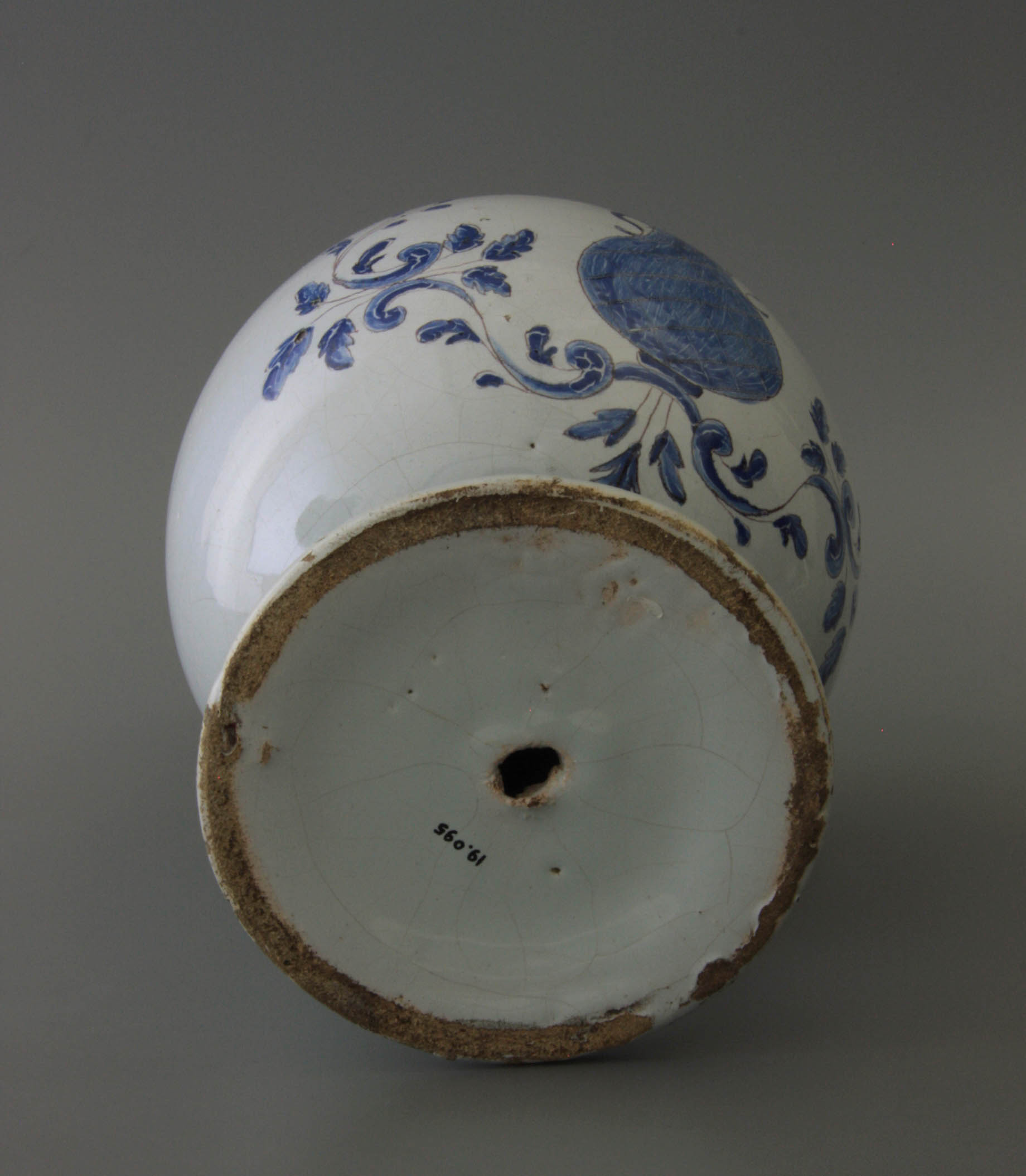
A real pipe vase is not an arbitrary vase in which pipes could have stood, but is an article that is specially intended for exhibiting long Gouwenaars, Gouda pipes. This is expressed in the shape of the vase. This must be stable in order to hold the fragile goods properly. In the vase discussed here, the shape and decoration are perfectly united.
This beautiful vase has a special shape with a flat foot and a round body from which a long slender neck rises, ending in a thin, rounded edge. The narrow neck determines the position of the pipes, which are fairly upright, so that the vase occupies little space and one will not easily walk against the clay pipes. The limited diameter of the neck also refers to thin stemmed pipes or in other words pipes of the best quality. The sturdy foot and the relatively heavy body ensure that the vase will not easily be knocked over. The obliquity of the object that is clearly tilted is remarkable. This may indicate carelessness of the potter but rather has a practical reason. When the vase was placed on a cupboard, this gave an optically positive effect. In addition, the inclination made that the pipes in the rear wouldn’t hit the wall.
The painting gives the vase a clear view side. The back of the object remained unpainted, which implies that this side was facing the wall. Very appropriately the same type of vase is painted on the front, albeit that this one shows two s-shaped ornamental ears on the neck. The painting is done in two colours. Purple is used for the so-called trek or contour lines, the painting is then filled in with blue, so that the purple almost seems to disappear. What strikes is that we now see the pipe vase in use: seven long clay pipes are displayed from the neck. The image is placed in a c-volute garland, decorated with small leaves, ending in a floral top. By painting a vase on a vase, a surprising repetition has been achieved.
The idea of the pipe vase must have been copied from the apothecary jars from the old pharmacy or from the tobacco jars from the snuff store. A fresh bright blue painted vase gives standing and does well in a shop interior. That such a vase was meant for a luxury store is evident. It is a specially made item that certainly was not on the regular market. Incidentally, it was not a very practical tool for the shopkeeper. Arranging the pipes had to be done with great care to prevent breaking. This makes it a showpiece rather than a vase to serve customers.
We can speculate about the contents of the vase: were regular pipes installed, while the merchandise was traded from the pipe basket? It is also possible that the gifts of the pipe baskets, a special decorated pipe, were put in the vase until they could be sold one day at a serious price.
As far as the dating of the vase is concerned, the painting of the pipes confuses us a little. When we look at the shape of the pipe bowls, it is an unbalanced product from around 1735. However, the date of the vase must be later. The transparent way in which the decoration is painted and also the foliage on the belly suggest the Louis XVI period, even though the shape of the pipe bowl was completely oval at that time.
Another question mark is where this product was made. The yellow shard with the white tin glaze and the blue painting evoke the word Delft for the layman. The connoisseur, however, immediately observes that it is not a Dutch product, but rather foreign manufacture. That difference is in the shape of the vase, which does not fit in the Dutch shape range. Even the glaze paste is different, so is the way of painting. Despite careful analysis it has not been possible to establish a further production site.
It is still worth mentioning that French prints from the nineteenth century regularly show the pipe vase. It can appear in a still life of tobacco products and smoking equipment. When the illustrator went wild, we even see burning pipes in the vase. These vases are simply decorative vases whose shape or decor has no relation to the function. In that respect the real pipe vase remains a rare object.
Amsterdam, Pijpenkabinet collection Pk 19.095
A woman's leg as a pipe stopper
Every smoker knows that for the right draft in the pipe one should use a so-called pipe stopper. It is a simple instrument with a flattened bottom to press the tobacco in the pipe bowl during smoking. This is necessary because during smoking the tobacco dries out and becomes loosened, so that the right resistance to a nice smoldering fire threatens to disappear. Pipe stoppers have been made since the seventeenth century. Initially very small because the diameter of the bowl opening was less than a centimetre. Sometimes even that stopper was soldered to the hinge of the tobacco box in order not to get lost.
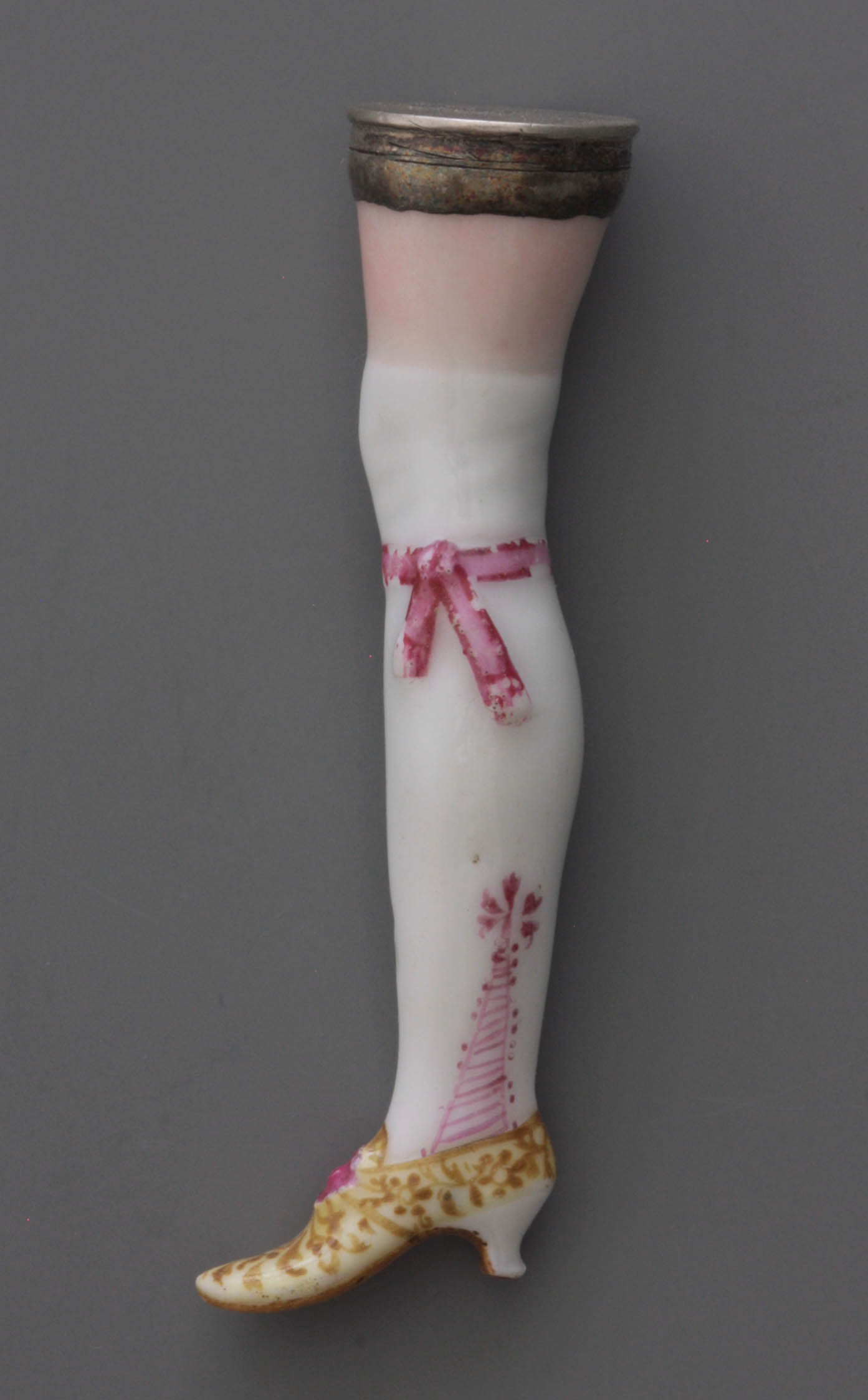
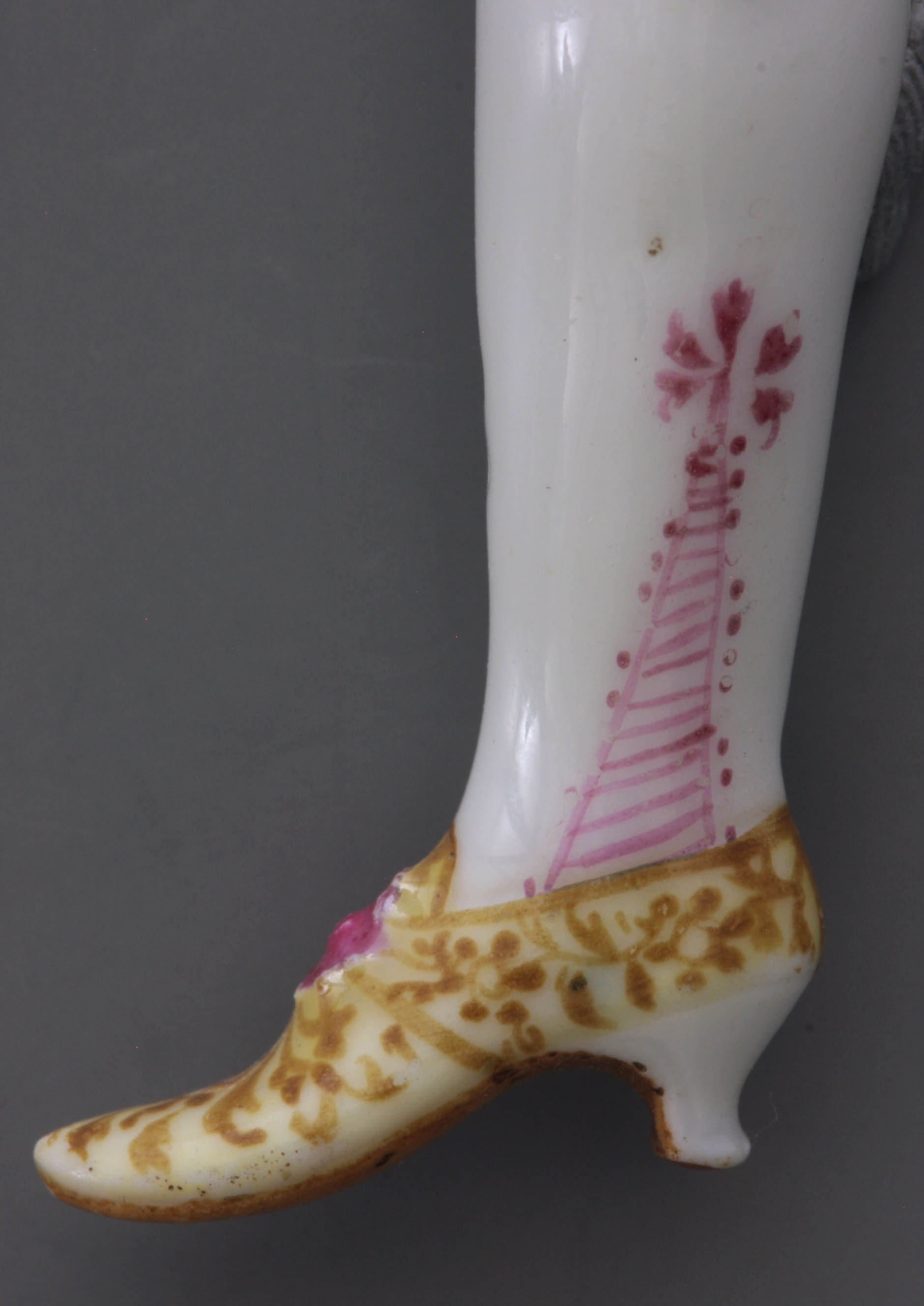
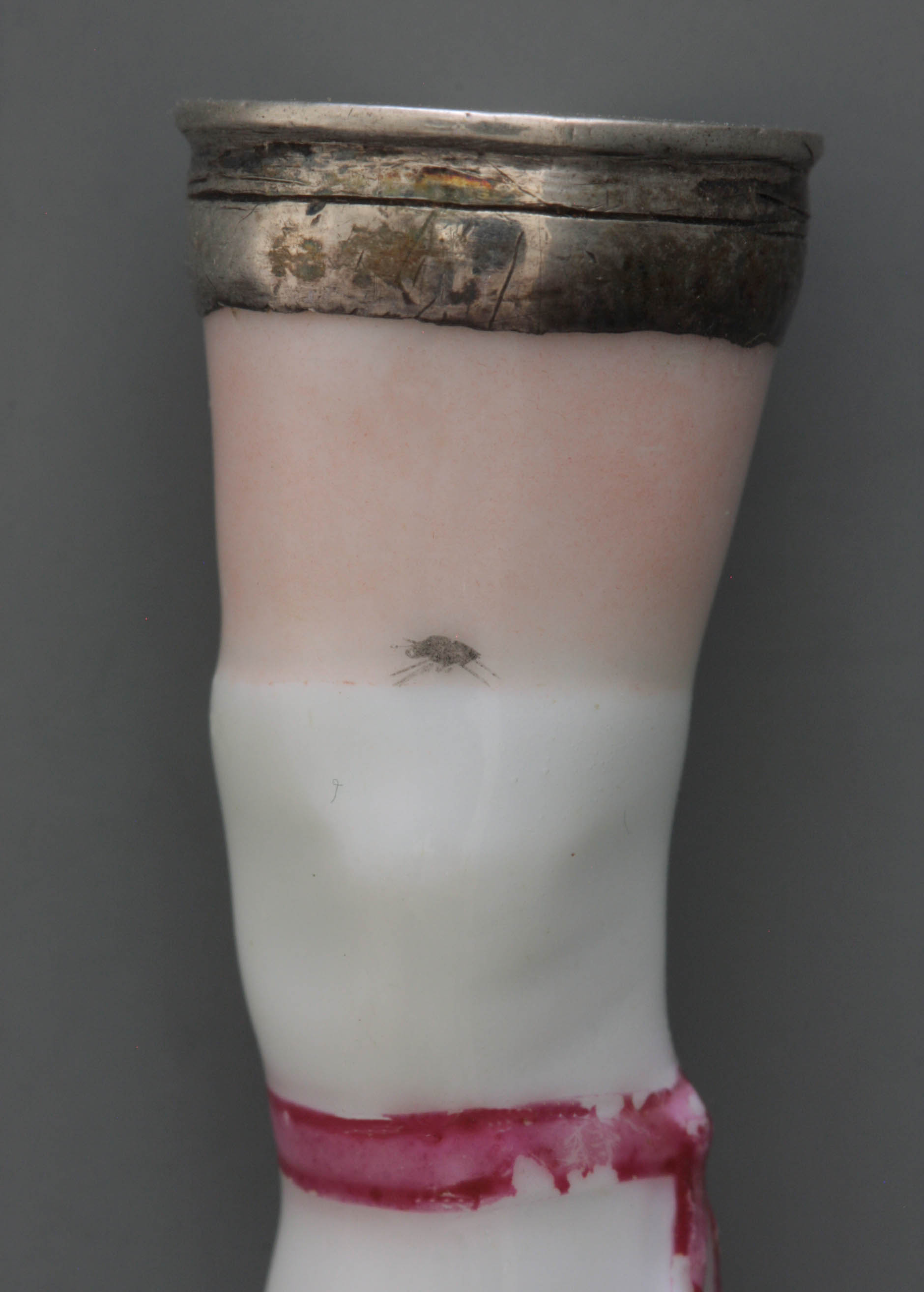
In the eighteenth century, the most luxury pipe stoppers were made, such as shown here. It is a porcelain example from the famous Meissen factory. The stopper is made in the shape of a woman's leg, the English speak of a maiden's leg. The fashionable shoe with heel does not seem to be a simple fashion, but rather the footwear of a true lady. These objects were cast and then painted colourful. The shoe was very carefully decorated with embroidery in brown, the bow set with purple.
A nice detail is that even the embroidery on the stocking is painted including the garter with bow that kept the stocking in place. By way of joke, a flea is sometimes painted on the leg, which can be seen here just on the separation of the stocking and the underpants. A spicy detail the owner could point out to his friends for entertainment.
That such stoppers were exclusive gadgets is also proven by the silver mounting. To protect the porcelain against sooty traces, a silver mount at the flat top is easy to keep clean. Based on the use of colour in the painting, we can date this stopper between 1770 and 1780.
The porcelain pipe stopper in the shape of a woman's leg stays in production during the nineteenth century. Such stoppers no longer originate from the best porcelain factories, but rather from Bohemian companies. These cheaper versions especially enjoyed popularity among students. For them the joke with the flea is more appropriate than under gentlemen of class. The later copies are easy to distinguish from the early ones. The size of the pipe bowl increases considerably after 1800, which makes the pipe stopper bigger and heavier.
Amsterdam, Pijpenkabinet collection Pk 18.452
A pipe case with the Stations of the cross
In order to safely transport the fragile clay pipe, cases have been made since the seventeenth century. Initially, this so-called kas (case) was purely functional. They served for the protection of the clay pipe on the go. Soon they were decorated with carving or inlaid with metal, ivory or mother-of-pearl. Eventually, the urge to decorate resulted in true pieces of art that were no longer intended for use. They were exhibited at home in a display cabinet and served merely as showpieces. Such a showpiece is the pipe case which is discussed here and which, because it is hardly used, was kept perfectly intact.
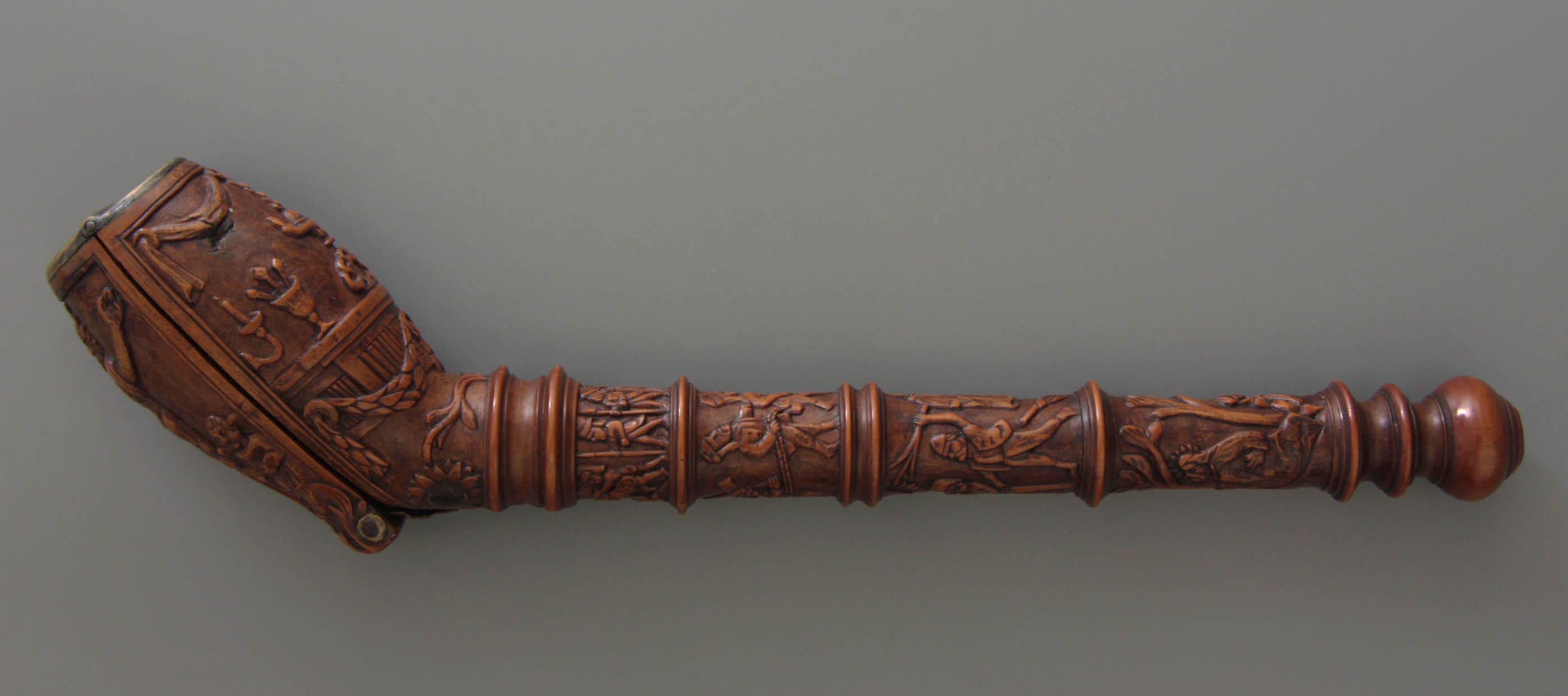
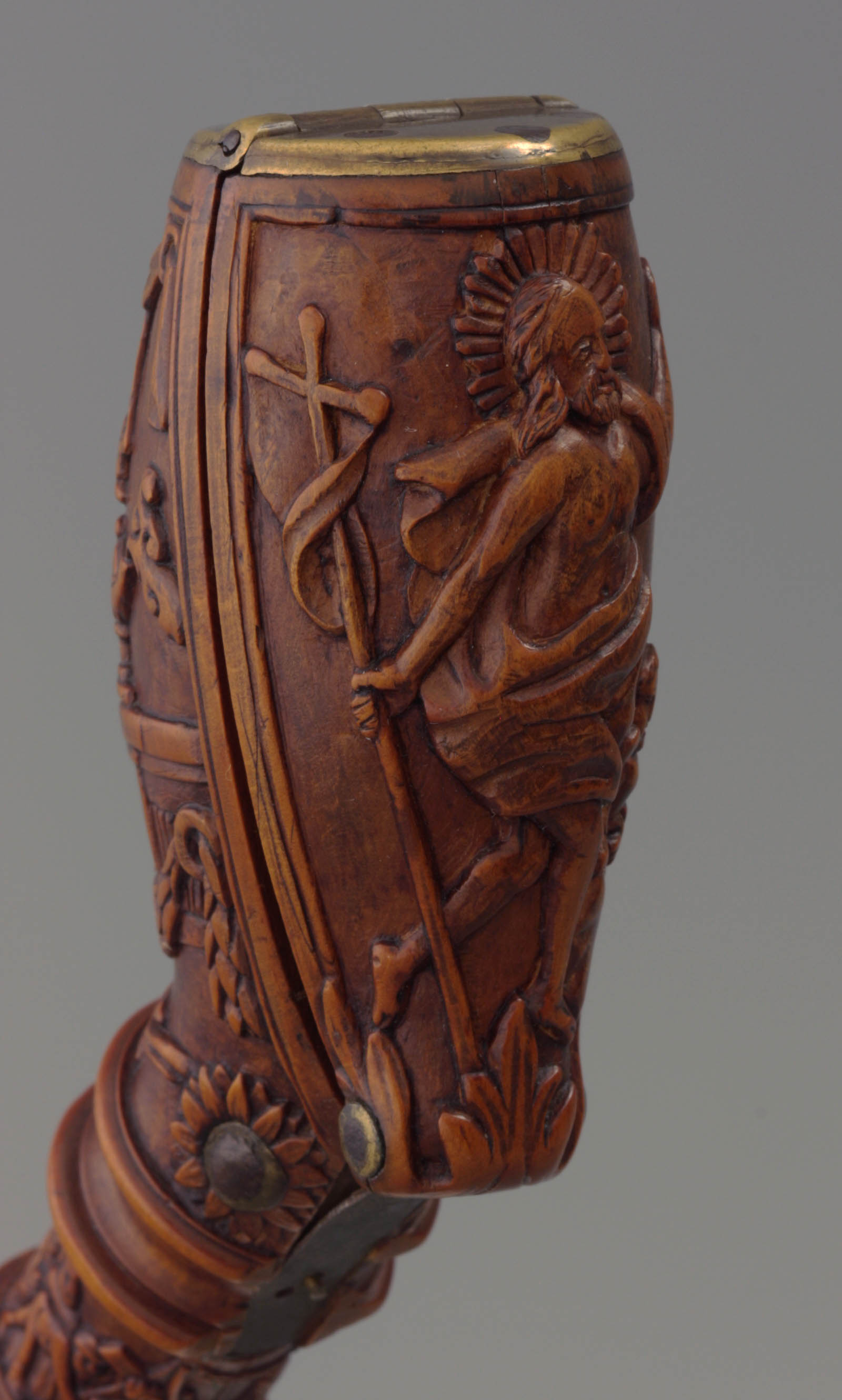
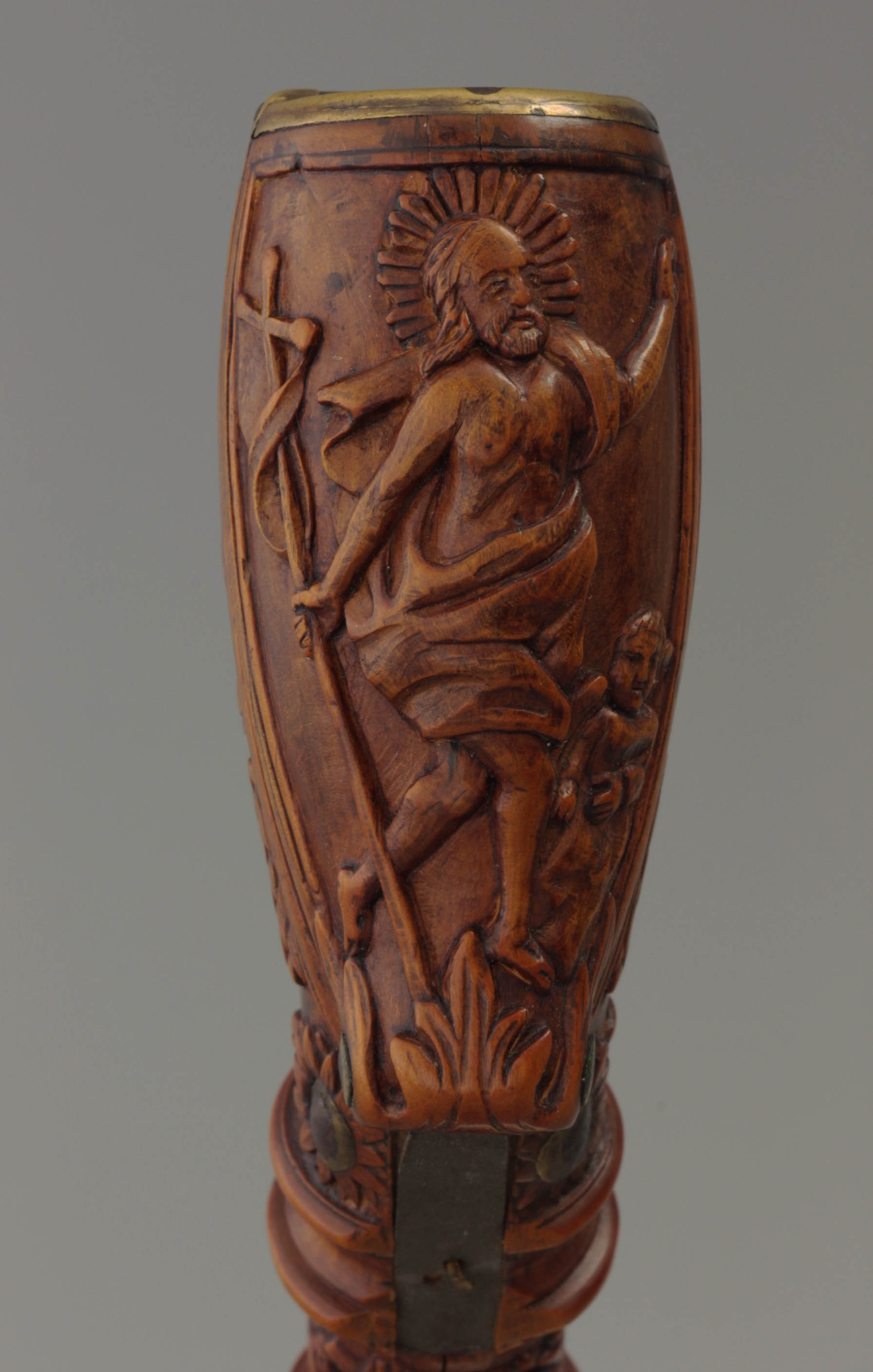
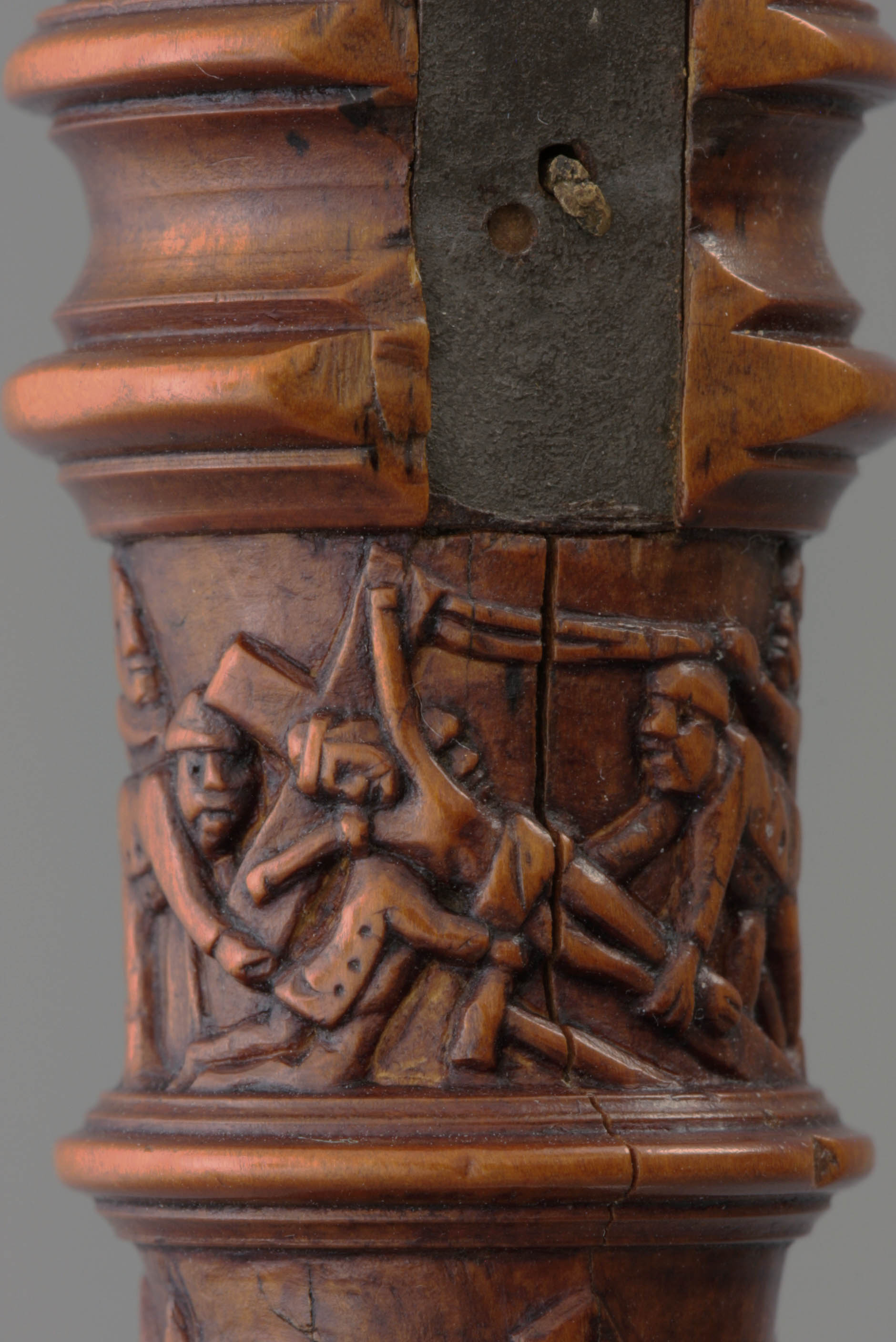
It is a pipe case in standard shape made of walnut, a fine wood type well suited to make detailed carving. The clay pipe enters the case via a hinged cover at the front. The part where the pipe bowl is stored follows the oval bowl shape of the pipe, the stem is straight and half long. The stem ends often with a knob, which is always open so that even a slightly longer pipe fits into the case. We see a circular brass hinge on the bowl part, a clamping spring at the bottom to keep the lid closed.
The subject of this pipe case is religious and is dedicated to the life - or actually the death - of Christ. The six scenes represent the suffering of Jesus including his resurrection and call the believer to vigilance. The lid shows the resurrected Jesus with an aureole, the Roman banner in his right hand, his left arm raised, accompanied by a small angel to his left. The image on the stem side of the bowl is more graphic. A display of an incense burner, the crown of thorns and the three nails from the cross under a hanging oil lamp, referring to vigilance, are displayed on a kind of altar beneath a drapery The rectangular frame is closed underneath by an impressive festoon.
The stem is decorated as much and shows four scenes from the Christ's way of the cross as a sort of comic strip. Each scene is separated by an raised rim around the stem, the closing knot is slightly heavier. The story in the stem runs from the stem end to the bowl section. The first scene shows Jesus praying in Gethsemene amid the sleeping disciples. A winged angel comes from the clouds a showing the poison cup. Scene two is devoted to the flagellation of the unclothed Jesus; ironically his cloak hangs beside him. From the top God is overlooking the beating, represented as an eye in the triangle that stands for the Holy Trinity. In figure three, Jesus carries the cross, surrounded by soldiers. Simon of Cyrene supports him in his heavy task. Finally, scene four shows the soldiers erecting the cross with Jesus, watched by Maria.
These kind of pipe cases are commonly known as Sealand pipe case, coming from the Dutch province of Zeeland, especially when it concerns high-ornamented pieces, as this one. In the province of Zeeland, the pipe case was seen as a part of the traditional costume and in the pants even a special bag was made to hold the case. Whether this case is also of Zeeland origin cannot be confirmed. Certain is that you can give a reasonably exact date on the basis of the ornamental work around the lamps. This points to a period between 1770 and 1800. As a status symbol, the pipe case remains in use for at least a century with the Zeeuw people, who are loyal to their traditional costume.
Amsterdam, Pijpenkabinet collection Pk 19.865
A ring to offer a pinch
In addition to smoking, sniffing tobacco is a habit that has been popular in many cultures. The European snuff box as a luxury article to present a pinch is the most characteristic example of this fashion. Even many tribal people have their own version of the snuff holder to keep the powder dry and dust-free and not least to preserve the aroma. Favourite materials are wood, bone, horn, sometimes also metal or ceramics.
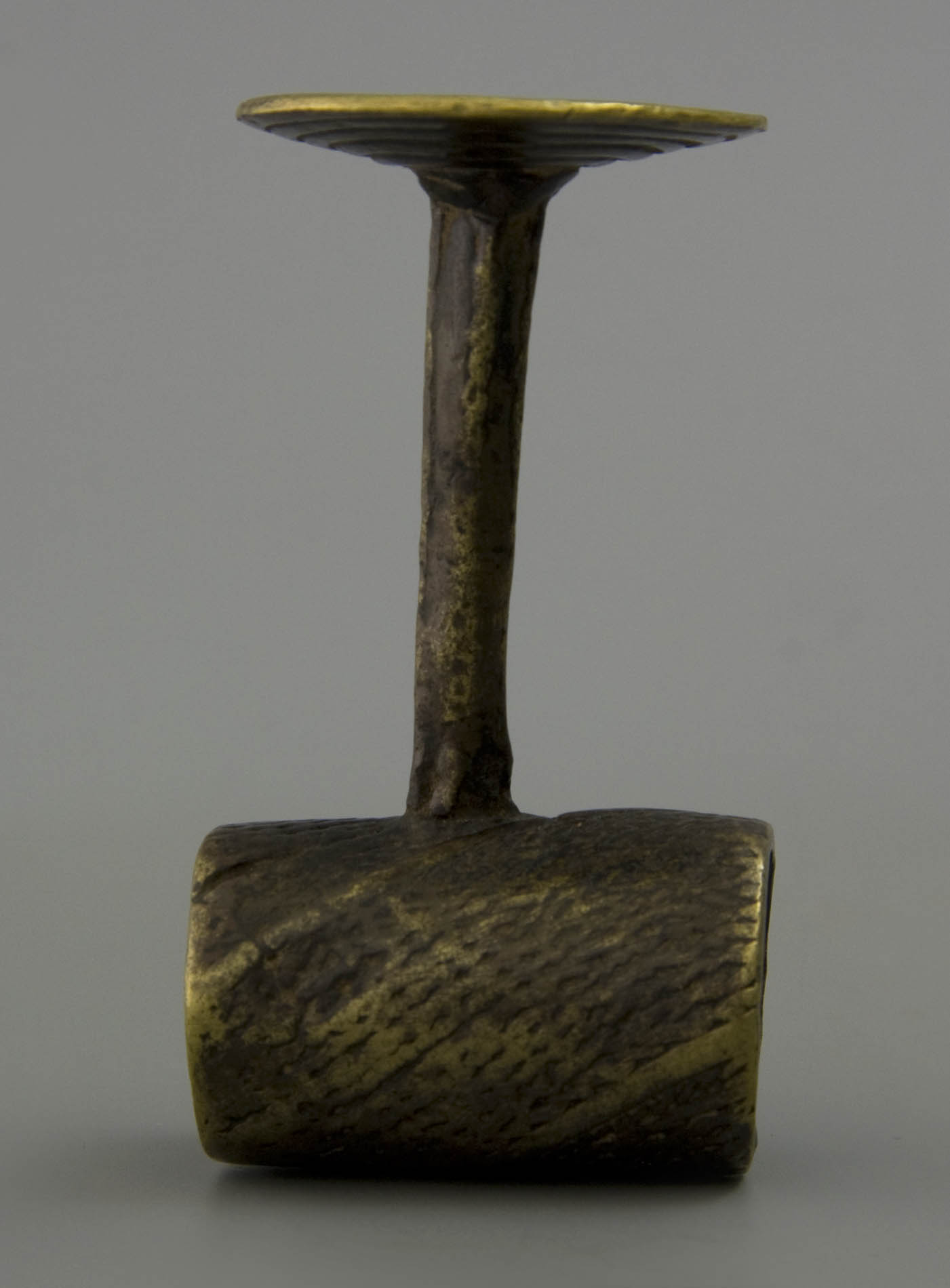
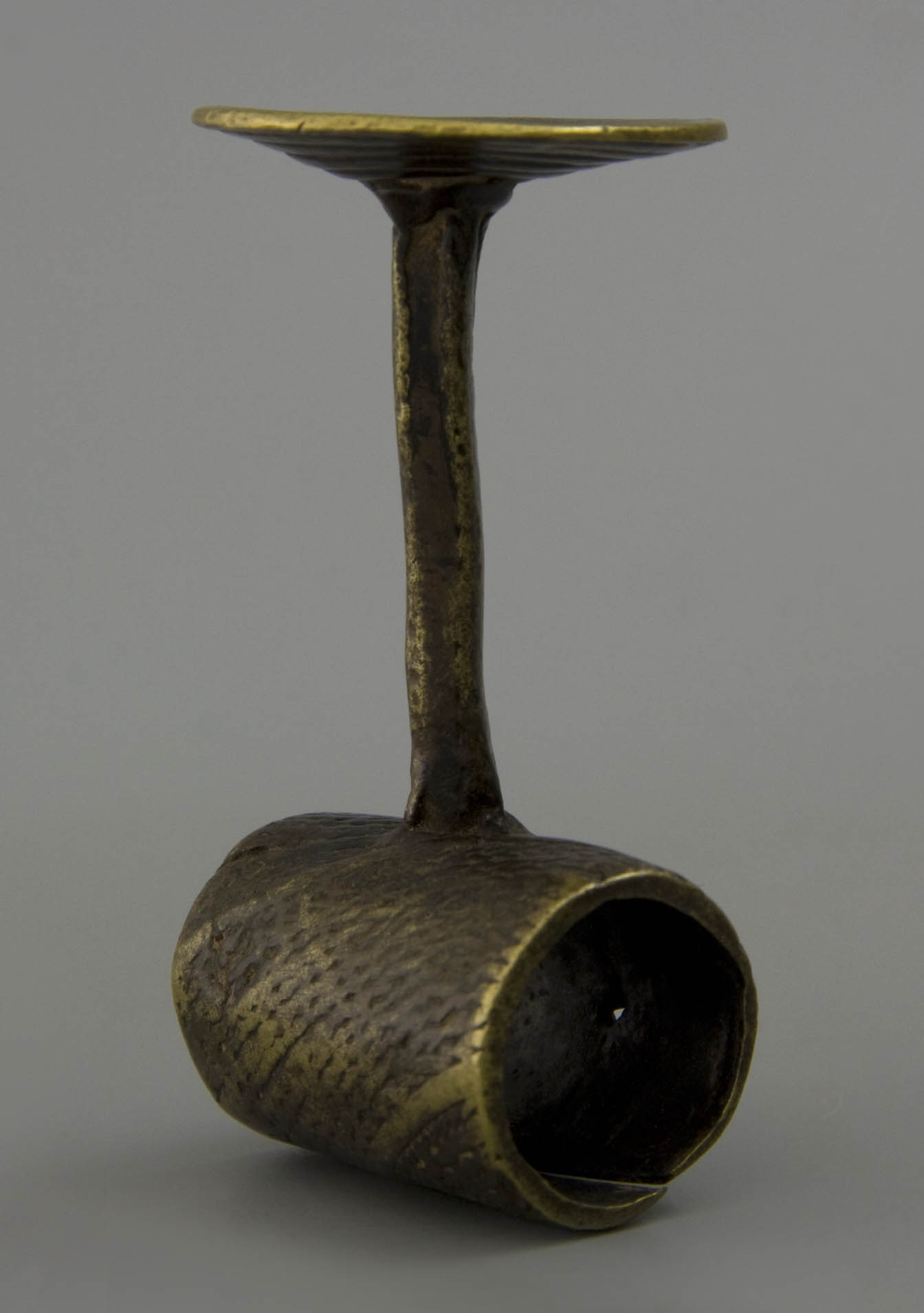
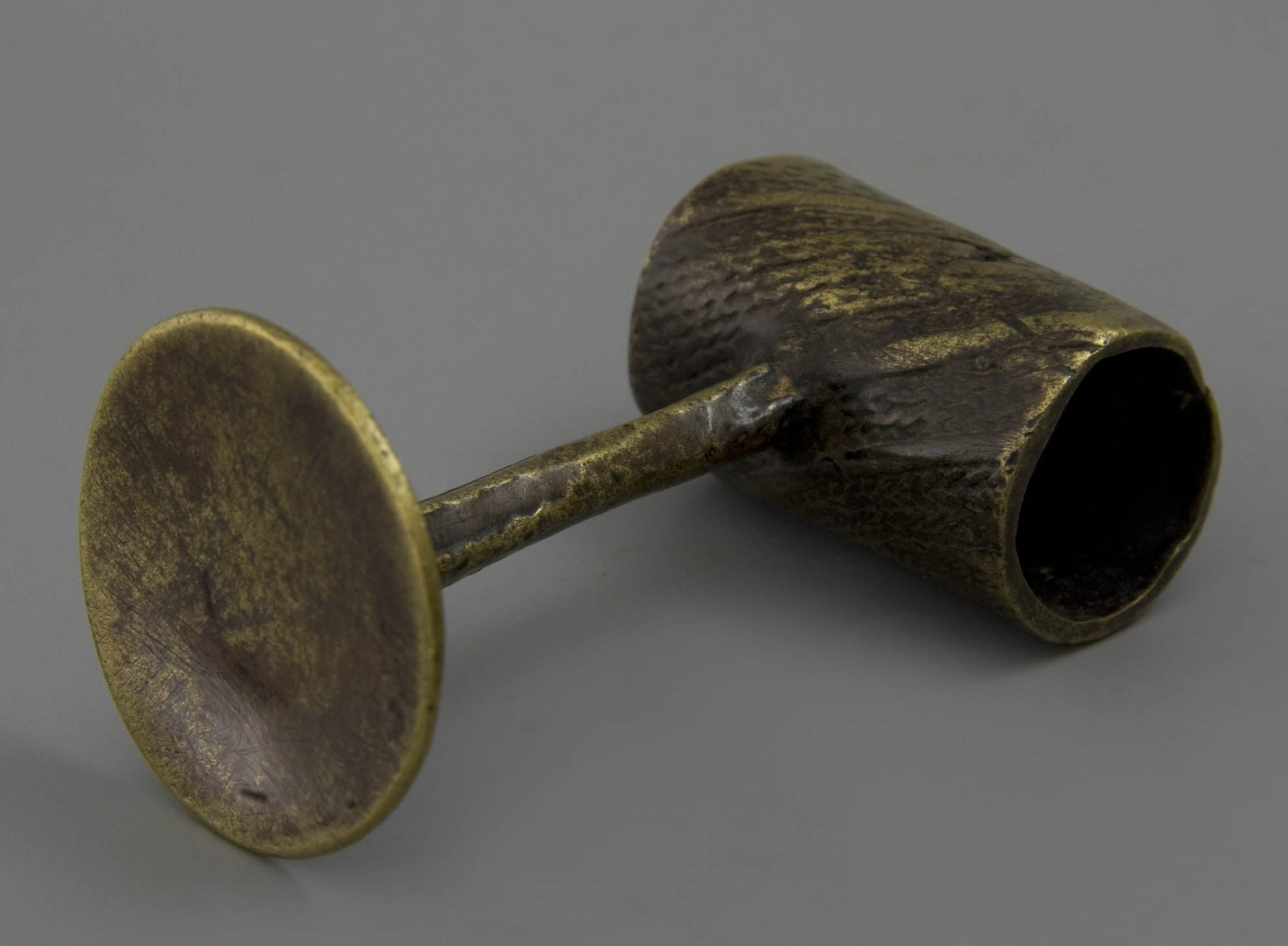
Apart from preserving the precious snuff, offering it is a ritual in itself. In case this is done from the snuff holder such an object gets all the attention. Offering a pinch of snuff was a sign of hospitality and makes someone feel welcome. A very special way to offer snuff is done with this snuff ring by the Tiv people from Nigeria, a tribe that also had its own merit in the tobacco pipe.
The snuff ring is cast from bronze and subtly finished. The part that is pushed around the finger is cylindrical and fairly wide. In fact, this part is too long for one phalanx, but that is the intention. When offering snuff, which is sprinkled on the flat dish, the ring must remain in vertical position and must not be tilted. By bending the finger in the ring to the extent possible, the position of the snuff ring is ensured and the snuff will not fall off.
The ring itself is slightly twisted and provided with inconspicuous engraved interrupted lines. The stem is angular and also slightly turned, but the question is whether that is a coincidence. The dish itself is flattened to almost flat. All in all, it is a fairly unobtrusive object, mainly focused on functionality and hospitality.
Amsterdam, Pijpenkabinet collection Pk 15.074
Japanese smoke box
Smoking is surrounded by rituals in many cultures. Sometimes these are habits in attitude or behaviour, in other cases objects underline the sacredness of tobacco use. Especially in Japan, the country of the tea ceremony, smoking is a ritual. Regarding the so-called kiseru, the metal Japanese pipe, two exclusive examples are described in this series. Because of the small bowl, this pipe has to be filled and lighted regularly and for the latter a brazier is needed. This brazier is the central object in the small cupboard used by smokers that plays such an important role in the smoke ceremony.

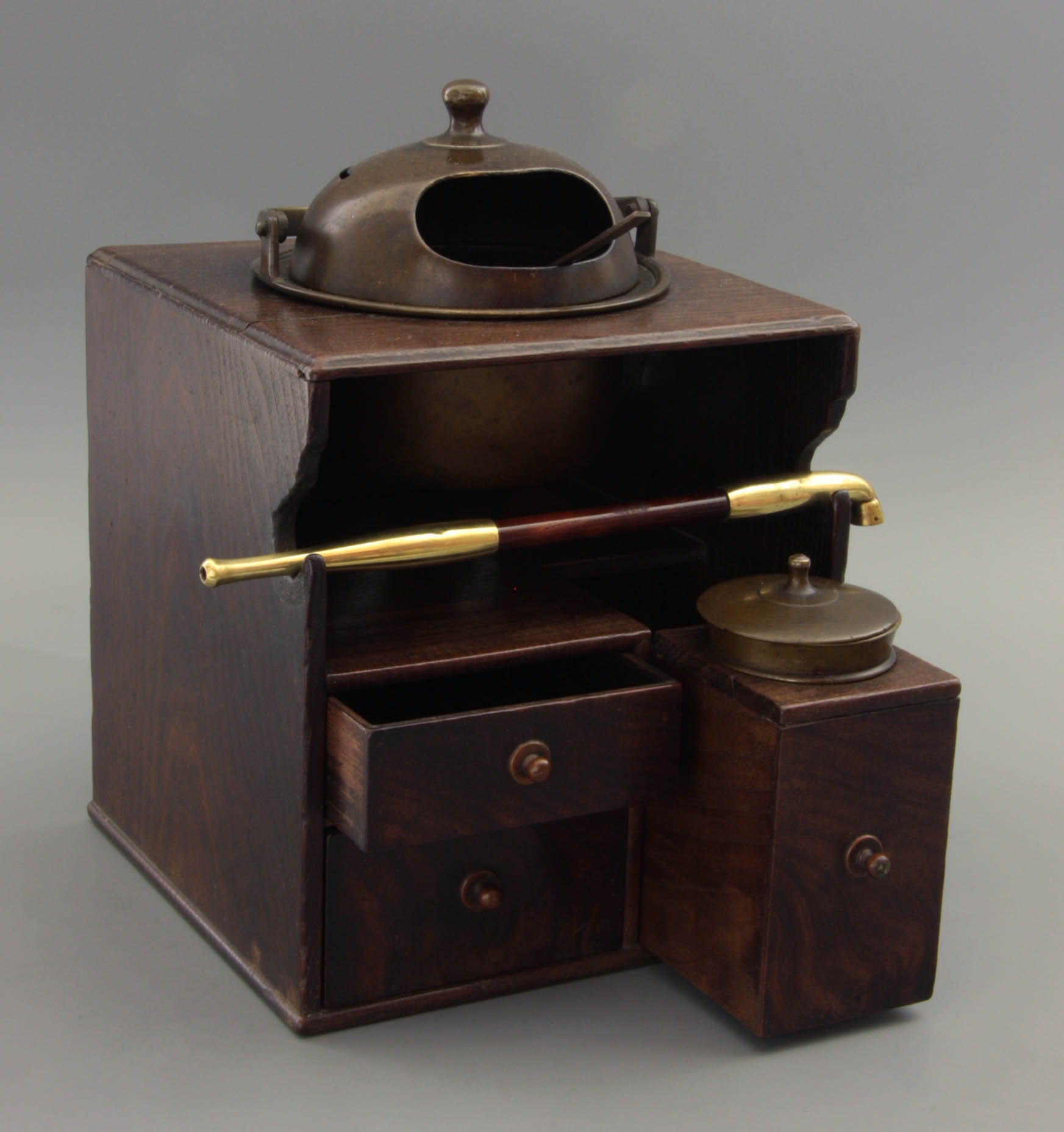
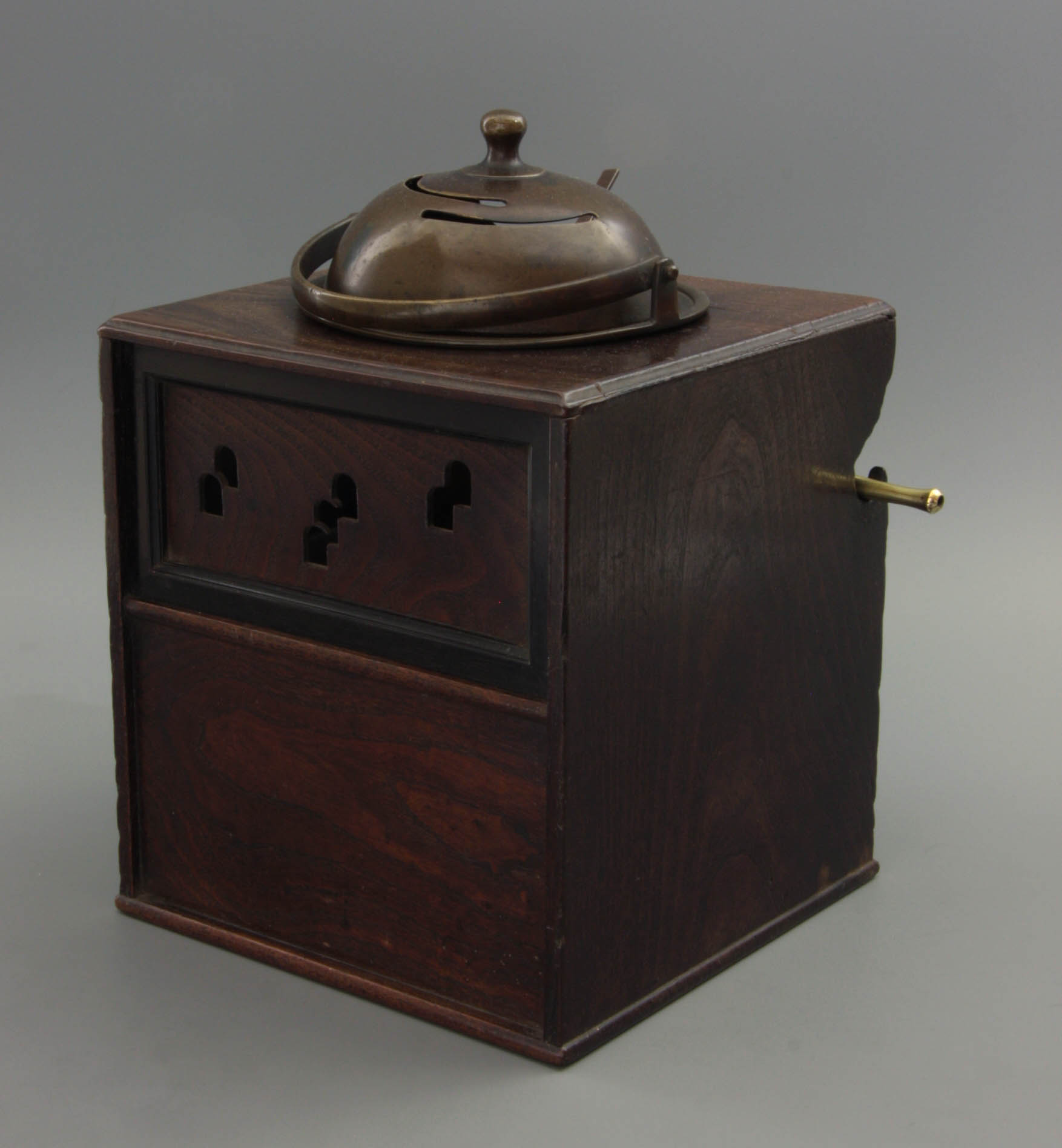
The most developed form of the smoker's box is shown here. It accommodates the smoking equipment of the owner of the house. In this case it is a compact object with three drawers and a compartment with a brazier. The ashtray is located in the lower drawer at the right, which runs over two storeys. This is closed with a lid. Before use, it is pulled out of the box. The two other drawers do not serve for specific smoking equipment, but can be used for some personal items. Between the drawers and the top there is an open space in which the brass brazier is hanging ensuring the brass can release the heat. The brazier itself has a dome-shaped lid with an opening at the front and sawing at the top to guarantee sufficient oxygen supply. With two pins it hangs in the top of the cupboard so that the entire furniture can be moved to the carrying handle. By turning it a quarter turn it comes loose from the top and can be emptied.
At the front of the cupboard the pipe can be stored very practically because both sides are sawn open. At the level of the open compartment the back side is accentuated with a smooth black frame. Within the frame three arched windows have been cut out. The outer two are double, the middle even triple. Quite subtly, the tracing work at the left is complete, in the middle it is half present and at the right it is completely missing. In this way an attractive rhythm is created with unexpected details.
Smoking the kiseru is a special ritual. The Japanese roll their tobacco, which is extremely finely carved, into a small solid ball that fits in the pipe bowl. This is lit above the stove and with a few puffs all tobacco is gone into smoke. A pipe stopper as is customary in Europe, is not known and not even needed. After smoking, the pipe is emptied by dashing on the edge of the brazier and then it is packed again. During smoking, the fire is kept in the stove. A special poker with thin handle is used for this purpose, which ends in a sort of spoon or spatula shape in order to scoop the ashes.
With all its simplicity this has become a beautiful small piece of furniture, made from a fine-grained type of wood and very modest in appearance. The rhythm of the drawers, the carefully turned wooden knobs and the sawing at the back create a simple, effective but above all beautiful object. It should date between 1880 and 1920. After that time the smoke box disappears and the Japanese switches over to cigarettes or on a modern European pipe.
Amsterdam, Pijpenkabinet collection Pk 20.100
Curiosities and varia
Self-portrait of a smoking lady
In the tobacco literature, the self-portrait of Madame Vigée Le Brun is the most widely published smoker's portrait. Her majestic appearance, with plunging neckline and feathered beret, makes an immediate impression. In addition, it is a painting with an unusual theme: a smoking woman who slyly smiles at us from behind her pipe drawer, a clay pipe in the raised right hand. In the period of creation, between 1820 and 1840, smoking for women was not done.
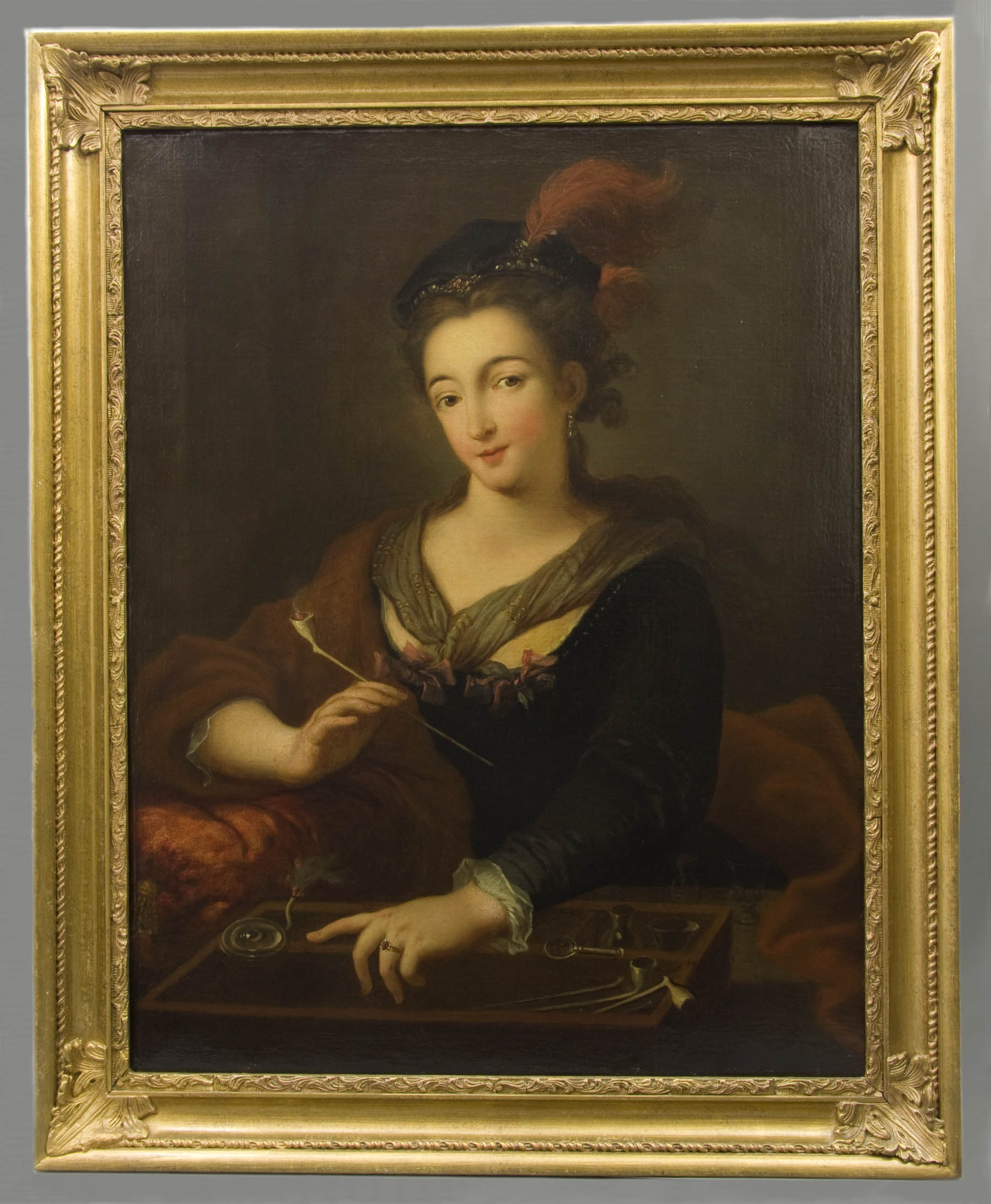
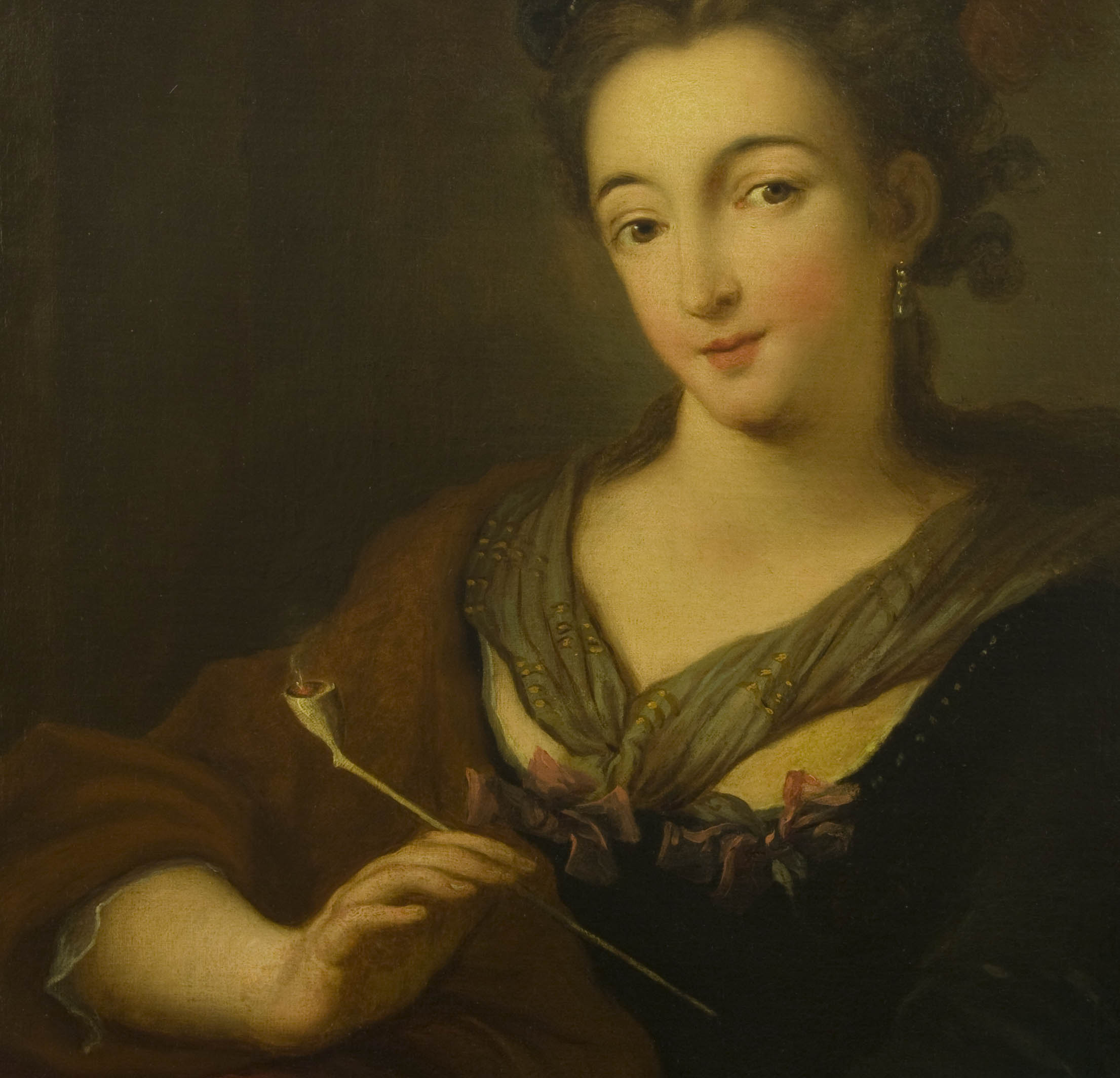
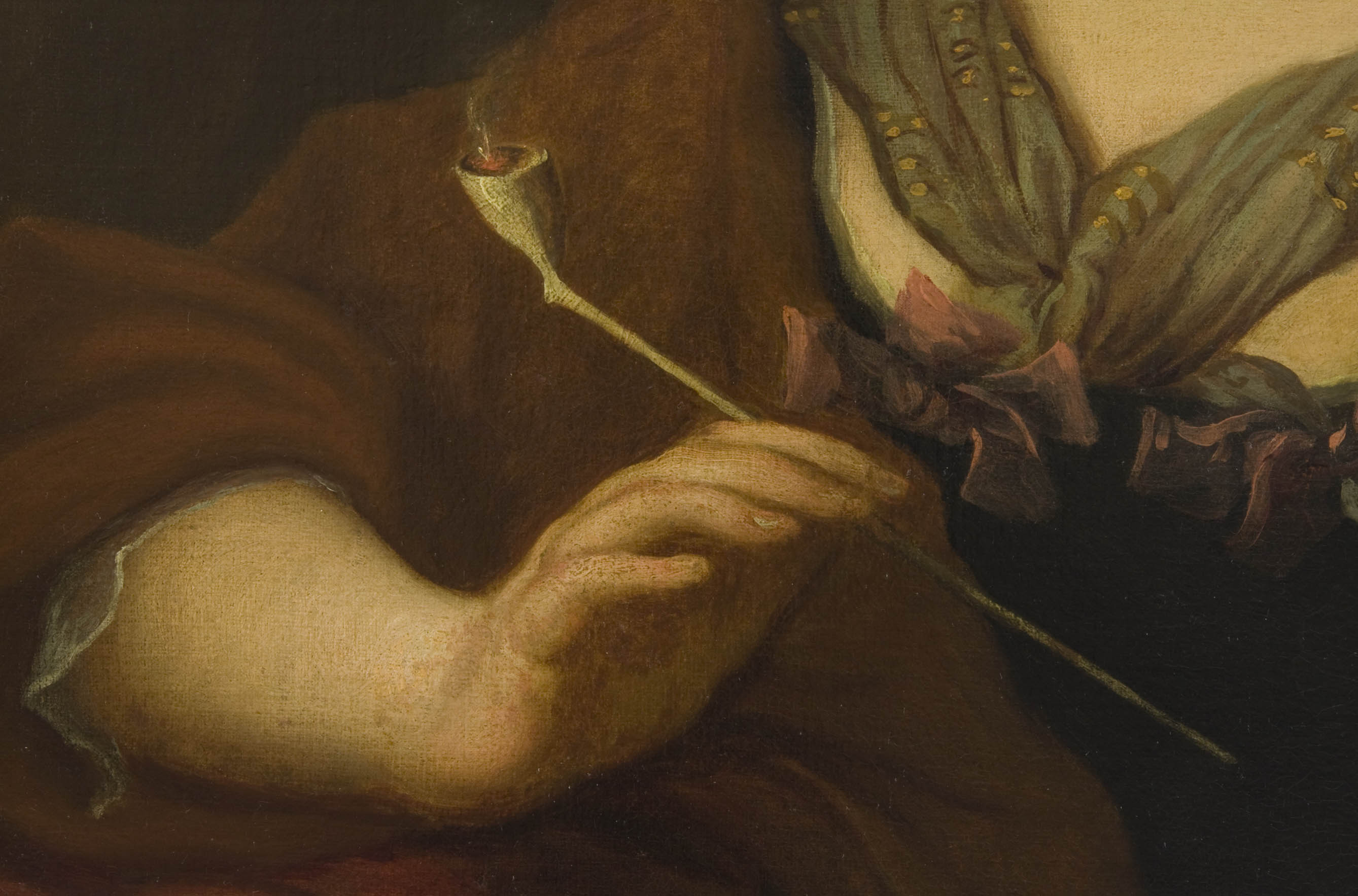
Not surprising, therefore, that countless publicists chose this portrait to show pipe-smoking in a wider perspective. Alfred Dunhill was the first in 1924 to use the painting as a colour illustration in in his standard work. Subsequently the distribution of his book made the portrait known worldwide. Count Corti took over the illustration a few years later and that is how the print also spread in the German-speaking area. After that, copy after copy emerge, as authors tend to do. Not surprisingly, when the fifth centenary of the tobacco was celebrated in Vienna in 1992, this portrait had a central position on the exhibition.
If you want to illustrate smoking in more detail, this painting is eminently suitable. In front of the elegant woman dressed in Scottish fashion and with a fragile clay pipe, there is a box with two compartments in which all kinds of smoking equipment is displayed. We see three short clay pipes, a pipe stopper with an eye, a burning wick, an ashtray and another cup. Behind the pipe box we see two more glasses.
The painter Elisabeth-Marie Vigée Le Brun listened to the nickname Louise but was known in France as Madame Le Brun. She was born in 1755 and has worked throughout her life as a portraitist. She left a great oeuvre of hundreds of portraits of royal and noble people from almost all of Europe. In France she was a painter for Marie-Antoinette and therefore frequenting the highest circles. Obviously she travelled a lot and visited countless foreign courts where she portrayed an infinite series of high-ranking people. Besides portraits of others, Madame Le Brun also made several self-portraits of which this is the most striking.
How Alfred Dunhill acquired this remarkable portrait is unclear. We know, however, that it was in his possession before 1924. In the years after 1950 this painting hung in the meeting room of Dunhill in Jermyn Street in London. The story goes that in that period the painting would have changed. The woman with her low-cut dress would have disturbed Mary Dunhill, one of the descendants of Alfred Dunhill and member of the board. At her request, the shocking naked bosom would have been camouflaged with a veil with a few bows. Reality is less puritan and less English. When London was bombed in 1940, the shop of Alfred Dunhill got partially destroyed. Afterwards, the portrait had to be restored and it came fresh in colour from the restorer with a few adornments. The refreshed look was a reason for a new judgment. Meanwhile, the years of meetings in clouds of tobacco smoke have brought back the painting to its original yellowed character. In that state it is now in the Pijpenkabinet in Amsterdam.
Amsterdam, Pijpenkabinet collection Pk 18.079
The wedding pipe in function
Offering a tobacco pipe to the groom on the day of the wedding is a ritual that was known in many parts of our country. This custom has been so important that it is inseparable from the history of the pipe. This is partly caused by the fact that after the wedding the groom's pipe was kept in a wall cabinet or a cardboard box. Once a year, on the day of the wedding, it was pulled out and smoked again. As a matter of fact very carefully because popular believe has it that if the pipe breaks, the marriage breaks.
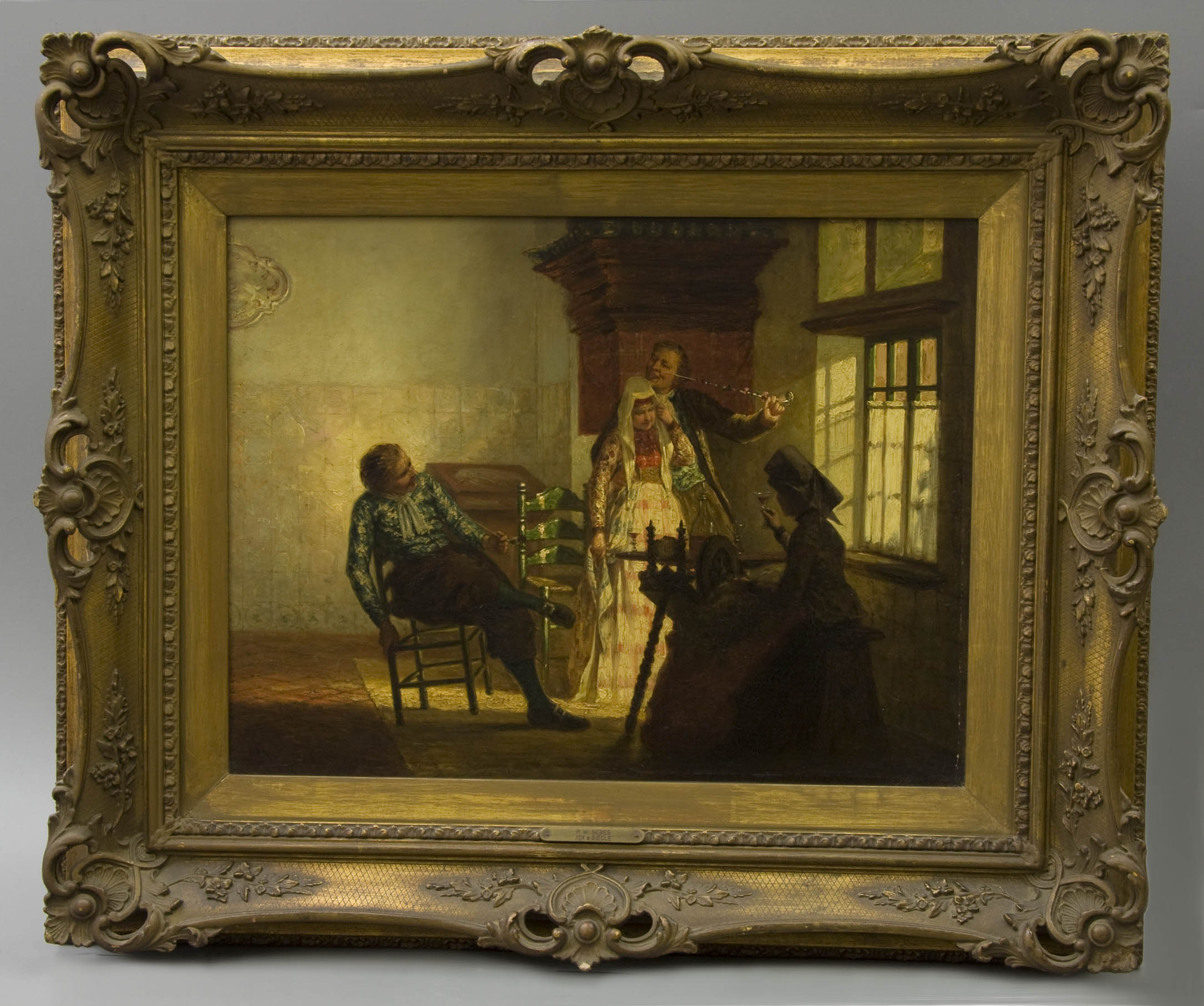
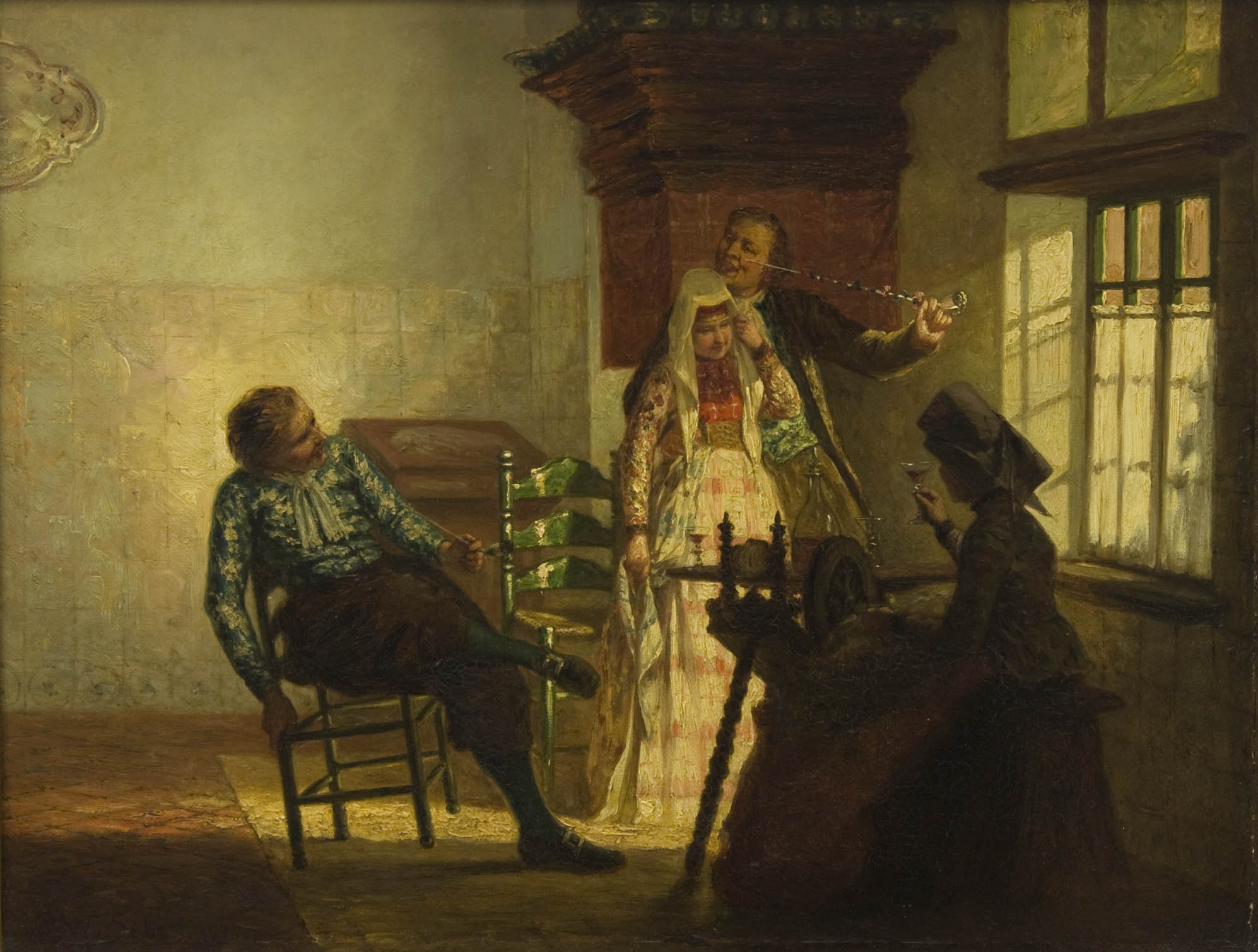
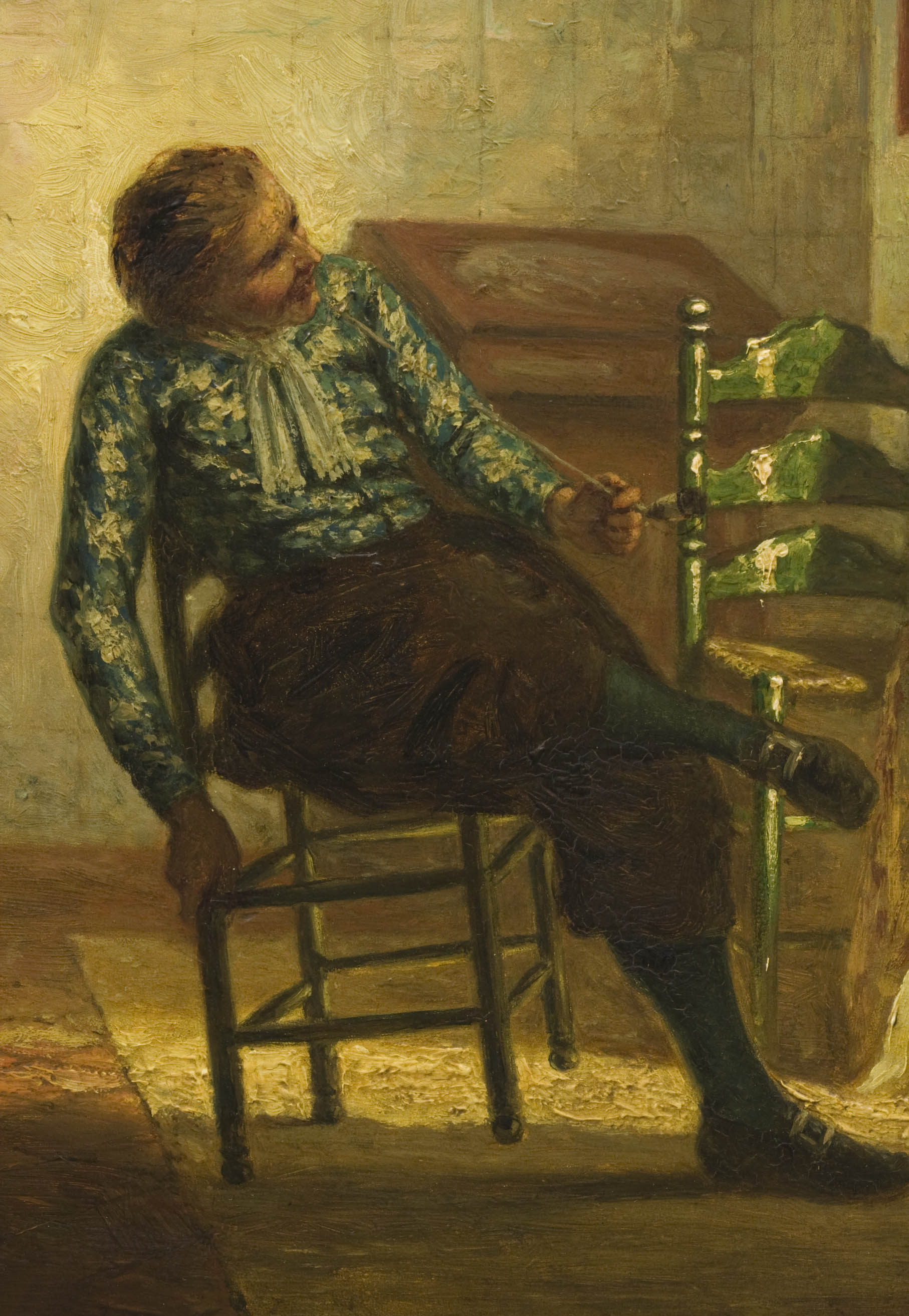
So it is with good reason that this painting of a traditional wedding with the pipe prominently displayed, was purchased for our collection at the time. In the end, the ritual of smoking the groom's pipe is rarely depicted. It is a piece of folklore that has often escaped the attention of the artists and that is not surprising. The heyday of the wedding pipe was in the nineteenth century, and in those days artists found inspiration in other subjects.
The painting in question represents a traditional Frisian interior with whitewash along the walls and painted blue China on the edge of the chimney. To the right of the middle, the bride and groom are depicted in costume from Hindelopen, the man smoking from a flower decorated groom's pipe. In the shadow at the right-hand side an elderly woman sits at her spinning wheel. She is seen from behind and gives a toast to the couple. The painter seems to imply that she represents the period after the wedding. Centre left, a boy is rocking in a turned chair. He also smokes a long pipe and symbolizes the unbounded freedom, the time before marriage.
The scene is characteristic of a disappearing culture with which the painter Sebes was strongly committed. It is with good reason that the conservative themes from the old Frisian culture always return in his work. Especially the decline of Frisian costumes was very important to him. That is why he portrayed the costume from Hindelopen here very accurately, including the use of the groom's pipe.
Painter Pieter Willem Sebes was born in 1827. His interest in painting stems from his Harlinger youth. After a few years in The Hague he visited the Academy in Antwerp. His work shows many aspects of Frisian culture, of which this painting is a beautiful example. In addition, the Rijksmuseum commissioned him to make historical portraits, for which he sometimes copied originals from foreign museums. Although Sebes returned to Friesland several times, he stayed mainly in Brussels, Amsterdam and Baarn. This work, for example, he painted in 1877 in Brussels. It is clear that his involvement with Frisian culture did not disappear far from home. It is a theme that we see in many of his paintings. Sebes died in Amsterdam in 1906.
Amsterdam, Pijpenkabinet collection Pk 10.063
Business card of a tobacco factory
Only the most important eighteenth-century tobacco manufacturers used a business card to advertise their trade. Sometimes a tobacco packaging vignette printed on better quality paper will be used, but in a special case the card is designed. In that case the whole process of making was done with grater care. The paper is of better quality and the detailing of the image is more refined. After all, a business card only has to be made in a limited edition, something that certainly does not apply to the tobacco wrapper that is printed at hundreds or thousands.
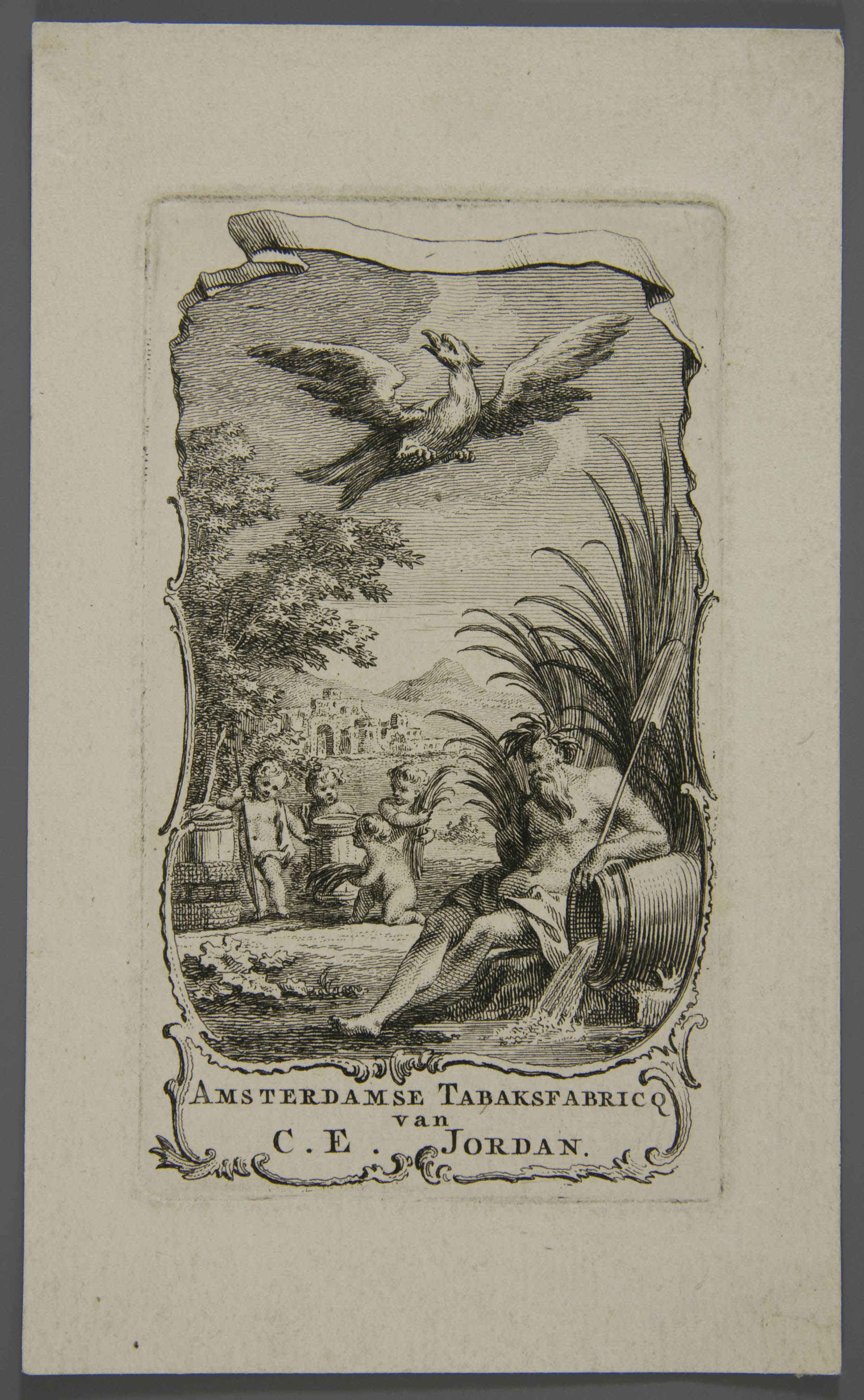
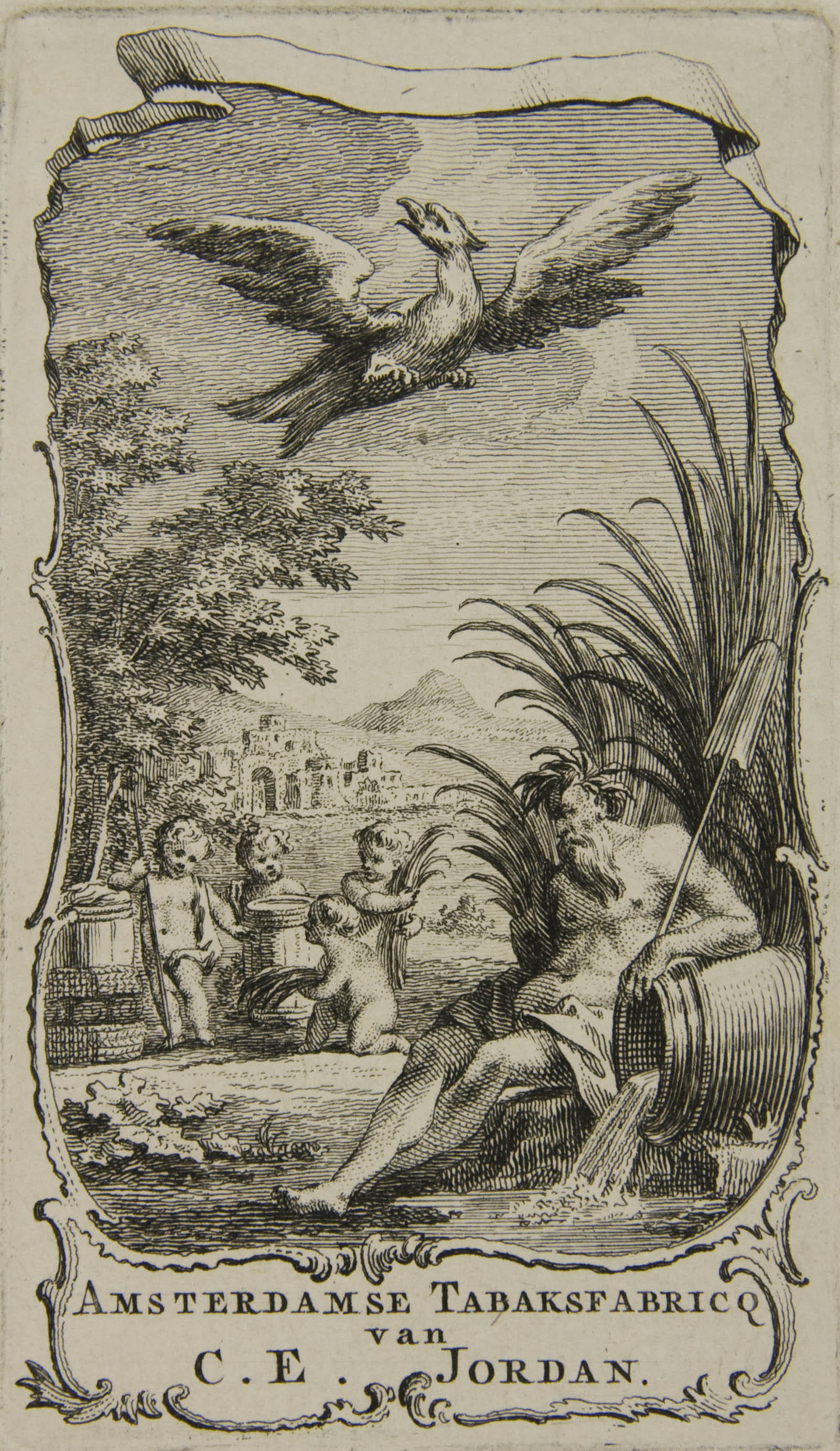

One of the most beautiful business cards comes from the Amsterdam tobacco manufacturer C.E. Jordan. He had his name card executed in unexpectedly large size. The height is more than twelve centimetres, the width exceeds seven. It was made in the technique of the copper engraving, so the image was engraved in negative in a copper plate and then printed. The finesse of the representation proves that a large edition was not possible. In this generous size, the engraver, whom we can rightly qualify as an artist, has made a beautiful composition in which all kinds of elements have been brought together.
A contoured edge with rocailles is used as a frame, characterized by elements of the asymmetrical Louis XV style. They point to a date in the years 1750 or 1760. At the top in the air an eagle flies, the bottom half shows a so-called upholstered landscape. To the far right in the foreground is a sitting Neptune, represented as a river god. His left arm rests on a barrel as the source of a creek or brook, an oar sticks upwards. Such figures are called a repoussoir, a pictorial element strongly in the foreground that reinforces the depth effect of the total image. On the middle left, four putti are busy with tobacco leaves, two tobacco barrels and a half-opened canaster basket. They are the only reference to the tobacco business in the scene.
The background shows a ruin and some mountains that make the landscape explicitly un-Dutch. For a tobacco brand you would rather expect an American plantation. As we already discovered, the only reference to the trade in the picture are the tobacco barrels and the basket, the other symbols have a different meaning. Enlightening is the text below the plate, where we read "AMSTERDAMSE TABAKSFABRICQ VAN C.E. JORDAN". The producer identifies himself with that text.
Although beautifully designed and carefully printed, with our contemporary eyes for advertising, we are a bit surprised at this object. A name card without an address does not seem really useful and the reference to the product offered is very thin. Only those who search well can get the clue. Yet this print is of such a high artistic level that the name card of Jordan is one of the most special business cards in the entire tobacco industry.
Amsterdam, collection Pijpenkabinet Pk 25.003
Women at work
Old photographs are an important testimony of the factory and the working conditions in the companies of the past. Unfortunately, only seldom was there reason to record everyday life with all these grubby workers. That is why such photographic recordings are scarce. It is remarkable that in 1908 the manufacturer Goedewaagen made a series of seven photographs of the manufacturing process in his factory. Of this series, this photo is the most interesting. It was taken at the so-called machine workshop, a department that only existed for a short time.
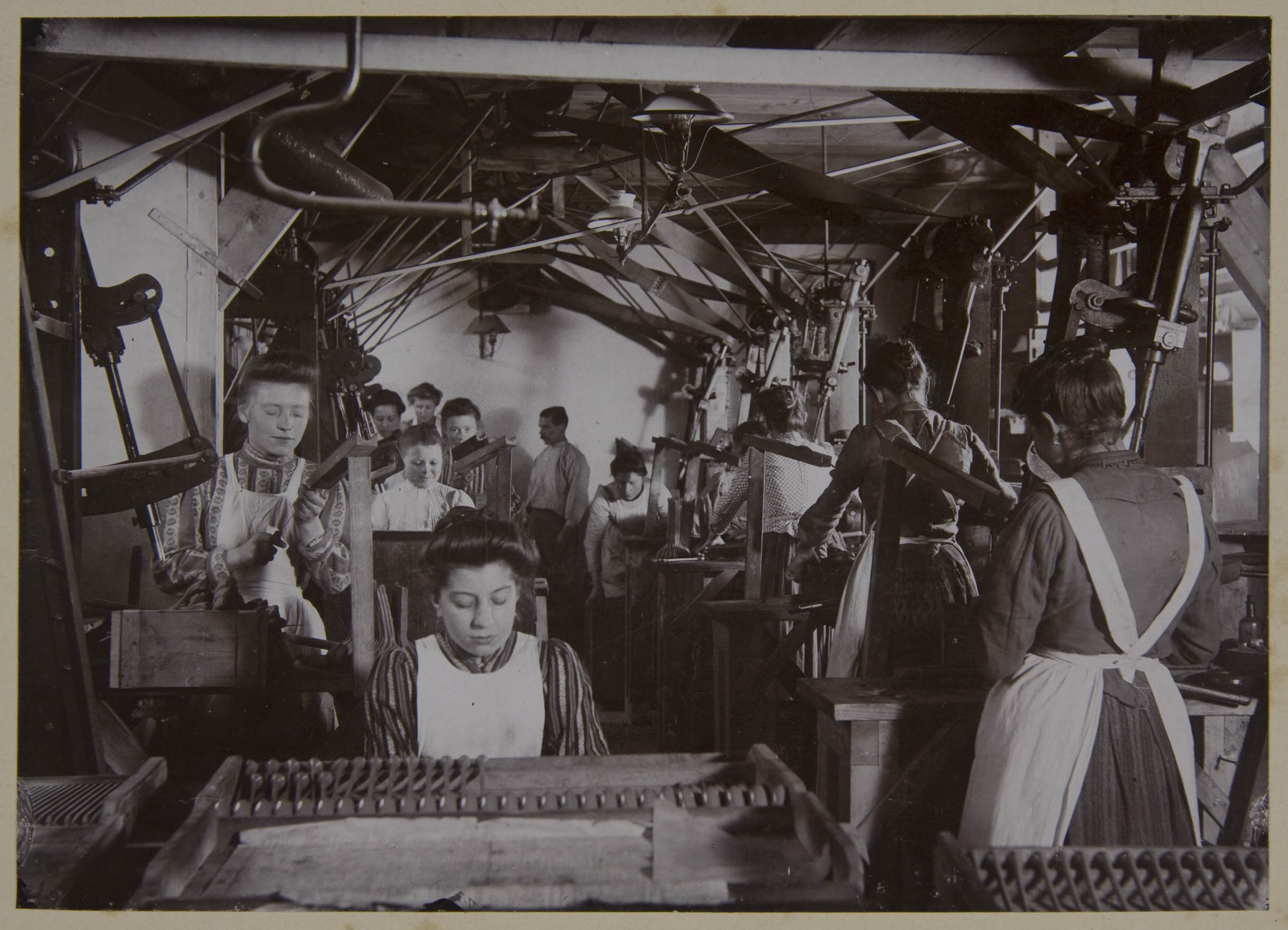
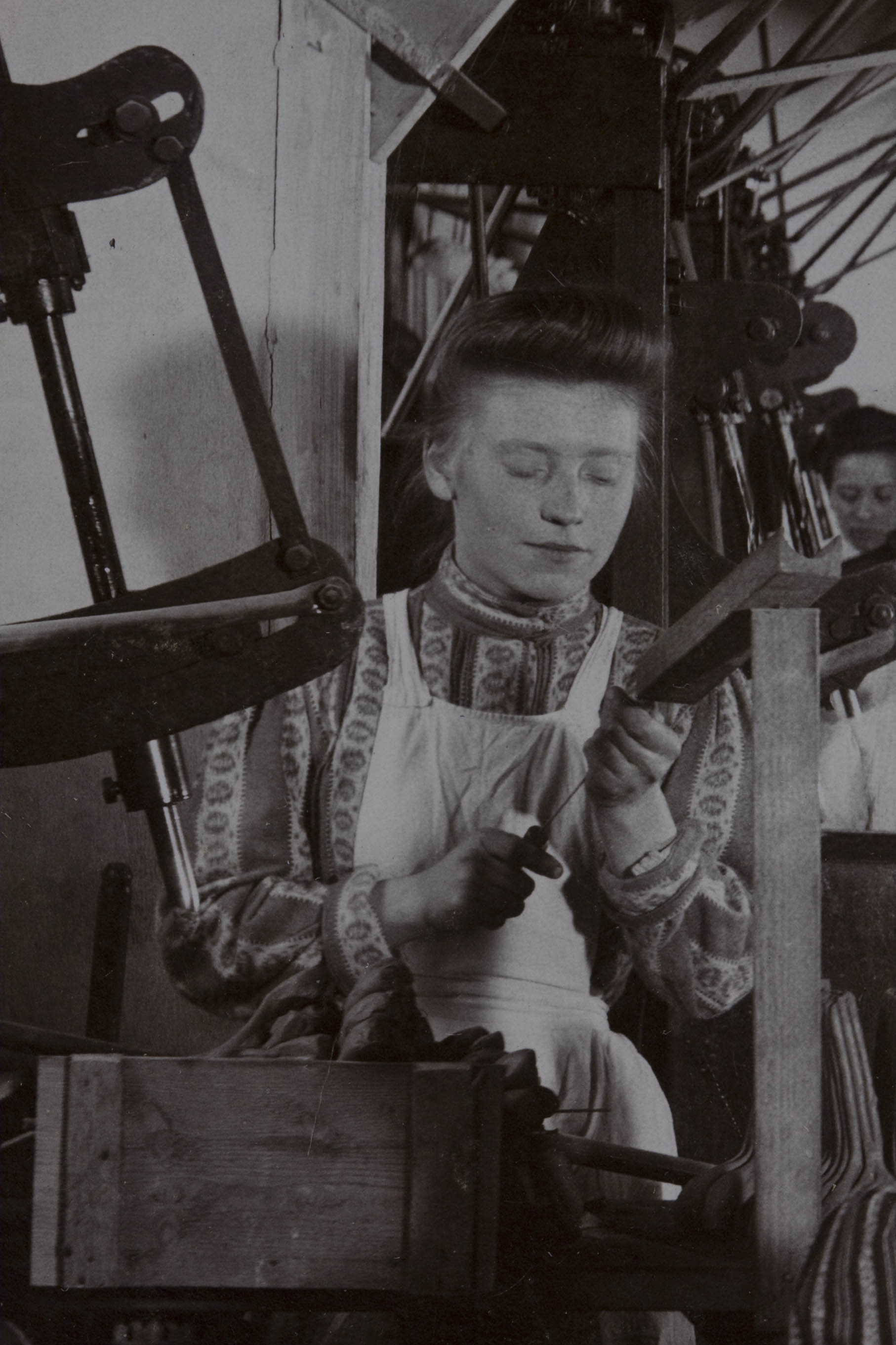
Around 1895 there was a sudden yet substantial demand for simple short stemmed clay pipes for export. Business offices in England and Ireland were able to sell immense batches, for example to smokers in West Africa and in America. There was a fierce competition to get such orders among factories in the various production centres all over Europe. It was not a matter of a few gross, but an export order sometimes included hundreds of boxes, each with a volume of two or three gross.
In Gouda the manufacturer Goedewaagen managed to make the right contacts to get these orders. At that moment, however, he got into trouble. Not enough men were available for press moulding the clay pipes. It was therefore necessary to partly mechanize the production so that women could be deployed. Swiftly a machine department was set up where production was carried out with the help of steam power and thanks to this mechanization, deliveries could be realized.
This photo shows that department, which was built in 1895. The space was located in the attic of the old pipe factory on the Raam in Gouda. The photo clearly shows the wooden ceiling where leather belts operate the machine press facilities. Thanks to the steam power, the pipe making, traditionally old men's work, could now be performed by women. They only had to put a pre-rolled basic shape pipe in the mould, the machine provided the actual press force and the woman's hand came back to remove the pressed pipe.
No matter how easily this work sounds, the work in the attic will not have been very pleasant. The machines made a deafening sound while there was a dank air of dried clay and oil. Factory director Aart Goedewaagen, who gave me this picture in the 1970s, spoke of a miserable working climate. He was ashamed of that situation. Unsurprisingly, this machine factory did not exist for long. A year after this photo was taken, the pipe factory moved to a fresh and spacious factory building just outside the city centre, and the women's department was disbanded on that occasion. They went back to the noble handwork and became involved again in finishing or polishing the clay pipes. Incidentally, at the same time, the commercial value of the cheap export pipe decreased due to competition from other production centres and a change in the smoking behaviour of the consumer.
The photo series, of which this is the most striking image, was made by photo studio W.J. van Zanen in Gouda. Precious as they were at the time they are stuck on cardboard and carry the embossed signature of the photographer in the lower left corner, just as a signature of a proud artist on a painting. Fascinating with this photograph is the silent image of working women that you expect every moment to come alive again.
Amsterdam, Pijpenkabinet collection Pk 235c
© Don Duco, Pijpenkabinet Foundation, Amsterdam - The Netherlands, 2010.